
THE OUTDOOR SOCIETY
Hiking Tours Beyond Yellowstone's Boardwalks

7 Jaw-Dropping Backpacking Trips in Olympic National Park
Olympic National Park is constantly one of America’s most-visited National Parks, yet few take the time to explore more than a mile or so off trail. With 611 miles of trails in the park, and nearly one million acres of wilderness to explore, backpacking in Olympic National Park gets you up close and personal to one of the worlds last remaining wild areas. From rugged, glaciated peaks, to isolated set-stacks on rugged coastlines, the only American rainforests, high alpine lakes and amazing waterfalls, the trails in the backcountry of Olympic lead to some of the best destinations in the world.
This year, take a trip to forgotten northwest corner of America and fall in love with the true wilderness of Olympic National Park. Whether you decide to hike to old chalets, shrinking glaciers, ancient petroglyphs, alpine lakes surrounded by mountains goats, or just looking to wander a remote section of beach to watch the most beautiful sunsets in America, Olympic’s backpacking trails are waiting for you. make sure you get your backcountry permit before backpacking in Olympic and all National Parks. While reservations aren’t needed for many of these trips, you still need to register with the park for your life-changing backpacking adventure.

Enchanted Valley and Anderson Glacier
Distance: 37 miles out and back
Backcountry Campsite Reservations: Not Needed
Backcountry Camping Areas: 5
Recommended Days: 5-7
The trek out to the Enchanted Valley is quite possibly the most iconic backpacking destination in Olympic National Park. Considered a rite-of-passage to experience the Olympics, this route out of the Quinault Rainforest gets you to impressive wilderness of all styles. Hiking through the rainforest, the trail takes you over bridges, before arriving in the Enchanted Valley. Also referred to as the “Valley of 10,000 Waterfalls,” the area has incredible views of mountains, black bear, the Quinault River and an old chalet that was built in the 1930s. The Chalet was rescued from a certain end in 2014, when it was moved 100 feet away from the Quinault River, which it was nearly falling into. From Enchanted Valley, head up into the mountains and experience Anderson Glacier, one of the 311 glaciers in the Olympic Mountains. Anderson Glacier is quickly melting away, so you better get to it soon, before it vanishes forever.

Royal Basin
Distance: 18 miles out and back
Backcountry Campsite Reservations: Permits are required and must be obtained at the Wilderness Information Centers .
Backcountry Camping Areas: 2
Recommended Days: 3
Hiking to Royal Basin gives you the best of the Eastern Olympics. Starting out along the Dungeness River, the second steepest river in America, the trail works its way along Royal Creek before arriving at the scenic Royal Lake. From here, trails let you explore incredible waterfalls, giant boulders and one of the greatest basins in Olympic National Park. Located at the base of Mount Deception, the second tallest peak in the Olympic Range, Upper Royal Basin has glacier tarns, peaks to climb and one of the moon-like landscapes you will find. With all this just a short nine mile hike, it is easy to see why it is a popular destination. Therefore, reservations and proper permits are needed to camp here between May and October. Don’t let the short distance fool you though, it is well worth the elevation gain and hoops to jump through to get this as a summer backpacking destination.

The Pacific Coast Olympic Wilderness
Distance: 22.7 one way
Backcountry Camping Areas: 11
Recommended Days: 5
If you have ever seen a picture from the Olympic Coast, you are able to appreciate just how wild and rugged it really is. Home to amazing hiking, whale watching, tide pooling and the best sunsets of your life, hiking along the Olympic Coast of Washington State will change your life. Hiking along the coast is challenging work, and a knowledge of tides is needed to properly complete this hike, yet all the effort is worth it for just one day along the 73 miles of coastal wilderness. This is the longest undeveloped stretch of coast along the contiguous United States, and is quite the popular backpacking destination. With miles of sea-stacks, as well as the Makah Petroglyphs, the region between Ozette and Shi Shi Beach will astonish you with its wild beauty and culture. Be aware, the best campsites fill up quickly, and reservations are needed to access the region in the non-winter months.

The Duckabush/Skokomish Traverse
Distance: 32.9 miles one way
Backcountry Camping Areas: 9
Side Trips: For an extra loop with stunning mountain views, add the La Crosse Pass and O’Neil Pass loop.
One of the lesser known traverse hikes on the Olympic Peninsula, the route from the Duckabush River to the Skokomish River gives a wide variety of terrain, including incredible mountains, wildlife and old growth forests. Starting at Duckabush, the trail works its way along the Duckabush River, climbing over Big Hump before entering into the old growth of Olympic National Park. From here, the trail skirts the river, climbing in elevation while giving you views of wildlife before crossing the river and heading to Home Sweet Home Camp. This wildflower-filled valley a few hundred feet below the 4,688 ft, First Divide gives great views of mountains, and an option to climb a few lesser known peaks, like Mount Hopper. After the pass, the trail drops quickly along the Skokomish River, giving impressive views of huge trees, glimpses of majestic peaks and a glimpse of the human history of the region.

Hoh River to Blue Glacier on Mount Olympus
Distance: 36 miles out and back
Backcountry Campsite Reservations: Permits are required above Lewis Meadow and must be obtained at the Wilderness Information Centers.
Backcountry Camping Areas: 8
Recommended Days : 3-5
Hiking the Hoh to the base of Mount Olympus is yet another iconic hike in Olympic National Park, and for good reason. The trail works its way up the glacier-fed Hoh River, weaving through moss-draped old-growth forests, herds of elk, and neck deep ferns. Mostly flat for the first 12 miles, the path gives hikers a chance to see impressive valleys, waterfalls and even a the Mount Olympus Ranger Station. After Lewis Meadow, the trail climbs 3,000 feet in less than 4 miles to Glacier Meadows Camp, just a short trek to Blue Glacier and the route to climb Mount Olympus. This hike has it all, from rainforests to high aline lakes, glaciers and the peak of the tallest mountain in the Olympic Range, all along one incredibly beautiful and popular trail. Be aware, the best campsites fill up quickly, and reservations are needed to access the region in the non-winter months.

Elwha to Quinault: The Press Expedition Route
Distance: 44.6 miles one way
Backcountry Camping Areas: 14
Recommended Days: 6-9
As one of the longest traverses of Olympic National Park, the route from the Elwha River to the Quinault is also one of the most historic. In 1889, a group of journalists and explorers from Seattle and the region took five months exploring the Elwha and Quinault Rivers. The route they took passes amazing locations like Goblins Gate and the Grand Canyon of the Elwha before reaching Low Divide and dropping into the rainforests of the Quinault. Today, the trail passes Humes Ranch and Cabin, before exiting the less popular areas for the wilderness of the Elwha. The Elwha River is now dam free for the first time in over a century, and the region is flourishing. This route to the Quinault gives solitude, opportunity for exploration and a chance to see trail marks left by the Press Expedition explorers. Along the North Fork of the Quinault River, the trail becomes even more beautiful, making it a great place to watch wildlife, dip in glacier fed river and hike through ancient, giant trees.

Seven Lakes Basin
Distance: 19.3 mile loop
Backcountry Camping Areas: 7
Recommended Days: 3-5 days
One of the more popular backpacking trip in Olympic National Park, those who get a permit to Seven Lakes Basin are rewarded with eye candy of mountains, lakes, animals and forests. Aptly names, the basin is full of lakes, mountain goats, wildflowers, and incredible views of glaciated peaks around the Olympic Mountain Range. Starting with the always impressive Sol Duc Falls, the trail heads up along the Sol Duc River, gaining in elevation before depositing hikers into an alpine wonderland. With campsites around the lakes, finding your favorite destination may be quite hard, as each lake offers unrivaled beauty. The highlights are probably Heart Lake and Lunch Lake, but Hoh Lake and Deer Lake are also quite spectacular. The Seven Lake Basin Loop is best done during clear summer nights, when after spending a day exploring the lakes and ridges of the region, you can sit back and enjoy one of best stargazing views in the park. For those looking for a high alpine experience in Olympic National Park, this is one of your best options.
WANT MORE ADVENTURES IN AND AROUND OLYMPIC?
Discover a Hike a Week through Doug Scott’s Olympic National Park Area Guidebook

Keep Reading See All

Weather Closes Staircase and Other Areas of Olympic National Park for the Weekend

Olympic Mountain Snowpack: Christmas Week 2016

5 of the Best Backpacking Trips in Olympic National Park
O lympic National Park is a hiker’s dream destination. How many other places in the United States can you hike from the white sand beaches of the Pacific Ocean, through an ancient, old-growth rain forest, and up to a glacier-capped peak in the high alpine in a single day? Most of the rugged interior of this million-acre tract of land is accessible only by foot or by horseback, and the majority is also a wilderness area.
The park’s 611-mile trail network—which includes 135 miles of the Pacific Northwest Trail—is ideal for backpacking, with hundreds of potential loop or point-to-point itineraries possible for all ability levels. Here are five of my absolute favorite backpacking trips in Olympic National Park (plus permitting, campsites, and other logistical considerations). This is not an exhaustive list, but rather an overview of some of the most scenic and popular hiking the park has to offer.
1. Hoh River Trail to Blue Glacier

The Blue Glacier viewed from its lateral moraine.
Length: 37 miles Type: Out-and-back Elevation gain: 3700 ft Difficulty: First 12 miles easy; last 6 to the glacier strenuous Getting there: The road is paved all the way. Trailhead parking is competitive, so plan to arrive early in the morning. Permit considerations: High elevation campsites are quota sites. Bear canisters not required.
The first 12.4 miles of this trail comprise an easy stroll through the Hoh Rain Forest. There’s plenty to love about this hike long before you get out of the trees: immense spruces, firs, hemlocks, and cedars abound in this section, along with lush ferns, mosses, and peekaboo views of the mighty Hoh River itself.
Still, the trail’s big schtick is really the glacier at the very top of the trail—the only place in Olympic National Park where a non-mountaineer can get up close and personal to 7,900-foot Olympus itself via the lateral and terminal moraines of the Blue Glacier. Many people tackle the glacier from a base camp at Lewis Meadows or Elk Lake.
On your way back to the car, zip around the 0.75-mile Hall of Mosses loop near the parking lot for some additional rainforesty goodness.
Warning: You’ll have to climb significantly in the last five or six miles on the way out to the glacier, as well as navigate a landslide via a long, sketchy rope ladder just before Glacier Meadows. The ladder will pose a challenge for folks who struggle with heights or exposure.
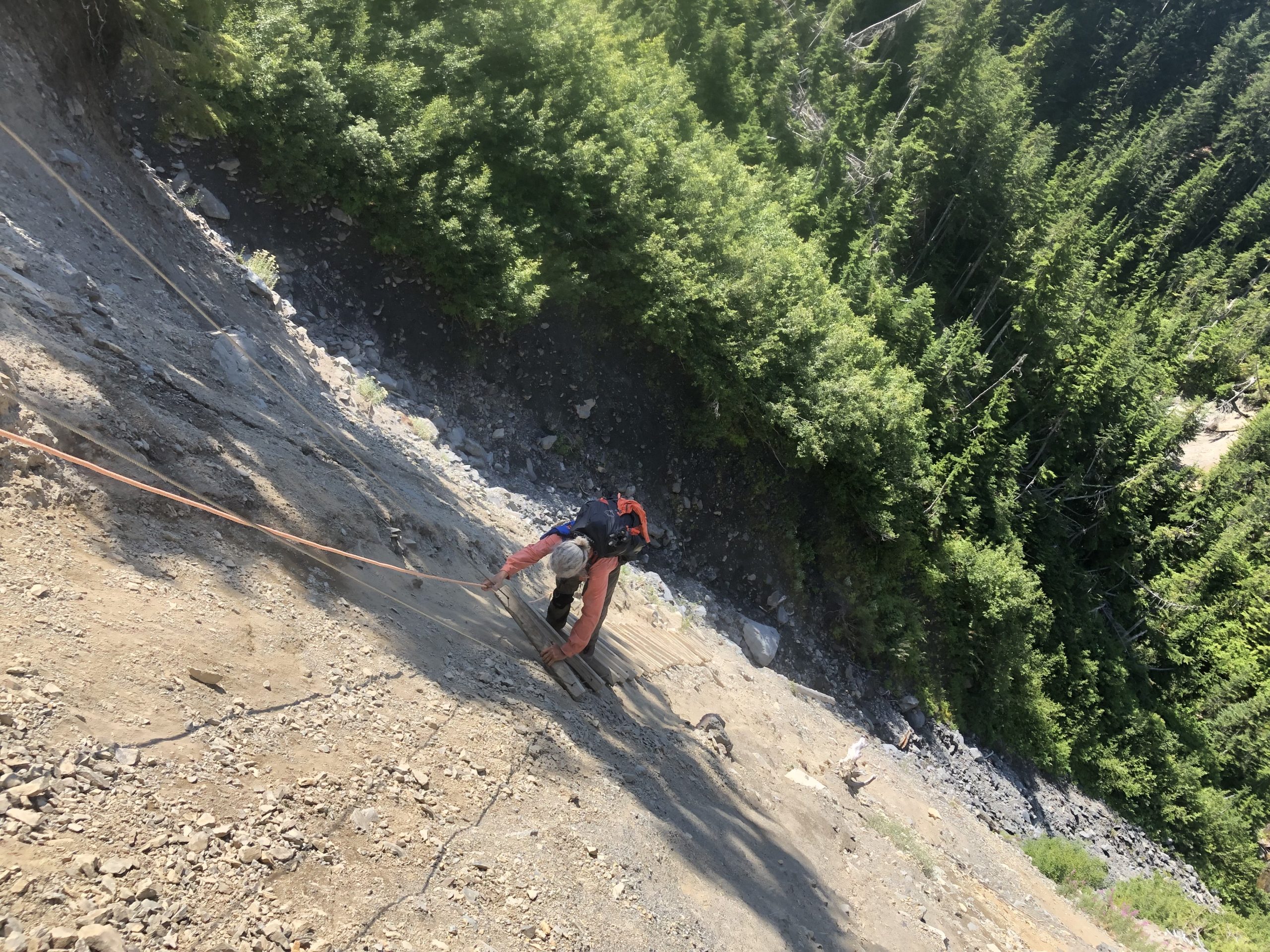
Yeahhh not sketchy at all.
Make it shorter: You can still have a very pleasant rainforest hike with almost no elevation change if you camp at Lewis Meadows (mile 10) and turn around.
2. High Divide / Sol Duc Loop

Length: 19 miles Type: Loop Elevation gain: 4000 ft Difficulty: Moderate to strenuous Getting there: Paved, two-lane road all the way. Smooth sailing. Permit considerations: All campsites are quota sites. Bear cans required.
The High Divide is one of the park’s few true ridge walks. Start at Sol Duc trailhead and head counter-clockwise past lovely Deer Lake up to the High Divide. As you navigate over Bogachiel Peak, you’ll gain views of Seven Lakes Basin to the north and Mount Olympus to the south.
This is a great hike for wildflowers in summer and fall foliage later in the season. While the mountain vistas are fantastic on this loop, the many picturesque alpine lakes along the way steal the show. The entire Divide is basically a gigantic huckleberry patch, which means tasty treats in late summer and a good chance at a black bear sighting.
After the hike, you can grab a shower and a soak at Sol Duc Hot Springs Resort—so bring your bathing suit in the car.
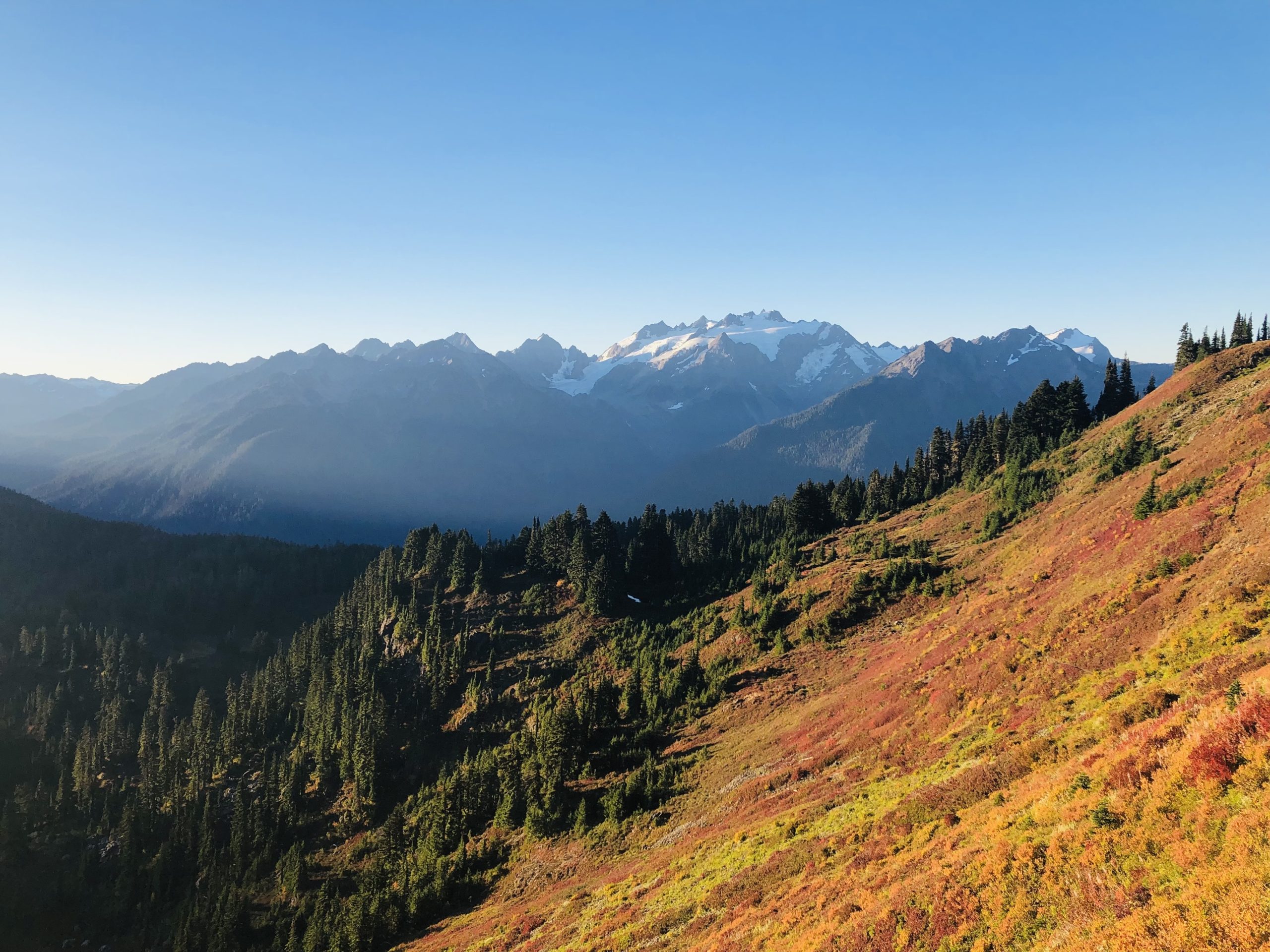
Mount Olympus from the Cat Basin primitive trail.
Make it longer: At Heart Lake, continue straight on the Cat Basin primitive trail and continue around past Swimming Bear Lake and Spreadeagle Pass. At Appleton Pass, pick up developed trail again and head back down to the Sol Duc Trail. This primitive trail is mostly easy to follow, but is steep, indistinct, overgrown, and eroded in several places, so I would only recommend it for experienced hikers. This extension will give you more miles and excellent vistas, including the best views of Mount Olympus in the area.
3. Enchanted Valley / Anderson Pass / O’Neill Pass Loop
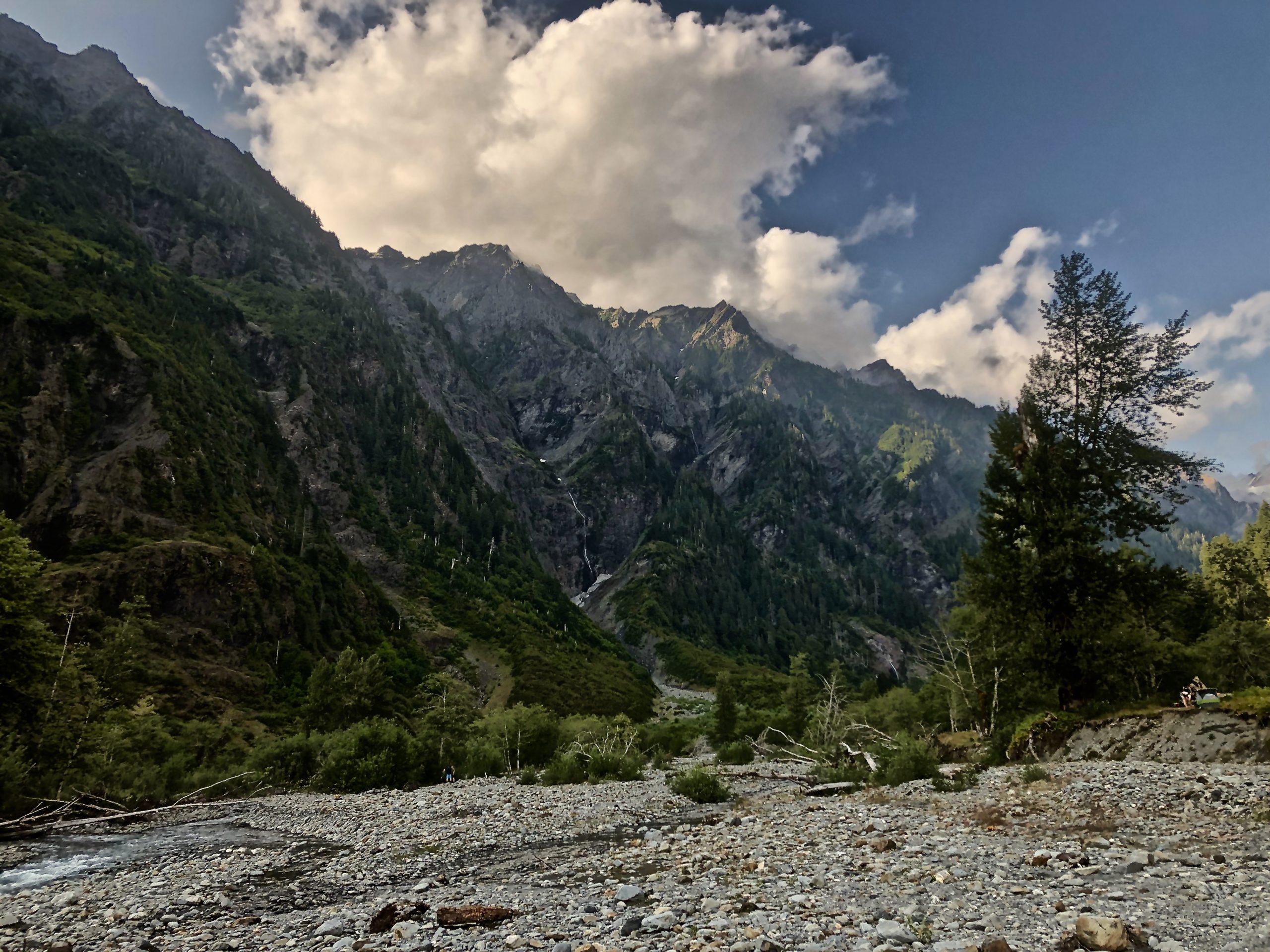
Enchanted Valley is one of the most popular beginner backpacking destinations in Olympic National Park.
Length: 52 mi Type : Lasso (loop/out and back hybrid) Elevation gain: 11,000 ft Difficulty: Moderate to strenuous Getting there: The road to Graves Creek Trailhead has some washboard but is in great shape overall as of this writing. Graves Creek Campground (primitive, self-service, $20/night) is 0.4 from the trailhead and is a great place to spend the night before getting an early start the next morning. Permit considerations: No quota sites on this loop, but some sites require bear canisters.
This hike begins in the Quinault Rain Forest. Be prepared to crane your neck a lot and say, “WOW LOOK HOW BIG THAT TREE IS,” at least 40 times on your way to aptly-named Enchanted Valley. There’s lots of camping in the valley, and you can watch the waterfalls tumble down 4000-foot valley walls from your tent.
From there, you’ll enter the loop portion of this hybrid “lasso” hike, beginning a roller coaster ride over Anderson, LaCrosse, and O’Neil passes. The Anderson Moraine and LaCrosse Lake spur trails are both worthy side trips along the way.
On your way home, you can stop at the coin laundry on Lake Quinault to wash your clothes and/or use the pay showers.

Anderson Moraine—the glacier is basically gone now, but this is still a worthy side trip from Anderson Pass.
Make it shorter: Just go out to Enchanted Valley and back. If you can book two nights in the Valley, set up a base camp and day hike to Anderson Moraine from there.
4. Grey Wolf Pass / Cameron Pass / Hurricane Ridge Loop

Lillian Ridge.
Length: 43 mi Type: Loop Elevation gain: 13,000ft Difficulty: Strenuous Getting there: The last eight miles of Deer Park Road are narrow, steep, and winding as you climb to 5,500-foot Deer Park Trailhead. As of 2022, the road is in excellent shape, but you do have to be cautious of other vehicles coming downhill fast around the many blind corners. Parking is limited. Permit considerations: Everything in the Grand Lake area is a quota campsite, the rest are not. Some sites require bear cans.
This hike balances some very remote, seldom-visited parts of the park with the highly photogenic Hurricane Ridge area. You can expect decent trail conditions between Grand Pass and Hurricane Ridge due to that area’s popularity. Every other part of this loop is quiet and infrequently maintained, so expect overgrown vegetation, deadfall, and eroded/washed-out sections of trail in places.
This hike offers up both solitude and a veritable buffet of scenery, including mossy forests, Mount Olympus, and glimpses of Port Angeles, the Strait of Juan de Fuca, and British Columbia. You’ll also get to enjoy one of the park’s precious few sustained ridge walks on Lillian Ridge and Hurricane Ridge.
This is a challenging hike featuring several very steep and strenuous climbs on this loop, notably Lost Pass, Cameron Pass, and Grand Pass.
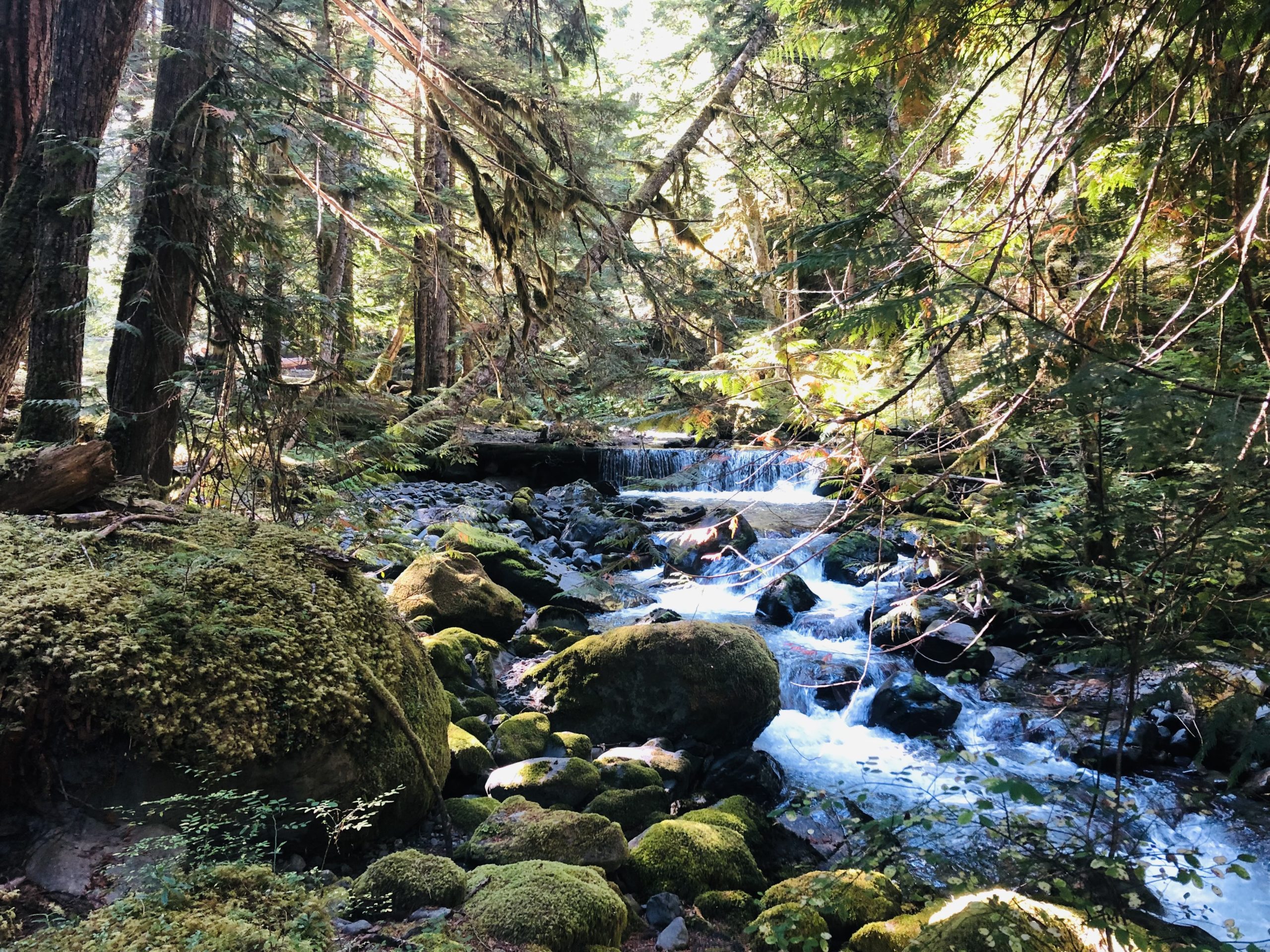
The Grey Wolf River.
Make it shorter: Park at Obstruction Point Trailhead (closed for the remainder of 2022) and just do the Grand Lake / Hurricane Ridge area, which is undoubtedly the most scenic portion of the hike.
Make it longer: Take some extra time to explore side trails along the way. Cedar Lake is a worthy side trip from Falls Camp, and when you get to the Obstruction Point area, check out Badger Valley in addition to the ridge walk.
5. Shi Shi Beach to Ozette Lake
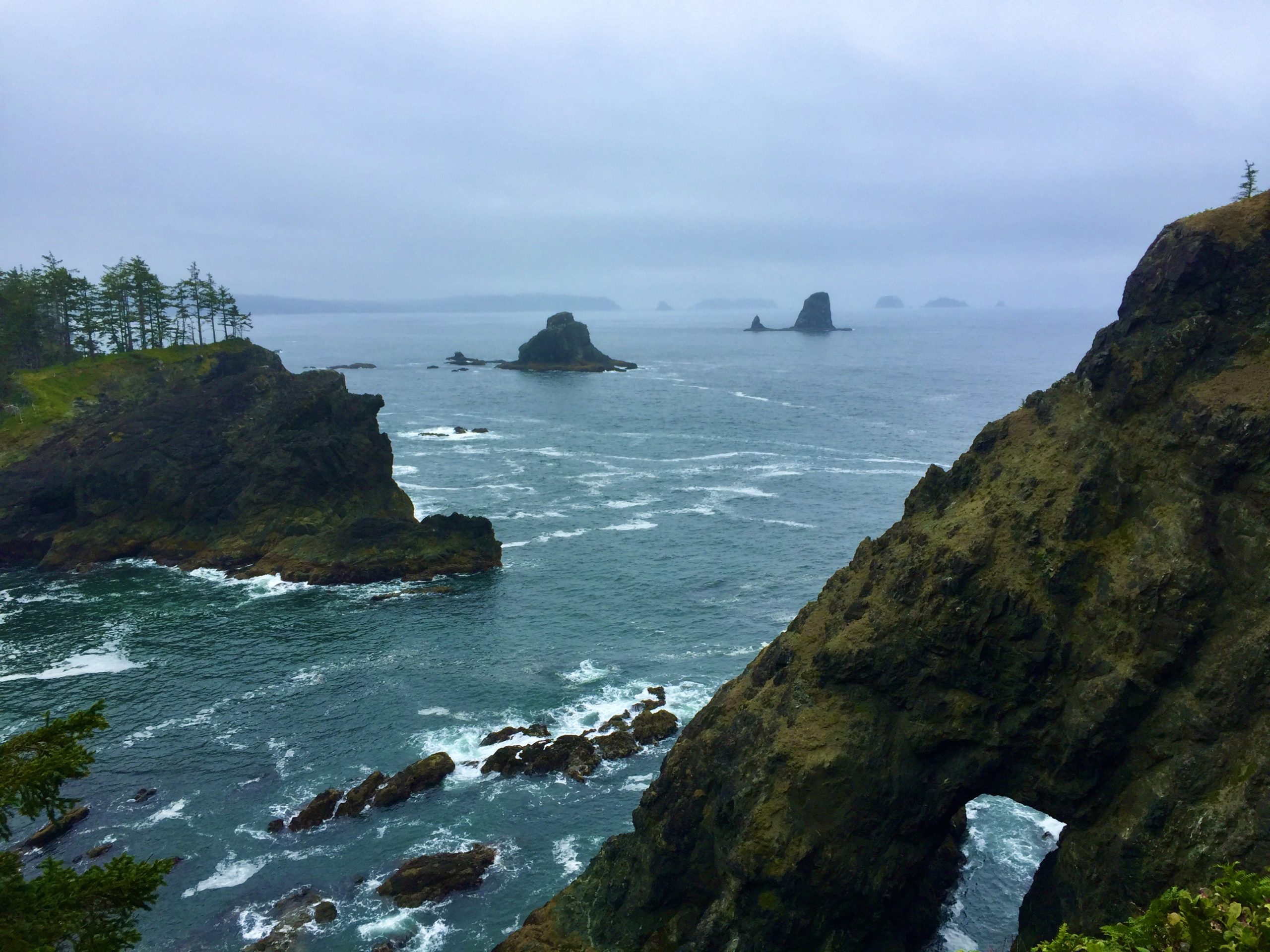
Photo via Dan Purdy.
Distance: 19 mi Type: Point-to-Point Elevation gain: 500 ft Difficulty: Moderate Getting there: At Shi Shi Beach, park your vehicle at one of the many grass/dirt lots along Tsoo-Yess Beach Road. Local homeowners run these lots, and you’ll find specific payment instructions at each lot. Also, as you’ll be parking on Makah land, please be familiar with their rules and regulations. Chief among these is the Makah Recreation Permit , which must be displayed on your parked vehicle. Permit considerations: Many of the beach campsites are quota sites. Bear cans are required at all sites.
No Olympic National Park backpacking guide would be complete without at least one beach hike. I haven’t actually done this hike (it’s on the bucket list), but one of our writers has and has created a fantastically detailed profile of it. If you can shuttle or stage two vehicles, you can do this as a point-to-point hike. Otherwise, it’s short enough that you could do it as an out-and-back.
Look forward to beach sunsets, tide pools, sea stacks, and other exciting beauty things on this gloriously unique hike. You will need a tide chart to navigate around some headlands, while others are impassable even at low tide and must be bypassed via overland trails.

Starfish bravely clinging to some kelp. Photo via Dan Purdy.
Make it shorter OR longer: You can’t start any further north than Shi Shi. However, you could turn around earlier than Alava to make it shorter or press on as far as Rialto Beach to make it significantly longer.
READ NEXT – The Olympic North Coast: 19 Miles of Magical Coastline in Olympic National Park
Olympic National Park Backpacking Logistics
Good to know.
- Dogs and other pets are not allowed on any trail in Olympic National Park. Service animals are OK.
- You won’t see any mountain bikes in the park, but many trails are accessible to pack animals.
- Cell service is spotty to nonexistent throughout most of the park. Do yourself a favor and assume you won’t have a signal.
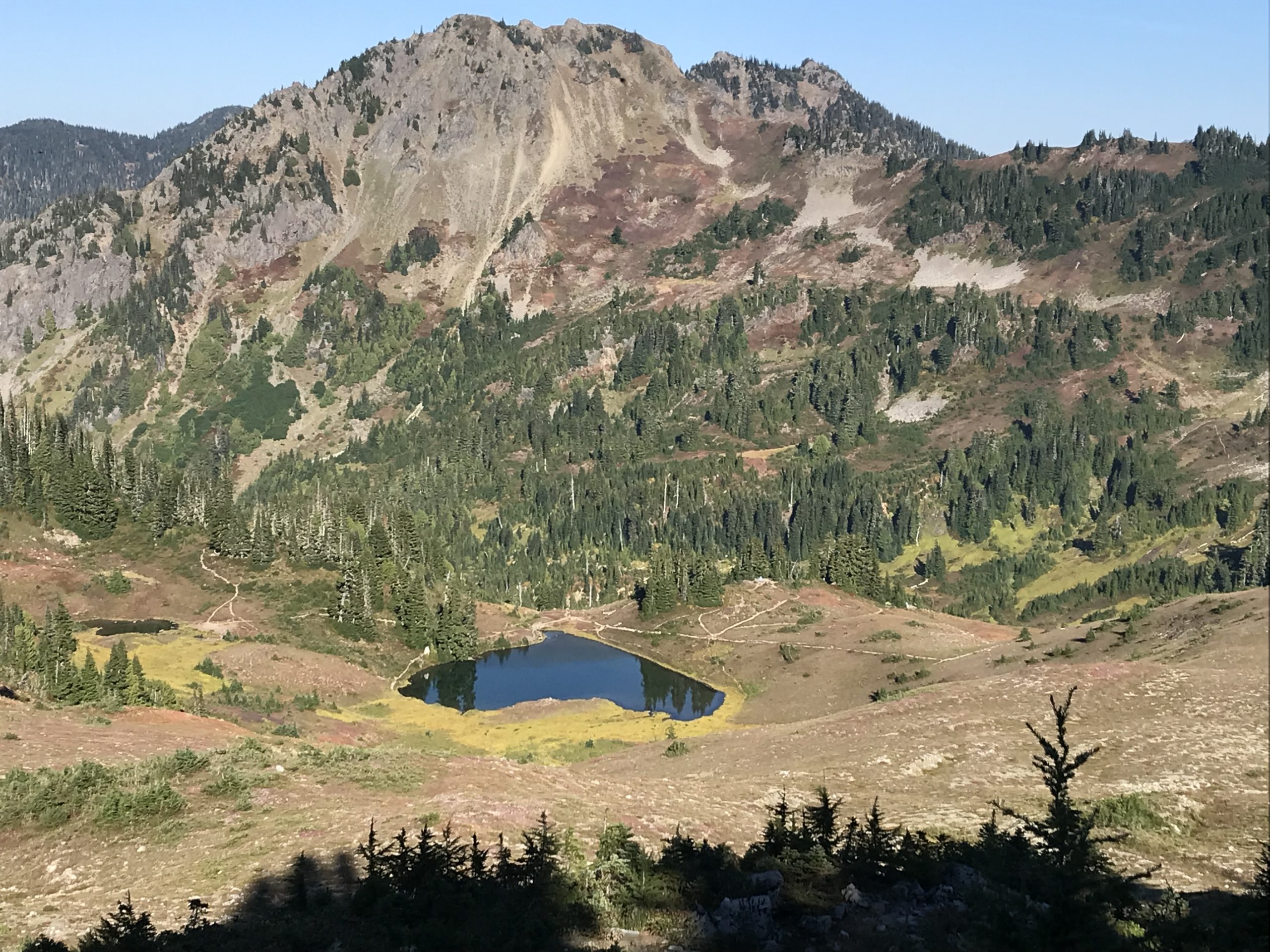
Heart Lake is a popular, quota-controlled campsite on the High Divide Trail.
You will need a permit to camp backcountry anywhere in Olympic National Park. Permits cost $8 per person per night plus a $6 booking fee. You can make reservations yourself online at recreation.gov up to six months in advance and print the permit within five to seven days of the start of your hike.
Quota sites: Some backcountry campsites are limited by a quota. If you sign up for one of these sites, you are expected to keep to your itinerary. On the park’s helpful Wilderness Trip Planner map , quota sites are indicated by yellow tent symbols.
Other sites are not quota-limited. You still have to register for these sites, and the park expects you to follow your itinerary as closely as possible to make search and rescue efforts easier. However, it’s not as big of a deal to stay at a different non-quota campsite since they’re non-competitive.
Unlisted campsites: Recreation.gov doesn’t list every backcountry campsite in the park. Unlisted sites are reservable, but you must know to ask for them. To do this, you can book a trip in the area you want to hike, then email the Wilderness Information Center (WIC) and ask to change the campsite. You can also try calling the WIC directly at (360) 565-3100 to book your permit over the phone, in which case the rangers can help you build an itinerary.
The backcountry rangers at Olympic National Park are extremely knowledgeable and helpful. It’s well worth calling, emailing, or stopping in person at the WIC to chat with them about your intended hike. They can also help you make changes to existing permits.
Bear Canisters
Some (not all) campsites in the park require you to store your food in a bear can. Be careful to note whether any of your campsites require canisters. If you don’t own one, you can usually get a free loaner from one of the WICs. While the park can’t guarantee they’ll have enough loaners on hand at any given time, I’ve never had a problem getting one. You can also buy canisters in Forks, Port Angeles, or Seattle. The Forks Outfitter also has a rental program.
Bear Can Recommendations: BearVault BV500 || Garcia Backpacker’s Cache (this is the kind the park will loan you)
Best Time to Hike in Olympic National Park

Fall colors at Gladys Lake on the Grey Wolf – Hurricane Ridge loop.
May through mid-October are the relatively dry months in this area, though the weather is always unpredictable on the peninsula. July and August are the busiest, most popular months. If you go before July, you’ll encounter gushing streams and waterfalls, more snow, and bugs, but fewer crowds. If you go in September or later, you’ll have fewer bugs, fewer crowds, and a shot at seeing some color change in the alpine tundra. Note that some high-elevation areas are only available for campsite reservations in the summer months (June or July through mid-October).
Final Thoughts
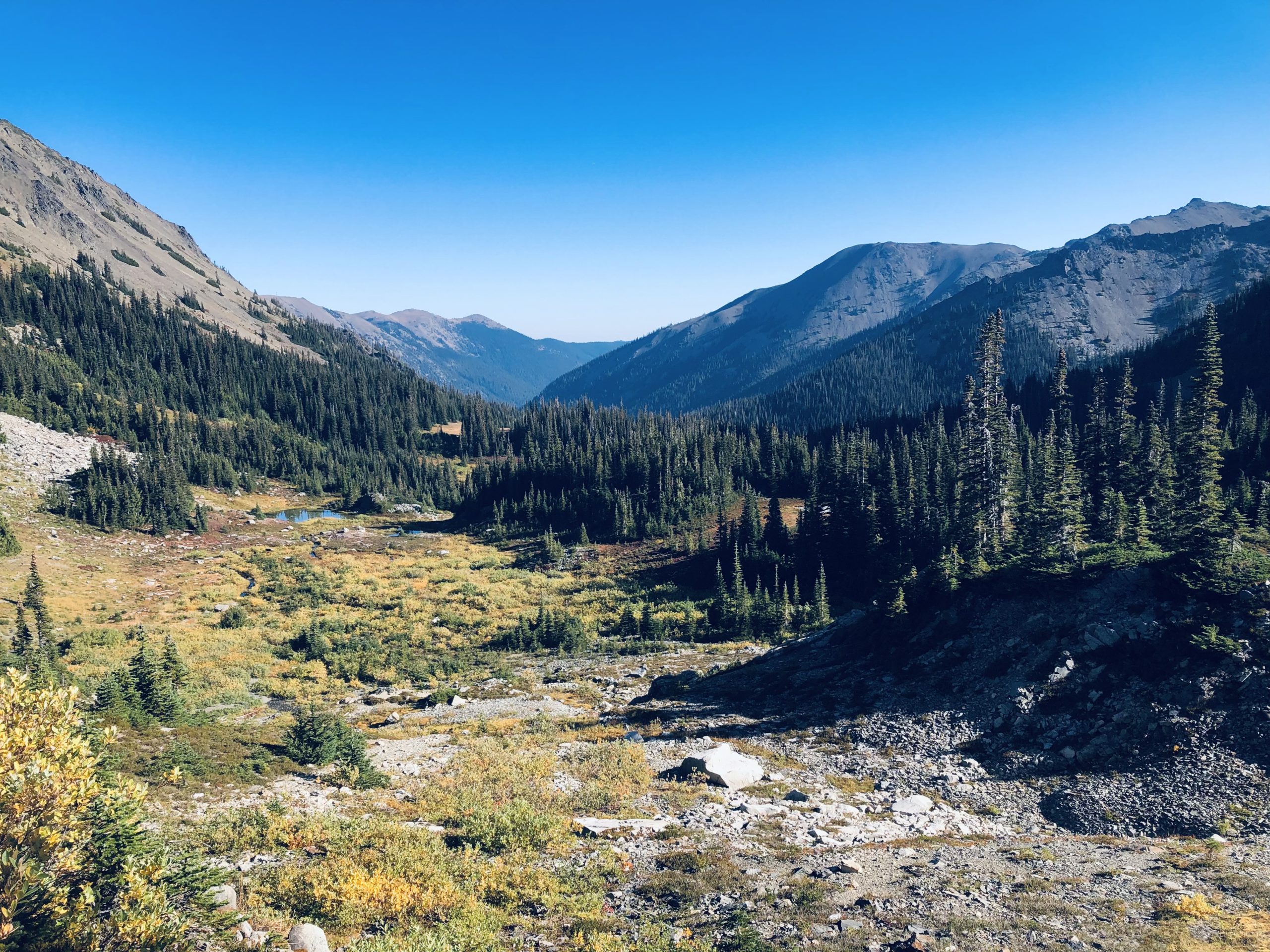
Grey Wolf Pass.
This is far from an exhaustive list of backpacking trips in Olympic National Park. You can make any number of different itineraries on the peninsula, including many that are less crowded than the popular gems we’ve highlighted.
I also encourage you not to limit yourself to just hikes within the confines of the park itself. There are tons of trails in the Buckhorn Wilderness and surrounding area that are worth exploring too. Washington Trails Association is an invaluable planning resource for anyone looking to scope out potential hikes in the area.
Featured image: Seven Lakes Basin, 2005. Photo by Brian . Graphic design by Zack Goldmann.

This website contains affiliate links, which means The Trek may receive a percentage of any product or service you purchase using the links in the articles or advertisements. The buyer pays the same price as they would otherwise, and your purchase helps to support The Trek's ongoing goal to serve you quality backpacking advice and information. Thanks for your support!
To learn more, please visit the About This Site page.
Oh hey there! I'm Ibex, managing editor of this site. I mostly spend my spare time scheming new adventures and inadvertently setting my hair on fire while cooking. Thru-hikes: Appalachian Trail 2018 | Wonderland Trail 2019 | Colorado Trail 2020 + 2021 | Wind River High Route 2022 | Pyrenean Haute Route 2023
What Do You Think? Cancel reply
Nomadic Moments
Collect Moments, Not Things
Backpacking Olympic National Park – Top 7 Trails

Olympic National Park is a diverse wonderland of mountain peaks, rainforests, and ocean vistas. There are many great day hikes and other adventures to be had when visiting this national treasure. However, some trails need more time to be fully explored. There are trails in Olympic National Park that journey deep into the rugged backcountry where no road leads. Other trails have destinations that are found on a shorter hike but because of epic sunsets or dark skies, they are best experienced with a backpacker’s tent. Below are the best seven trails for fully exploring and backpacking Olympic National Park in Washington State.
Camping Permits
When backpacking Olympic National Park visitors are required to stay in established permitted campsites. The best way to obtain a camping permit is to be prepared to grab a reservation when they become available 6-months to the day in advance of your first desired night on the trail. Once reserved, the park service will issue your permit within a few days of your scheduled trip. Each of the campsites falls into a backcountry zone. I have the appropriate zone listed for each of the trails below. You can also use this map provided by the parks service for planning your backcountry journey. Some of these trails are only available for reservation during the summer season, mid-July through mid-October.
Backpacking Olympic National Park Gear
The type of gear you will need for your Olympic National Park trip will depend greatly on where in the park you intend to hike. The coastal trails allow for slightly lighter clothing and gear than mountain trails, but all backpackers are required to carry bear canisters inside the park. Check out our backpacking gear list and the accompanying guides for how to choose the right gear for you. Most of the mountain trails in Olympic National Park have good bridges for stream crossing but the beach trails do not. You might want to carry a set of water shoes for the crossing, in addition to quality hiking shoes for the rocky shorelines. For the beach trails, make sure you have a copy of the tidal charts and know how to effectively use them to avoid getting trapped by the high tide.

- High Divide Loop
- Shi Shi Beach
- Royal Basin
- Ozette Triangle
- South Coast Wilderness Trail
- Enchanted Valley
The above Google Map is for reference only and is not detailed enough to use for anything other than getting to the trailheads. Use the Park’s backcountry map for planning a backpacking trip and acquiring the appropriate campsite permits . The park also supplies GPS coordinates for campgrounds and trailheads on its website .
1) High Divide Loop w/ Seven Lakes Basin

- Total Distance: 20.5 miles
- Type: Loop
- Elevation Gain: 5,320′
- Rating: Strenuous
- Trailhead: Sol Duc Parking Lot
- Zone: Sol Duc
- Recommended Time: 3 Days, 2 Nights (Summer Only)
The High Divide Loop is Olympic National Park’s most iconic backpacking trip. Much of the journey follows the flow of the Sol Duc River as it makes its way through the dense rainforest and crashes over waterfalls. The most popular of which is the unique triple-column, Sol Duc Falls. The trail leaves the rainforest and climbs by Heart Lake before crossing over the ridgeline known as the High Divide. On one side of the ridgeline is the gorgeous Seven Lakes Basin, which is full of highly-saturated blue lakes. This is a great place to explore looking for wild creatures and backpackers can spend a night under the stars at Lunch Lake. However, the crown jewel of this hike is found on the other side of the ridgeline rising out of the Hoh River Valley. This is the best vantage point in the entire park of the glacial-covered Mount Olympus.
Camp at Heart Lake and make sure you go up to the ridge-line to watch the sunset on Mount Olympus. It is an experience you will never forget.

2) Shi Shi Beach
- Total Distance: 9 miles
- Type: Out-n-Back
- Elevation Gain: 200′
- Rating: Easy
- Trailhead: Shi Shi Beach Trail Parking Lot
- Zone: North Coast
- Recommended Time: 2 Days, 1 Night

Beyond Mount Olympus, the rocky coastline of the Pacific Northwest is the most endurable image of Olympic National Park. Shi Shi Beach is the best place for backpackers to explore the iconic coastline at sunset. The long sandy beach turns into a rocky coastline with tidal pools and a cluster of sea stacks known as the Point of Arches. These formations are widely considered the best in the park. Add in the fact that the trail is one of the easiest backpacking journeys in the park and you are left with what might be the best beginner’s backpack in the country. Just don’t get too excited and overpack. You still have to carry that gear across the sand.
While Shi Shi beach is a part of the National Park, backpackers will have to cross Native American land. In addition to your park camping permit, you will also need a Makah Recreation Pass for each day you intend to be in the park. Passes can be purchased in Neah Bay on your way to the trailhead.
3) Royal Basin

- Total Distance: 17 miles
- Elevation Gain: 3,926′
- Rating: Difficult
- Trailhead: Upper Dungeness
- Zone: Hurricane
- Recommended Time: 2 Days, 1 Night (Summer Only)
The Royal Basin Trail leads to a secluded area in the northeastern section of Olympic National Park. Just getting to the trailhead is an adventure as it requires getting off the asphalt and driving up and down a few mountainsides on a gravel road for nearly an hour. The Royal Basin lies in an area known by the locals as the rain shadow because it receives about seven times less rain per year than the western side of the park. This trail spends a lot of time climbing through the forest and it looks vastly different from those found in the western rainforests. Nearing treeline, the path rounds Royal Lake and then climbs into the Royal Basin skirting a beautiful waterfall along the way. The Royal Basin itself is an alpine bowl dotted with turquoise-colored tarns separated by rocky moraines. It is an amazing corner of the park to explore.
Get a permit to camp at Royal Lake Campground and explore the Upper Royal Basin area in the early morning on the second day. The basin faces east so the light is best in the morning. Don’t miss the beautiful Royal Basin Waterfall that is located near the ranger’s hut west of the Royal Lake. (Not the one located on the main Royal Basin Trail.) It is a 61-foot height waterfall that is nearly as wide.

4) Ozette Triangle (aka, Cape Alava to Sand Point Trail)

- Total Distance: 9.5 miles
- Elevation Gain: 578′
- Trailhead: Ozette Ranger Station (Parking lot to the north)
- Zone: The North Coast
The Cape Alava Trail is one of the best day hikes in Olympic National Park and one of the must-do adventures when visiting the park. This is because Cape Alava is the westernmost point in the continental United States. Grab a permit and camp out on the westernmost point. Watch the sunset as bald eagles soar overhead. Scan the ocean waves for gray whales, killer whales, sea lions, seals, and otters. Search through the tidal pools for sea stars, green anemones, crabs, and other small aquatic life. At the Wedding Rock formations search for the ancient petroglyphs left here by the Native Americans who survived off of the life-giving bounty of the sea. Make the full loop by hiking along the coastline for several miles to the Sand Point Trail and then head back to Ozette Lake completing the Ozette Triangle.

The Ozette Triangle is a hike that is best completed at low tide so make sure you have a tidal chart for the day you intend to hike the coast. If you are up for a bigger challenge skip the Sand Point Trail return and continue to backpack the entire North Coast Trail all the way to Rialto Beach. The North Coast Trail s a 21-mile journey that typically takes about 3 to 4 days because of the high tide pinch points. You would also need to arrange a shuttle for the 65-mile road return to the Ozette Ranger Station.
5) Grand Loop (AKA: Deer Park Loop)
- Total Distance: 43 miles
- Elevation Gain: About 13,000′
- Rating: Extremely Strenuous
- Trailhead: Deer Park (Alt: Obstruction Point)
- Recommended Time: 5 Days, 4 Nights (Summer Only)

While the High Divide Trail is considered Olympic National Park’s premier mountain backpacking route for views of Mount Olympus the Grand Loop is the park’s alpine loop trail. It passes over four mountain passes, three of which rise above 6,000 feet in elevation. It is a stunningly beautiful summer loop with rushing rivers, gorgeous turquoise lakes, and wildflower-covered meadows. Sections of this trail are remote and secluded while others are very popular. This is the perfect five-day journey for those looking for a longer trip when backpacking Olympic National Park.
A 10-mile section of this loop is classified by the park service as a primitive trail and is not recommended for those unprepared to route find. We recommend starting at Deer Park and backpacking the loop clockwise camping at Falls Camp, Bear Camp, Upper Cameron, and Gladys Lake. This makes the 3rd and 4th day fairly short but this puts crossing the steep Grand Pass on the 4th day rather than parring it with two other passes on a shorter itinerary. Gladys Lake is stunning but staying at Grand Lake would shave a mile off the long 12-mile day.
6) South Coast Wilderness Trail
- Total Distance: 17.5 miles
- Type: Thru-Hike (Shuttle)
- Elevation Gain: 370′
- Trailhead: Oil City or Third Beach
- Zone: South Coast
- Recommended Time: 3 Days, 2 Nights

A 17.5-mile long trail with only 370′ of elevation would normally be a walk in the park for beginner backpackers or a long day hike. But that is not the case for The South Coast Wilderness Trail. In addition to timing certain sections of the hike with the low tide like some of the other coastal hikes on this list, backpackers have no choice but to climb up steep embankments via ropes to cross over certain stretches of land that plunge steeply into the ocean even at low tide. This deceptively challenging stretch of coastline also requires fording several creeks, which during the spring runoffs can be waist-deep. However, those who do take on this rugged coastal trail are also rewarded with beautiful sea stacks, the unique Strawberry Bay Waterfall, abundant wildlife, and solitude.
This is a thru-hike that requires a shuttle for the 37-mile drive between the Third Beach Trailhead and Oil City Trailhead. This trail, more than any of the others on this list, requires backpackers have good planning in accordance with the tidal conditions to have a safe and successful trip. There are certain points that are completely impassible during a high tide. Bring a pair of gloves for the rope sections.
7) Enchanted Valley

- Total Distance: 26 miles
- Elevation Gain: 3,649′
- Rating: Moderately-Difficult
- Trailhead: Graves Creek
- Zone: Quinault
The Enchanted Valley Trail, not to be confused with The Enchantments in Washington’s Alpine Lakes Wilderness, lies in an area of Olympic National Park often overlooked by visitors. The trail follows the flow of the Quinalt River which flows through the Quinalt Rainforest on the south side of the Olympic Mountain Range. The most common destination of this hike is The Enchanted Valley Chalet . The chalet was built in 1931 but today is off-limits to the public. In fact, the river is encroaching on the chalet so it may be demolished soon. ( So go now! ) Even without the chalet the valley is gorgeous with mountains rising steeply out of the valley. It has been given the nickname of the “Valley off 10,000 Waterfalls” because of the amount of water that plummets off of the steep cliffs during the springtime.
This is a fairly easy 26-mile traverse as backpacking trips go. The journey to the Chalet can be done as a long day hike but we list it as a three-day journey. We recommend spending both nights at the Enchanted Valley campsite but using the second day to venture higher. After leaving the chalet, the trail climbs steeply up to Anderson Pass and there is a path to the foot of the Anderson Glacier. This would add 10 miles to the overall length of the backpacking trip. Those wishing for a more challenging adventure could thru-hike all the way to Duckabush Trailhead on the east side of the park but a shuttle would be needed and it is very expensive if you don’t have two vehicles.

Olympic National Park is a truly unique place. It is geographically special containing the westernmost point in the lower-48. It is biologically special housing a conglomeration of creatures in its three distinct echo systems, some of which are found nowhere else in the world. Just being able to visit this amazing place is a memorable experience but the best way to explore the park is by lacing up your boots and backpacking Olympic National Park. These top 7 trails have the best vantage points of the key areas of the park. They provided beauty, solitude, and explore all three ecosystems. If you love backpacking, Olympic National Park should be on your bucket list.
If you are looking for places to stay or good restaurants in the area after backpacking Olympic National Park, check out our guide to the park .
Share the Top 7 best trails when backpacking Olympic National Park with your friends.
Share this post:.

Let us know what you think about this moment. Cancel reply

Get My PNW Presets!
This preset collection can enhance your photos and will help you define your style and save you time.

Backpacking Olympic National Park Trails: Best Hikes & Tips
US national parks provide some of the absolute best hikes and camping there is to offer in the country, and backpacking Olympic National Park is no exception. If you’re looking for a place to backpack, stretch your legs, try out the fresh Washington air, and explore the mountains, this is as good an option as any.
There’s plenty of ecological diversity to enjoy when backpacking the Olympic Peninsula, including abundant wildlife like elk, bears, and a wide variety of birds and even sea life. Don’t worry about the difficulty, either. There’s something here for every experience level.
The options below will help you choose the perfect length and difficulty for your Olympic National Park trip. From scenic beach walks down the west coast to wooded multi-day excursions, Olympic National Park has it all.
After all, hiking and camping are among the best things to do in Olympic Park . So, let’s look into some awesome hikes you should consider on your backpacking trip.
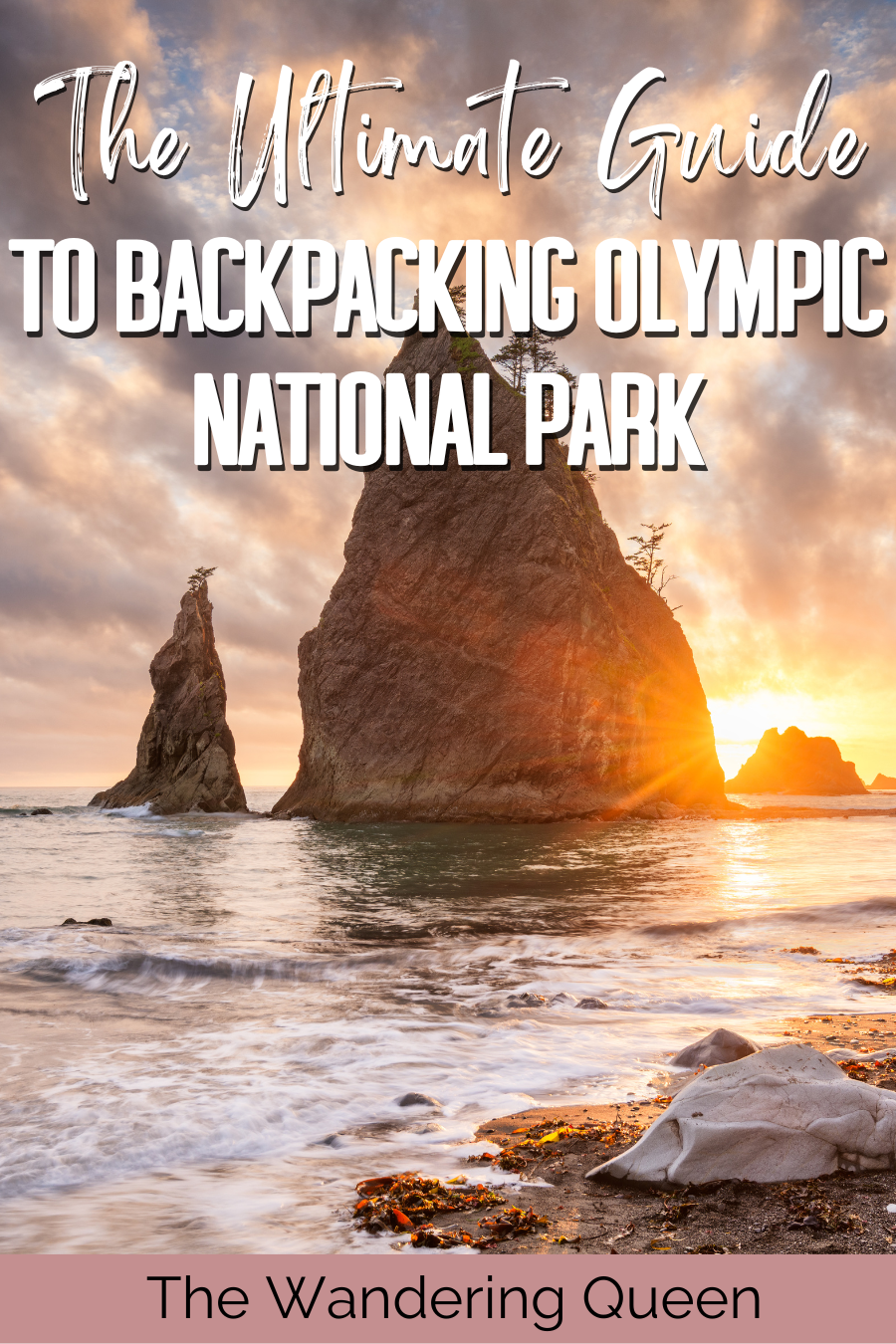
Disclosure: This post contains affiliate links. If you click one of them, I may receive a small commission (for which I am very grateful for) at no extra cost to you.
Olympic National Park
Related posts.
- Everything You Need To Know About The Hurricane Ridge Hike
- The Ultimate Guide To Second Beach Camping
- The Ultimate Guide to Rialto Beach and The Hole In The Wall Washington
- Backpacking Guide To Enchanted Valley Olympic National Park
- The 21 Best Hikes In Olympic National Park
- The Perfect 2-3 Day Olympic National Park Itinerary
- Where to Stay in Olympic National Park – 10 Best Cabins & Rentals
- 25 Best Things To Do in Olympic National Park
A Quick Note on Olympic National Park Permits & Passes
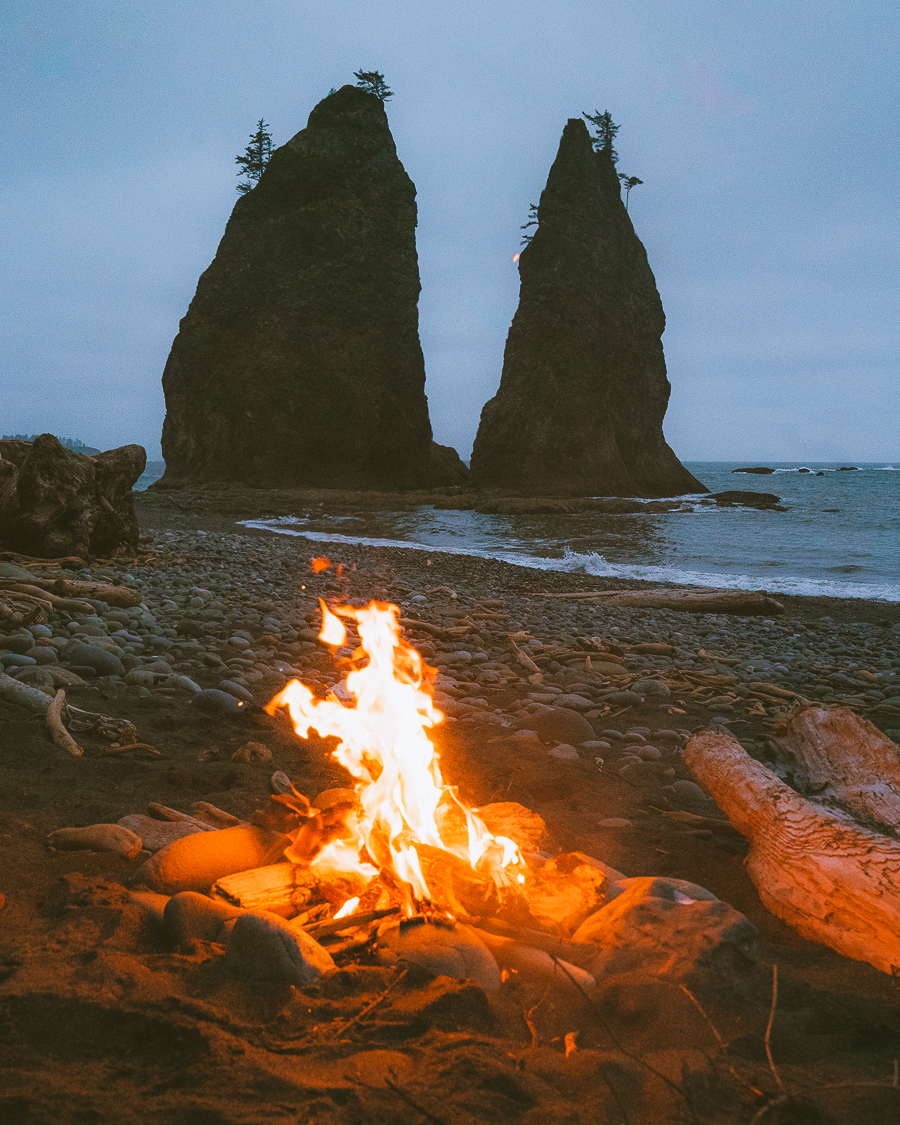
Before your hike begins, note that in Washington State and on the Olympic Coast, there are some particular requirements around passes and permits. It’s recommended you get an America The Beautiful Pass , as it conveniently includes both the Northwest Forest Pass and the National Park Pass.
Alternatively, the Discover Pass grants access to any state park in Washington and can save a lot of money if you head out into the wilds regularly.
For Olympic National Park specifically, you’ll need to obtain an overnight backpacking permit before visiting. You can find more information on the NPS website and get your permits on Recreation.gov .
Map Of Backpacking Olympic National Park Trails
Best Hikes in Olympic National Park for Backpacking
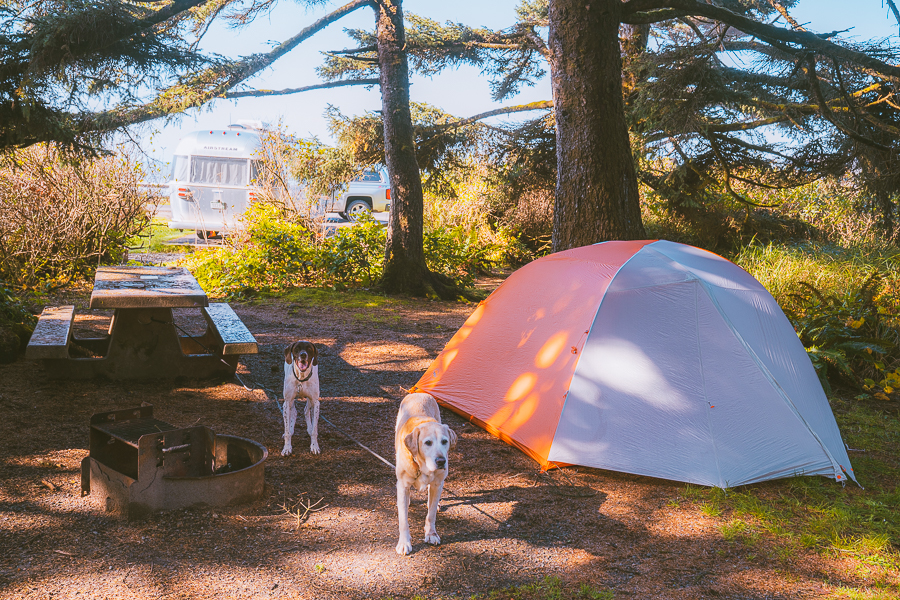
There are nearly a million acres of absolutely breathtaking wilderness comprising the National Park. Within that acreage, there are several options for your backpacking trip and trails to hike, catering to all levels of difficulty and distances.
If you’re wondering where to stay in Olympic National Park , there are also plenty of camping spots available.
It’s safe to say these Olympic National Park backpacking trips will be a huge draw for any nature lover. Lakes, the Enchanted Valley, The Olympic Mountain range, and the Pacific Ocean are the feeders of this biodiverse area.
On that note, bear in mind (no pun intended) that you will need a bear canister for most of these hikes. In many cases, you can rent one from the local ranger station or last-stop kiosk.
From Hurricane Ridge to the Enchanted Valley trail and beyond, here are the best hiking trails in Olympic National Park.
All the best views in the state
100+ wa hikes.
Embark on Washington’s best trails with our eBook! Inside, find top hikes, expert tips, and stunning views, making every adventure unforgettable. Dive into the beauty of Washington’s outdoors now!
Tours Of Olympic National Park
1. hoh river trail to blue glacier.
- Elevation Gain: 5,633 feet
- Mileage: 35.1 Miles Round Trip
- Difficulty: hard
- Trail Guide: Link
One of the most remarkable aspects of this particular rainforest hike is the incredible biodiversity you can observe. Normally, you’d have to go much further off the beaten track to see the kind of range of wildlife you’d see on the Hoh River Trail.
Most of the hike is through the Hoh River Valley rainforest, and though there are many backcountry campsites dotted along the way, they are usually very much in demand. If you plan to camp, it’s best to reserve a space well in advance if you can.
Before you get to the campsites and the Blue Glacier, though, you’ll likely encounter a lot of other hikers on the first five miles or so of the hike. This day hike is popular and marked by the aptly named Five Mile Island.
Several of the other campsites along the trail are very small – think two or three tents. This is why you’ll need to chat with the ranger about booking and reserving the spots in advance. These campsites are the ideal point from which to reach the Blue Glacier in a day.
There is one major obstacle on the trail in the form of a washout. The rope and ladder solution makes navigation tough with a heavy backpack, so take this into consideration.
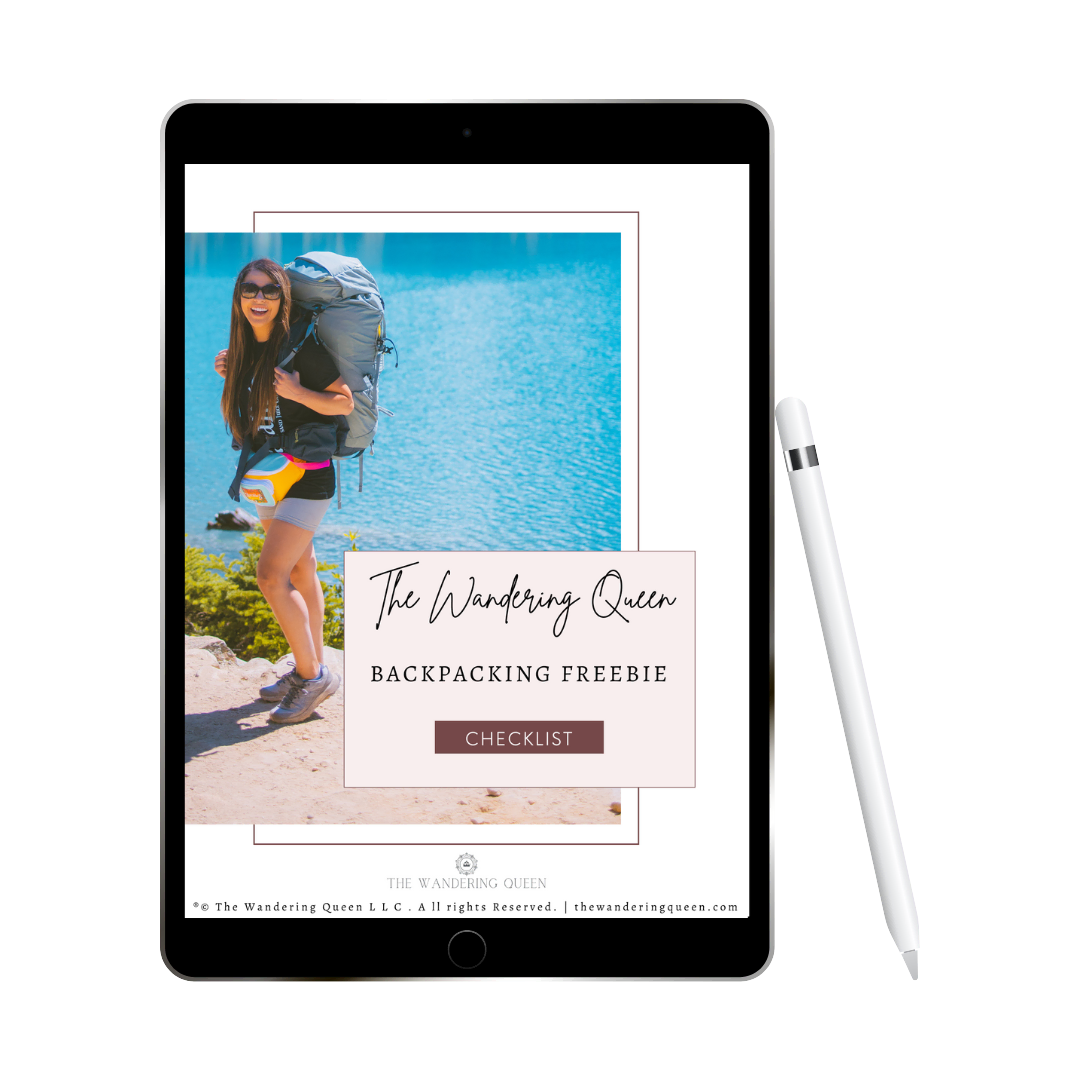
Join my Newsletter to receive my free Backpacking Checklist!
Subscribe to have posts delivered straight to your inbox!! PLUS, get my FREE backpacking checklist!
2. High Divide – Seven Lakes Basin
- Elevation Gain: 5,419 feet
- Mileage: 19.1 Miles Roundtrip
- Difficulty: Hard
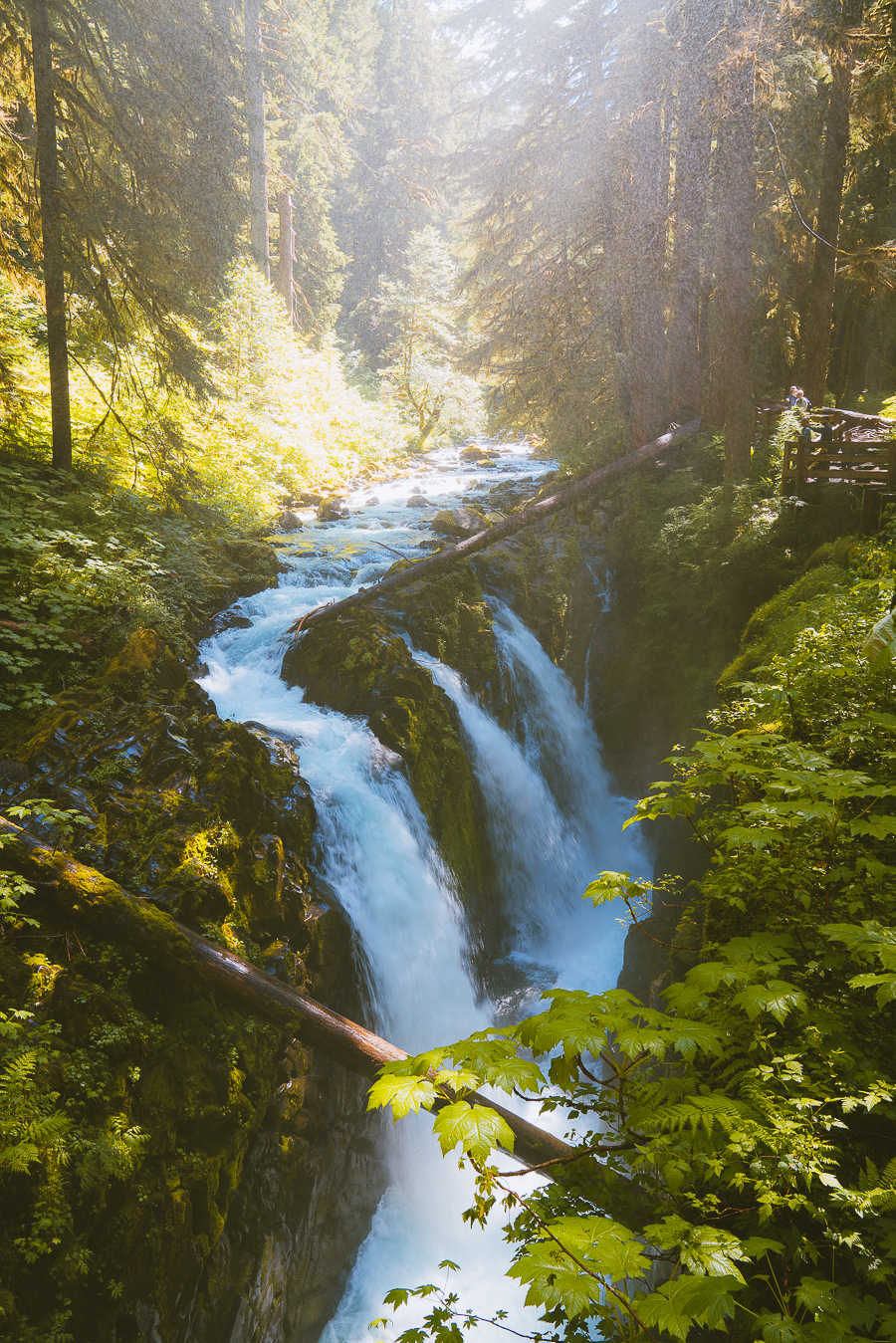
The three trailheads that feed the High Divide Trail or Seven Lakes Basin Loop all involve an early climb to the ridge in question. The main trailhead is Sol Duc Falls. Once there, the view becomes breathtaking, taking in the North Cascades’ unquestionable beauty. Further along, The Alpine Lakes will likewise take your breath away.
When you begin your hike at the Sol Duc trailhead, you’ll hit a junction for the Seven Lakes Basin Loop within a mile. Go right to explore the path leading to Sol Duc Falls, Deer Lake, and Lunch Lake. If you choose to go left, you’ll be on a trail that follows the picturesque Sol Duc River, taking you to Sol Duc Park and Heart Lake.
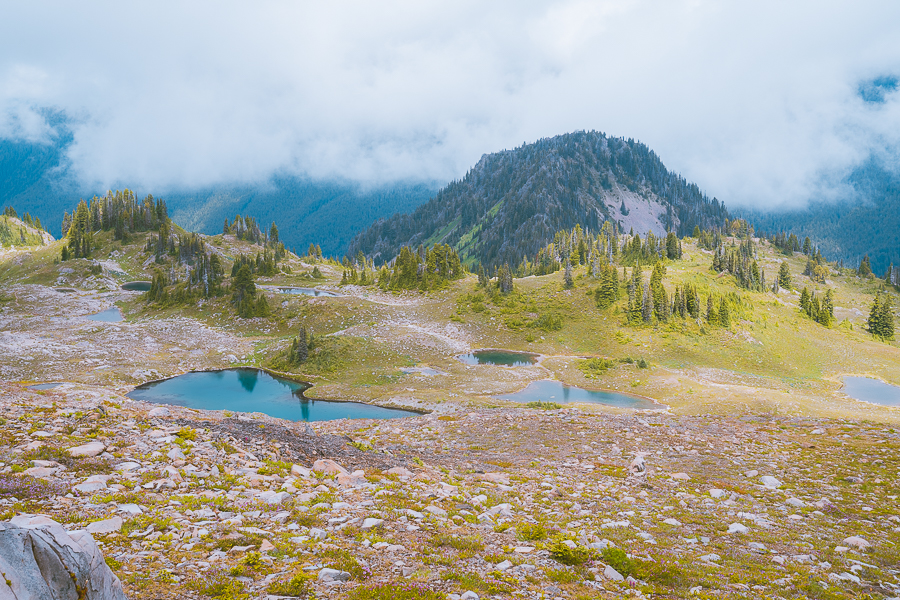
Take in Mount Olympus, as well as any of the lakes listed above you can see along the 19-mile walk. It’s not uncommon to see black bears wandering in the woods (take a bear canister). If you have the time –and you should – do a slight excursion to Bogachiel Peak for a bit of extra fun.
One suggestion is to obtain a backpacking permit and a camping permit for this hike as far in advance as possible. The High Divide —Seven Lakes Basin hike is a very popular trail, so it is often crowded during peak season, and camping spots will go quickly.
Tip: I like to book a nearby accommodation option for hiking and backcountry camping in the Olympic National Park. The Lake Crescent Lodge is a perfect spot to get your body back after a few days of wilderness backpacking.
Read a full review of the High Divide Trail here .
3. Enchanted Valley
- Elevation Gain: 3,254 feet
- Mileage: 25.5 Miles Round Trip
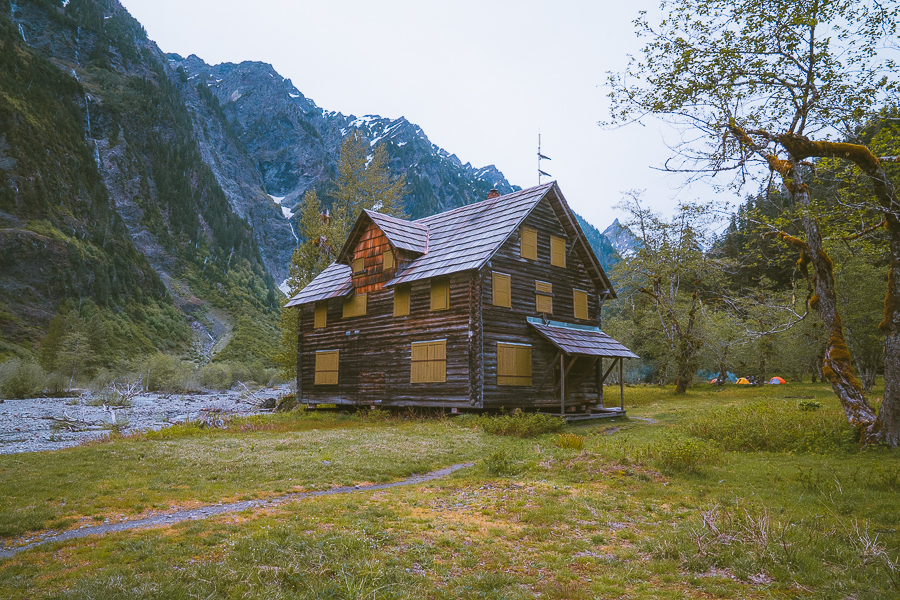
It’s worth knowing at the outset that this impressive 27+ mile Enchanted Valley hike is relatively remote. Your last “stop,” as it were, will be the ranger station en route to the trailhead. From that point, you need to take a six-mile road along the Quinault River before you reach the gravel that marks the true start of the hike.
Some hikers recommend spending the night here at the Graves Creek Campground and getting a fresh start on a long walk in the morning. Much of the hike meanders along a pretty river and includes bridges to walk across.
Once in the Enchanted Valley, you won’t spend too much time before you see the local wildlife. Elk and black bears are common. Keep an eye out also for the almost legendary Enchanted Valley Chalet. You can’t enter it anymore, but its remoteness in the forest makes for a great picture opportunity.
This is an incredible hike featuring bridges, waterfalls, trees, and the rushing East Quinault River!
Read More: Backpacking Guide To Enchanted Valley Olympic National Park
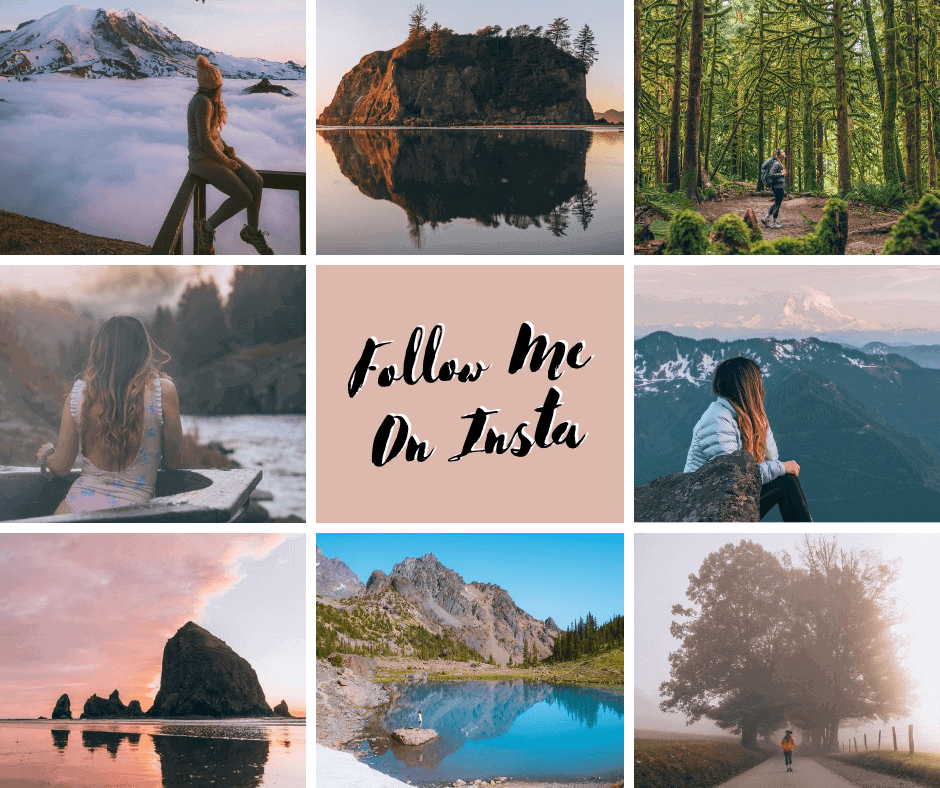
4. Hurricane Ridge Loop
- Elevation Gain: 8,900 feet
- Mileage: 38.2 Miles Round Trip
- Trail Guide: Link
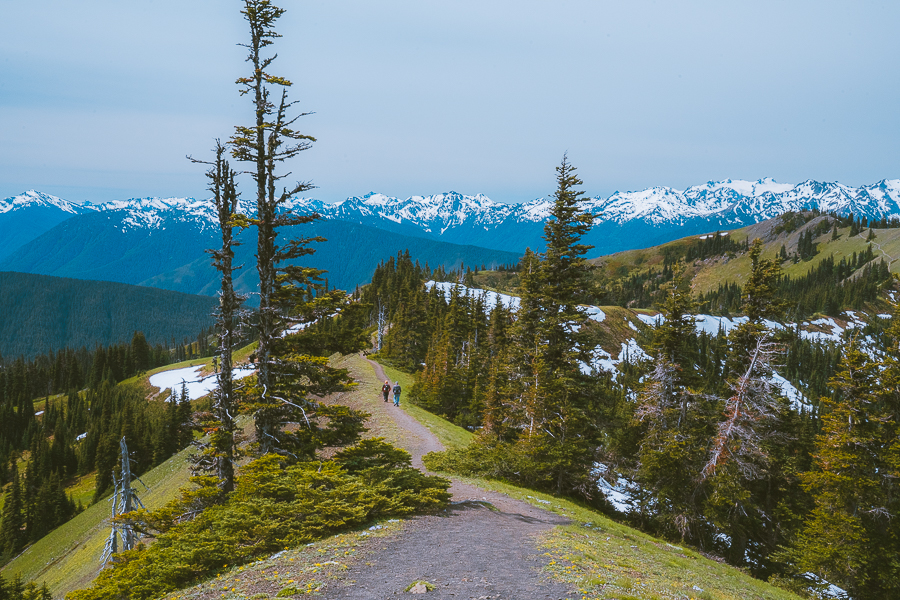
This Hurricane Ridge Hike review gives you all the details on why you’ll love this trek. So, it’s no surprise that this particular hike is an absolute favorite. The short Hurricane Ridge Loop itself is really short — less than a mile. As such, it’s great for a casual walk or a family outing.
Of course, there are longer versions of the loop you can take. Take the loop via Hurricane Hill, for example, for a 3.4-mile round trip. If you happen to be at Olympic National Park hiking along Hurricane Ridge on a clear day, you will be rewarded with a breathtaking 360-degree view of the land. You might even see all the way into Canada.
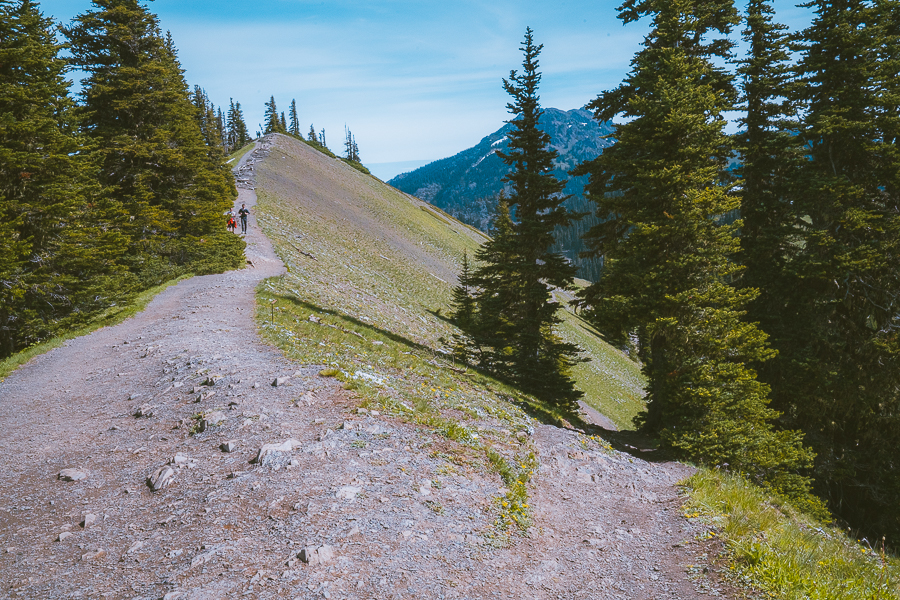
Pro Tip: Keep an eye on the weather here, as the elevation can be a factor when the weather turns nasty.
5. Shi Shi Beach
- Elevation Gain: 561 feet
- Mileage: 2 miles to the beach or 4 miles to Point of the Arches
- Difficulty: Moderate
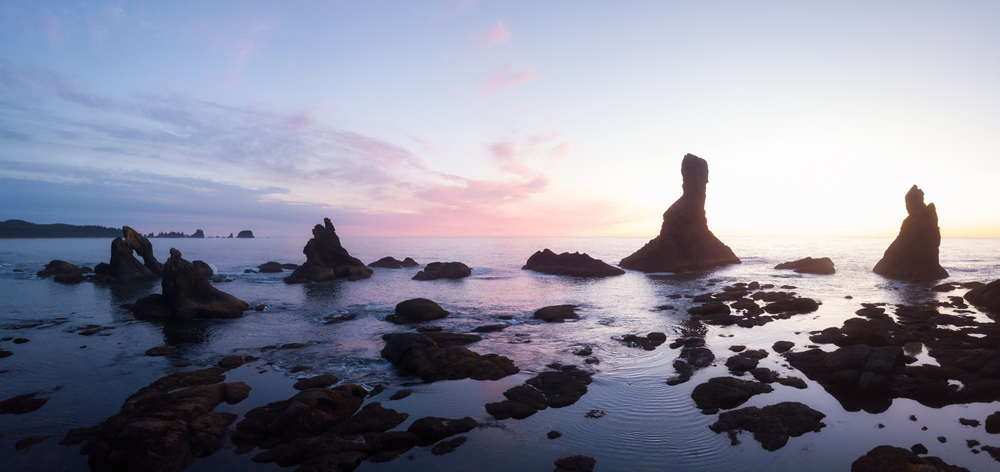
This is a relatively short hike in terms of distance, but it’s well worth spending a bit of time to stop and take in the sights. At night, the sky is also quite spectacular, and you’ll often encounter a photographer setting up to snap the stars here.
The trailhead starts at the fish hatchery and then meanders to cross lots of engineered walkways, boardwalks, and bridges. After a mile or so, the path is less maintained, and eventually, you’ll descend onto Shi Shi Beach.
This hike requires an additional permit besides the standard Olympic National Park wilderness permit. You’ll also need a Makah Recreation Pass ($20) from the museum or marina in Neah Bay.
For a longer hike, continue on to the Point of the Arches.
6. Ozette Loop
- Elevation Gain: 538 feet
- Mileage: 9.4 Miles Roundtrip
- Difficulty: Moderate to easy
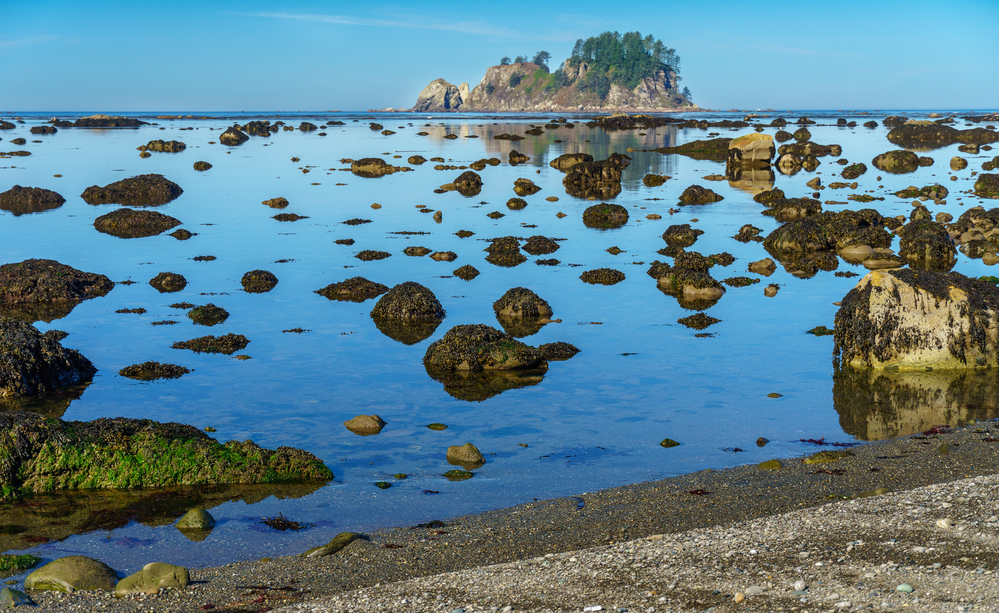
The backpacking (moderate) option for Ozette Loop is far superior to the shorter day-hike (easy) option, if only for the opportunity to get deeper into the wilderness and find the rocky and sandy beaches that are truly stunning.
It also takes a while to get to the actual loop, with the parking area and trailhead more than an hour from Port Angeles. Why not make the most of it and spend a few days in this beautiful setting?
The loop itself as a whole is like a triangle. One side meanders along the north coast, which is where you can camp on the beaches. This section of the hiking trail actually forms part of the North Coast Route, which is a spectacular route along the coastline. If you ever have the time and inclination, try to explore more of this unique hiker’s features.
Make sure to check the tide timetables, as this significantly affects the navigability and enjoyability along the ocean-side section of the hike.
The other two “sides” of the loop take you through pretty woodland paths. Breaking the trail up into a few days makes it super easy to do and more enjoyable, too.
7. Royal Basin
- Elevation Gain: 3,799 feet
- Mileage: 16 Miles Round Trip
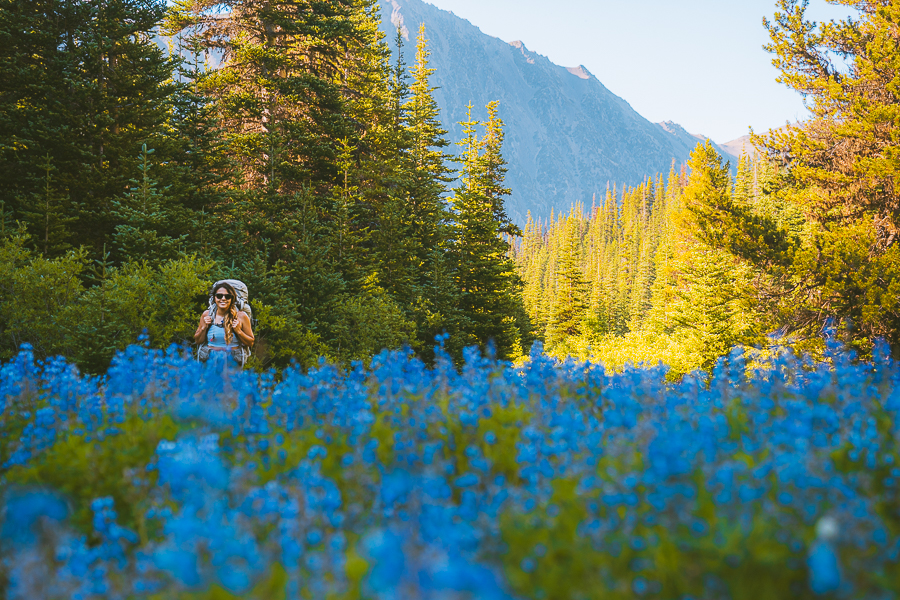
Wildflowers are among the many highlights of a leisurely trail hike at Royal Basin, especially beyond the Royal Lake. Before that, though, you’ll have to start your hike at the Upper Dungeness trail trailhead. At the bridge over the Royal Creek, you’ll turn to start the Royal Basin hike proper.
Another key landmark is Shelter Rock, an overhanging boulder that, as the name suggests, is good for a short break.
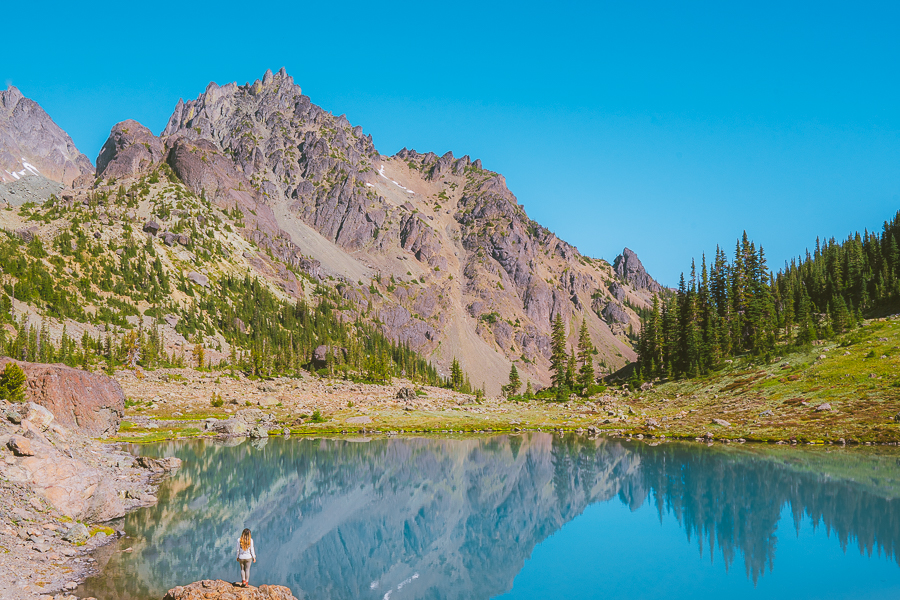
As you walk along the Royal Basin Trail, you’ll enter the Olympic National Park. There are a couple of steep-ish climbs, but soon you’ll encounter Royal Lake and a waterfall a little way beyond. Feeling more adventurous? Go further south into Deception Basin. Yes, it means extending your trip, but that’s part of the fun, isn’t it?
The Royal Basin is considered a particularly sensitive ecological area. No fires are allowed, and bear canisters are required. If you plan to camp at any of the designated sites, remember that Olympic National Park reservations are required.
Grab Your Free Car Camping Checklist! 🚗🌲
Ready to elevate your car camping game? Snag our essential checklist to ensure you’ve got everything you need for a stress-free, fun-filled adventure! Perfect for beginners and seasoned campers alike. Download now and hit the road prepared! 🌟🎒
8. Second Beach
- Elevation Gain: 278 feet
- Mileage: 2.1 miles out and back
- Difficulty: Easy to moderate
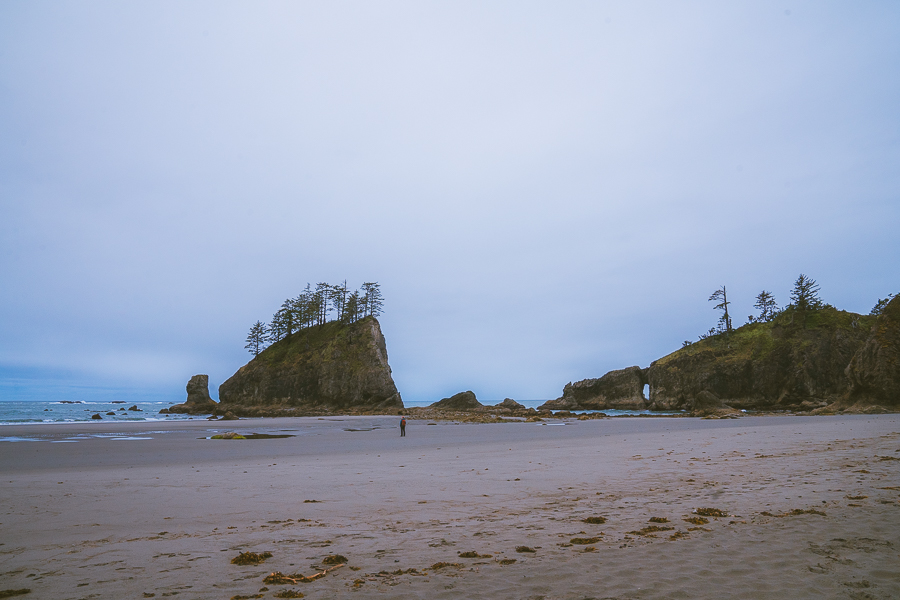
Park just outside La Push (itself a pretty whale-watching town near the mouth of the Quillayute River). Follow the route from here on foot, through some trees, across a creek, and then down towards a staircase.
From the beach, which is breathtaking (remember to check the tides), you have two options. Go north to the arch or head south toward Teahwhit Head, an unusual headland with cliffs and rocks and a broad beach.
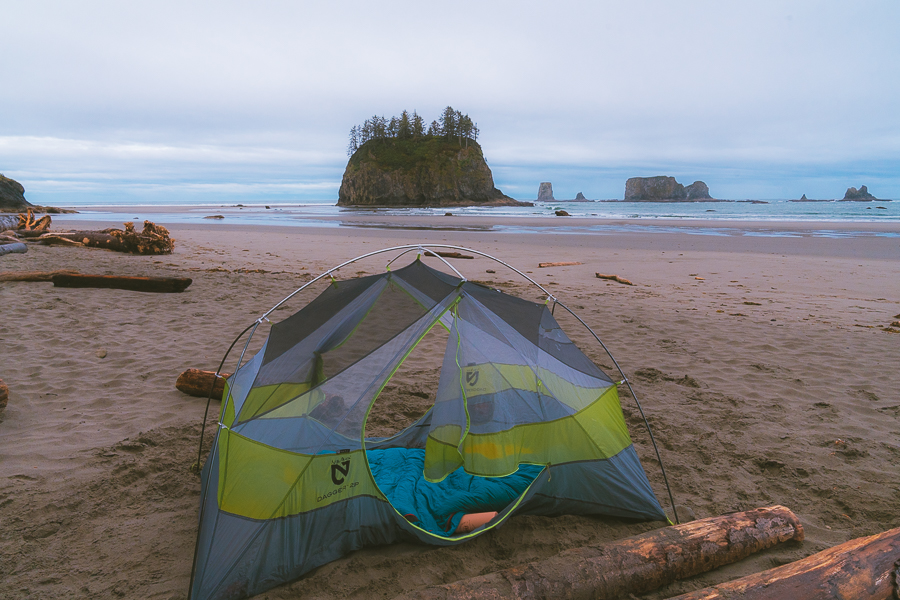
Second Beach camping is something to try if you haven’t yet. When you experience it, you will know why it’s one of the most popular beaches in Washington.
Note: You’ll pass the “cabinet tree” containing lots of people’s mementos from the beach. Authorities have requested that no more be added to the cabinet tree for environmental reasons.
9. Rialto Beach
- Elevation Gain: 108 feet
- Mileage: 3.3 Miles Round Trip
- Difficulty: Easy
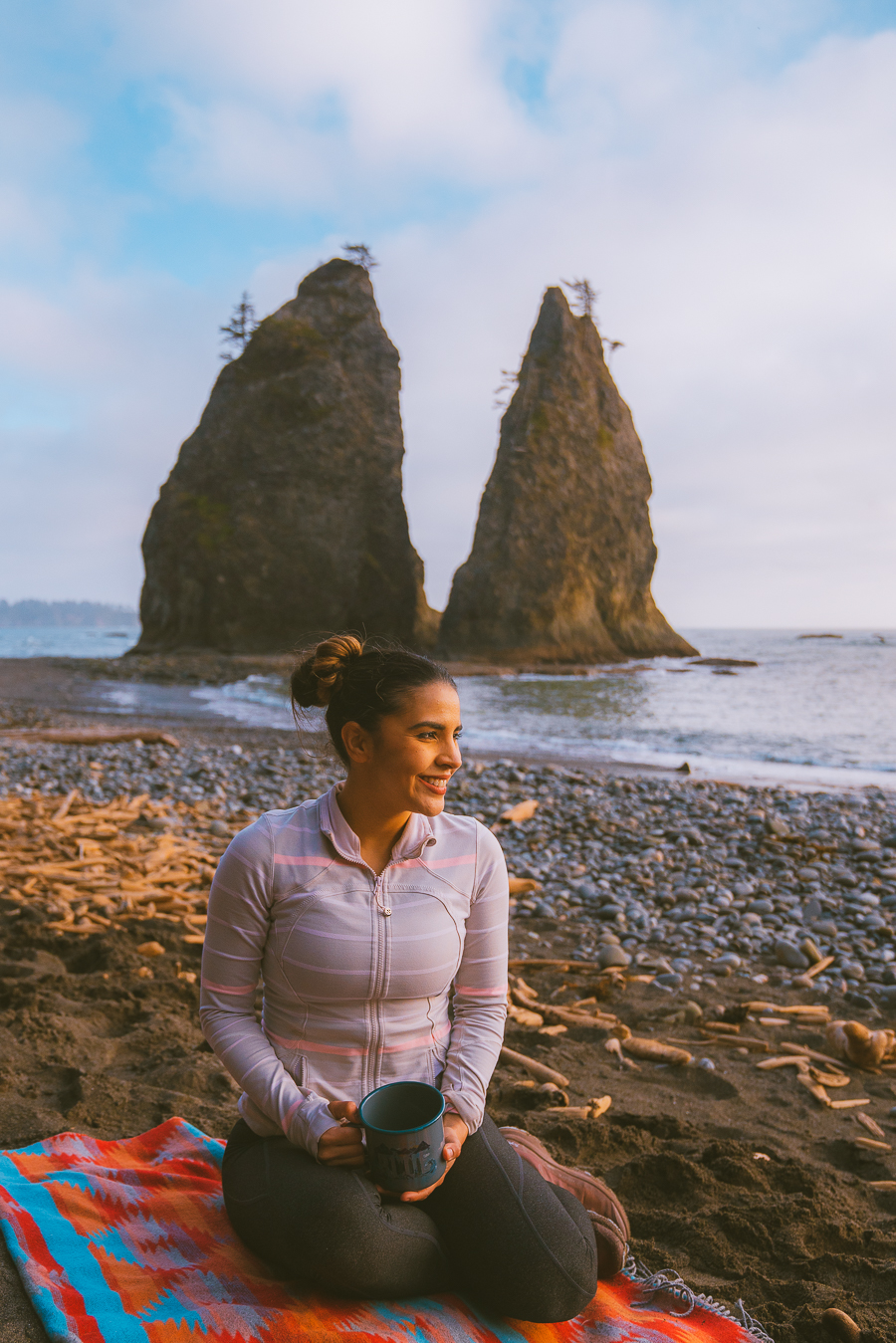
The Rialto Beach and Hole in the Wall Hike are some of the most well-known and popular in Washington. This can be a relatively challenging trek, depending on how far you choose to walk, and kicks off near La Push on the Quillayute River.
To some degree, you can choose how long to walk the beach trail. Most do a quick two-mile walk to Hole in the Wall. But there is an option to walk up to 17-18 miles to Ozette (some overland sections involved), which is ideal for Olympic National Forest backpacking.
In this case, you may want to look at overnight Olympic National Park backcountry camping along the way, which will require a permit and reservation.
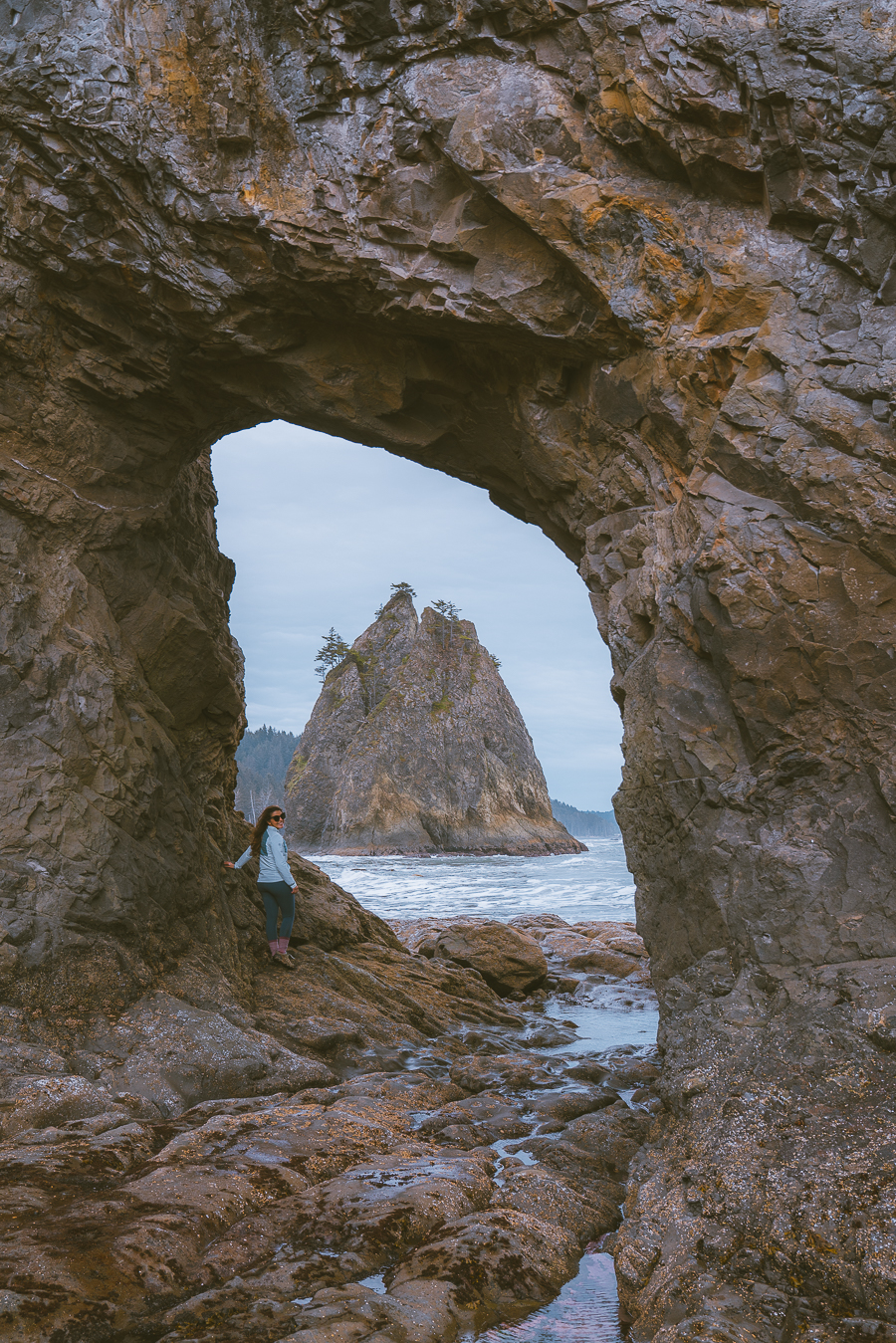
There is also a 13-mile out-and-back trail along the beach if you feel up to a brisk day-long hike. There are lots of boulders and rocky sections to traverse, though, so it’s not recommended for inexperienced hikers.
As mentioned, the longer trail can be considered challenging, depending on weather and high and low tide conditions. The coastal terrain does get a little rough in some sections. On the upside, you might see groups of spy whales or sea lions along the way.
Look to the south, and you should be able to see James Island. Otherwise, take the stroll towards Split Rock and Hole in the Wall, which is best seen at mow or minus tide.
10. Bonus Trail: Mount Townsend
- Elevation Gain: 2,982 feet
- Mileage: 8.5 Miles Round Trip
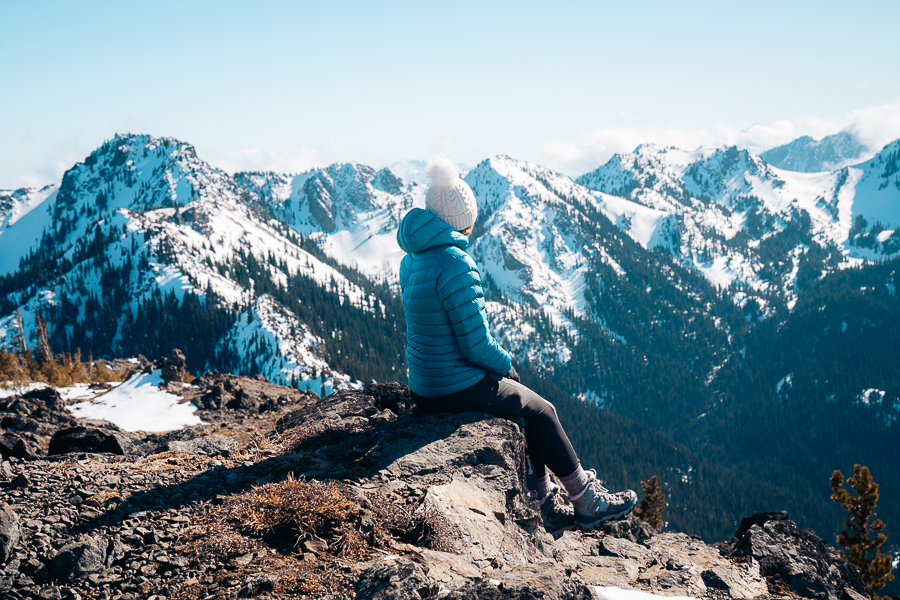
This trail isn’t technically in Olympic State Park but is close enough (about 50 miles), so consider trying out if you’re in the mood for another mountain option on the Olympic Coast. There are four trails to the top of the mountain, and you can try any one or all of them.
One of the most popular routes, the Mount Townsend Trail, the lower trailhead is often used in colder seasons, as the upper, higher trailheads may be more difficult to get to on account of snow. In warmer seasons, the upper trailheads prove to be most popular. There are also tons of wildflowers and berries throughout these months.
To the east, you catch thrilling sights across the cascades, and the valleys create interesting variations between a few waterfalls, the old-growth forest, and meadows.
Other trail options up the mountain include the Silver Lake Trail in the west, the Little River Summit in the northeast, and the Dirty Face Ridge (or Little Quilcene Trail) in the northwest.
The Best Time to Backpack in Olympic National Park
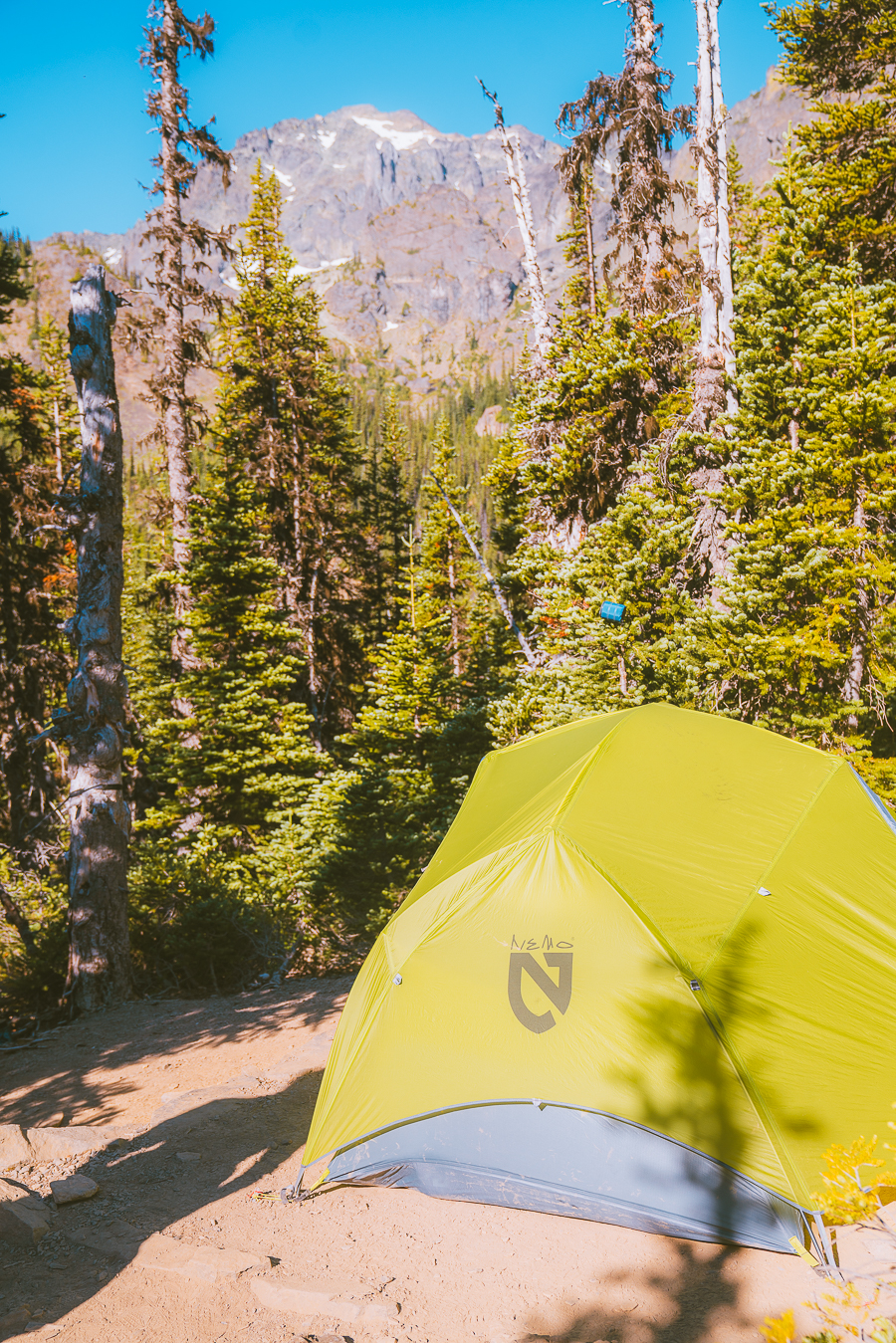
Backpacking the best hikes in the Olympic Peninsula is slightly different for everyone, depending on whether you’re a winter person or a summer person. The ideal temperature for most is between May and October. Bear in mind that Olympic National Park and Washington, in general, tend to be rainy. These months are a little drier than the others.
Going in the colder months might put you in contact with some snow on the higher elevations. Meanwhile, July and August are also the busiest periods for the park. So expect some crowds. Fall is, of course, the best time for foliage and colors in the woodlands.
Download my Washington Hiking Checklist!
Faqs about olympic national park hikes.
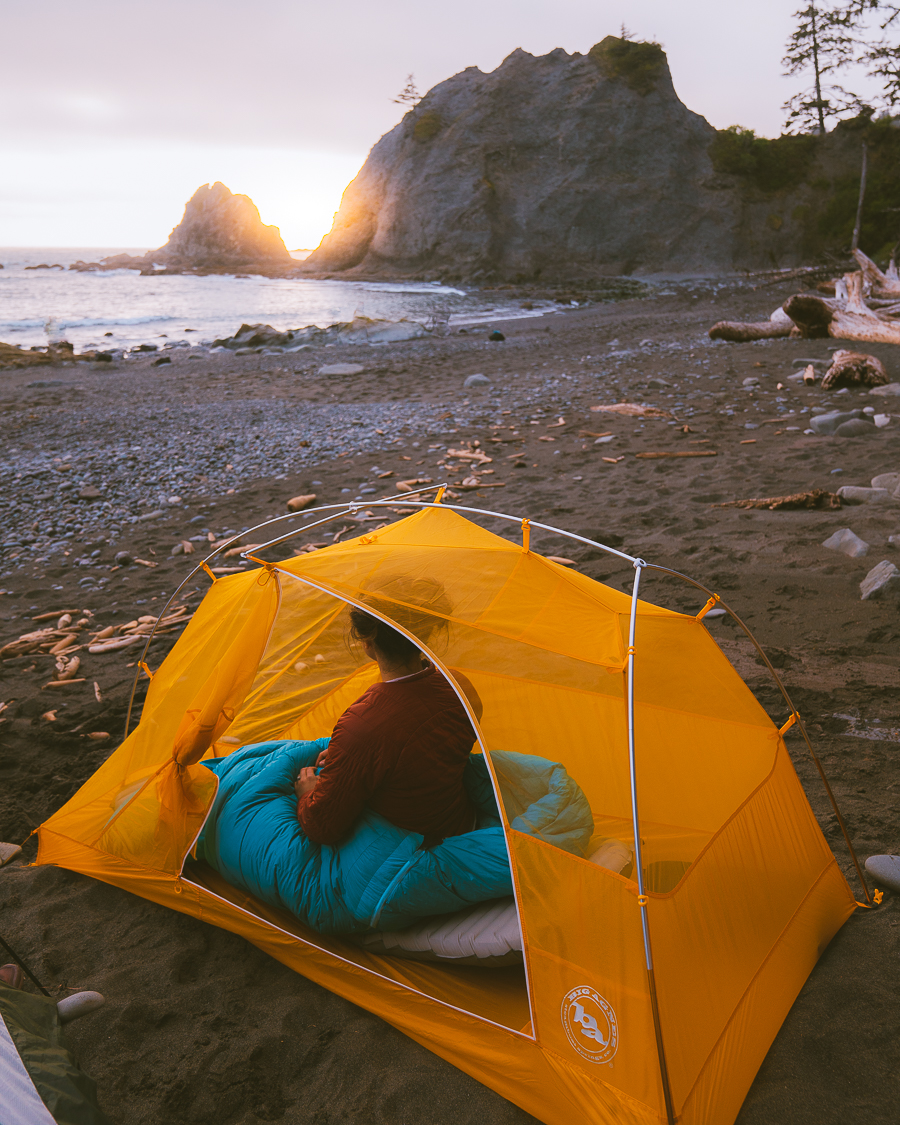
There are some FAQs commonly posed about the park and the hikes in question. Hopefully, these answer some of yours.
How Do You Backpack Through Olympic National Park?
Make sure you understand the permit requirements. For example, casual day hiking in Olympic National Park may not require a permit, depending on the trail. However, some trails require a recreation license, and overnighting will require camping Wilderness Camping Permits.
Tip: Pack smartly, accounting for cold and warmth (layers are recommended).
What Do I Need to Know Before Camping in Olympic National Park?
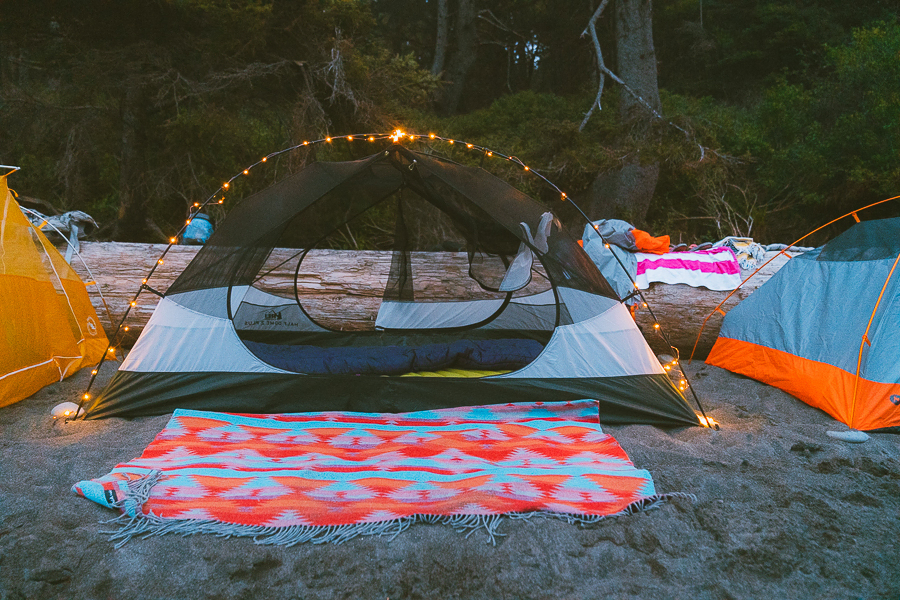
First of all, it may be a good idea to get a backpacking planner . This will assist you in planning a successful backpack excursion. It’ll check the boxes for everything from gear to meals to preparing your fitness regime.
When it comes to Olympic National Park itself, your first check should be making sure you have taken care of all your backpacking permits. You will need various permits to hike the park, camp, and so on.
You might also want to acquire a tide checker, and many parts of the coast become impassable at higher tides. Then there are bear canisters, a must, and water, of course. Keep in mind that the park mostly has a leave-no-trace policy in effect.
Which Animals Can Be Seen in the Olympic Peninsula
Visitors to the park regularly report seeing the following species in the park, just to name a few:
- Pacific salmon
Bonus Tip: Visit the Wilderness Information Center for updated information on the Olympic Mountains area and National Park before you visit. The Wilderness Information Center website should provide any last-minute news on closures, warnings, or obstructions to be aware of
Are Dogs and Pets Olympic National Park?
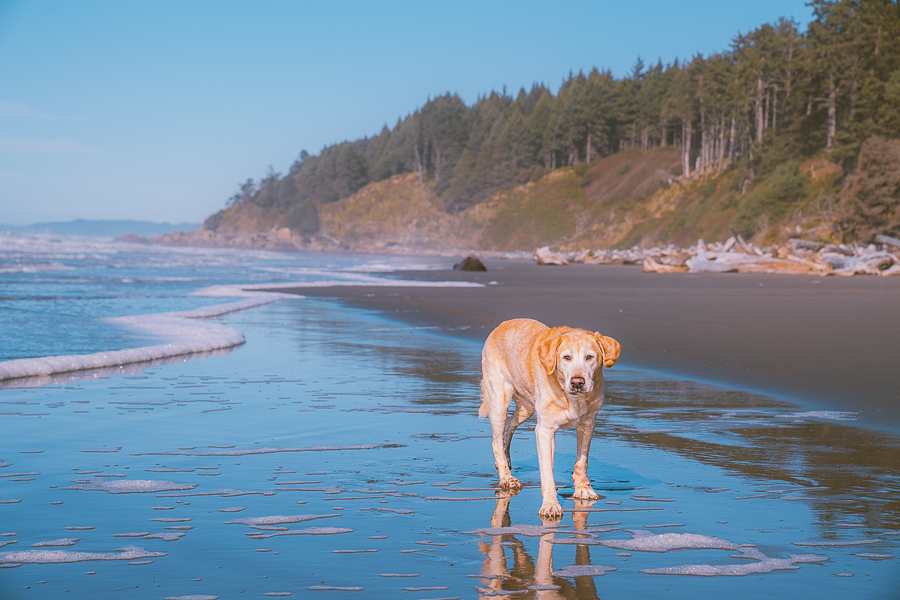
Pets are allowed on the following trails:
- Peabody Creek Trail (Olympic National Park Visitor Center in Port Angeles)
- Rialto Beach parking lot to Ellen Creek (1/2 mile)
- The beaches between the Hoh and Quinault Reservations (Kalaloch area)
- Madison Falls Trail (Elwha)
- Spruce Railroad Trail (North shore of Lake Crescent)
- July Creek Loop Trail (North shore of Lake Quinault)
Can I Camp Anywhere in the Olympic National Park?
There are specifically designated and demarcated camping spots in Olympic National Park. You are not allowed to sleep in your car unless you are in one of these designated camping areas. All the places you’ll be camping need to be reserved ahead of time due to limited space.
Most of the sites have a maximum capacity of 12 persons. Usually, permits cost $8, with additional permit fees.
Final Thoughts on Best Backpacking in Olympic National Park Trails
Which one of these amazing Olympic Peninsula Backpacking hikes sounds the most intriguing? It’s hard to decide, isn’t it?
First of all, your love for walking in the wilderness will definitely be satiated. But the added advantage of so many ecosystems and biomes will definitely intrigue the “spotter” in you.
Choose from an incredible adventure in the mountains, along the rivers, by the lakes, or next to the ocean. Stay as many days and nights as you can manage, or simply take a day out to do a quick loop. For more great hikes, check out my guide on Spring hikes in Washington State .

Get my free National Park Checklist
When you join the newsletter, pin for later:.
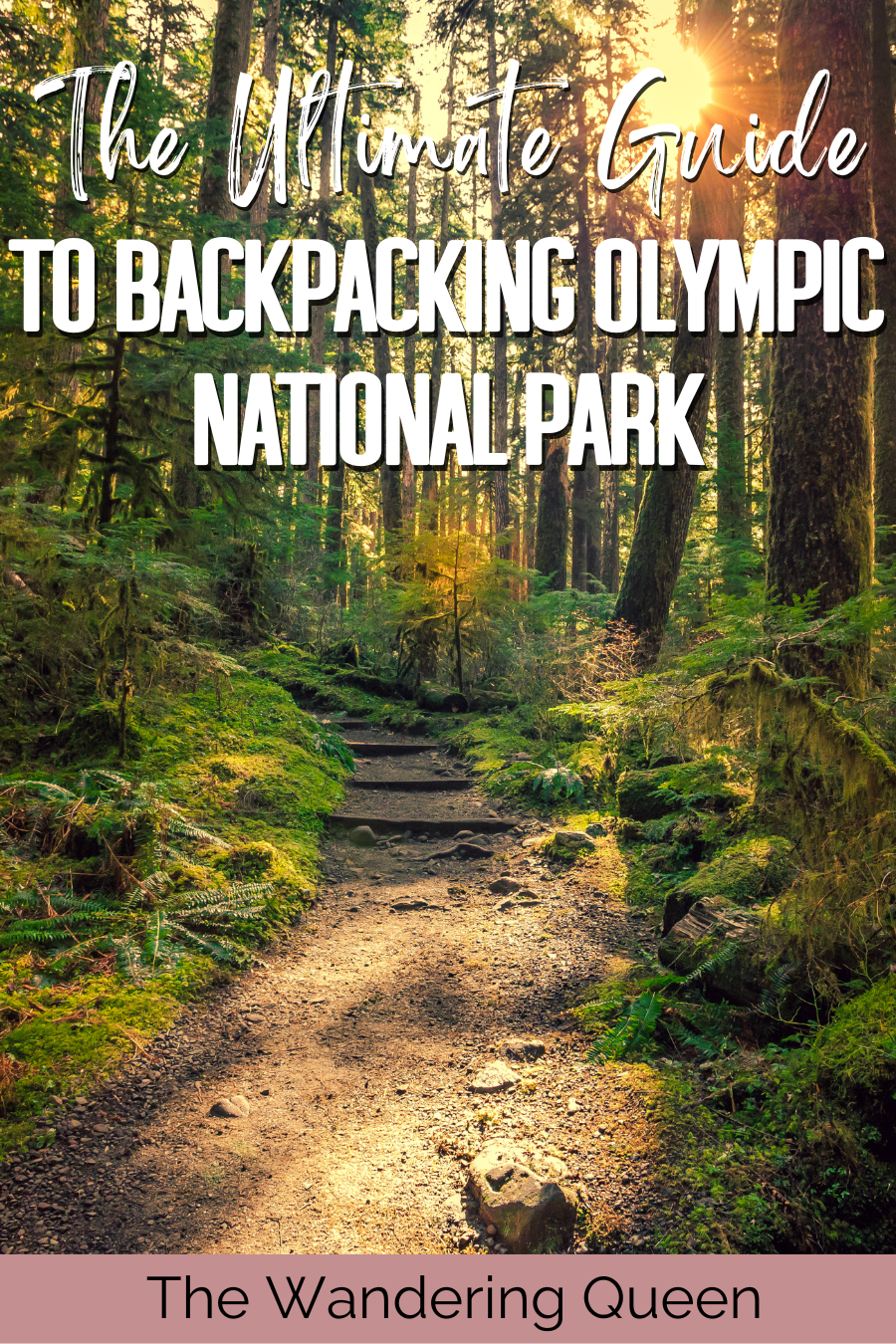
Similar Posts
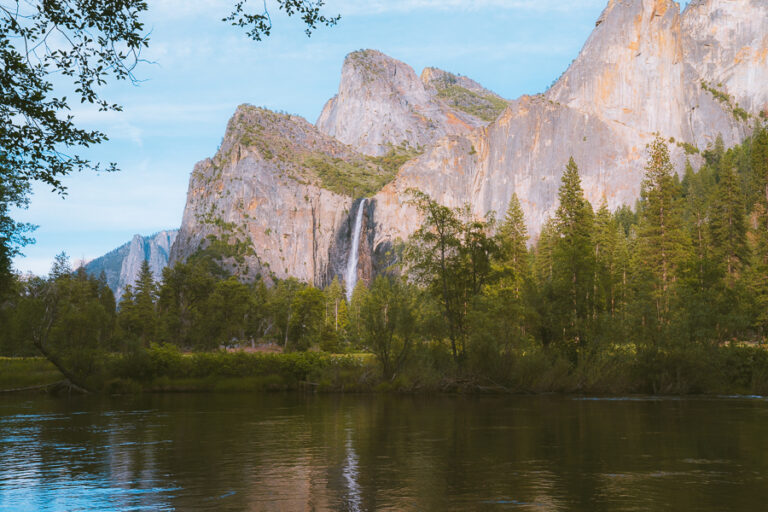
15 Things to Do in Yosemite National Park | Fun Activities + Tips
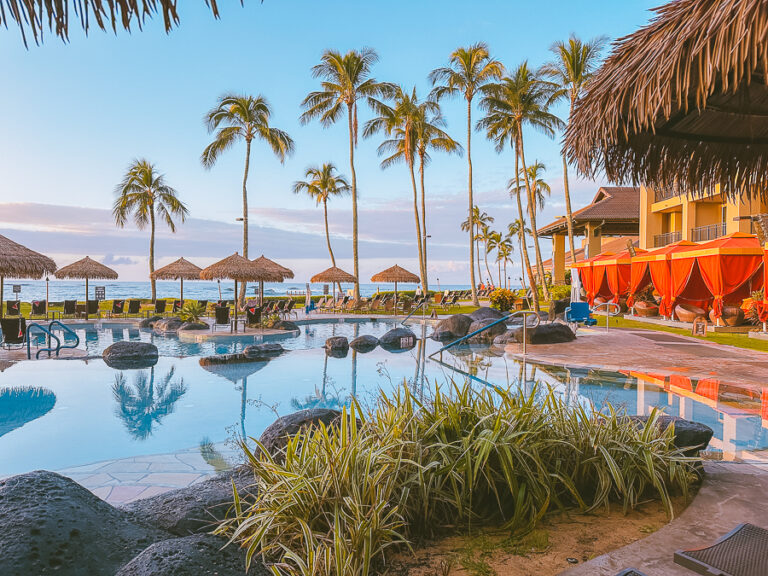
Where to Stay in Kauai | 11 Best Hotel & Lodging Options
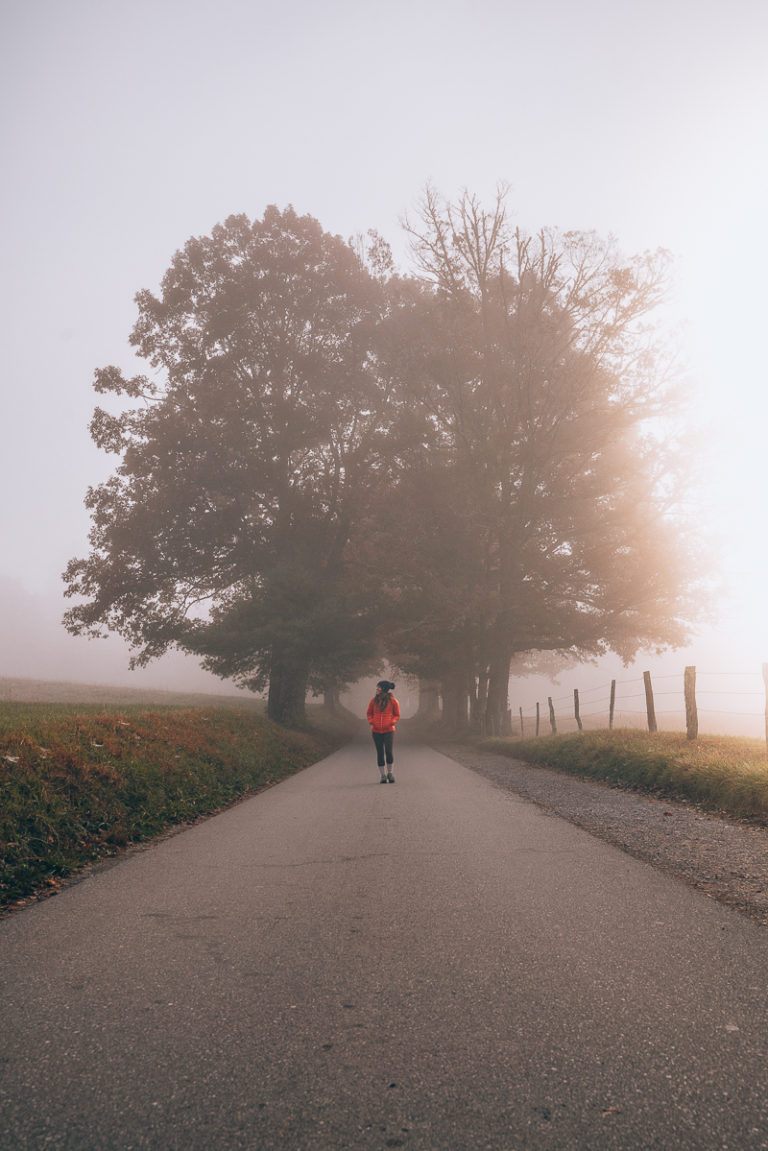
The 8 Best Great Smoky Mountain Hikes
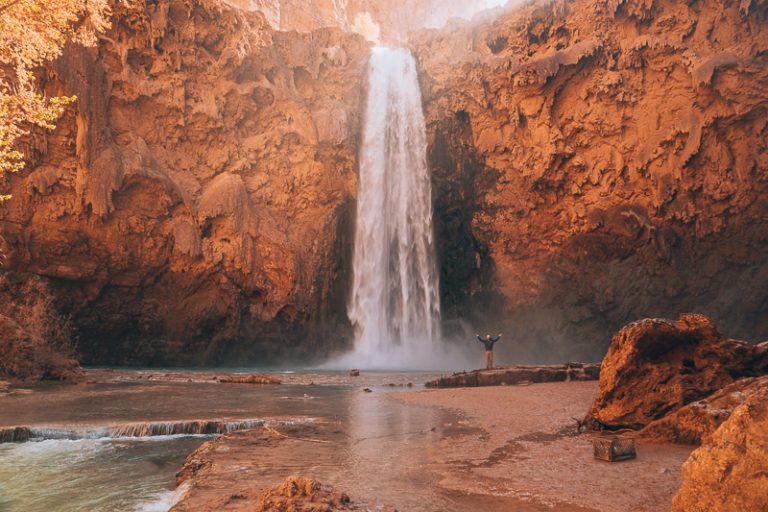
Ultimate Guide On The Mooney Falls Hike
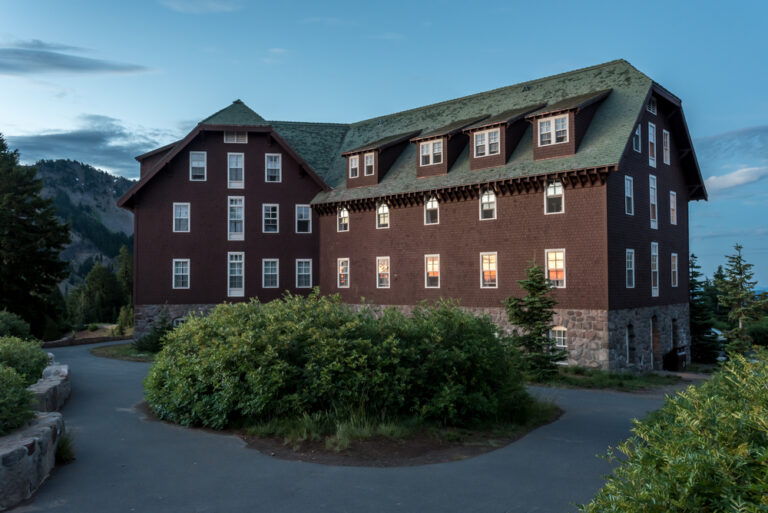
Where to Stay Near Crater Lake National Park | Lodging & More
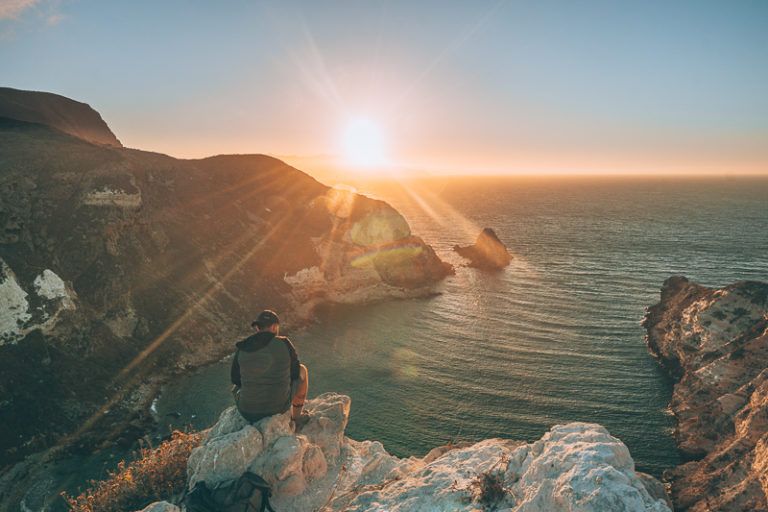
The Ultimate Channel Islands Camping Guide
Leave a reply cancel reply.
Your email address will not be published. Required fields are marked *
Save my name, email, and website in this browser for the next time I comment.
This site uses Akismet to reduce spam. Learn how your comment data is processed .
- United States
- Olympic National Park
- Backpacking
Olympic National Park, Washington
Looking for the best backpacking in Olympic National Park? We've got you covered with the top trails, trips, hiking, backpacking, camping and more around Olympic National Park. The detailed guides, photos, and reviews are all submitted by the Outbound community.
Top Backpacking Spots in and near Olympic National Park
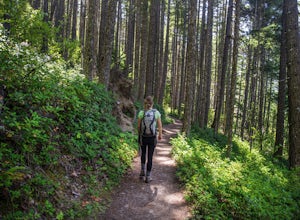
Hike Through History Along the Elwha River
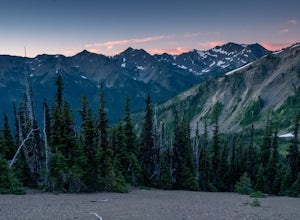
Badger Valley Trail to Grand Pass Trail Loop
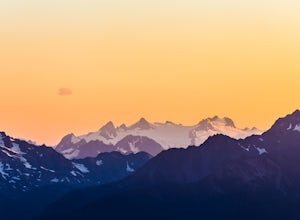
Hike to Elk Mountain from Obstruction Point

Backpack to Grand Park in the Olympics
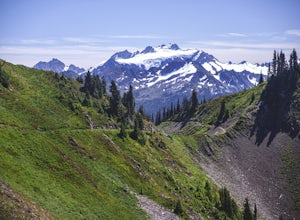
High Divide and 7 Lakes Basin
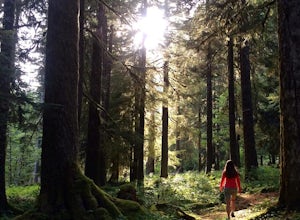
Backpack to Enchanted Valley Chateau
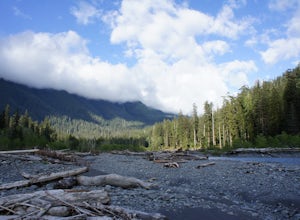
Backpack the Hoh River Trail
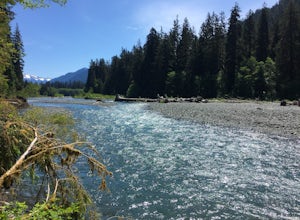
Hike the Hoh River Trail to Five Mile Island
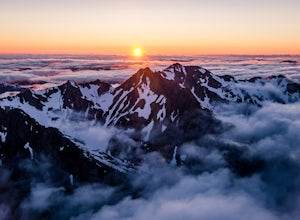
Climb Mount Olympus, Olympic NP
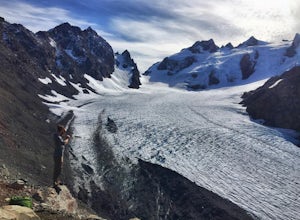
Backpack the Hoh River Trail to Blue Glacier
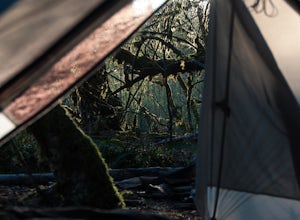
Backpack the Hoh River to Tom's Creek Campground

Olympic Hot Springs

Backpack to Lake Angeles
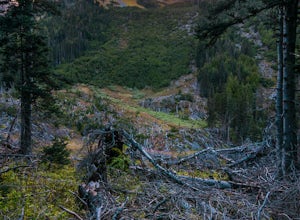
Backpack 1000 Acre Meadows
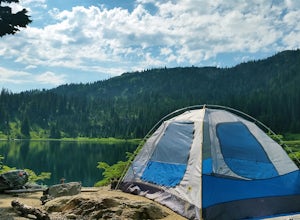
Upper Lena Lake
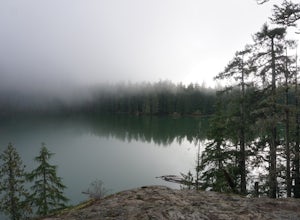
Top Activities
- Photography
- Local Adventures
- Tours and trips
- Camping Nearby
- Outbound PRO Membership
- Add your property
Mobile Apps

© 2024 The Outbound Collective - Terms of Use - Privacy Policy
Enchanted Valley in Olympic National Park: Backpacking Guide
Published by sarah vaughan on july 24, 2023 july 24, 2023.
Featuring verdant old growth forests, glacial-fed streams, some of the best views of the Olympic Mountains, and even a historic chalet, there are plenty of reasons why the hike to the Enchanted Valley in Olympic National Park is one of the most popular backpacking trips on the Olympic Peninsula. The 26 mile trail to the Enchanted Valley brings you deep into the Olympic National Park backcountry, providing access to areas of the park few visitors get to experience. In this article, we’ve outlined all the information you need to plan your next adventure to the Enchanted Valley in Olympic National Park!

Two Outliers may contain affiliate links, which means we make a small commission at no extra cost to you. As an Amazon Associate, I earn from qualifying purchases at no extra cost to you. For more information, see our privacy policy . Thank you for your support.
enchanted valley in olympic national park
Nestled deep in the wilderness of the southwestern corner of Olympic National Park, the Enchanted Valley is one of the best hiking trails on the entire Olympic Peninsula.
The trail follows along the rushing Quinault River, through old growth forests of towering Sitka spruce trees and across rickety bridges. Home to all types of wildlife, Enchanted Valley in Olympic National Park also offers a great opportunity to see black bears, elk, deer, and many other forms of plant and animal life.
The Enchanted Valley sits at just over 2,000 feet above sea level and is surrounded by the magnificent, snow-capped peaks of the Olympic Mountains in all directions.

Enchanted Valley Chalet
At the entrance to the Enchanted Valley, you’ll find the famous Enchanted Valley Chalet, which was built in the 1930’s to help encourage visitors to the area. All building materials were hauled up the 13 mile trail by horses, allowing for the construction of the chalet in its remote location.
Perhaps unsurprisingly in hindsight, the Chalet became too expensive to operate as a restaurant and hotel for weary hikers and it was converted to a lookout base during WW2 for Japanese airplanes. While the Chalet still stands today, it is boarded up and closed to visitors. Even so, it is a welcome sight to see after 13 miles of hiking!

enchanted valley backpacking overview
- Distance | 25.5 miles
- Elevation | 3,254 feet
- Difficulty | Moderate
- Permits required | Yes
- Fires allowed | Yes
- Dogs allowed | No
Find this hike on AllTrails | Enchanted Valley Chalet via Easy Fork Quinault River Trail
Note on difficulty | We’re rating the Enchanted Valley hike as moderately difficult if broken up over the course of two or three days. Even over two days, the hike is long but the elevation gain is gradual, making it moderately difficult as far as backpacking trips go.
Other PNW Resources
Looking for more to do in the Pacific Northwest?! We’ve got lots of resources to help you plan your trip!
- Diverse landscape including lush rainforest, old growth forests, glacial-fed streams, and towering, snow-capped mountain peaks
- Gradual elevation make this an ideal backpacking trip
- Plenty of great campsites and unlimited backcountry permits mean you don’t need to worry about competing for a limited number of campsites/permits
- Great base to explore more remote trails deeper in the Olympic National Park backcountry
- Long trail to reach the Enchanted Valley before any big mountain views
- Unlimited permits means there will be crowds and you’ll need to search around for a private campsite
- While views in Enchanted Valley are beautiful, the best views are deeper into the backcountry
Enchanted Valley in Olympic National Park | Know before you go

Enchanted Valley packing list
Below is a list of gear we’d recommend packing for backpacking to Enchanted Valley in Olympic National Park.
Bug Spray | The mosquitos around the river can be pretty brutal.
Warm Layers | Arc’teryx Cerium LT Hoody Even during the summer, it gets quite cold at night here. Pack a warm sleeping bag and extra layers for when the sun goes down. My Arc’teryx jacket is incredibly warm, lightweight and packs down small!
Water shoes | Chacos Great for wearing around camp or for wading into the river.
Bathing suit | Is there anything better than laying in the sun on a warm summer day beside the river after hiking 12 miles? The water is cold, but dipping your feet in feels great after long day of hiking!
Compact towel | PackTowl l ightweight towel This compact lightweight towel packs down small, making it great for carrying on backpacking trips and perfect for drying off after taking a dip in the river!
Bear Spray | Counter Assault Since there are black bears in the area, carrying bear spray with you is a good idea.
Bear Can | BearVault Bear canisters are required in Enchanted Valley by Olympic National Park. We can typically share the small can for short trips (1 – 2 nights) and the larger can or two small cans for longer trips.

Our Backpacking Essentials
Good gear can make all the difference on a backpacking trip. Below we’ve compiled a list of our tried and true backpacking gear essentials – we use these items every time we backpack and couldn’t live without them.
Backpack | 40L Osprey Tempest / 65L Osprey Ariel / 55L REI Co-Op Flash For one-night backpacking trips, I (Sarah) love my 40L Osprey Tempest! It fits the essentials but is super lightweight. For longer trips and/or carrying more weight, the 65L Osprey is more spacious, really comfortable, and provides more hip support. Matt’s go-to pack for most trips is the lightweight 55L REI Flash.
Backpacking Tent | Mountain Hardwear Aspect 3 A reliable tent makes all the difference in the backcountry, and the Mountain Hardwear Aspect 3 has not let us down. Though it’s not cheap, it’s lightweight (less than 4 pounds), durable, easy to set up and feels spacious enough to fit 2 people comfortably.
Campstove | Jetboil Flash Picture this: you wake up in the dark in the backcountry, aiming to catch the sunrise somewhere nearby but its so cold you don’t want to get out of bed… then you remember you’ve got a Jetboil and piping hot coffee can be ready within minutes! Morning made.
Coffee | Sea to Summit Collapsible Coffee Filter If you’re a coffee snob (like me…) who needs *real* coffee in the morning, even in the backcountry, the compact Sea to Summit collapsible filter makes it easy. Pair with the Jetboil Flash and Sea to Summit cups and you’ll have your cup of joe in no time!
Sleeping Bag | REI Co-op Women’s Magma 30 / REI Co-op Men’s Magma 30 At this price point, you can’t beat the REI Co-op Magma 30 (Women’s and Men’s). We both use this sleeping bag, and it’s lightweight enough for backpacking without sacrificing on warmth and durability.
Sleeping Bag Liner | Sea to Summit Reactor Thermolite Sleeping Bag Liner I’m a very cold sleeper so I often bring this Sea to Summit sleeping bag liner,even for summer nights. It’s super cozy, lightweight, adds 8 degrees of warmth and helps keep your sleeping bag cleaner.
Trekking Poles | Black Diamond Distance Z Trekking Poles / Distance NFZ Tre kking Poles I had always thought trekking poles were silly until one very steep, exposed, slippery hike in Death Valley left me feeling quite insecure even with solid tread on my boots. Immediately after I bought my Black Diamonds and haven’t hiked without them since.
Sleeping pad | Women’s Therm-a-rest NeoAir Xlite Sleeping Pad / Therm-a-rest NeoAir Xlite Sleeping Pad I often sleep better on my Therm-a-rest sleeping pad than I do in a hotel bed… this thing is so comfy and weighs only 12 ounces! Only downside I have found is it is a bit noisy if you tend to move in your sleep a lot.
Inflatable Pillow | Sea to Summit Aeros Ultralight Pillow This Sea to Summit inflatable pillow is super lightweight and packs down tiny (I’ve actually lost it a few times because it packs down so small), so it’s great for camping and backpacking trips. The best part, it’s shockingly comfortable! I am a light sleeper (in a normal bed), so this is huge for me!
Dehydrated Meals | Backpacker’s Pantry Pad Thai with Chicken Backpacker’s Pantry has a huge variety of dehydrated meals that we’ve found to be surprisingly tasty. The Pad Thai and Chana Masala are our all time favorites!
GPS | Garmin InReach Mini The one piece of gear you hope you never need to use, but is worth its weight in peace of mind. We always carry our Garmin In-reach Mini in case of emergency in areas without cell service and it gives us (and our parents) peace of mind. It can also be used to simply let a loved one know you’ve arrived at your destination.
Headlamp | Black Diamond Storm 400 Navigating around a campsite is nearly impossible after dark without a headlamp. We both use Black Diamond Storm 400’s, and we’ve found them to be reliable and long-lasting despite the compact size.
Water Filter | Katadyn BeFree 1.0L Water Filter There is plenty of water along the trail so we highly recommend packing a water filter to save some water weight. The Katadyn BeFree is small and couldn’t be easier to use.

How difficult is Enchanted Valley in Olympic National Park?
As noted above, we’re operating under the assumption that most of the people reading this article are planning to backpack and spend at least one night in the Enchanted Valley (two nights is even better, more on this below!).
With that in mind, we’re rating this as a moderately difficult backpacking trip. Covering about 13 miles, the hike into the Enchanted Valley is not a short hike by any means. However, with an elevation gain of just over 3,000 feet, the trail is actually quite gradual, easing the difficulty level quite a bit.
The trail follows along the East Fork of the Quinault River, ambling through the ups and downs of the forest along the river bank, with no super steep inclines or declines. With the long distance but gradual elevation gain, the hike to the Enchanted Valley is certainly a challenge but nothing too difficult.
It took us about 6 hours total to hike from the trailhead to the Enchanted Valley, stopping twice for snacks and lunch. Admittedly, we were hiking pretty fast as we wanted to snag a good campsite so 6 hours is probably a bit quicker than usual.
We’d recommend planning for a 7 hour hike both in and out of the Enchanted Valley.

When to backpack Enchanted Valley
One of the great things about the Enchanted Valley hike is that it has a longer peak season than most of the other hikes in Olympic National Park. The best time to hike to the Enchanted Valley is anytime from late May to late September.
Because Enchanted Valley sits at just over 2,000 feet above sea level, it tends to clear out of snow earlier in the season and is generally warmer than other higher-elevation hikes in the area. You should be able to reach the Enchanted Valley without encountering too much snow by late May. However, always be sure to check for current conditions before starting your journey.
Earlier in the season (May to early July) is a great time to hike to the Enchanted Valley, as snow will still be melting at higher elevations, meaning the waterfalls in the area will be full and the Quinault River will be gushing. However, if you plan to hike deeper and higher into the backcountry, you will likely experience some lingering snowfields.
Later in the season, you can expect drier conditions and fewer waterfalls, but there will be less chance of snow impacting your plans.
Overall, from May through September, you can expect warm-to-hot daytime temps (typically in the 70’s F) and cool nights (usually in the 50’s F). Of course, always check the weather before you begin your hike.
Remember you’re in the PNW: weather can change rapidly and rain showers are possible at any point in time. Always be prepared for rain!

Enchanted Valley trailhead
The trailhead for the Enchanted Valley hike is located in the southwest corner of Olympic National Park, about 45 minutes past Quinault Lake. More precisely, the trailhead is located here , or right next to the Graves Creek Campground.
The last 10 to 15 miles leading up to the trailhead are on a dirt road, which is generally well maintained, apart from the many potholes. You should be able to make it to the trailhead with any car. You’ll just need to be extra careful to avoid some of the potholes if you have a low clearance vehicle.
We have not tried to reach the trailhead while it is raining, which could cause the road to become muddy, so always use your best judgment.
Parking at the trailhead
As Enchanted Valley is one of the more popular backpacking trips in Olympic National Park, the parking at the trailhead is a bit tight. The parking lot is really just the end of the road with only maybe 20-30 clearly designated parking spots.
However, there are plenty of small pull-outs along the side of the road for the last half a mile or so where you can park. As such, you should not have a problem finding a place to park near the trailhead. However, some of these parking spots could be quite a bit down the road, adding a not-insignificant difference to the distance you’ll be hiking.
Like all popular hikes, we highly recommend you get to the trailhead and begin your hike as early in the day as possible.

Where to stay before Enchanted Valley
With a long day of hiking ahead of you and competition for the best campsites, you’ll want to spend the night before your Enchanted Valley hike as close to the trailhead as possible. For better or worse, the trailhead is remote and there are not many lodging options nearby.
However, there are a few good options for lodging the night before the hike to Enchanted Valley, which we’ll describe below.
Graves Creek Campground
Graves Creek Campground is located right at the trailhead to Enchanted Valley and is the most convenient place to stay the night before you begin your hike.
Graves Creek Campground is fairly rugged, with only pit toilets and no running water available. RVs and trailers are not allowed due to the road conditions leading up to the campground/trailhead. Tent sites cost $20 per night.
However, the Graves Creek Campground has only 30 sites and they are all first-come, first-served. We’ve read that the campground fills up fairly early on busy weekends. Being so far from any other lodging options, we didn’t want to risk driving all the way to Graves Creek Campground and not find a spot, so we decided to camp at a Big Spruce RV Park and Cabin Rentals in Humptulips.
That being said, if you can get there early, Grave Creek Campground is the best option to stay the night before your hike to Enchanted Valley.
Big Spruce RV Park and Cabin Rentals
Located about just over 1 hour southwest of the trailhead for the hike to the Enchanted Valley in Olympic National Park, Big Spruce RV Park and Cabin Rentals is a solid option the night before your hike.
Nothing fancy, but clean restrooms, reasonable prices, and plenty of space make Big Spruce RV Park and Cabin Rentals the perfect quick stop on the night before your hike to the Enchanted Valley.
Lake Quinault Lodge
Built in 1926 with a rustic cabin-esque vibe and located right on the beautiful Quinault Lake, the Lake Quinault Lodge is your best option if you’d like to sleep in a cozy bed and enjoy the luxuries of a highly-rated hotel the night before your trek to the Enchanted Valley.
Rooms start at $410 per night and the lodge is about 50 minutes from the trailhead.

Day hike vs. Backpacking the Enchanted Valley in Olympic National Park?
We highly recommend planning to backpack into the Enchanted Valley so you can fully enjoy everything this amazing area has to offer.
The hike to reach the Enchanted Valley is 13 miles each way. While the elevation gain is gradual, we do not recommend trying to day hike the full 26 miles in one day!
Even more so, some of the best views on the trail are in the Enchanted Valley, making it an amazing place to spend the night and you’ll definitely regret trying to rush through if you don’t backpack.
And finally, if you still need convincing, there are some amazing trails that lead deeper into the backcountry with majestic, sweeping views of the southern Olympic Mountains, that you can only access if you backpack and spend at least two nights in the Enchanted Valley.
Not only will you feel rushed if you choose to day hike to the Enchanted Valley, but you’ll also miss out on the best parts of the entire experience – sleeping under the stars in the Enchanted Valley and exploring the trails even deeper into the backcountry!

Enchanted Valley olympic national park Backpacking permits
If you want to spend the night sleeping under the stars, deep in the Olympic National Park backcountry, you’ll need to get a backpacking permit from the National Park Service.
For better or worse, there is not a limit to the number of permits issued by the National Park Service for Enchanted Valley. This means that you do not need to stress about getting a permit as soon as they become available, as you won’t be competing for a limited number of reservations.
However, this also means that the camping area can be pretty crowded, especially during popular weekends (we camped during the Fourth of July and there must have been a hundred tents in Enchanted Valley!).
You can reserve your permits at Recreation.gov . Select the “Quinault” starting area, then enter your group size and dates.
There is a $6 reservation fee and each person included on the permit is $8 per person per night. You do not need to pick up your permits in person but there likely will be a ranger checking permits in Enchanted Valley. Make sure you have your permits printed out or saved to your phone.

Camping areas along the trail
There are four camping areas along the trail to the Enchanted Valley in Olympic National Park: Pony Bridge, O’Neil Creek, Pyrites Creek, and the Enchanted Valley itself. Below are some details on each of the camping areas:
- Distance from trailhead | 2.5 miles
- Number of campsites | 3
- Distance from trailhead | 6.9 miles
- Number of campsites | 6
- Privy | Yes
- Distance from trailhead | 10 miles
- Number of campsites | 12
- Distance from trailhead | 13 miles
- Number of campsites | Technically unlimited
- Privy | Yes (2X)
If you can’t make it all way into the Enchanted Valley or all the way out in one day, these additional campgrounds offer plenty of other camping options along the trail.
You will need to get a permit for each campsite, as outlined in the “Backpacking Permits” section above.
Where to Camp in Enchanted Valley
While there are three other camping areas along the trail, camping in the Enchanted Valley is easily the most popular , and rightfully so! Situated just past the historic chalet, nestled along the banks of the gushing Quinault River and covered by towering spruce and birch trees, you’ll find plenty of available campsites: the perfect spot to lay your head for the night.
As you continue along the trail into the Enchanted Valley, you’ll see tons of already established campsites, many with existing fire rings. As always, it’s best to use what’s already there and you should do your best to camp only in established campsites.
Most of the campsites are beyond the chalet, although there are a few before you reach the chalet. There is a little spur trail that goes along the river bank and leads through many campsites giving you prime access to the cold, flowing waters of the Quinault River.

The Best Enchanted Valley Itinerary
With all that logistical info out of the way, let’s talk about the best itinerary for the Enchanted Valley in Olympic National Park.
We strongly recommend a three day, two night backpacking trip, with both nights spent camping in the Enchanted Valley. This will allow you to have a full day to hike deeper into the backcountry and explore everything this amazing area has to offer. We’ve broken down our day-by-day itinerary below.
Day 1 | Hike to Enchanted Valley
Arrive at the trailhead and start hiking as early as possible. You have a long hike and plenty of competition for the best camp spots, so you’ll want to get moving as early as you can. The trail up to Enchanted Valley is long but the elevation gain is gradual so you should be able to move fairly quickly, despite your heavy pack.
The trail passes through old growth forest with towering sitka spruces and lush ferns covering the ground. You’ll cross over countless glacier-fed streams, gushing with crystal clear water.
You’ll spot a handful of picturesque waterfalls and, if you’re lucky, you might even be able to catch a glance of a bear, elk, deer, or other type of common wildlife.
Soon enough, you’ll see the Enchanted Valley Chalet and the views will start to open up – this is when you’ll know you made it to the Enchanted Valley! Once you’ve made it to the Enchanted Valley, you can begin looking for a campsite for the night.
Enjoy some well-deserved rest after a long day of hiking!

Day 2 | Day hike from enchanted valley
Day 2 of your Enchanted Valley itinerary is devoted to exploring the trails deeper in the backcountry of Olympic National Park . Thankfully, you’ll be able to leave most of your heavy gear at your campsite, as you’ll be returning to the same spot later in the day.
On Day 2, you basically have two options for hiking deeper into the Olympic National Park Backcountry, both are magnificent and you really can’t go wrong with either choice.
The first option is to hike towards O’Neil Pass for sweeping views of the Enchanted Valley from up above. Alternatively, you can head towards Mount Anderson and the Anderson glacier , for an up-close experience with one of the most beautiful mountains in the southern Olympic Range.
For both O’Neil Pass and Anderson Glacier, you will begin your hike by heading northeast, continuing along the Quinault River and the Enchanted Valley trail. You’ll stay on this same trail for about 3.2 miles and 1,200 feet of elevation gain, depending on where you set up camp in the Enchanted Valley.
At this point, you’ll reach a junction in the trail. Turning right, or to the south, will bring you towards O’Neil Pass, while continuing straight or to the northeast, you’ll head towards the Anderson Glacier.

Trail towards O’Neil Pass
We chose to head towards O’Neil Pass, as a friend said that the views along the trail of the Enchanted Valley were magnificent, and they were totally right. After the trail junction, you’ll continue through the forest for about a mile, until you’ll reach the most picturesque meadow we’ve ever seen. Here, the views completely open up on both sides, featuring mountain views in all directions. ,
A babbling stream, fed by melting snow, cuts through the grass and wildflower filled pasture, the perfect spot to take a break and relax for a while! The meadow is about 4.5 miles from the Enchanted Valley, making it a good turn-around point for the day (9 miles total).
ever-improvingHowever, we chose to continue hiking for another mile or so and were rewarded with ever-improving views of the Enchanted Valley and surrounding mountains as we climbed up the ridge.
There isn’t really a set destination on the trail towards O’Neil Pass (the pass itself is 10 miles from Enchanted Valley, so you’d need to hike 20 miles if you want to make it to the pass), so you can turn around and head back to camp whenever you’re ready. We recommend at least making it to the meadow, but suggest continuing on a bit farther for better views if you have the energy.

Anderson Glacier
Your other option on Day 2 is to head towards Anderson Glacier and Mount Anderson, which towers above the far end of the Enchanted Valley. We did not hike out this direction, so don’t have any personal experience, but we talked to the Park Ranger in Enchanted Valley and this was his recommended day hike from the Enchanted Valley.
From the trail junction above the Enchanted Valley, you’ll continue on to the northeast for about 2 miles. However, you’ll climb about 1,900 feet in elevation over these 2ish miles, meaning that it is very, very steep!
From what we can tell, the trail ends at the base of Mt. Anderson, with straight-on views of the Anderson Glacier. If you reach the end of the trail in this direction, you’re looking at about 10 to 11 miles and 3,000 feet of elevation gain for the day.

Day 3 | Hike out
Day 3 is dedicated to hiking out of the Enchanted Valley and back to the trailhead at Grave’s Creek. You’ll return the same way you reached the Enchanted Valley, this time with the benefit of going downhill.

Other Enchanted Valley Itinerary Options
If you can’t spend two nights/three days in the Enchanted Valley of need to split up your hiking differently than our recommended itinerary, here are a few other itinerary options you could consider:
One night itinerary
If you only have one night, you could definitely hike into the Enchanted Valley on Day 1, spend the night, and then hike out on Day 2.
If you start early and have the energy, you could drop your gear when you reach the Enchanted Valley and continue up towards O’Neil Pass or Anderson Glacier, but this would be a very long day.

Two night itinerary
If you are arriving late to the trailhead and don’t think you can make it all the way to the Enchanted Valley on Day 1, you could plan to camp at one of the early campgrounds: Pony Bridge, O’Neil Creek, or Pyrites Creek on Night 1.
Then hike to Enchanted Valley early on Day 2, drop your gear, and continue towards O’Neil Pass or Anderson Glacier.

Other Enchanted Valley Info
Before heading out on your hike to the Enchanted Valley in Olympic National Park, make sure you’re prepared with all of the important information below.
Typically, you are allowed to have fires at your campsite in the Enchanted Valley. If you do choose to have a fire, please make sure you use an existing fire ring and do leave the fire unattended at any point in time. Make sure you douse the fire entirely before you go to sleep and no hot embers remain.
As always, check the Olympic National Park Website , to see if there are any further restrictions on fires in the Enchanted Valley.

are dogs allowed?
Like most National Parks in the US, dogs are not allowed on the trail to the Enchanted Valley.
where can I find Water ?
The Quinault River runs right through the middle of the Enchanted Valley and along the trail leading up to the Enchanted Valley, providing a reliable water source. There are also plenty of smaller streams fed by melting snow that flow into the river where you can fill up on water. These streams may dry up later in the season.
As with any water source in the backcountry, you will need to filter your water before using it.
will it be crowed?
As we mentioned above, there is no limit to the number of backpacking permits for the Enchanted Valley and its one of the most popular backpacking trips on the Olympic Peninsula. If you’re looking for a truly remote and isolated backcountry experience, this is not the trip for you.
While you can find private campsites in the Enchanted Valley, it does get very busy during summer weekends and if you arrive later in the day, you may have a more difficult time finding a good campsite, away from other people.
are there Black bears in the area?
The Enchanted Valley and Olympic National Park are home to a sizable black bear population. Bear cans are required while backpacking in the Enchanted Valley. While we were there, the Park Rangers were being extra careful about food and waste storage, as there had been a few black bear sightings in the area.

- 20 Best Hikes on the Oregon Coast
- 16 Best Towns on the Oregon Coast
- 21 Best Things to do in Bandon, Oregon
- How to Visit Thor’s Well: A Mysterious Ocean Cauldron
- Why You Need to Visit Silver Falls State Park in Oregon
- Why Oceanside is Worth a Visit: Hidden Gem on the Oregon Coast
Save this article on Pinterest!

Sarah Vaughan
Hello! I'm Sarah, one half of the couple behind Two Outliers! In 2023, I quit my job as a Data Scientist to travel around the world on an epic 15-month journey in search of the world's greatest hikes and outdoor adventures. Matt and I started Two Outliers in 2021 as a place for visitors to find concise, accurate, and honest information to plan their own adventures. We hope our experiences inspire you to hit the trail! Happy Hiking! Sarah
Leave a Reply Cancel reply
Related posts.

Ultimate Guide to the Kanarra Falls Hike
Kanarra Falls reminds us of a mini-version of the Zion Narrows, and involves hiking through a stream into a beautiful slot canyon.


19 Best Idaho Hiking Trails
From cascading waterfalls to jagged peaks and cerulean alpine lakes, we've rounded up 19 of our favorite Idaho hiking trails!

Adventure Activities
How to kayak to shoshone falls: twin falls, idaho.
In this article we'll cover everything you need to know to kayak to Shoshone Falls, a unique way to experience the "Niagara of the West"!
Discover more from TWO OUTLIERS
Subscribe now to keep reading and get access to the full archive.
Continue reading
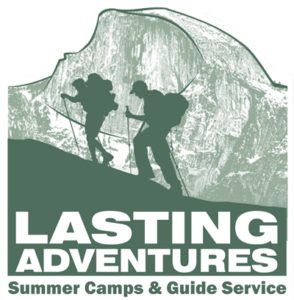
2012-2023 Traveler’s Choice on Trip Advisor – Over 1,200 5 Star Client Reviews!
Add Your Heading Text Here
Olympic national park, sequoia-kings canyon national park, joshua tree national park, lassen volcanic national park, trips by type, backpacking trips, youth programs, guided day hikes, specialty adventures, camping programs, lodge-based programs.
Click Here To Shop Adventure Deals!
Outdoor Summer Camps
Yosemite national park, outdoor education & group trips, specialty programs, joshua tree np winter camps, national park resources.
YOSEMITE NATIONAL PARK
OLYMPIC NATIONAL PARK
LASSEN VOLCANIC NATIONAL PARK
General Resources
1-800-513-8651, [email protected], p.o. box 1078, groveland, ca 95321.
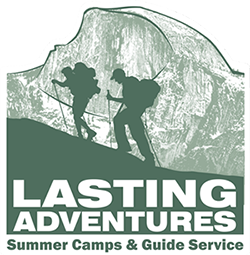
Five Most Popular Backpacking Trips in Olympic National Park
Nestled in the northwestern corner of the United States, Olympic National Park is a backpacker’s paradise. Encompassing nearly a million acres of diverse landscapes, such as lush rainforests and rugged coastlines, the park offers a plethora of backpacking opportunities. In this blog, we’ll explore the five most popular backpacking trips in Olympic that showcase the natural beauty and diversity of the park. So, grab your gear, lace up your hiking boots, and prepare for the adventure of a lifetime.
Hoh River Trail – Most Popular Backpacking Trip in Olympic for Rainforest Adventure
Nestled on the western edge of Olympic National Park, the Hoh Rainforest stands as one of the most waterlogged corners of the United States. This 17.4-mile path guides you through ancient forests of colossal, moss-laden trees, tracing the sinuous course of the Hoh River and culminating at the foot of the majestic Mount Olympus. As you trek, you’ll immerse yourself in a mystical realm where nature’s splendor knows no bounds. Whether you’re a seasoned trekker or a novice rambler, pristine paths and idyllic campsites make this one of the most popular backpacking trips in Olympic for adventurers of all skill levels. Encounters with an array of wildlife, from regal Roosevelt elk to elusive black bears, add to the trail’s allure. For a geological spectacle, make your way to Blue Glacier and witness the profound erosion process unfold before your eyes. This captivating expedition unites you with the unspoiled elegance of the Pacific Northwest and leaves memories of nature’s grandeur.
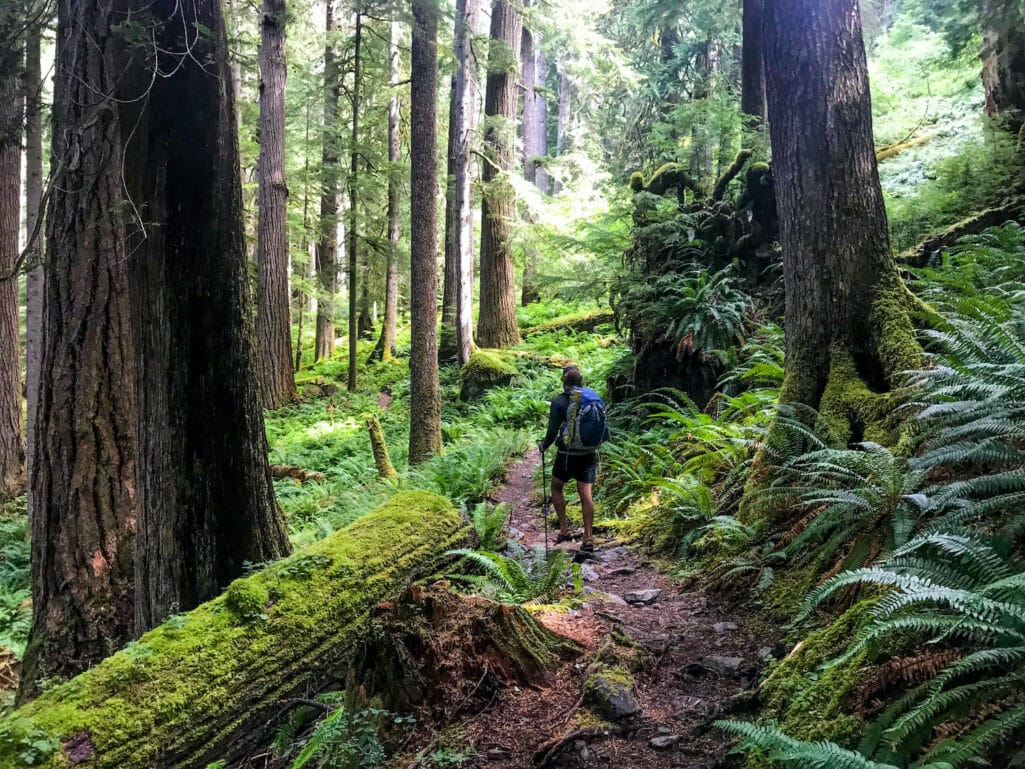
Enchanted Valley
Hiking the Enchanted Valley Trail in Olympic National Park is a true odyssey through the heart of nature’s wonderland. This trail, often deemed a backpacker’s paradise, unveils a world of breathtaking beauty and raw wilderness. As you embark on your journey, you’ll traverse dense, moss-draped forests, where colossal old-growth trees rise like sentinels and the serene Quinault River flows beside you. The awe-inspiring backdrop of towering peaks and cascading waterfalls only adds to the enchantment. The trail, spanning approximately 13.1 miles, leads you to the legendary Enchanted Valley. Along the way, encounters with diverse wildlife and a sense of tranquility are profound. This experience transports you to a realm of pure wilderness. Let the majesty of Olympic National Park unfold before your eyes. The trail culminates at the historic Enchanted Valley Chalet, offering a picturesque backdrop for your backpacking adventure.
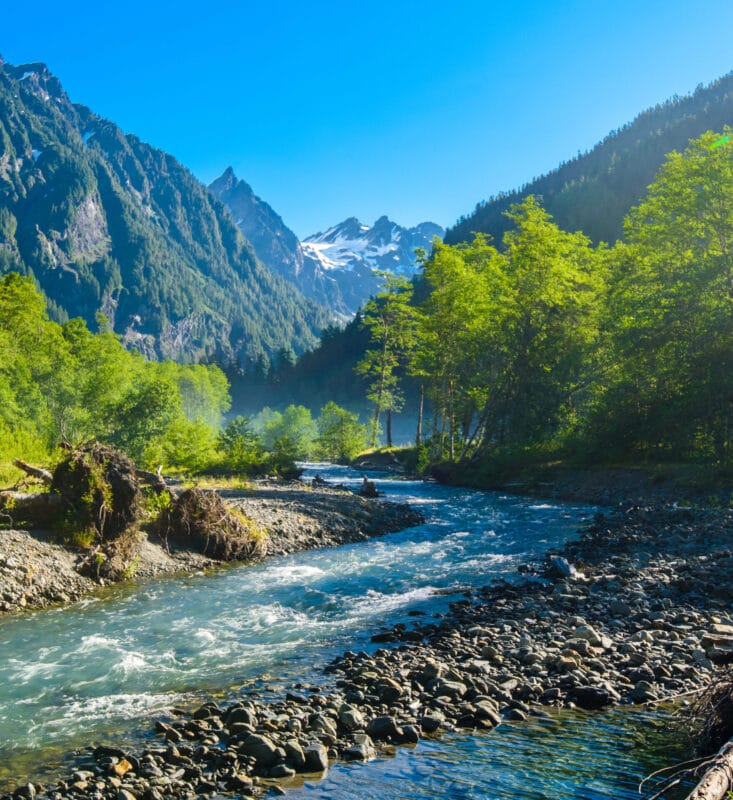
Ozette Triangle – Most Popular Beach Backpacking Trip in Olympic
The Ozette Loop is a top choice for those yearning to experience the breathtaking coastal beauty of the Pacific Northwest. This trail effortlessly combines the lush charm of ancient rainforests with the rugged drama of sea stacks and pristine shorelines. As you traverse the elevated boardwalks of Cape Alava, you’ll gain access to enchanting tide pools and glimpse the rugged coastline. This beautiful journey unfolds through diverse ecosystems, from woodlands to the grandeur of dramatic sea stacks and expansive beaches. This trail will captivate you with the allure of tidal pools, marine life, and the ever-changing Pacific Ocean moods. You may even catch a glimpse of a whale along the way!
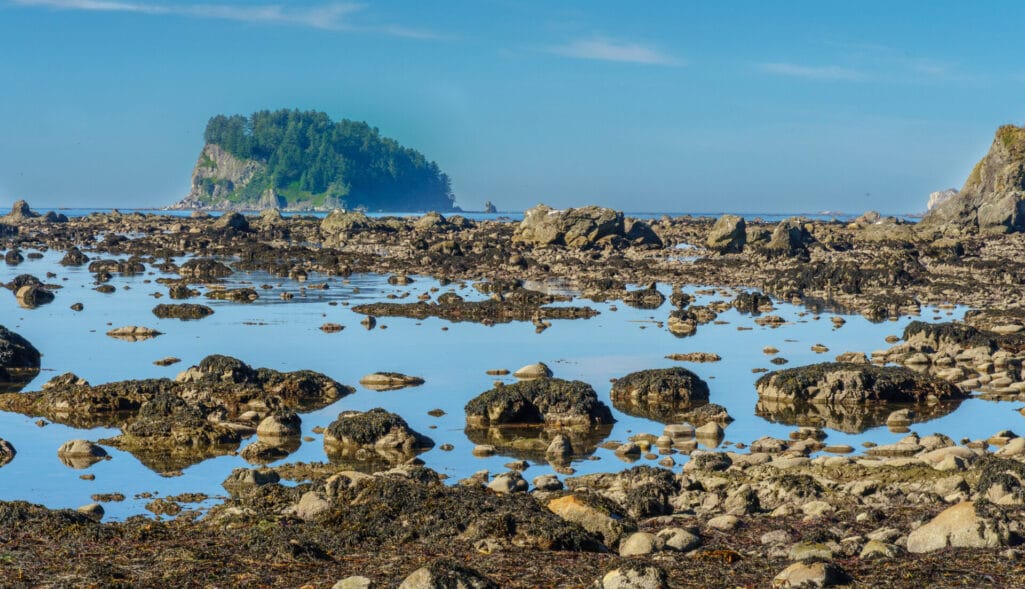
High Divide Trail – Best Backpacking Trip in Olympic for Awe-Inspiring Vistas
For those adventurous backpackers seeking awe-inspiring alpine vistas, the High Divide Trail presents an extraordinary 18.2-mile loop that kicks off at the Sol Duc trailhead. Enveloping you in subalpine meadows and verdant forests, the true highlight of this expedition is the High Divide Ridge. You’ll be treated to sweeping panoramic views of the surrounding mountains from this elevated vantage point. Mount Olympus almost always steals the show, though. This trek is a definite must for those who crave the exhilaration of standing atop the world and immersing themselves in grandeur.
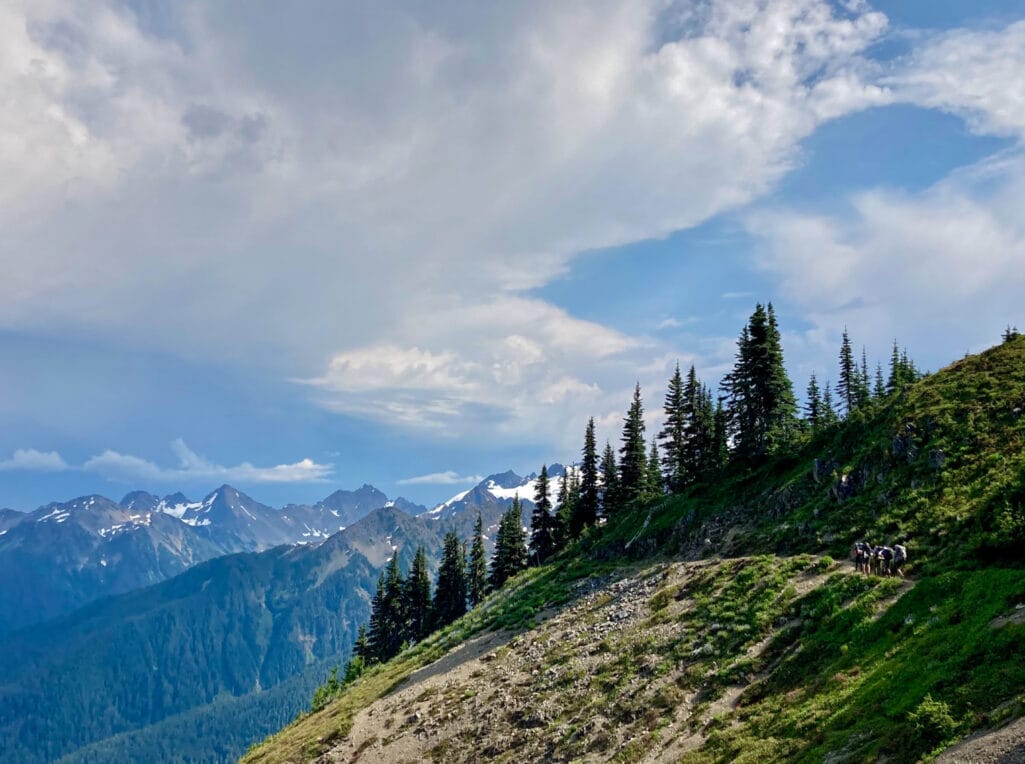
Shi Shi Beach and Point of Arches
Tucked away in the tranquil northwest corner of Olympic National Park, Shi Shi Beach and Point of Arches offer coastal backpackers a uniquely captivating experience. The 8-mile round-trip trail unveils a pristine shoreline adorned with rugged sea stacks and captivating tide pools. As you traverse this coastal haven, the enchanting Point of Arches comes into view. Point of arches exudes an almost magical allure and is a haven for photography enthusiasts. Backpackers can explore intricate sea caves and arches here, crafting a distinctive and breathtaking landscape. What makes this one of the most popular backpacking trips in Olympic is the extraordinary opportunity to camp directly on the beach, where the gentle lullaby of crashing waves serenades your slumber. Wake to sunrise-painted skies hued with unparalleled beauty over the vast expanse of the Pacific Ocean.

Olympic National Park: A Backpacker’s Paradise
Olympic National Park is a backpacker’s paradise, offering diverse landscapes and many experiences. Whether you’re drawn to the lush rainforests, rugged coastlines, or alpine splendors, you’ll find unforgettable adventures awaiting you. So, pack your backpack, lace up your shoes, and embark on a journey to discover the natural wonders of Olympic National Park. Your next great adventure is just around the corner.
Subscribe to Our Mailing List:
P.o. box 1078 groveland, ca 95321, guide service.
SEQUOIA-KINGS CANYON NATIONAL PARK
SPECIALTY ADVENTURES
Youth Trips
SCHOOLS & GROUPS
ABOUT OUR PROGRAMS
©2024 Lasting Adventures | All Rights Reserved | Privacy Policy | Terms & Conditions | Cookie Policy
Adventure Deals
Trips by destination, sequoia-kings canyon, lassen volcanic, sequoia national park, joshua tree winter camps, lassen national park, trip finder.
- Skip to global NPS navigation
- Skip to this park navigation
- Skip to the main content
- Skip to this park information section
- Skip to the footer section

Exiting nps.gov
Alerts in effect, planning your wilderness backpacking trip.
Last updated: April 5, 2024
Park footer
Contact info, mailing address:.
600 E. Park Avenue Port Angeles, WA 98362
360 565-3130
Stay Connected
The Wild Compiled
City Girl turned 4-Season Backpacker b ased out of the Pacific Northwest
How to Plan the Perfect Backpacking Trip through the Hoh Rainforest in Olympic National Park

If you're planning on visiting Olympic National Park, you can't miss the Hoh Rainforest. The Hoh Rainforest is part of the longest continuous network of temperate rainforests that spans the coast of the Pacific Northwest. It is hailed unofficially as one of the quietest places on Earth and is quite possibly one of the greenest places I've ever been as well.
On this backpacking trip, you'll be able to hike for miles through lushy, mossy forests laden with ferns. The last 7 miles of this out-and-back route takes you up and out of the rainforest, where you receive some of the most breathtaking views of Mount Olympus and the surrounding Olympic mountain range. This backpacking trail also features an iconic rope ladder down a steep chute that will certainly make the trip memorable. I had done this trip in 3.5 days, but a proficient backpacker can complete the trail in a single weekend.
Where to Camp on the Hoh Rainforest Trail
How to obtain backpacking permits for the hoh rainforest trail, food storage on the hoh rainforest trail, will i be able to find water in the hoh rainforest, were there bugs along the hoh rainforest trail, trail report, day 0 - hoh river visitor center to mt tom creek campground, day 1 - mt tom creek campground to lewis meadow, day 2 - day trip to glacier meadows, day 3 - lewis meadow to hoh river visitor center, closing remarks.
Here are a some key features about this route:
Length: 34.1mi
Elevation Gain: 5600ft
Route Type: Out-and-back
Direct Link to Trailhead

While you can also find this trail on AllTrails , I wanted to share a specially drawn, downloadable version of the route with some key markers and waypoints.
On the image of the route above, you'll find 3 markers in red . The first 2 markers indicate the location of 2 major seasonal creek crossings, and the 3rd marker indicates the location of the iconic rope ladder.
When I backpacked this route, the seasonal creek crossings had high flow, so I made sure to explore and track my path through on the primitive trail that circumnavigates the creek crossings in green .
The tent symbol in orange indicates where we had set up camp at the Lewis Meadow backcountry campsite.
I highly recommend downloading this map for offline navigation, especially if you plan on taking the primitive trail.

The first 12 miles of the trail follow the Hoh River. It's essentially a flat stroll through the rainforest.
The final 5 miles of the trail, shortly past Lewis Meadows, is a steep ascent up a mountain ridge. As you approach the rope ladder (labeled "The Ladder of Death" on my downloadable Caltopo map), the route gets pretty narrow and the footing gets loose.
Trekking poles are highly recommended on this trail.

There are so many great options to camp along the Hoh Rainforest Trail. We decided to camp at Mt Tom Creek on Day 0 of our backpacking trip and set up base camp at Lewis Meadow for Days 1 and 2.
All the campsites are situated with easy access to water.
I've heard from other hikers that Elk Lake can be full of mosquitos in the summer and recommend avoiding it if possible as it is the only still-water campground.

Olympic National Park backcountry permits are reservable through the Recreation.gov website (keyword: Olympic National Park Wilderness Permit). Once you get to this page, you'll want to click "Check Availability" on the top right of the screen.
Select Hoh as the starting area and input information about your group size and starting date.
A Note on Day 0 Camping --
I personally prefer to be close to the trailhead the evening before the start of a big backpacking trip. On this particular trip, I ended up backpacking into the first backcountry campground at Mt Tom Creek; however there is also the option to camp near the trailhead at the Hoh Rainforest Campground (reserved on a separate website).
As of 2023, these campground reservations are released on a rolling basis:
33x A loop campsites will be available for reservation 6 months in advance.
25x C loop campsites will be available for reservations 2 weeks in advance.
8x B loop campsites will be available for reservations 4 days in advance.

All campgrounds along the Hoh Rainforest trail are equipped with bear wires as black bears and other smaller hungry critters are known to frequent Olympic National Park.
Bear wires are a great campground amenity as they offer a low-cost, lightweight solution to food storage. All you need to do is put your food, stove, and scented items into a bag, clip it onto the bear wire using the provided carabiner, hoist the bag up, then clip the other end of the bear wire onto a metal ring you can find on a nearby tree.
If you're uncomfortable using a bear wire, bear cans will suffice.

Yes! Water is plentiful. Beyond the 2 major creek crossings marked on the map, there are numerous small ankle-deep creeks all along the trail, especially between the trailhead and Lewis Meadow.
On the steep section between Lewis Meadow and Glacier Meadows, there were fewer accessible spots to filter water. Elk Lake is a good spot to fill up; however, the water there is still and may have some swampy flavor to it. Halfway between Elk Lake and Glacier Meadows, there's another creek crossing that you can rock-hop across; this is a much better place to fill up. Bring plenty of water with you on this section as it is strenuous and unshielded from the sun sometimes.
Surprisingly, we made it out of the Hoh Rainforest without a single bug bite!
We made sure to cover ourselves with a Deet-based bug spray on Days 0-2 of the backpacking trip, but on Day 3, we opted not to re-apply. We saw a few swarms of midges at head-level throughout the hike and even more midges at the bog around Elk Lake, but not a single mosquito.
This trail was hiked on 05/26/23 - 05/29/23.
Day 0 of the backpacking trip included the drive from Seattle to the Hoh Rainforest and a short 2.9mi hike out to Mt Tom Creek.
As someone who identifies with being a night owl more than being an early bird, I prefer to do long drives to my destination the evening before a trip and camp nearby rather than wake up at an ungodly time in the morning the next day. We started off our long weekend by leaving work early and driving straight to the Hoh Rainforest.
Without traffic, the drive to the Hoh Rainforest from Seattle takes around 3-3.5hours. However, with the traffic we bumped into after work, it took us closer to 5 hours to reach our destination. The Hoh Rainforest reports that during peak times on the weekends, a line at the entrance may form, causing delays of a few hours, but when we arrived around 7pm on Friday night, there was no line and no one managing the booth.

The trailhead starts at the Visitor Center. If you have extra time before or after your trip, you can also enjoy a side quest on the Hall of Mosses trail.
Immediately, I entered a mystical wonderland of ancient trees and ferns, with moss draping the landscape like silk curtains.
The hike to Mt Tom Creek was entirely flat. At around the 1-1.5 mile mark, we encountered a branch-off that looked like a deprecated campground. This is not Mt Tom Creek; be sure to keep on hiking until you see an obvious trail sign.
As we were approaching Mt Tom Creek, a day hiker coming from the opposite direction had told us that he had encountered a heard of elk up ahead on the trail, but we unfortunately did not get to see the elk.
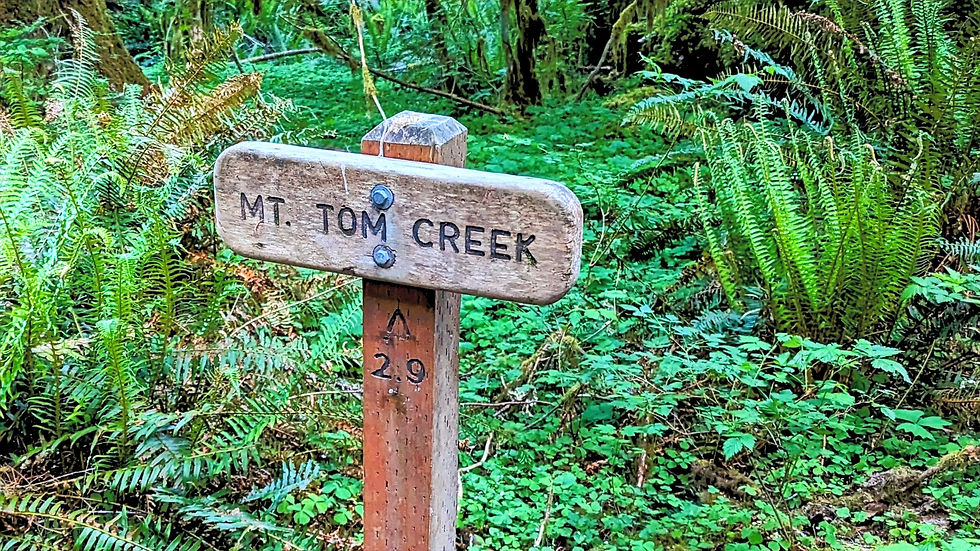
The Mt Tom Creek campground has its bear wire right by the group site. Most of the campsites were right along the Hoh River. The campsites were not demarked by site numbers, but were instead marked with fire pits. On a busy weekend, you may need to squeeze in with other groups.

On Day 1, we ventured from Mt Tom Creek campground to Lewis Meadow campground, which was another 7.6miles in. We had a slow start to our morning as we didn't have too much ground to cover and enjoyed a lazy stroll through the forest.

At roughly the 7.4 mile mark, after Happy Four but before Olympic Guard Station, we encountered 2 major creek crossings. Later in the season, we've heard that the waterflow of this creek can be as low as ankle deep, but at the time of writing, the creek was knee-deep for me (5'4" for reference).
There is an alternative trail that avoids BOTH creek crossings you can take if you feel the water levels are unsafe or if you want to keep your shoes dry. A downloadable version of this alternative route can be found on my Caltopo map .
Many taller, sturdier hikers than me had made it across the creek crossing with no issue, but I lost my footing on this creek crossing. Always be sure to use trekking poles and unclip your backpack straps when attempting risky, high-flow creek crossings. Luckily, my partner grabbed me in time, and we made it safely to shore with no casualties except for a few wet sleeping bags.
The second creek crossing is .25-.5miles after the first one, and we found the stream to be a little slower flowing than the first, but just as deep.

There was a 3rd creek crossing, shortly after the junction to Seven Lakes Basin. This one was no-where as deep as the first two creek crossings, but it would get your feet wet for sure. This was was roughly shin deep.
If you're sick of creek crossings by the time you get to Creek Crossing 3, there's a nice wide log that you can take to get across if you're an experienced hiker with sure footing.

We made it to camp pretty early in the day. Depending on your preferences, Lewis Meadow offers multiple campsites in the meadow, where deer often frequent; along the Hoh River, where we stayed; and on the gravel bar across a small section of the Hoh River for the adventurous.
Our early arrival at camp gave us plenty of time to dry out our gear before night fall.
On Day 2, we left most of our backpacking equipment at camp and set off on a day trip to Glacier Meadows.
The first 1.5-2miles of the trail past Lewis Meadow were relatively flat, similar to what we had experienced the previous day. Once we hit our first switchback, the trail only ascended from there on out.

The first major landmark we hit was the Hoh River Bridge. It was a relatively mundane wooden bridge, but it crossed the Hoh River from hundreds of feet in the air. As you cross the bridge, you can see the strength and beauty of the Hoh River flowing down below you.

The next major landmark we hit was Elk Lake. The trail does not bring you straight to the lake, but you can follow a small primitive trail from the emergency shelter down to the lake. From Elk Lake, I was overwhelmed with a sense of smallness as I viewed the surrounding forest and snow-peaked mountains looming around me. Unfortunately, the area around the lake was very boggy and did not make for a good spot to sit and relax. We did a couple of stretches around Elk Lake, then returned to the emergency shelter for a snack break.

There is a 4th creek crossing not too long after we left Elk Lake. This one is along loose gravel. Be sure to follow cairns along the creek as they will guide you to the best location to rock-hop across.
The trail then took us back into the forest. As we continued to gain elevation, we started to see some of the best views of Mount Olympus and the Olympic Mountain Range poking out from behind the trees. This is where you'll find the best views of Mount Olympus, so be sure to soak it in.
Shortly after the first glimpses of the mountains, the trail had a couple of sections that are not recommended for beginner hikers. These featured loose gravel on narrow sections, not quite wide enough for both your feet to stand side-by-side, and a steep drop-off downhill.

If you've made it through 16 miles of hiking, 4000ft of elevation gain, 4 creek crossings, and several narrow landslide areas, you've finally made it to your final challenge -- the iconic rope ladder. This rope ladder is at least 100ft tall and situated at roughly a 50 degree angle. Light gloves are recommended to help prevent rope burn. A neck gaiter or buff is also recommended as loose gravel slides can kick dust up into your face. We went took our time to descend the ladder one at a time, and boy was my heart racing the whole time!
At the bottom of the ladder, we encountered the first bit of snow, which disappeared as we climbed back into the forest. The next trek through the forest was a short one before we made it to Glacier Meadows. The entire campground was covered with quickly melting snow at the time of writing. The snow near Glacier Meadow was crunchy, with a few spots where you might poke through. In another week or two, I would expect it to be fully melted out.

We did not make it to the Blue Glacier overlook as the snow levels made the creek crossing inopportune, but we did venture out into the backcountry to find a clearing with an epic view of the Olympic mountain range.
We saw a couple of excited ski mountaineers making their return to Glacier Meadow after a successful journey up to Mount Olympus -- one for the bucket list!
We ventured back to Lewis Meadow for our final night of the trip.

We had a relaxing final day in camp, being one of the last ones to leave. The return trip to the visitor center was relatively uneventful compared to the previous days. We decided to explore the primitive trail rather than getting our feet wet again at the first two creek crossings.
This was such an incredible route to kickoff my first backpacking trip of the summer season. I had been eyeing this route on my paper copy of the NatGeo map for over a year now, and it ended up being much more adventurous than I could have imagined. The hike all the way to Glacier Meadow is not for the faint of heart: 17 miles of distance to cover, 4000ft of elevation gain, 4 major creek crossings, several narrow landslide areas, and the scariest rope ladder that I have ever climbed down. This is one of a few backpacking trips where I can firmly say that the journey was just as memorable as the final viewpoint. Highly recommend!
A Weekend Backpacking Trip at Mazama Ridge in Mount Rainier National Park (Winter)

The Wild Compiled 2022 Season Recap

Backpacking through The Narrows (Top-Down) in Zion National Park

I'm Sarah, and I'm a backpacker based out of Washington State.
I started this blog in 2022 to share the best hiker-oriented destinations for others to enjoy one weekend at a time.
Join the Adventure
Thanks for being a loyal subscriber!

A Hiker's Guide to the Perfect Weekend in Death Valley

Seattle's Hidden Gem Hike: Mailbox Peak
Let's be friends! Sign up receive our monthly newsletter with updates and new in-depth guides.

How To Plan a Perfect Olympic National Park Itinerary
Want to plan an incredible Olympic National Park itinerary? You’re in the right place! We’re Matt and Alysha, and we live in Portland, Oregon, where we have relatively easy access to Olympic National Park. We’ve been to the park multiple times for 5+ days each over the past several years, and we’re here to help you plan an amazing trip to the Olympic Peninsula.
Olympic National Park is one of three incredible national parks in Washington State , and is by far the most diverse and interesting of the three. The park boasts rocky alpine zones, perpetually moist rainforests, rugged coastal beaches, and more.
There are only a few places in the world where you can spend the first half of your day in an alpine paradise, surrounded by rocky peaks and sweeping views, and end your day on a beach, with your feet in the Pacific Ocean.
Olympic National Park is one of them.
That biodiversity is what makes Olympic National Park special, and is why it deserves a visit, whether it’s as a weekend getaway from Seattle or as part of a broader Washington road trip .
Having grown up in Seattle, it might surprise you to learn that the first time I, Matt, visited Olympic National Park was in 2020, in my 30’s.
Olympic is a gigantic park – the 13th biggest national park in the US – that deserves multiple trips to truly take in all that it has to offer.
Because of its size, you’ll want to be strategic about how you organize your trip to avoid multiple 2+ hour drives to get between areas.
Which is exactly why we’ve written this guide – to help you plan an amazing trip.
In this guide, you’ll discover everything you need to know to plan the perfect Olympic National Park Itinerary – the best things to do, where to stay, how to organize your time – to help you plan an unforgettable adventure.
We’ve written this guide for 3 days, but we have plenty of suggestions on how to modify it if you have more or less time.
Planning a trip to Olympic National Park? Don’t miss our in-depth guide to the best things to do in Olympic National Park , the best hikes in Olympic National Park , and our guide to choosing where to stay in Olympic National Park .
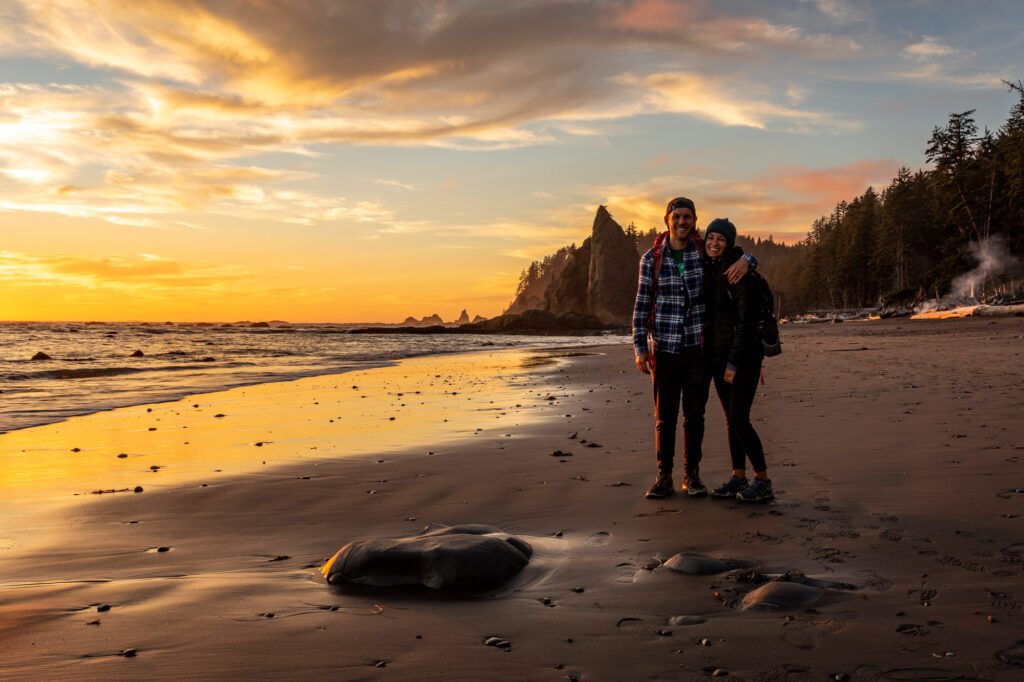
Disclaimer: Some of the links in this post, like hotel links, are affiliate links, meaning at no additional cost to you, we make a little bit of money if you click through and book. That being said, we would never recommend something to you that we don’t stand behind 100%.
How Many Days Do You Need in Olympic National Park?
First of all, we want to stress that Olympic National Park is massive. For that reason, we’d recommend no less than two nights in the park.
3 days in Olympic National Park is even better, because it will give you some time to explore the northwest corner of the park – namely Ozette Lake, Cape Flattery, and Shi-Shi Beach.
Here’s an idea of what you can cover in 2 or 3 days in Olympic National Park.
- With 2 Days in Olympic National Park : Spend one day on the Hurricane Ridge / Lake Crescent area, and one day on the Pacific Coast and the Hoh Rainforest.
- With 3 Days in Olympic National Park : Add the northwest corner of the park (Shi-Shi and Cape Flattery) in between the coast and Lake Crescent, and add more Pacific beaches to the itinerary.
Here are some other things to add, and approximately how much time to add.
- If you want to add on the Kalaloch beaches and Lake Quinault , add a half day. You can do this as your last day, and make this itinerary a loop by returning to the I-5 corridor along the southern border of the park through Aberdeen (where Nirvana is from!).
- If you want to camp overnight on the beach , add one extra day.
- If you want to do a longer, full day hike , add one half day for each one.
- If you want to do one of the many amazing overnight backpacking trips in the park , add 2-3 days.
The main guide below is written to help you explore the best of Olympic National Park in 3 days. Below the main itinerary, we have ideas on how to spend more and less time in the park.
Can You Do a Day Trip to Olympic National Park from Seattle?
We don’t think a day trip makes sense here. Even if you JUST focus on Hurricane Ridge, the closest area to Seattle, it’s still a three hour drive AT A MINIMUM that includes a ferry crossing. That’s three hours, one way.
If you just do that, you’ll be missing out on the biological diversity that really makes the park a special place. If you want to get all the way out to the coast, it’s closer to four hours one way.
If you’re looking for a day trip, check out our guide to the best day trips from Seattle , which has a bunch of great options (including some good alternatives to Olympic National Park).
Do You Need a Car to Explore Olympic National Park?
You’ll need to make sure you have a car . If you’re coming from nearby – somewhere in Oregon or Washington – drive yourself. If not, rent a car when you arrive in Seattle.
There’s really no way to explore the Olympic Peninsula without one. We wouldn’t recommend options like the bus. The park is just too big, and there’s very little public transportation coverage out there.
If you’re coming from out of state, rent a car at SeaTac airport when you arrive.
Want to experience Olympic National Park in a campervan?
We own a campervan from Peace Vans in Seattle (their “modern” model, built on a Mercedes Metris) and highly recommend them.
The Metris is a smaller footprint than the big Sprinter and Dodge Ram Promaster, which is why we like it. There’s still plenty of space, and the pop-top makes it even more spacious.
You can rent a van from Peace Vans on Outdoorsy , which would be a great way to experience Olympic National Park (trust us, we’ve done it!).
They have an office in Seattle, and from there it’s an easy drive out to Olympic National Park (or you can hop on the Bainbridge Ferry).
Getting to Olympic National Park from Elsewhere
If you’re planning to come from somewhere farther out, like another state, then flying into SeaTac International Airport is your best choice . This is the main airport serving the Seattle area, and it’s roughly 20 minutes south of the city center (without traffic)
From SeaTac Airport, it’s going to take you two and a half or three hours to drive to your first stop .
Where to Stay in Olympic National Park
It bears repeating here: this park is massive. For example, it takes a full two hours to get from Port Angeles to the Hoh Rainforest.
Which means that using one home base to explore the whole park isn’t really all that practical, because it would require a couple of 2+ hour drives.
Usually, we’re 100% on board with picking one base and exploring from there, but doing that would add a ton of extra driving.
For that reason, we would highly recommend using multiple home bases for your itinerary.
With three full days in the park, we’d spend your first night near Port Angeles , which is the gateway to Hurricane Ridge, Lake Crescent, and the Sol Duc Valley, and your next two nights near Forks , where you’ll be closer to the Hoh Rainforest and Pacific Beaches.
Note : if you want to camp, make sure to read the section on camping below!
Here are some places to stay in each of those locations.
We have an entire guide on where to stay in Olympic National Park with more detail on this, if you’re interested in getting deeper on each area.
Staying Near Port Angeles
If you’re not camping, you have a couple of routes you could go here.
If you want to stay in Port Angeles itself, which is the biggest city near the park, and the town on the northeastern side with the most amenities (like grocery stores and gas station), stay at the Olympic Lodge . It’s clean, comfortable, and it’s the best hotel in town.
On our last trip, we camped in the back of the Emerald Valley Inn , a motel just outside of town, which was a lovely home base for exploring the eastern end of the park.
If you want a more rustic experience , stay in a vacation rental outside of town towards Lake Crescent. The best location would probably be a cabin around Lake Sutherland , which is conveniently located between Hurricane Ridge and Lake Crescent
Check out this one bedroom lakefront cabin , or this spacious three bedroom home ).
In the area around Lake Sutherland, which puts you between Port Angeles and its amenities and Lake Crescent and the wilderness, there are also come good options. It’s hard to say no to this cozy cabin on the Strait of Juan de Fuca , or this beautiful custom studio .
Or, if you’re looking for a once-in-a-lifetime experience, stay at this incredible beachfront treehouse , which is on our bucket list!
Camping Options : If you’re camping, Heart O’ Hills Campground (first come, first served) is the best option, and Sol Duc Campground is the runner up (reserve in advance). We stayed at Sol Duc on our first trip to the park, and it was lovely.
Staying Near Forks
We have three solid options in and around Forks for you to choose from. Yes, that Forks. The one with the vampires.
If you want to stay in the town of Forks itself , stay at either the Forks Motel or the Pacific Inn Motel , which are literally across the street from each other in the middle of town.
If you’re looking for a more rustic experience outside of town , stay at either the Hoh Valley Cabins , which are gorgeous and are along the road that takes you out to the Hoh Rainforest, or the Misty Valley Inn , a cute B&B just north of Forks.
If you’re camping, stay at Mora Campground (reserve in advance), which might be the nicest national park campground we’ve ever stayed at. We’ve stayed twice! It’s five minutes from Rialto Beach.
Camping in Olympic National Park

There are an abundance of campsites in the park. Only five require reservations ahead of time ( Kalaloch , Fairholme , Sol Duc , Hoh Rainforest , and Mora ), while the rest are first-come, first-served.
If you’re planning on visiting during the summer months, I highly recommend making reservations several months in advance for the campsites that require reservations. They are usually booked months in advance, especially for summer weekends.
For campsites that are first-come, first-served (I’m going to start using FCFS as an acronym below), the earlier you get there, the wider selection of campsites you will have . If you show up at 4:00 pm on a Friday or Saturday in August, I wouldn’t expect to easily find a site.
The best campsite for the Hurricane Ridge area is Heart o’ Hills Campground (FCFS), though you could also camp at Fairholme Campground on Lake Crescent (reservations).
For the Hoh Rainforest and Pacific Beaches , we’ve camped at Mora and found it to be a great base for exploring the area (plus, the campground is really nice).
We’ve stayed there twice, and it’s the best campground location for exploring the entire stretch of Pacific coastline. Reserve as far in advance as you can.
If you want to be closer to the Hoh Rainforest, look at Hoh Campground . I don’t think it’s worth camping out there unless you’re planning on tackling a backpacking trip up the Hoh River.
Instead, I’d camp at Mora and make the hour-long journey to the rainforest as a morning trip on your way down the coast.
For Lake Quinault and the Quinault Rainforest , camp at either Falls Creek or Willaby Campground .
Both are technically outside the park in Olympic National Forest, and accept reservations in advance.
For more on camping in the park, including current campground status, head over to the NPS website .
Exactly How to Plan an Amazing 3 Day Olympic National Park Itinerary
And now, with all the important logistics out of the way, onwards to the main event! We’re going to give you a detailed 3 day Olympic National Park itinerary that you can essentially copy and paste to plan your own trip.
Please note that we’re assuming you have THREE FULL DAYS in the park . Which means you’re arriving the night before night 1, and leaving the morning after night 3.
If you have a little less time (e.g. you’re coming from Seattle on the first morning, or you need to head back to Seattle on the last evening), you’ll have to make some slight changes, but it’s totally doable.
If you only have one or two days in the park, we have suggestions on how to spend that amount of time below the main itinerary. Then, use the more detailed sections in the main itinerary to plan your trip!
Finally, if you have more time in the park, you’re in for a treat! We have suggestions on what to do with more time, including some longer hikes, multi-day backpacking trips, camping on the beach, and more.
Here’s a quick summary of the itinerary below:
- Day 1 : Hurricane Ridge, Lake Crescent, and Sol Duc Falls
- Day 2 : Shi-Shi Beach, Cape Flattery, and the La Push Beaches
- Day 3 : The Hoh Rainforest and Our Favorite Beaches
Here’s a map of where your trip will take you!
Day 1: Hurricane Ridge and Lake Crescent
On your first day in the park, explore the northeastern corner, which is where you’ll find gems like Hurricane Ridge (the most accessible high-elevation area), Lake Crescent, and the Sol Duc Valley.
Hurricane Ridge

Start your day out nice and early with a drive up to Hurricane Ridge, which is the highest point in the park that is accessible by car.
We say early because this section of the park gets extremely busy, especially between 10:00 am and 5:00 pm.
You could be here waiting for 30-60 minutes for a parking spot if you get here during peak time on a summer weekend.
Even from the visitor center, the views are spectacular. But the main attraction here, at least to us, is the hiking.
Plan on arriving before 9:00 am, at the latest.
That way, you’ll have no trouble finding parking, and you’ll be able to do the hike up to Hurricane Hill with just a few people around. We arrived here at 7:00 am, and were the only people on the trail up to Hurricane Hill. It was magical.
The must-do hike here is the short, paved climb up to Hurricane Hill .
From there, you’ll have incredible views of the Strait of Juan de Fuca and British Columbia to the north (you can see Vancouver’s skyline and the city of Victoria), Mount Baker to the east, and the Olympics to the south, with towering Mount Olympus.
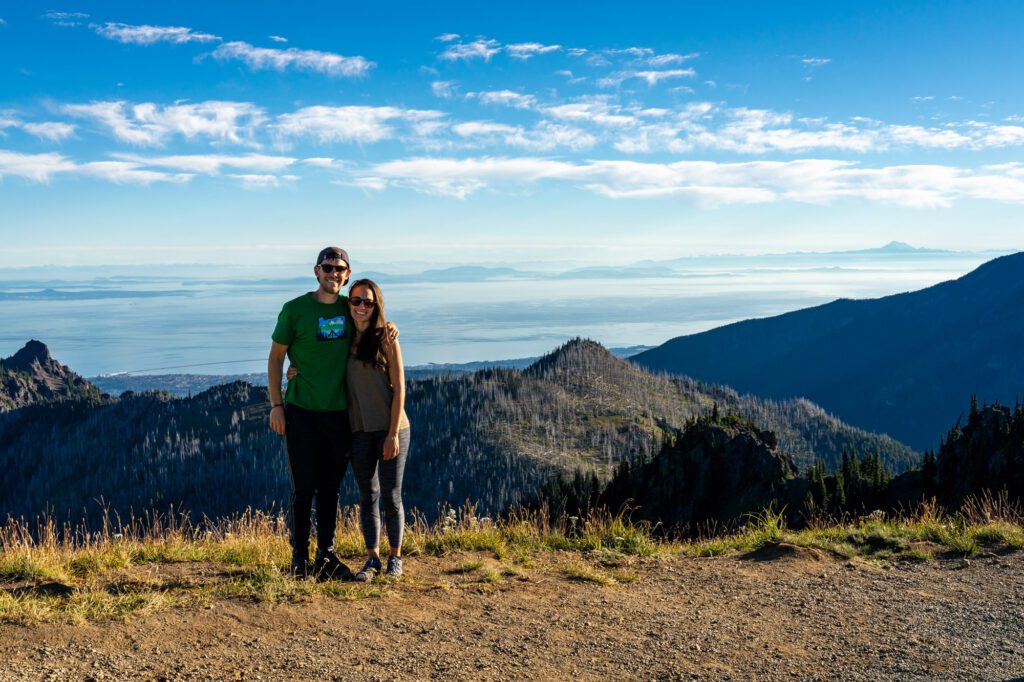
If you’re also looking for a longer hike to do, here are two good options.
Lake Angeles Trail : The hike to Lake Angeles takes you from just outside of Heart-o-Hills Campground up through the dense forest, and finally to a stunning alpine lake. It’s a tough hike, gaining almost 2,500 feet of elevation over 7.4 miles. You could also hike here from Hurricane Ridge, which is a much more scenic route where you hike along Klahanie Ridge with amazing views, but it’s a MUCH longer and harder hike (12+ miles, 4,500 feet of elevation).
Klahhane Ridge : If the views I just mentioned sound like something you’re interested in, but you’re not up for the hike all the way to Lake Angeles, do the 5 mile hike along Klahhane Ridge instead. You’ll gain 1,700 feet along the way, mostly at the beginning in a series of switchbacks through the forest, but once you get up onto the ridge you’ll have sweeping views, including views of Mt. Angeles.
Marymere Falls
Your second stop of the day will be the parking lot at Lake Crescent, which is where you’ll park to access the next two stops on this list. This is also where you’ll find the historic Storm King Ranger Station.
The first of those two stops is the relatively short and easy hike to Marymere Falls.
It’s a nice stroll through the forest, which is ferny and wet, and leads you to a 90 foot waterfall with multiple viewpoints accessible by climbing relatively steep wooden stairs.
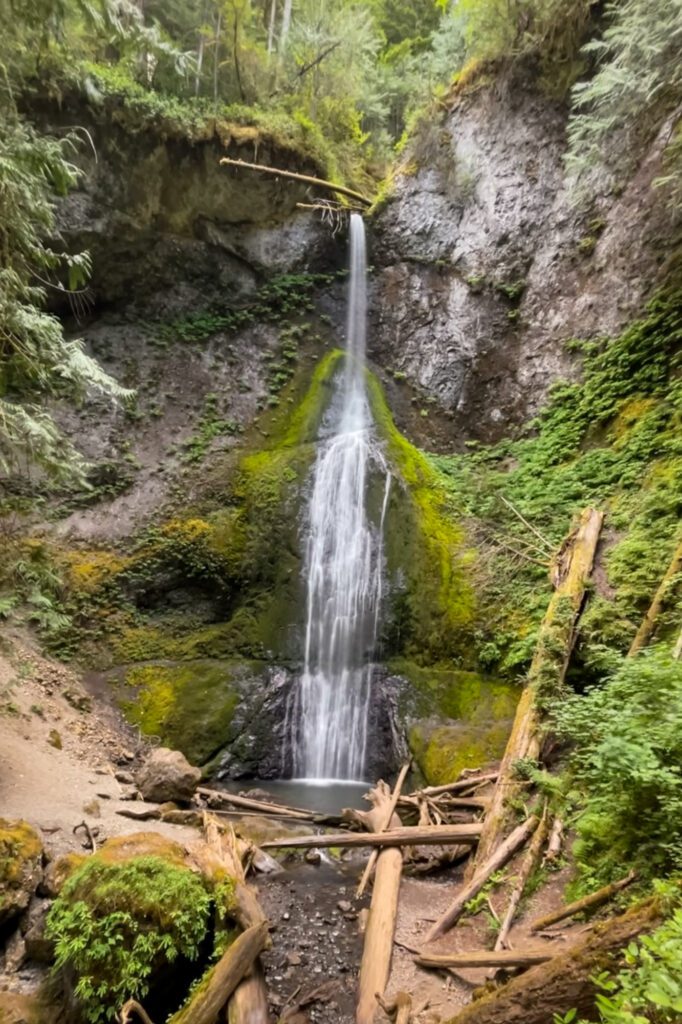
All-in, it’s a 1.8 mile hike round trip, with 500 feet of elevation gain. The end of the hike that takes you to the two viewpoints is the only piece of the hike that has any significant elevation changes.
Mount Storm King (OPTIONAL)
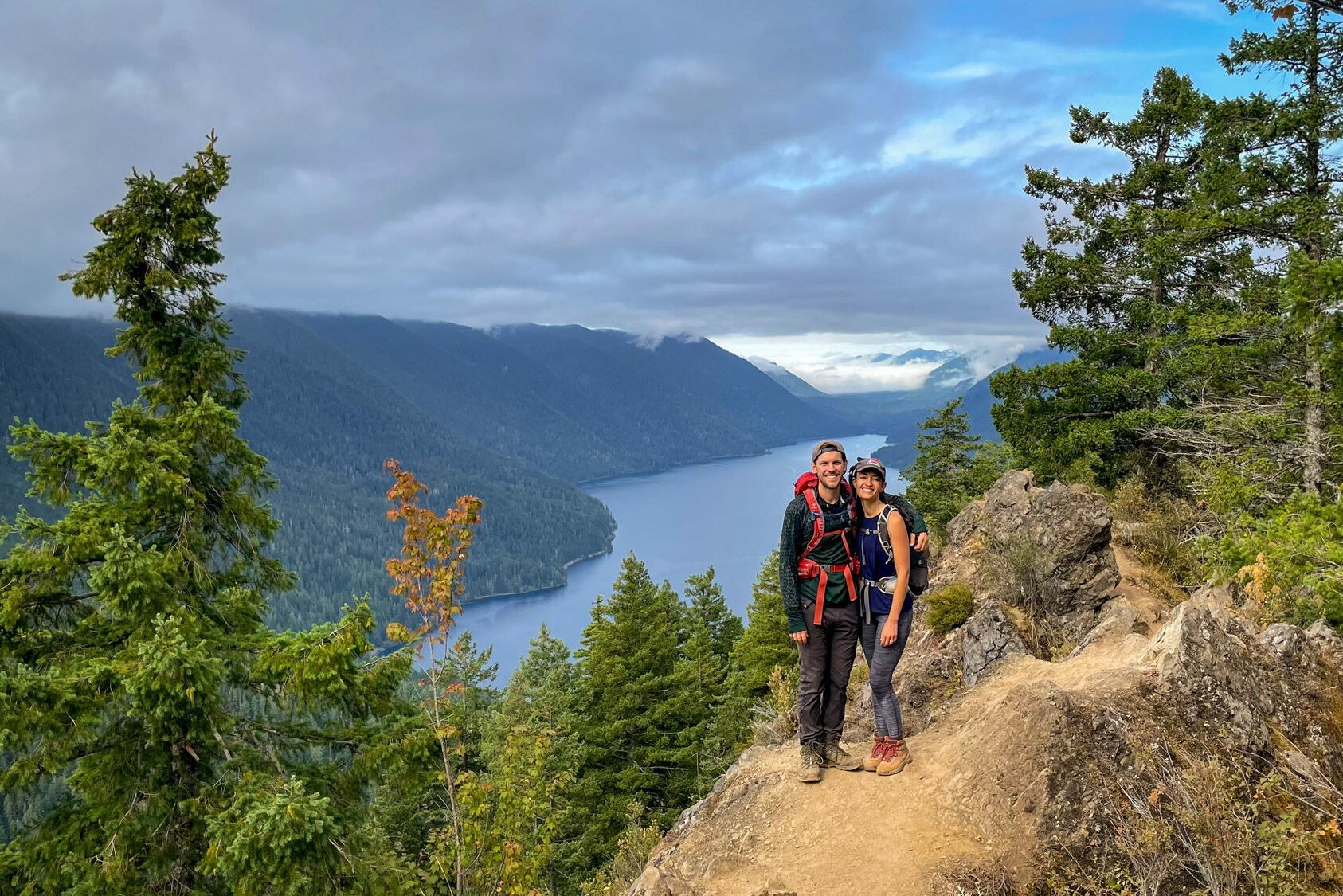
If you’re up for a longer, more difficult hike at sunset, the hike up to Mount Storm King is a good option.
We did it on our last trip out to the Olympic Peninsula, and it’s basically straight up and straight down. The reward is a nice view out over Lake Crescent from the rocky outcropping at the top.
To be honest, though, the hike itself really isn’t that cool. Or scenic. Or particularly fun.
The views at the top are nice, but the journey to get there is decidedly “meh.”
We discovered it because every PNW influencer has done an amazing photoshoot at the top, and the hike fell short of expectations if we’re being honest.
We’d opt for one of the two longer hikes near Hurricane Ridge before this one (and it’s not close).
It’s a relatively short and steep climb, and to get to the summit you’ll have to climb some cables and do some scrambling that might be a little much for people afraid of heights.
I suggest only doing this one if the weather is good because it can get pretty ugly up there when it’s not. This hike is 4 miles roundtrip with an elevation gain of 2,065 feet, and leaves from the same trailhead as Marymere Falls.
Lake Crescent Lodge
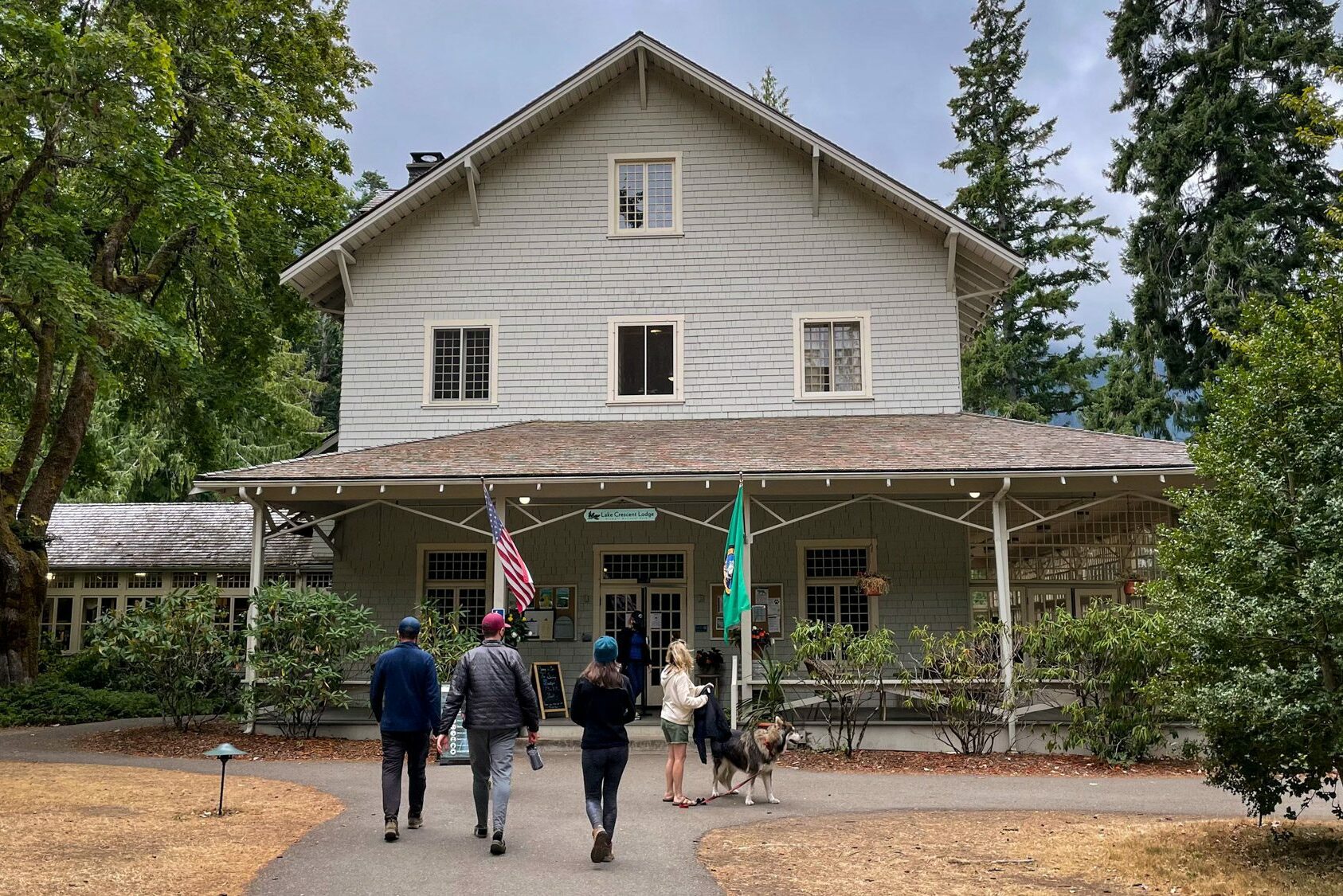
After your hike (or, hikes, depending on what you decided to do), head to the incredible Lake Crescent Lodge for an afternoon refreshment.
There’s a short hike through the woods from the parking lot where you parked, so you can walk and not have to deal with moving the car and finding a new parking spot.
The historic lodge was built way back in 1915, and is one of the oldest national park lodges in the country.
This is an excellent place to stay to explore the region, but it’s almost always fully booked (once you’re there, you’ll probably understand why).
At the Lake Crescent Lodge, which is predictably perched on the shores of Lake Crescent, you’ll find a bar and a restaurant, perfect for refueling after a busy morning.
You can take your drinks or food out to the patio, or find one of the adirondack chairs on the beach for the best views. Keep in mind that you’re going to pay a premium for the location here.
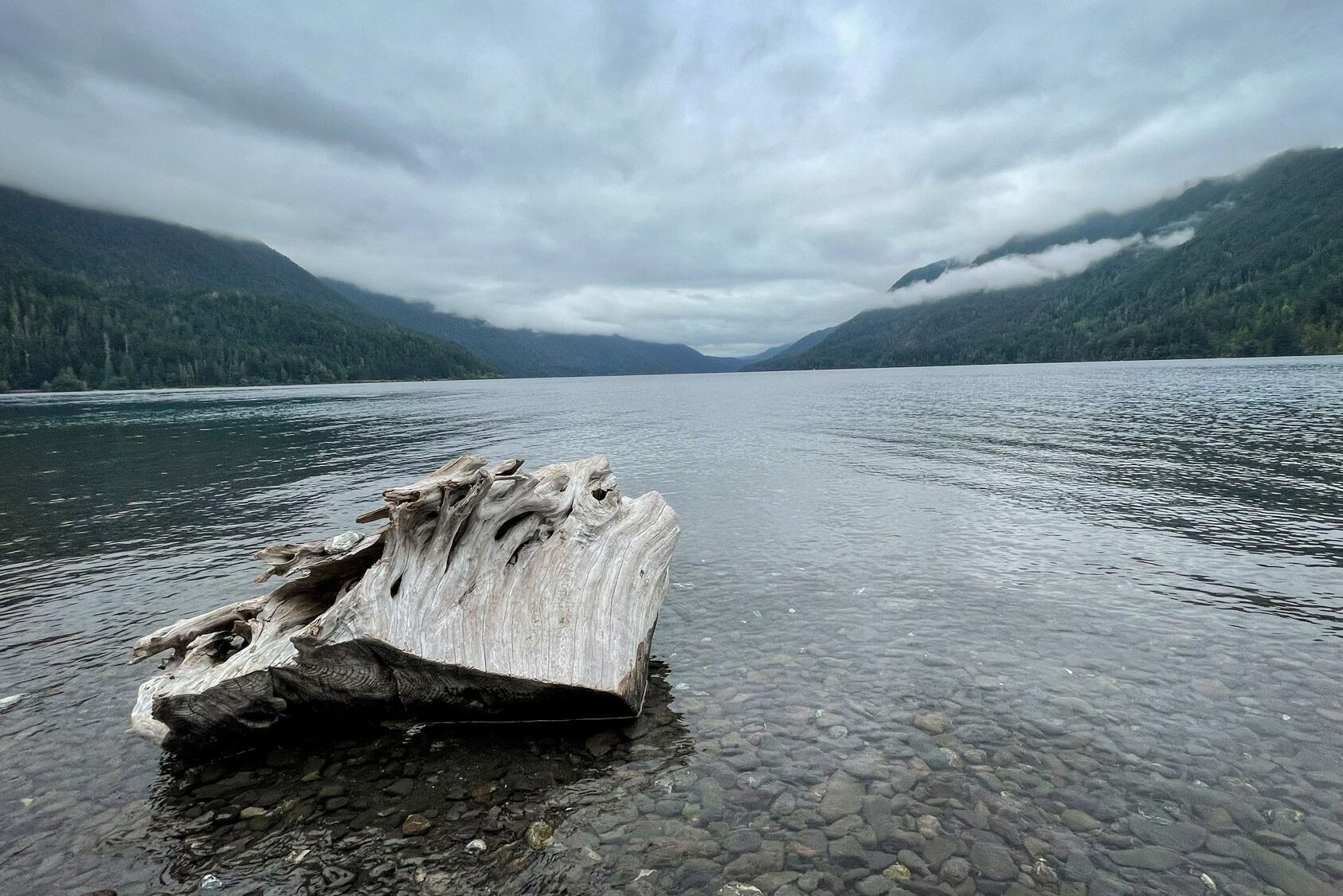
They also have boat, canoe, and paddleboard rentals, if you’re looking to get out on the water.
It’s worth lingering a bit and enjoying the lake – you’ve earned it after an action-packed morning and afternoon!
Sol Duc Falls

Sol Duc Falls is a gorgeous waterfall that we stopped by on our way up to backpack the High Divide Trail.
It’s a little bit of a detour, about a half hour up Sol Duc Road, but we think it’s worth it to see what might be the best waterfall in the park.
The hike through the forest will be 1.6 mi (2.6 km) and have an elevation gain of just 200 feet (61 m), so just about everyone can do it.
From the viewpoint on the wooden bridge, you get a nice view of the waterfall and the river flowing into it.
Where to Stay for the Night
For your first night, stay in the vicinity of Port Angeles. You’ll move to Forks for the next two nights, but staying near Port Angeles puts you in the perfect position to stop by Cape Flattery and Shi-Shi Beach tomorrow morning on your way out to the coast.
Our recommendation would be to find somewhere between Port Angeles and Lake Crescent.
There are some great vacation rentals along the northern coast right on the Strait of Juan de Fuca, some good campgrounds, and some amazing places to stay on the waterfront of Lake Sutherland (which is just east of Lake Crescent).
If you want the comfort and convenience of a hotel in Port Angeles itself, stay at the Olympic Lodge . It’s a great option (probably the best option in Port Angeles) that is close to the road, mid-way between Hurricane Ridge and Lake Crescent, and super rustic and charming.
Here are some of our favorite places to stay just outside of town.
Vacation Rentals in Port Angeles / Lake Crescent
If you’re not up for camping, vacation rentals are a great alternative here.
There are plenty of places that will put you close to the action at Hurricane Ridge and Lake Crescent, but give you the comfort of returning to a warm and cozy bed after your day of exploring.
Here are a few options we like in the area.
Captain’s Quarters Cabin on the Water (sleeps 2-5): On the Strait of Juan de Fuca, this is a secluded beachfront cabin that is miles away from the stress of life. It’s literally RIGHT ON the water. Beachfront is not an exaggeration here. If that’s not available, the hosts have two other listings that are the same idea ( Halibut Hole Cabin and Codfish Cabin ).
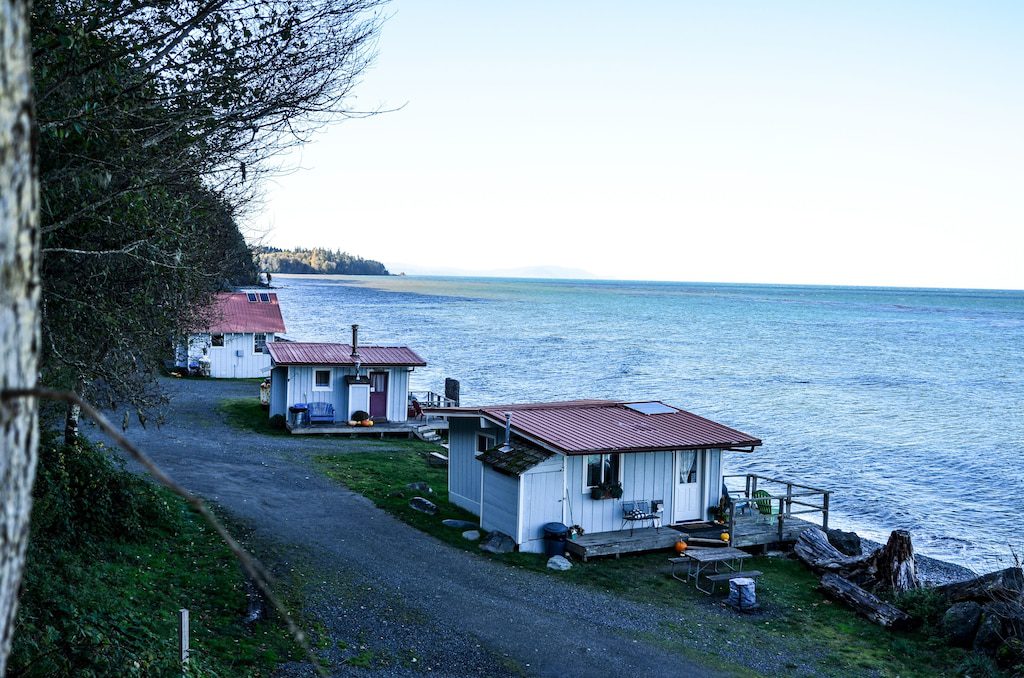
A Unique Treehouse on the Water (sleeps 2-3): This gorgeous, rustic treehouse is right on the water just east of Port Angeles, and is one of the coolest places to stay in the state of Washington. It’s cozy, but it has a fire pit overlooking the Strait of Juan de Fuca. It would make a perfect weekend getaway from Seattle .
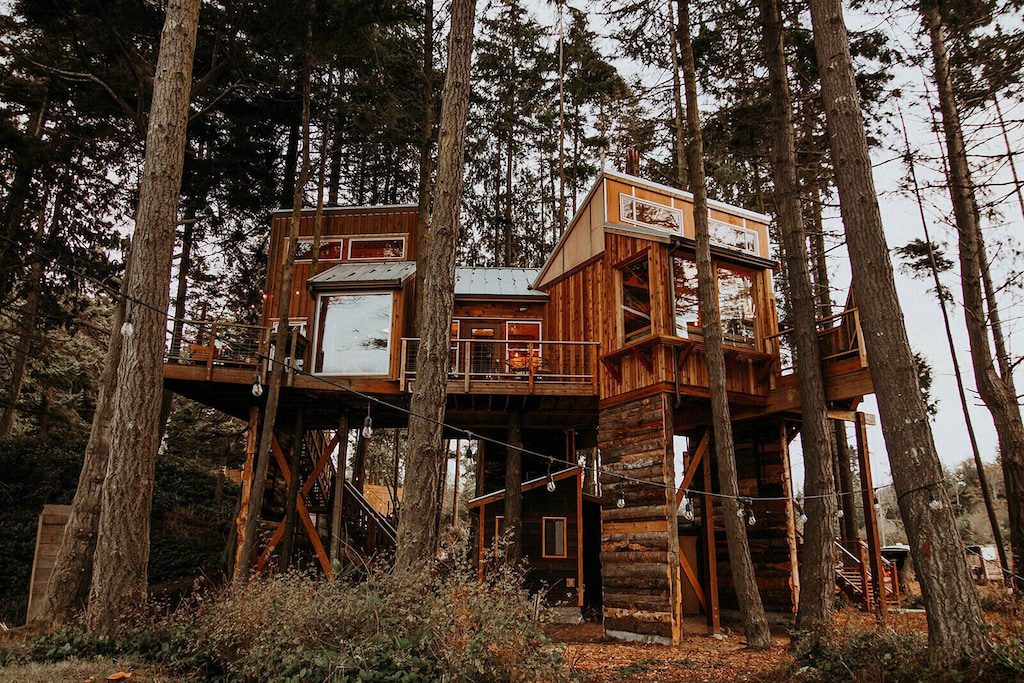
A Cabin on the Shore of Lake Sutherland
There are multiple options for this one, here are a couple that caught our eye.
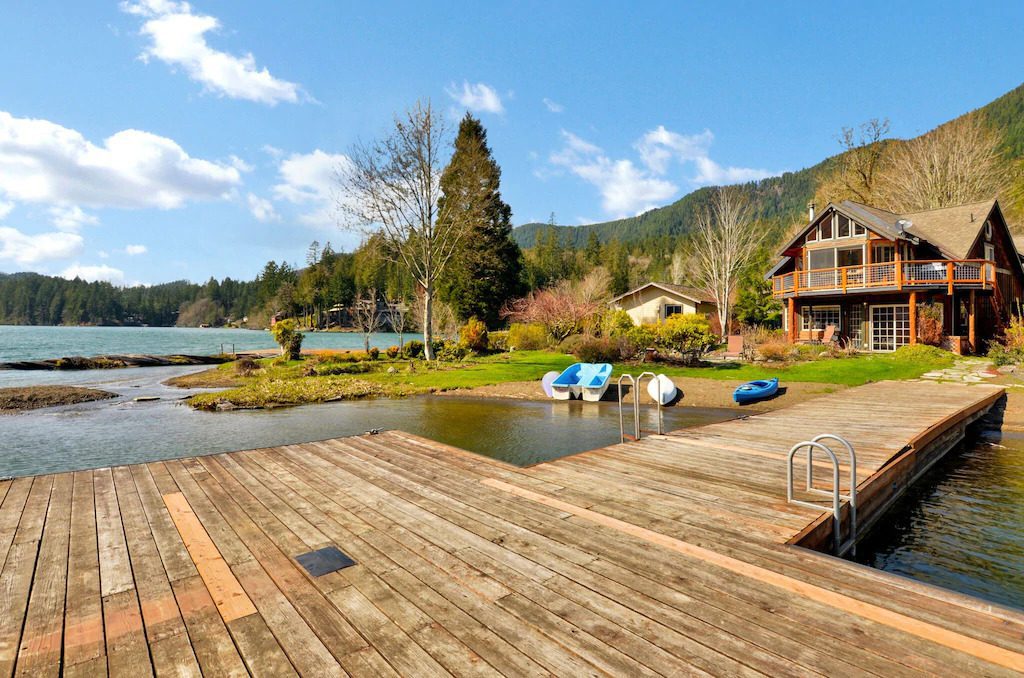
Sunny Lake Sutherland Charmer (sleeps 4-8): Right on the lake with its own dock! Two bedrooms with a variety of other sleeping options, like a murphy bed.
Lakefront Home with All the Amenities (sleeps 6-8): Amazing wraparound deck with plenty of room for groups and families looking to explore Olympic National Park.
Heart o’ Hills Campground is just 15 minutes from downtown Port Angeles, and is a first-come, first-served campground surrounded by a towering old-growth forest.
Sol Duc Campground lies along the Sol Duc River and even features hot spring pools! You can make reservations online. This is where we ended up camping, since we were tackling the High Divide Trail, whose trailhead is nearby.
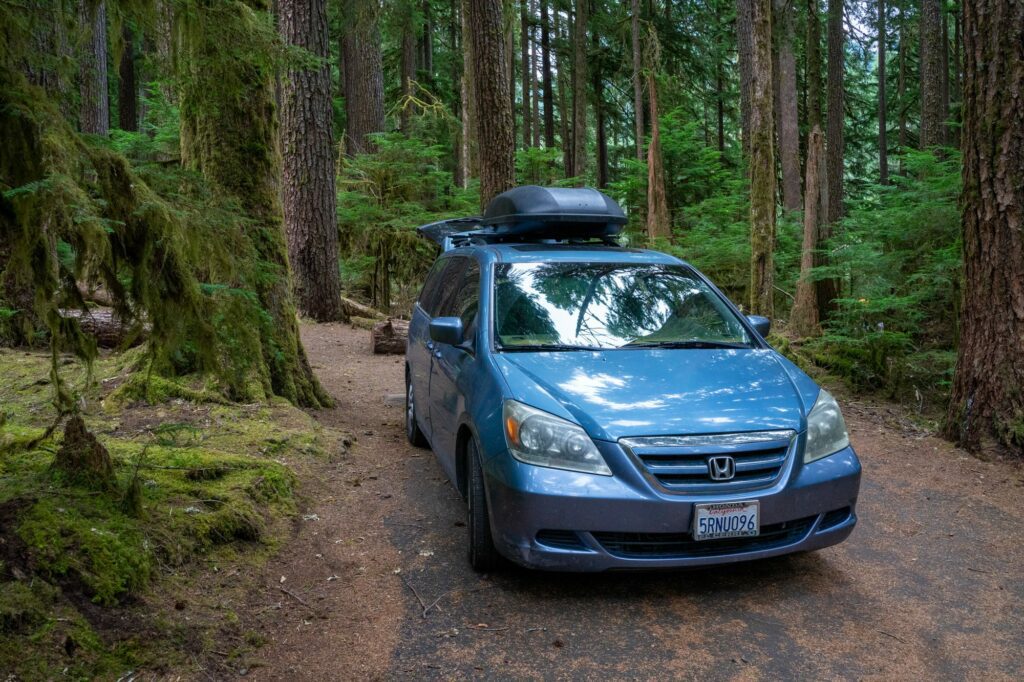
Our campsite at Sol Duc Campground was nicer than others we saw
Day 2: Shi-Shi Beach and the La Push Beaches
For your second morning, head out to the northwest corner of Washington State, where you’ll find some of the least visited parts of the park. End your day with the drive into Forks, and some short beach hikes to the beaches near La Push.
The first part of your day today will be spent on the land of the Makah tribe – you can learn about the Makah here , and it’s worth taking some time to acknowledge that you are on their land while you’re enjoying this amazing part of the world.
On the way back to the rest of the park, it’s worth stopping in Neah Bay at the Makah Cultural and Research Center to check out the museum, where you can take some time to learn more about the history of the tribe and the history and tradition of the land you’re exploring.
Important note : You need a recreation permit from the Makah tribe to park at most of the attractions in the northwest corner of the state. You can get one at a bunch of different locations in the area, and it will cost you $20. It’s good for the calendar year. Display it on your dashboard while you’re in this area.
Cape Flattery
Start your day with the drive up to Cape Flattery, which is the northwestern corner of the continental, mainland United States (technically the San Juan Islands are further north).
There’s a 1.5 mile hike (roundtrip) out to a viewpoint, where you’ll have a nice view of the place where the Strait of Juan de Fuca meets the Pacific Ocean. There’s a lighthouse just offshore.
It’s an easy hike along a boardwalk for most of the way, and you’ll find yourself in a towering forest of sitka spruce trees, which is peak coastal Pacific Northwest for us.
Because it’s a short hike, it’s going to be a busy one. But not early in the morning! That’s why we have this first on the itinerary.
Shi-Shi Beach and the Point of Arches
The seemingly long hike out to Shi-Shi beach might scare you off, but you should know that it’s a relatively easy two mile walk out to the beach itself. The longer part of the hike is the flat stroll along the beach out to the south end of the beach, which is where you’ll find Point of Arches.
Point of Arches is a collection of sea stacks – probably the best in the park – that take a little extra effort to get to, but are well worth the journey. It’s a full 8.5 miles (ish) to get out there. Make sure to bring plenty of water, snacks, and rain gear.
Point of Arches is best at low tide, when the tide pools are visible. Check tides here .
You can camp overnight on Shi-Shi beach, which is one of the coolest things to do in the park. You’ll need both a Makah permit and a park wilderness permit, along with a bear canister to store your food. More information here .
The La Push Beaches: First, Second, and Third Beaches
Give yourself the rest of the day to enjoy all of the beaches near La Push! These are going to be easy-going and mellow hikes. Actually, they’re more like strolls and long walks on the beach, which I have been known to love.
Before you Google it, yes, the names are actually First, Second, and Third Beach. Second is the best of the bunch, but they’re all worthwhile.
First Beach : The small coastal village of La Push is your entryway to First Beach. Stroll along a mile-long sandy beach that has views onto sea stack islets and large waves. There is plenty of driftwood to look through and potentially find a souvenir.
Second Beach : This beach is an unsung jewel of wild beaches. There’s two miles of a sprawling sandy beach here, as well as a lagoon, sea stack islets, tide pools, driftwood, and tons of sea life. There aren’t that many people here, which makes it a very peaceful place. It’s a short hike from the parking lot – nothing too crazy at all for families with kids.
Third Beach: Third Beach is significantly less visited because of the 2.8 mile hike (round trip) that you’ll need to do to access the beach. The trail takes you through towering trees until it reaches a creek that flows into the Pacific Ocean. The sunsets at this, and the other beaches, are postcard-perfect!
Where to Stay for Nights 2 & 3
As a reminder, we’d highly recommend staying in Forks for your second and third nights in the park. The place to stay around these parts is Forks. Yes, that Forks. You know, the one with all the vampires and surprisingly-jacked-and-tan werewolves.
It will put you in the perfect position to explore the Pacific beaches, and the ever-enchanting (and wet) Hoh Rainforest.
You’ll want to stay here for two nights since Forks will also act as your gateway to the Hoh Rain Forest.
In and around Forks, there are a couple of good options.
Hotels & Lodges in Forks
Hotels in Forks are few and far between. And honestly, there’s only a couple that I’d really consider.
If you want a more traditional hotel / motel stay , stay at either the Forks Motel or the Pacific Inn Motel , which are literally across the street from each other in the middle of town.
Further out, you have the Misty Valley Inn , a cute B&B just outside of town to the north with an excellent made-to-order breakfast, and the Hoh Valley Cabins to the south, which are along the road that leads out to the Hoh Rainforest (which is a slightly less convenient location, made up for by the solitude you’ll find in the rainforest).
Vacation Rentals in Forks
There are some pretty amazing tiny homes, cottages, and cabins in the area that would make a perfect home base for exploring the Pacific Beaches and Hoh Rainforest.
Tiny House in Forks (sleeps 2): If you want to go a little bit more rustic, then look at these two tiny houses in Forks ( Cabin 1 / Cabin 2 ). It’s a perfect choice for couples, particularly if you’re on a budget. You should know that they ARE, in fact, tiny cabins, so don’t plan on having a ton of space to spread out. There’s a nice outdoor firepit, which is the perfect place to enjoy one of those amazing warm Pacific Northwest summer evenings where the sun sets at like, 10:00 pm.
Wild West Coast Getaway (sleeps 6): The three bedrooms at this charming house promise plenty of space for groups or families looking to explore the coastal area and Hoh Rainforest. It’s pretty much right in the town of Forks, where you’ll have a few restaurants within walking distance, along with one of the only grocery stores anywhere near the park. Plus, a private hot tub!
Camping Near Forks
Mora Campground is the place I would recommend if you are looking for a camping spot. We’ve stayed there twice, and we’re pretty sure it’s one of the best national park campgrounds we’ve ever stayed at.
There are 94 campsites to choose from. It was perfect for a sunset trip to Rialto Beach because it’s roughly six minutes away.
Make sure you make an online reservation in advance (they open six months in advance, to the day).
Day 3: The Hoh Rainforest and Ruby + Rialto Beaches
Experiencing the rainforests and beaches on the west side of the park is the best thing to do in Olympic National Park, which means this third day is going to be a highlight of your trip.
The vibrant collection of mosses covering ancient old-growth trees amid an enchanting backdrop of natural beauty is something that captivated us from the moment we first stepped foot in the rainforest.
Combined with the fact that, just an hour away, you’ll find towering sea stacks rising out of the ocean waves, this is the day that you’ll realize just how crazy the geography on the Olympic Peninsula is. It’s honestly a little unbelievable.
On your last day in the park, explore the Pacific Coast, doing the lush Hoh Rainforest first thing in the morning to beat the crowds (and have some semblance of solitude), and then do the top two beaches on the coast in the afternoon.
Make sure to pack a picnic lunch (or just some snacks) to enjoy on the beach!
The Hoh Rainforest
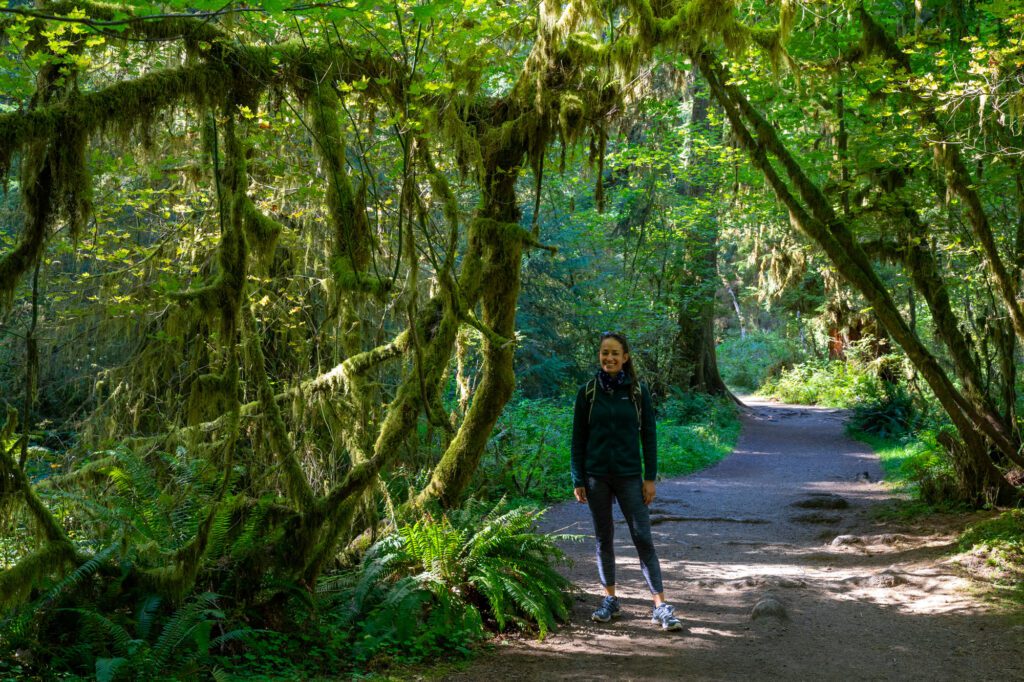
Head STRAIGHT to the magical Hoh Rainforest. I suggest you get there as early as humanly possible .
That way, you will get to experience the sublime ambiance of the rays of sunlight streaming in through the dense forest canopy. You may even get to spot some Roosevelt Elk!
The parking situation at the Hoh Rainforest is extremely limited, which means they’ve started limiting capacity at the entrance station during peak times with a one car in, one car out policy.
Between 10:00 am and 5:00 pm, there will be a line on a summer weekend. We know, because we accidentally got a late start last time and got caught in an hour wait to park.
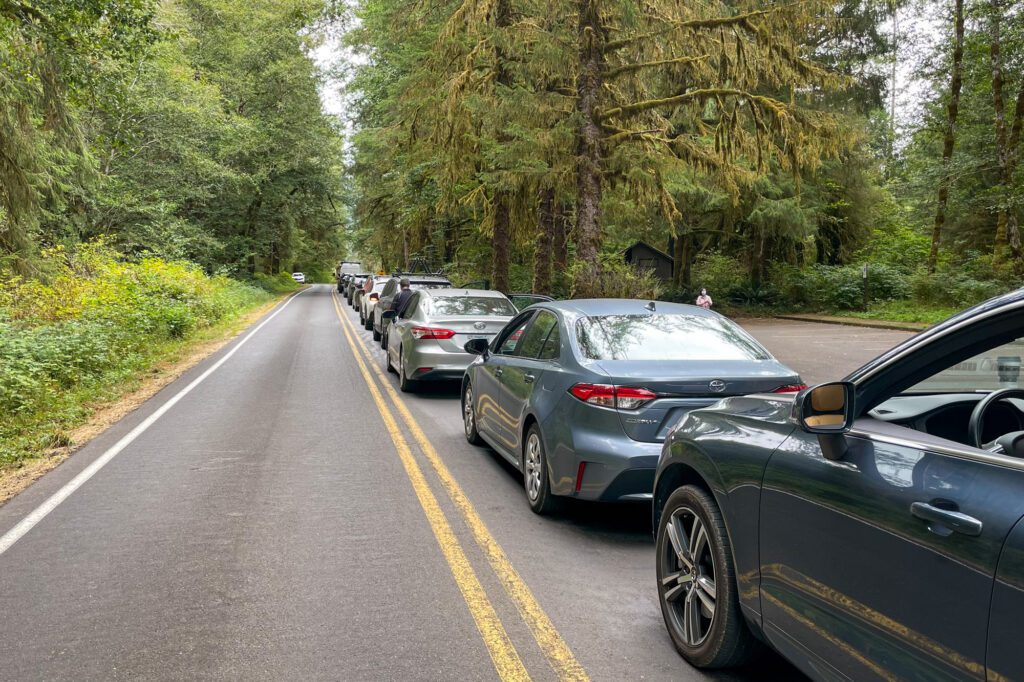
Do yourself a favor and get there by 9:00 am at the latest, both for the best experience in the rainforest, and so that you don’t have to wait for parking.
Did you know? Olympic National Park was put on the path to becoming a National Park in part to protect the calving grounds of these elk at the base of Mt. Olympus?
Teddy Roosevelt made it a National Monument in 1909, and it became a National Park in 1938 thanks to FDR.
Also, the early morning is the best time to visit because there won’t be that many people around, making it more of a solitary experience with the rainforest.
The ambiance is much more pleasant without hundreds of people talking and kids screaming. Believe us.
Once midday rolls around, there’s tons of people, given how accessible it is to explore. Keep that in mind, so you get to enjoy it to its fullest.
There are a couple of short hikes to do here, and a longer option that is customizable to what you’re up for.

Hall of Mosses : The Hall of Mosses is a short 0.8 mi (1.3 km) loop through lush rainforests where you will see moss-covered trees, banana slugs, elk, and more. There’s also plenty of signage with helpful information about everything you’ll be seeing.
Spruce Nature Trail : The Spruce Nature Trail is a 1.2 mi (1.9 km) roundtrip stroll through the Hoh Rain Forest that takes you through ancient groves and relaxing areas of this exceptional rainforest.
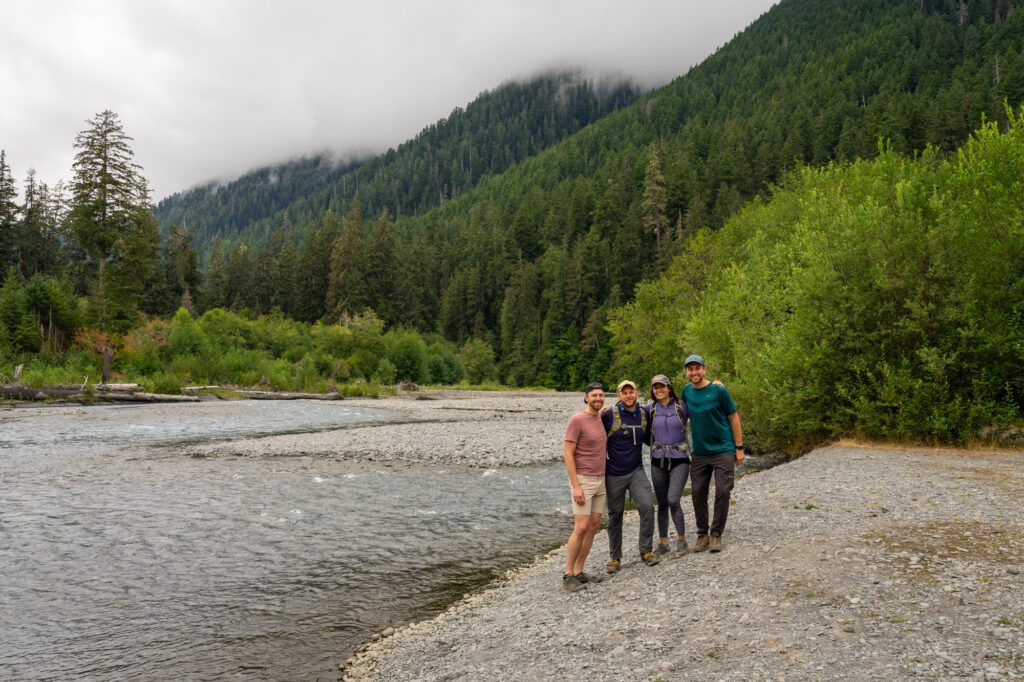
The Hoh River Trail : If these Hoh Rain Forest hikes are too short for your liking, you can also hike part of the Hoh River Trail . This is a 37-mile (59.5 km) backpacking trail that takes you all the way out to the base of Mount Olympus, so if you’re following this itinerary you’ll just want to hike a few miles along the river before heading back to make it to the beaches. We’ve done the hike out to Mineral Creek Falls , and it’s a lovely hike that’s basically flat the entire way.
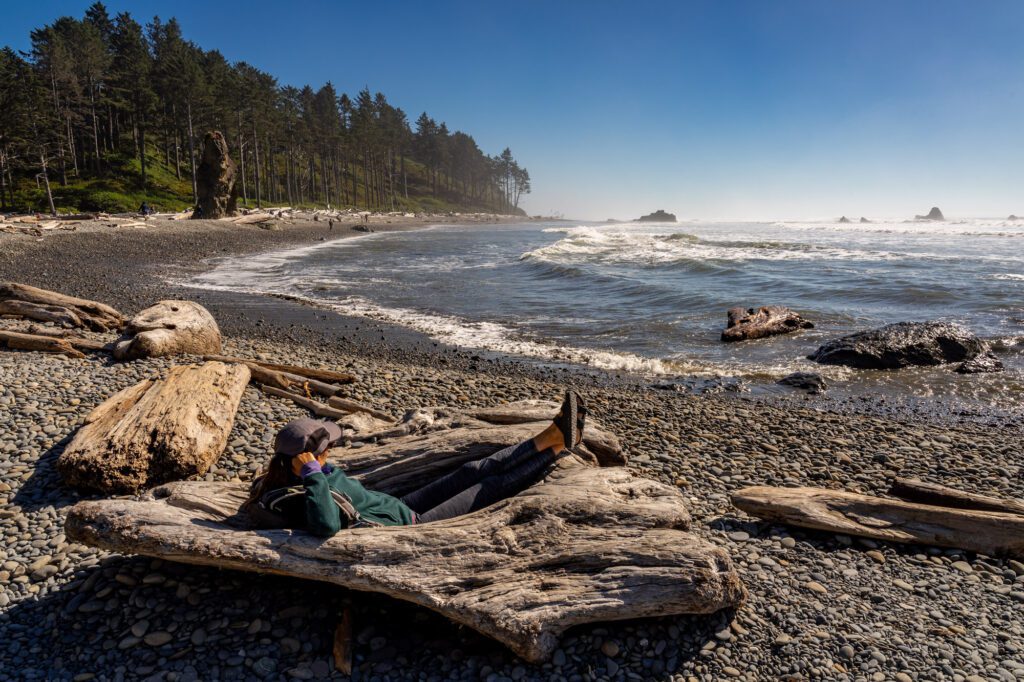
Ruby Beach is a little bit of a detour from the Hoh Rainforest, but we think it’s worth it. From the turnoff to the Hoh Rainforest, you’ll take a left and head south on 101 for 15 minutes to reach the parking lot.
Ruby Beach is probably our second favorite of the Pacific Coast beaches (after Rialto, which you’ll hit later in the evening). The driftwood on the beach and the sea stacks just off the coast are gorgeous, and impress us every time we’re here.
If you’re up for another beach walk, do at least a part of the 6 mile (9.7 km) round trip hike that looks out onto sea stacks and Abbey Island.
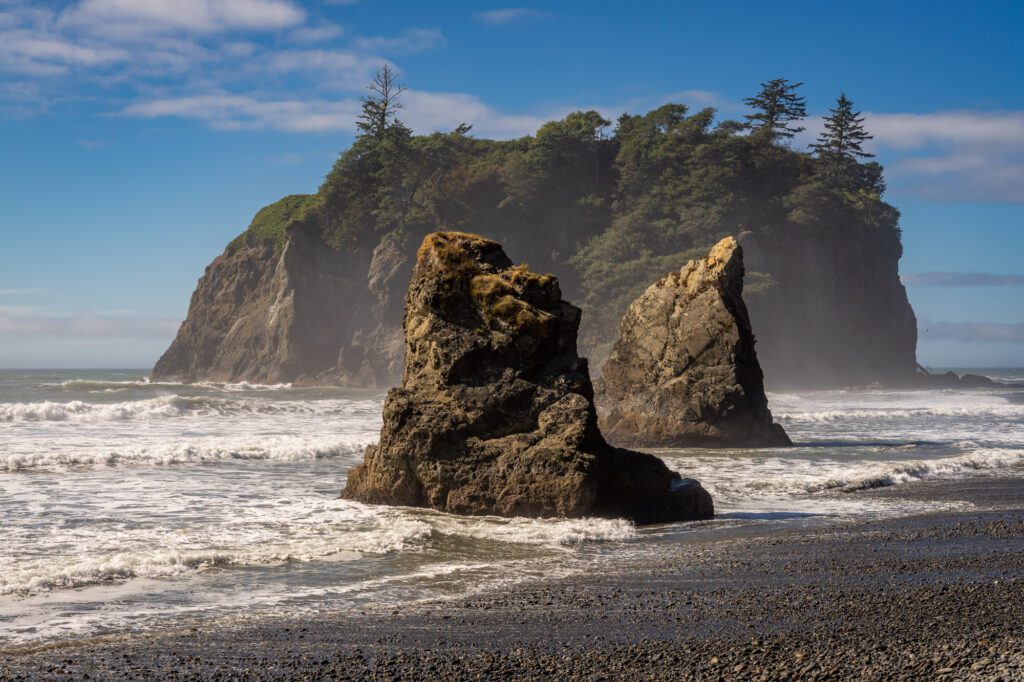
If you happen to be here at low tide, you may even see some starfish and other sea life while you’re at it.
Rialto Beach and Hole-in-the-Wall at Sunset
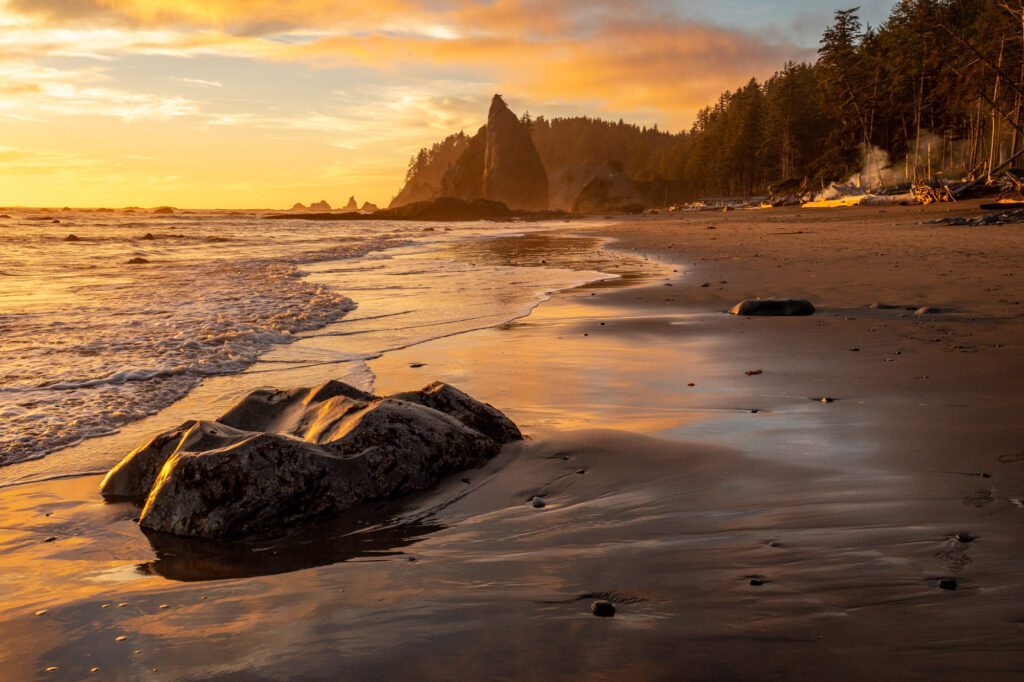
The evening is the perfect time to catch that glorious Pacific Ocean sunset that you have to see in person to truly believe.
The sunset at Rialto Beach is one of the top memories of our two year US road trip. The picturesque sea stacks emerging from the ocean add to the breathtaking backdrop of the daily sunset. Plus, we saw multiple bald eagles hanging out in the trees.
You should know going in that it’s coastal, so there’s a pretty high chance that you won’t be able to see a sunset at all because of the fog or clouds that enshroud this part of the world for most of the year.
However, if it’s a clear day, you’re in for a treat.
If you want to have the best chance of seeing a sunset here, you should come during the summer months. However, it will stay chilly year-round, so bring something warm to wear.
You definitely shouldn’t miss the stroll down Rialto Beach to an incredibly gorgeous spot called the Hole-in-the-Wall . Which is pretty much exactly what it sounds like, only prettier.
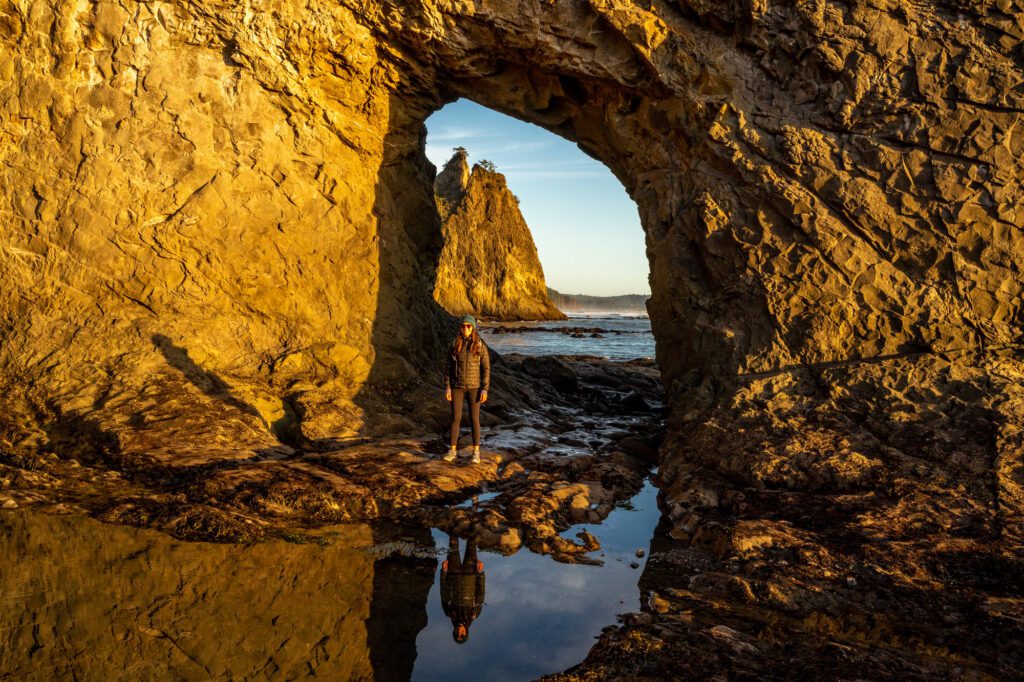
To get there, you’ll walk for about an hour down the beach, passing by a couple of incredible sea stacks that tower above you. Eventually, you’ll reach a point where a natural arch has formed in the wall thanks to countless years of erosion.
There are some pretty cool tidepools on either side of Hole in the wall to explore – remember not to touch or disturb the sea life!
Top Travel Tip : Make sure to check the tides – you need to do this walk at low tide, otherwise you’ll either not be able to get there, or you’ll get stuck out there and have to do some rock climbing to get back. We used this site to check tides.
What to Do with More Time in Olympic National Park
Here are some excellent additions to this itinerary if you’re lucky enough to have more than 3 days in Olympic National Park.
With a full extra day, you can easily add Lake Quinault and Kalaloch (it’s also possible to make this itinerary a big loop and do those two on the way home to Seattle / Portland, looping around the south end of the park to get back to I-5).
Lake Quinault & the Quinault Rainforest
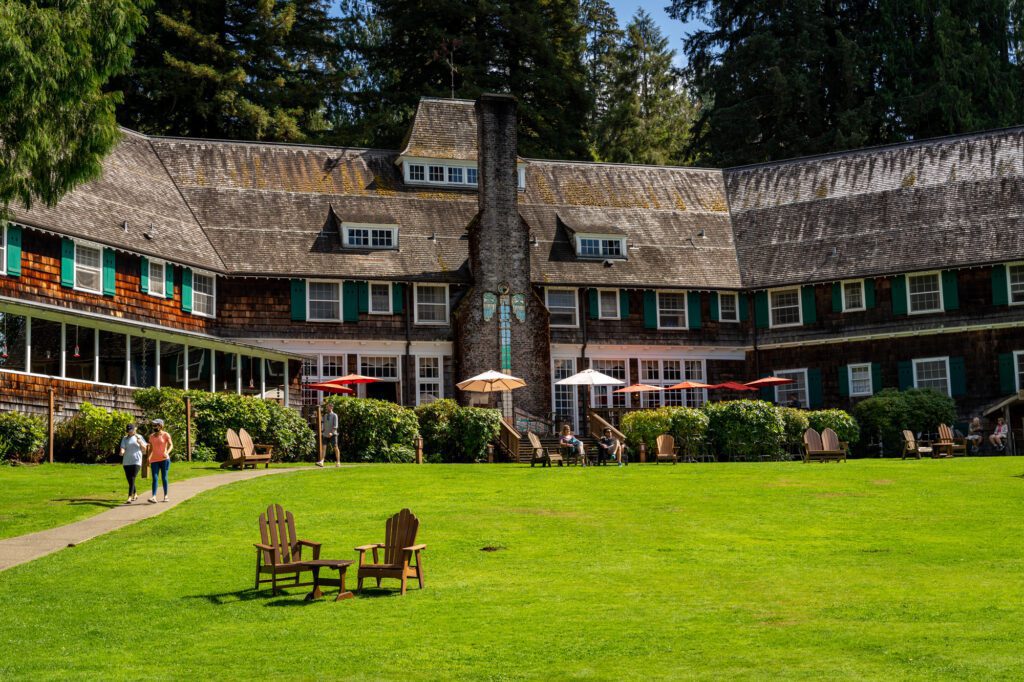
On the southern Pacific Coast, you’ll find another lake and another fern-laden rainforest waiting for you.
Just like with the Hoh Rain Forest, the Quinault Rainforest gets packed. I’d actually recommend heading here later in the day when the crowds start to thin.
The Quinault Rainforest Nature Loop is a quick 0.5 mi (0.8 km) trail that takes you through an incredibly mossy forest with a dizzying array of fungi and animals.
Lake Quinault is a massive glacier-fed lake that is surrounded by mossy old-growth rainforest. It is around this lake that you will find some of the most massive Sitka Spruce trees in the entire world! It’s no wonder it’s called the Valley of the Giants.
There is a 31-mile (49.9 km) loop road that circles the entire lake that is a great place to do some wildlife spotting. Head out around sunset and you might see some elk, black-tail deer, cougars, bald eagles, bobcats, and black bears.
Just south of Ruby Beach is Kalaloch Lodge and the many sandy beaches surrounding it. There’s a nice campground here, and it’s also where you’ll find the Tree of Life, a tree whose roots have been exposed after years and years of erosion.
There are four wide beaches to explore here. You can find more information on the area here .
You can stay at the Kalaloch Lodge in one of their lodge rooms (hotel-style), or one of the oceanfront cabins.
For the price, the facilities are a little rundown (as they tend to be in national park lodges, which are almost always at full capacity), but the location and ambiance can’t be beat. Book well in advance – it’s completely full during the summer.
Like we mentioned, you can combine this area with Lake Quinault for a fourth day on this itinerary. Plus, if you do that, you can follow 101 south to loop back to Seattle or Portland.
Backpacking in Olympic National Park
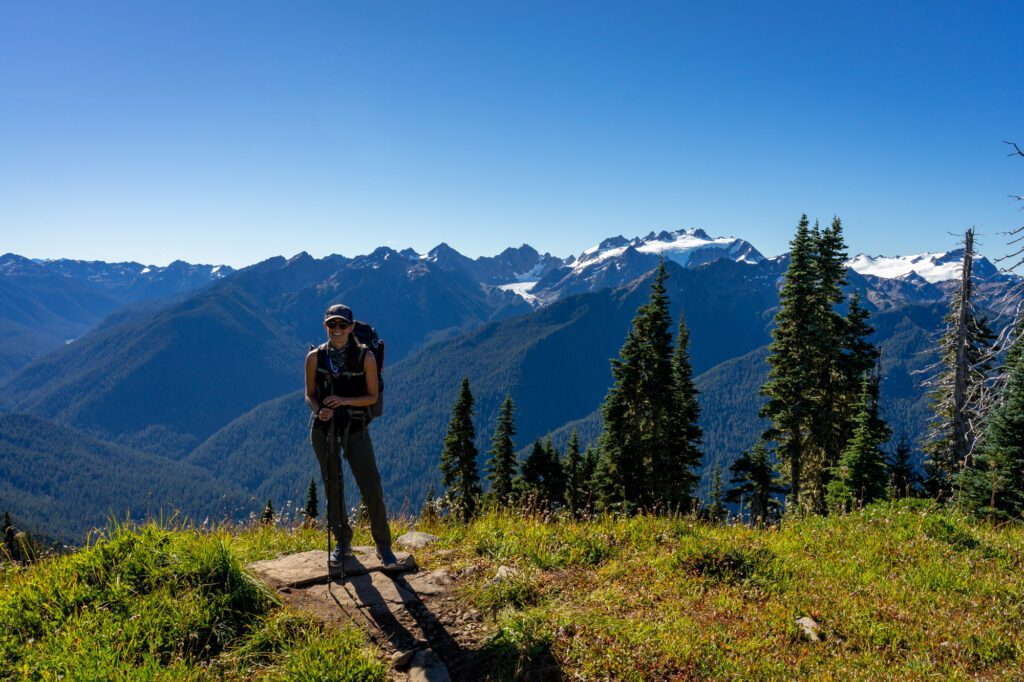
Over the past two summers, we’ve had the privilege of tackling two amazing backpacking trails in Olympic National Park, and loved them both.
Keep in mind that you’ll need a bear canister for any overnight camping – including on the beach – in Olympic National Park.
We have this one , and highly recommend it. Other friends have one of the clear, screw top ones, and prefer using ours.
If you’re planning to do any overnight backpacking, make sure to stop at the ranger station in Port Angeles to get your backcountry permits, bear canisters (for rent if you need them), and information about the park.
If you’re 16 years old or older, it will cost you $8 per night. Any overnight stay in the wilderness will carry this fee, so make sure you get your wilderness permit ahead of time. You can also print them at home ahead of time.
More information on backpacking in the park here .
The High Divide / Seven Lakes Basin

The first we did was the High Divide / Seven Lakes Basin , which is about as spectacular a backpacking trip as we’ve ever done.
You’ll start from the Sol Duc Falls parking lot, and make a big 19 mile loop that takes you up to the High Divide, a rocky ridge with spectacular views of the Olympics and the Seven Lakes Basin below.
Along the way, you’ll pass several spectacular alpine lakes, including our favorites Heart Lake and Lunch Lake.
You’ll need to snag permits as early as possible – they routinely sell out, especially in recent years. You can check availability on recreation.gov .

Do it in three days / two nights, spending one night up on the High Divide (at Lunch Lake!), and one night at Deer Lake or Sol Duc Park (depending on which direction you want to hike).
We liked doing it clockwise, which is a more gradual climb up and an easier climb down, but you could easily do it in the other direction.
The Enchanted Valley
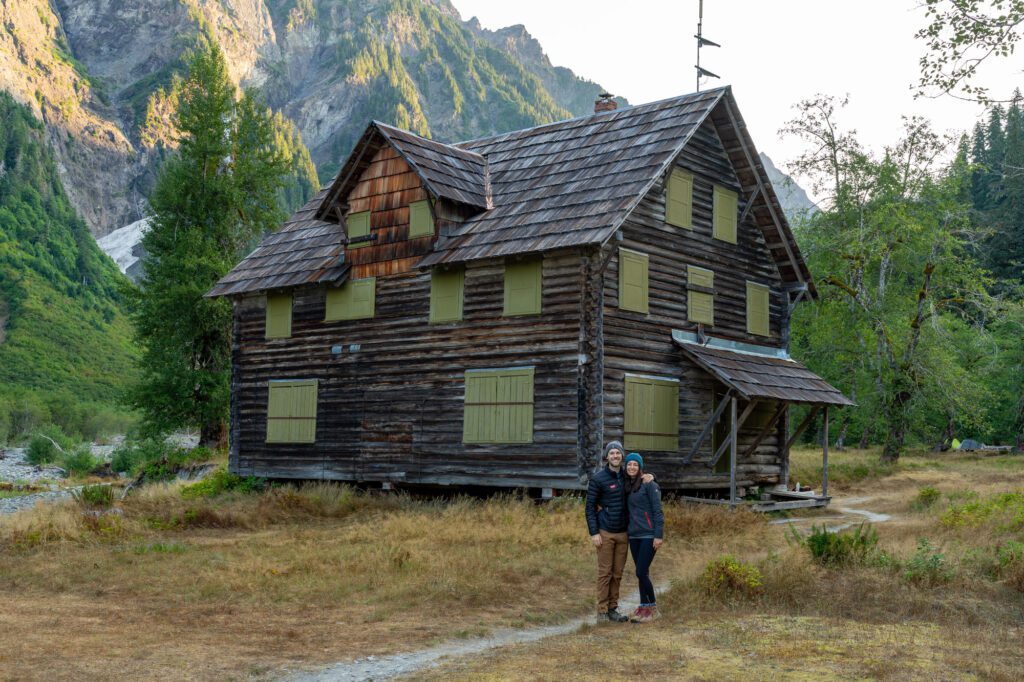
The second backpacking trip we did was the Enchanted Valley , which we tackled midweek last summer.
This one is less about the spectacular mountain views, and more about hiking into a beautiful, secluded valley only accessible to people willing to hike the 13 miles in.
We did three days / two nights here, but would recommend an extra night if you can swing it because hiking the entire 13 miles in one go was a little much. Better to spend a night on the trail there and back to break up the long days.
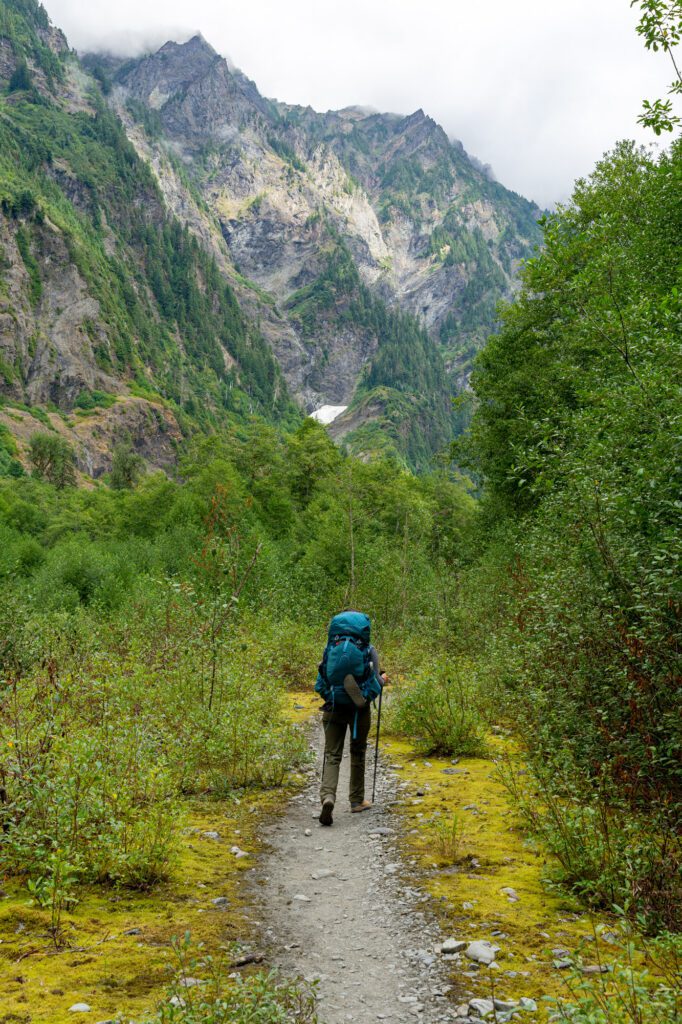
Definitely make sure to spend a night in the valley itself, which is where you’ll find the picturesque chalet that’s in all the pictures (it’s not actually being used at the moment).
We loved this hike, though the valley isn’t so secluded these days (there are routinely 100 people camping in the valley on summer weekends).
What to Do with Less Time in Olympic National Park
If you have one or two days in the park, you’ll need to be a little more strategic with your time. Here’s how we’d spend either one or two days in the park.
Olympic National Park in 2 Days
If you have two days in Olympic National Park, we’d devote one day to each area (the two areas being Hurricane Ridge/Lake Crescent and Pacific Beaches/Hoh Rainforest).
Spend your first morning at Lake Crescent , doing the hike to Marymere Falls and adding the climb up to Mount Storm King if you’re feeling adventurous before heading to the Lake Crescent Lodge afterwards.
Then, take a slight detour out to Sol Doc Falls , and head up to Hurricane Ridge for the afternoon and sunset. Hike Hurricane Hill around sunset for an unforgettable experience.
On your second day, head out towards Forks and make a beeline straight for the Hoh Rainforest . Try to arrive as early as you can to avoid the crowds and the lineup at the gate. Hike the Hall of Mosses and part of the Hoh River Trail to see the dense, wet rainforest in all its glory.
From there head down to Ruby Beach for a picnic lunch and to admire the sea stacks just offshore. End with a walk on Rialto Beach out to Hole in the Wall for an unforgettable sunset.
Olympic National Park in One Day
Like we mentioned above, Olympic National Park really isn’t a great day trip destination (if you’re looking for a day trip, make sure to read our guide to the best day trips from Seattle!).
However, if you have only one day and one night in the park, we’d focus on the northeastern corner around Hurricane Ridge, Lake Crescent, and the Sol Duc Valley. Which means you can follow day 1 of this itinerary as written!
How to Get to Olympic National Park
Olympic National Park is not really that close to Seattle, which means it’s a long way to go for a day trip (we wouldn’t recommend it).
However, with a few days and a car, it’s a fairly accessible slice of wilderness that is easily reached from the Seattle area and from Portland, Oregon.
Getting to Olympic National Park from Seattle
There are a couple of easy options if you’re coming from Seattle – drive around, or take the ferry to Bainbridge . Both take roughly the same amount of time, but the ferry is a spectacular way to travel out to the park (though it isn’t free).
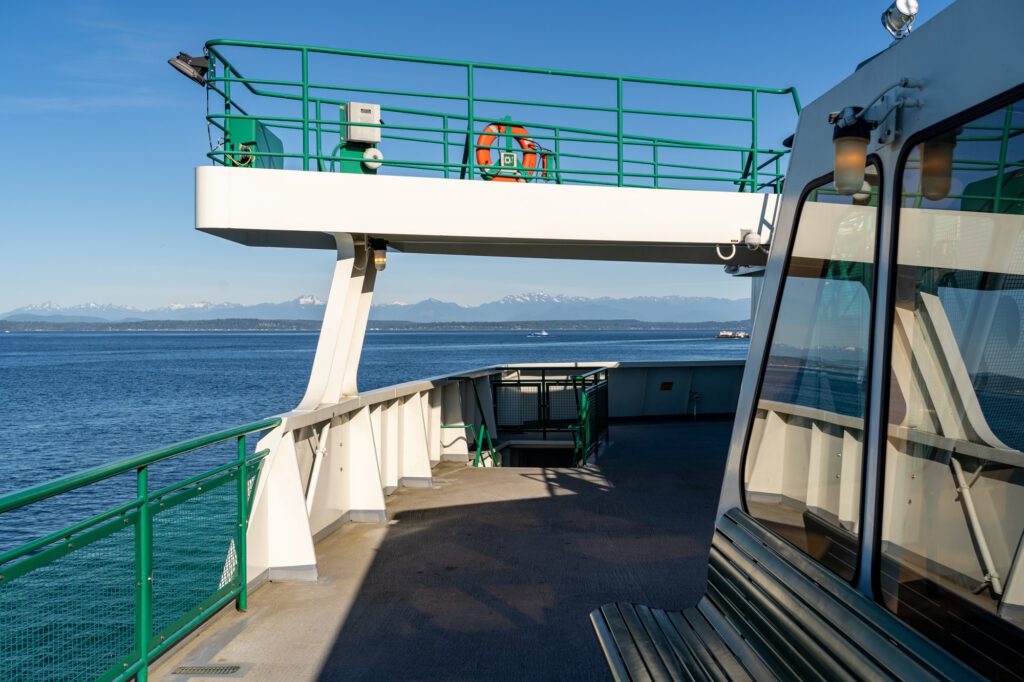
The crossing will take you about 35 minutes, and it’s going to cost you $16.40 (includes the driver) for the car, plus the walk-on fare for everyone else in the car ($9.25 per adult, and $4.60 for kids).
The fees are here if you want to take a look. Schedules are here – they come roughly every 60-90 minutes, and you’ll want to show up 20-30 minutes early because they do fill up, particularly on summer weekends.
The alternative is to drive around through Tacoma , cross the Tacoma Narrows Bridge, and head north along the Hood Canal.
Eventually, you’ll connect with Highway 101, which runs from the northeast side of the park alllll the way down the coast to the southwest edge of the park, and even down to California.
Getting to Olympic National Park from Portland
Despite being in Washington State, Olympic National Park makes for a nice weekend getaway from Portland .
If you’re coming from Portland, you’re going to be closer to the south end of the park. The easiest way to get there is to hop on I-5 north out of Portland and cut over to US-101 at Olympia (via US-12), which will take you around the south end of the park.
From Portland to Forks, it’s a five hour drive. From Portland to Port Angeles, which is where we have this itinerary starting, it’s four hours or so.
A note if you’re coming from Portland : The best way to do this itinerary from Portland is to make it a big loop, and you can do it in either direction. Which means you’re going to have a long drive on either end.
The Best Time to Visit Olympic National Park
Unlike other places in Washington State (namely the Cascades), Olympic National Park is fairly accessible year round thanks to most of the park being at relatively low elevation.
The coastal areas are definitely accessible year round, and Hurricane Ridge is also reachable for the most part, except during big winter storms. Outside of summer, plan on being wet!
Summer : From our experience, the summer months are the best time to go .
Yes, there are TONS of people, but the weather is warm, dry, and generally pleasant. Overall, most people prefer visiting the park in July and August .
This is when the temperature will be at its warmest and most comfortable. Virtually all roads and facilities will be open as well.
Early to mid-fall : The period between Labor Day and mid-October is also a nice time to visit the park. Crowds will be much more manageable with all the kids back in school, and the weather is still pretty good.
Though, we should note that it’s more unpredictable, and you’re likely to see more rain the deeper into October you go.
Plus, active elk (rutting season!) and sprinkles of fall color make fall a lovely time to be out on the Olympic Peninsula.
Winter : In the winter, you’re going to find cooler weather, coastal fog, and even snow at some higher elevations. And more importantly, far fewer people.
Some roads are closed, which means you won’t be able to access different parts of the park (see road closure information below).
Spring : In March and April, the park awakens from a long, wet winter slumber, and snow starts to melt at higher elevations as you get into May. Still, it’s definitely going to be wet, so pack a rain jacket and some waterproof boots.
Seasonal Closures : Depending on what time of the year it is that you’re going to visit this beautiful park, there may be some seasonal and temporary closures. You can check road closures and the status of different areas of the park here .
Matt is the founder and main writer behind Wheatless Wanderlust, which he started back in 2018 as a way to share his gluten free travel guides with his fellow Celiac travelers.
Since then, Matt and his wife Alysha have visited 18 national parks, spent three months in Europe and six weeks in Colombia, and have explored every corner of the Pacific Northwest, which is where Matt grew up.
He writes super detailed guides to the places they visit, bringing together personal experience and historical context to help YOU plan an amazing trip.
25 Comments
Thank you for writing this! Wife wanted to do a trip to Yellowstone last year but didn’t end up working out because of other plans. Now we’re planning one to Olympic National Park for early-mid June this year in a rental RV (I hope there are still enough campgrounds!) for 7 days. I am thinking that I will roughly follow the itinerary outlined in your blog here – just take it slower and spend roughly two days in each place. Please let me know if this sounds like a good idea.
Based on your recommendations and our interest, I will definitely want to go to Hoh Rainforest, Sol Duc Hot Springs, Hurricane Hill, Rialto Beach, Ruby Beach and Lake Quinault (hoping to catch some fish and do some boating/kayaking too). Wish us luck! Thanks again!
We recently returned from four days in the park that we visited in late September. We enjoyed the hiking despite being unable to get to hurricane ridge but I’d say the following: 1. Less ranger support than I’m used to. Many locations were unmanned so getting their perspective which I always liked was difficult. 2. Forks is really hit or miss for food or lodging and is expensive. 3. The Makah cultural center in Neah Bay was an unexpected treat. The staff and quality of the exhibits was well worth the hour diversion. The impact on the indigenous people who lived in the area before European settlement is something to understand. 4. We had Beach whiteout three of four days. The hikes were great but I’m told that it’s not uncommon to get a thick marine layer that can make seeing the coastline an iffy proposition.
This was so helpful! I appreciate your post so much! I felt overwhelmed when I begun planning this trip, but this laid it all out for me!
Thanks for the kind words! Glad you found it helpful – that’s what we’re trying to do.
Leave a Reply Cancel reply
Your email address will not be published. Required fields are marked *
This site uses Akismet to reduce spam. Learn how your comment data is processed .

Olympic National Park Beach Backpacking: South Coast Trail Guide
This guide to backpacking the South Coast Trail in Olympic National Park will prepare you for a fun beach backpacking trip in Washington.
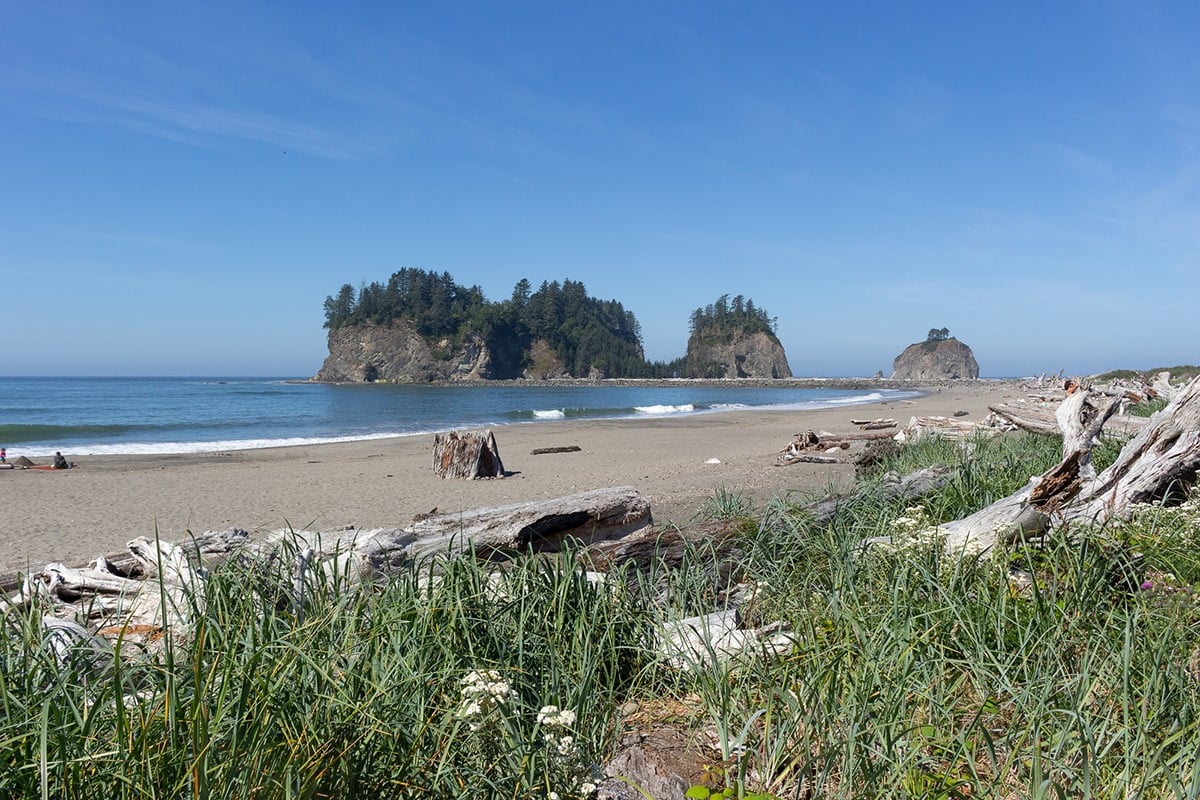
Find this post helpful? Learn how you can support Bearfoot Theory’s work here . You can also shop for gear through the affiliate links in this blog post where we get a small commission at no cost to you. It helps keep our team running and the lights on. THANK YOU! -Kristen
Washington’s Olympic Peninsula is filled with rugged sea stacks, abundant marine life, and sandy shores. Backpacking Olympic National Park is one of the best ways to explore this area and feels like one of the more wild experiences in the country. The South Coast Trail, a beach backpacking trip detailed here, provides a comprehensive view of the south coast of the Olympic Peninsula and is great for backpackers who are used to grueling mountain trails looking for a change. Plus, nothing beats waking up on a beach to the sound of waves and the smell of the ocean.
The trail follows the natural formations of the coastline, but some sections require an overland trail that is accessed by ladders and steep terrain when hiking on the shore isn’t possible. It’s also fairly easy to get to from Seattle, which means it can get pretty busy in the summer months. All in all, this is one of my favorite routes on the West Coast. If you’ve ever wanted to go beach backpacking, this is a great trail to start with.
In this guide to backpacking the South Coast Trail in Olympic National Park, we cover everything you need to know for a successful beach backpacking trip in Washington.
Best time for beach backpacking in olympic national park.
Washington is notorious for being wet, so the ideal season for backpacking Olympic National Park is fairly short. It’s best done between May-October . If you want to have more solitude, the fall months are the way to go (make sure to bring your rain gear ). And while fog is common on Washington beach backpacking trips, the good news is that a foggy morning doesn’t ruin the day – the coast is just as beautiful under a blanket of mist as it is under blue skies.
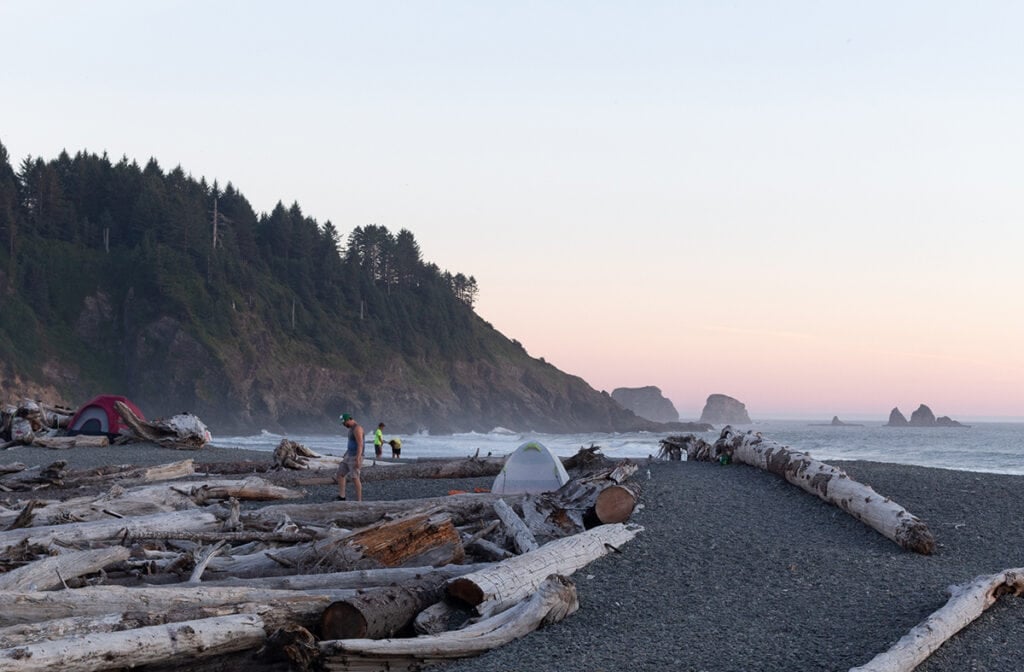
South Coast Trail Basics
Although this trail may not be as physically demanding as others, you have to know the tide cycles and some sections may require waiting for low tide to cross . This is important – you don’t want to get stuck because you didn’t look at the tides. You can find all this information using a tidal chart, which I recommend you have on you for the duration of your hike. A tidal chart will tell you the exact hours and locations of low tide so you can plan accordingly (this may require that you leave two hours later, or earlier, than originally planned, for example).
- Trailhead: Third Beach Trailhead (if hiking south) or Oil City Trailhead (if hiking north)
- Trail Type: One-Way
- Distance: 17 miles
- Elevation Gain: ~250 ft.
- Difficulty: Moderate
- Days Recommended: 3 days/2 nights
- Dogs Allowed: No
- Wilderness Permits Required: Yes
- Camping Reservations Required: No
Transportation Logistics
Since the South Coast Trail is a one-way route, many people opt to take two cars and leave one at the destination trailhead and drive the other back to the starting point. If you’re starting at Third Beach Trailhead, you can leave a car at the Oil City Trailhead parking lot (and vice-versa). Both parking lots are free and there’s no limit to overnight stays. If you are not planning to bring a second car, I recommend taking a shuttle from your destination trailhead back to your starting point . There’s one that runs every day from either trailhead for $60 per person (2 or less) or $40 per person (3 or more). You can find further information on shuttle rates and schedules here .
We left a second car at the trailhead but the whole ordeal was pretty time consuming. Take the shuttle if you can, it’ll save you time and energy.
Getting To Third Beach Trailhead
It’s about a four-hour drive from Seattle to Third Beach Trailhead . Otherwise, you can take a ferry to Bainbridge Island and drive the rest of the way for a more scenic ride. It might be a good idea to spend the night in Forks before your trip so you have a flexible start time, in case you need to alter it for the tides. You don’t need to pay for parking at the Third Beach Trailhead, although it gets pretty busy in the summer. Consider carpooling or getting there early for a spot. If the parking lot is completely full, you can consider parking at First Beach and starting your trek from there (it adds about a mile to your first day).
Getting a Wilderness Permit to Backpack in Olympic National Park
You can get your wilderness permit for backpacking Olympic National Park in advance online through the Olympic National Park Wilderness page . You don’t need specific permits depending on which trailhead you start at. You can get your reservation six months prior to your trip but make sure you get it at least a week before you start your trek.
Water and Toilets
There are natural water sources from streams and rivers throughout the hike, but make sure to bring a water filtration system or iodine . Pit toilets are available at all campsites.
Fire Regulations on Olympic National Park Beaches
Fires are only allowed on the beach with existing driftwood . I recommend camping on the beach instead of inland during your second night if you want to have a fire. It’s a really cool experience to have a campfire on the beach during sunset, and driftwood is plentiful.
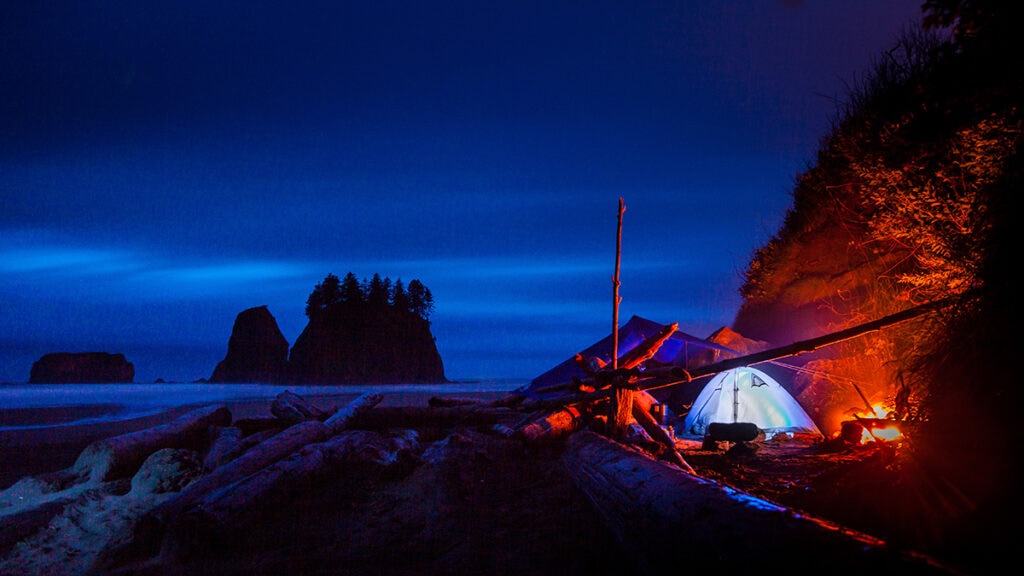
Beach Backpacking Gear Recommendations
When I was done with this Washington beach backpacking trip I was covered, and I mean covered, in sand and mud. I would recommend bringing full rain gear and plenty of layers so you’re prepared for any weather that might come your way, as well as sturdy hiking boots to support you while walking through the sand. In particular, high top hiking boots will help stabilize your ankles and also help keep sand out of your shoes. Another option is hiking in Tevas or similar hiking sandals since there are a few river crossings. Additionally, some people recommend gloves as the ropes on the trail can get wet and slippery in colder months.
Bear canisters are required and can be picked up at Quinault Ranger Station, along with tide charts and wilderness backpacking permits .
For more hiking and backpacking gear recommendations, check out the following posts:
- 3 Day Backpacking Checklist
- What to Wear Hiking
- What to Wear Hiking in Fall
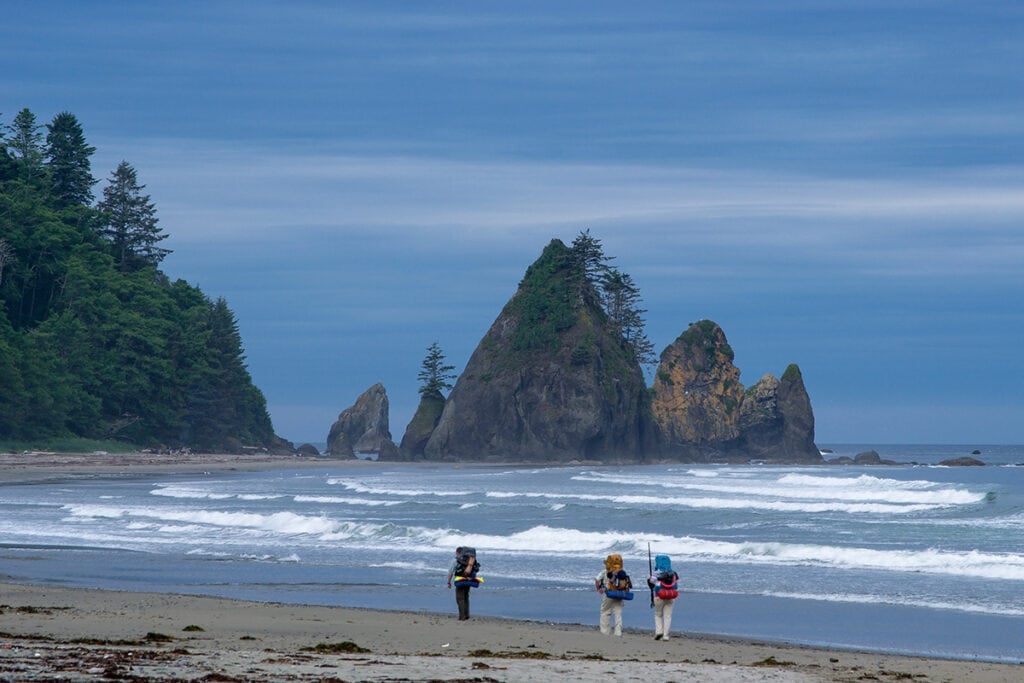
South Coast Trail Itinerary for Backpacking in Olympic National Park
Day 1: third beach trailhead to toleak point campsite.
- Distance: 6.8 miles
- Time: ~4-5 hours (depends on status of tides)
There are two options for starting out your trip. If you parked at First Beach, plan to add about a mile to the day. If you parked at Third Beach, a winding trail through the lush rainforest will take you down to the ocean, and your beach backpacking trip in Washington begins!
You’ll hike on the sand for a short time before reaching the first overland trail at Taylor Point. The trail will be marked by an orange and black circular sign, where a steep trail begins with a wooden ladder and rope. Keep your eyes peeled for the overland trail because it’s possible to miss it . There are two overland sections on this day.
The first point where you’ll have to deal with the tide is just south of Scotts Creek about an hour into your hike. The section is only passable when the tide is 4 ft or lower , so make sure to check your tide chart before you head out. We had to wait a little less than an hour for low tide, so I would bring a book or a hammock to wait it out if needed. When you round the bend just south of Scotts Creek you’ll make it to Strawberry Point where you’ll see campsites along the forests’ edge. You can choose to set up camp here instead of Toleak Point if you got a late start and want a shorter first day.
After hiking through sections of forest, sand, and driftwood, you’ll make camp at Toleak Point on the beach. There are a few sites in the forest but most are on the sand.
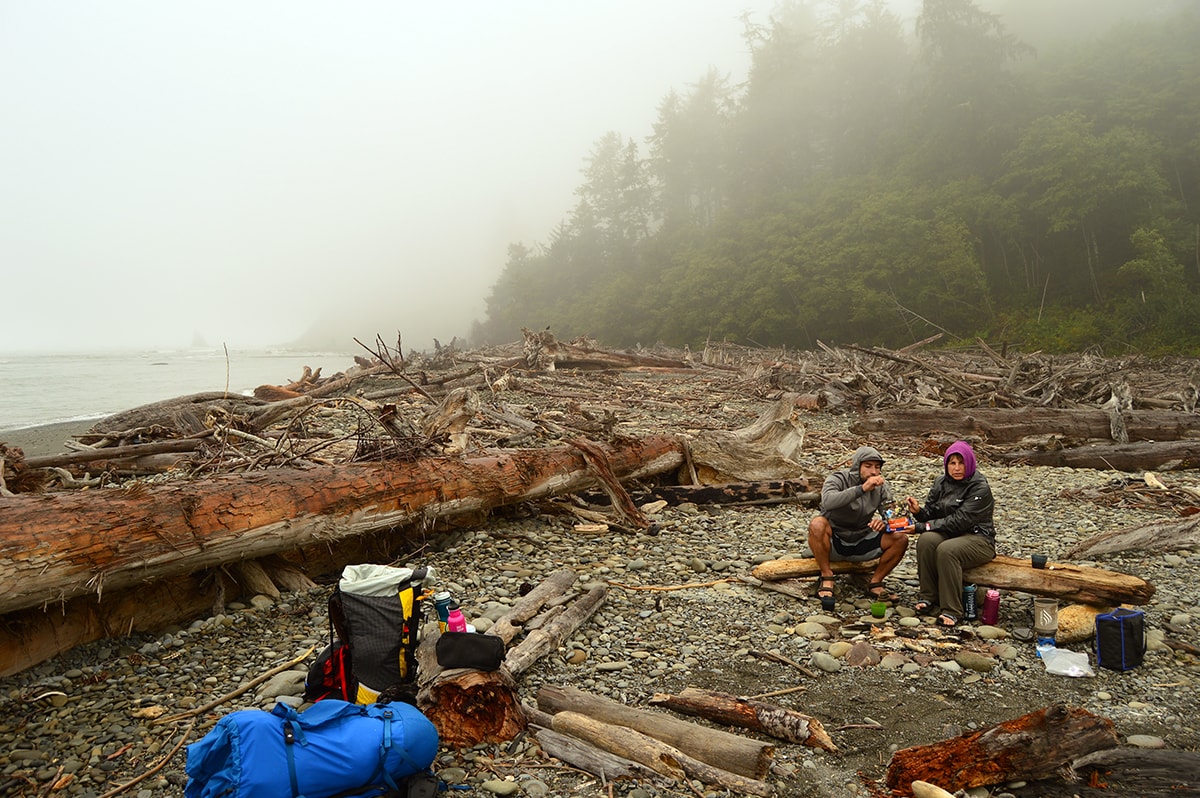
Day 2: Toleak Point Campsite to Mosquito Creek
- Distance: 4.6 miles
- Time: ~3-4 hours
This segment of the South Coast Trail is short and a great day to take your time and enjoy the tide pools. You’ll hike for about a mile on the beach before reaching an overland point where you’ll find an inland trail marked by the circular black and orange sign. The inland section here is a little longer than the first day and when the trail led back to the sand I took an hour long break to do some yoga on the beach – it was wonderfully slow-paced and peaceful.
There are a couple river crossings on this day about two miles in – Falls Creek and Goodman Creek. If you choose to cross Falls Creek during high tide, the water may be waist-deep (normally shin-deep). Goodman Creek is ankle deep. After crossing both these rivers, you’ll be walking on the beach for about two miles before reaching Mosquito Creek, where you’ll find a river crossing that should be done at low tide.
The camping spots at Mosquito Creek are primarily in the forest right off the overland trail . These spots can be regularly taken in the summer months. Camp on the beach if there are no forest spots (a better option anyway, in my opinion). This was one of our favorite nights on this Washington beach backpacking trip because we spent hours exploring the beach and looking at the sea anemones in the pools.

Day 3: Mosquito Creek to Oil City Trailhead
Distance: 6.1 miles Time: ~4-5 hours
The final day of this Washington beach backpacking trip is mostly in the rainforest. A lush, green environment feels welcome after days of trekking on the sand.
The inland trail can often get muddy and wet , so be aware of the conditions and come prepared. Caution should be used on the ladder when entering Jefferson Cove as it’s often wet and unstable .
South of Jefferson Cove is Diamond Rock. This is a tidal restricted area that should only be crossed at a tide of 2 ft or lower . When you get to the Hoh River you’ll follow a short trail along the river that will lead you back to the Oil City Trailhead.

Do you have any questions about backpacking the South Coast Trail in Olympic National Park or have you done it? Leave a comment below!
Related Posts
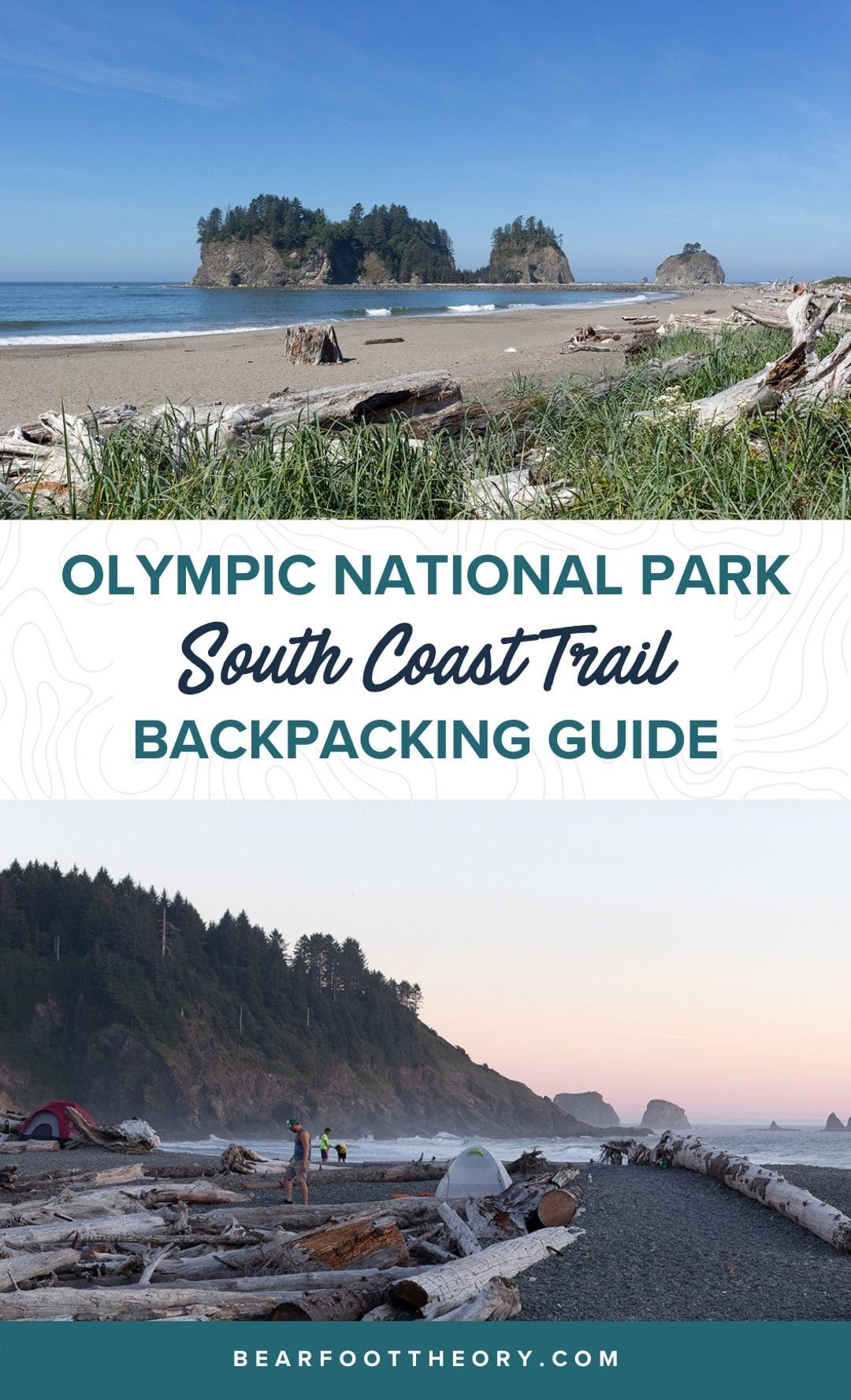
Polina is an avid skier, climber, and backpacker. She grew up in Minnesota to a family that loved backpacking and mountaineering, which solidified her love for everything outdoors. She believes that advocating for our environment is equally as important as going out and enjoying all it has to offer. You can find her living out of her SUV in the desert eating good food, basking in the sun, and writing.
Leave a Reply Cancel reply
Your email address will not be published. Required fields are marked *
Save my name, email, and website in this browser for the next time I comment.
We don’t have “shores” out here in the West. We have beaches. This ain’t New Jersey.
Wow! This can be one of the most helpful blogs we have ever come across on thesubject. Basically magnificent post! I’m also an expert in this topic therefore I can understand your hard work.
You are using an outdated browser. Please upgrade your browser or activate Google Chrome Frame to improve your experience.

- Trip Styles
- Destinations
Olympic National Park Backpacking Trips

- Olympic Hiking Tours Olympic National Park Backpacking Trips
Our guided backpacking tours take you into the heart of world-renowned wilderness destinations. Enjoy solitude and adventure as you embark on a self-sufficient journey deep into Olympic!
Olympic National Park comprises a wild and stunning region along the Pacific coast of Washington. A mix of coastal, rainforest, subalpine and alpine ecosystems, the sheer diversity of this wilderness is phenomenal. And there’s no better way to experience it than on a multiday backpacking trip!
Our Olympic backpacking trips give you the option of exploring the coast or the alpine country, both with amazing rainforest hiking. We provide all the gear and meals, as well as transportation, permits, fees and a professional guide.
Come join us this summer for a trip you’ll never forget! Call us at 1-800-715-HIKE (4453) or email us to learn more.
Filter Trips
Trip length.
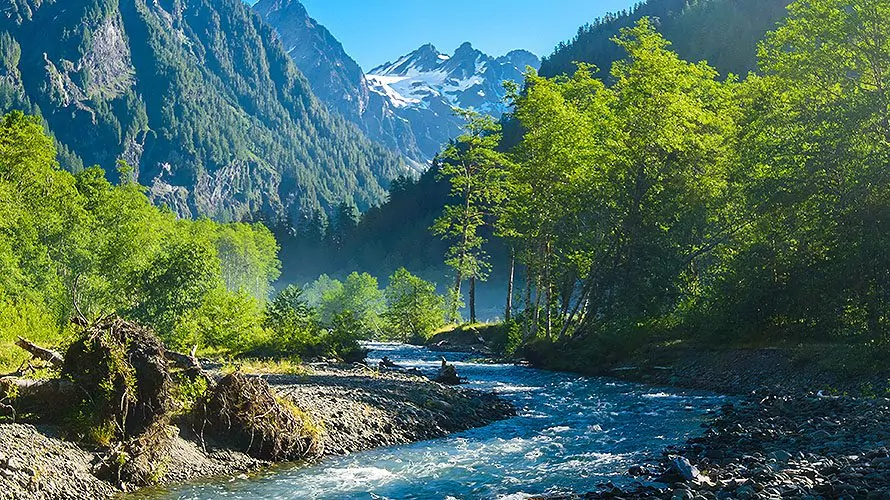
Enchanted Valley
Wild Olympic Coast Traverse
Olympic Rainforest to Glacier Trek
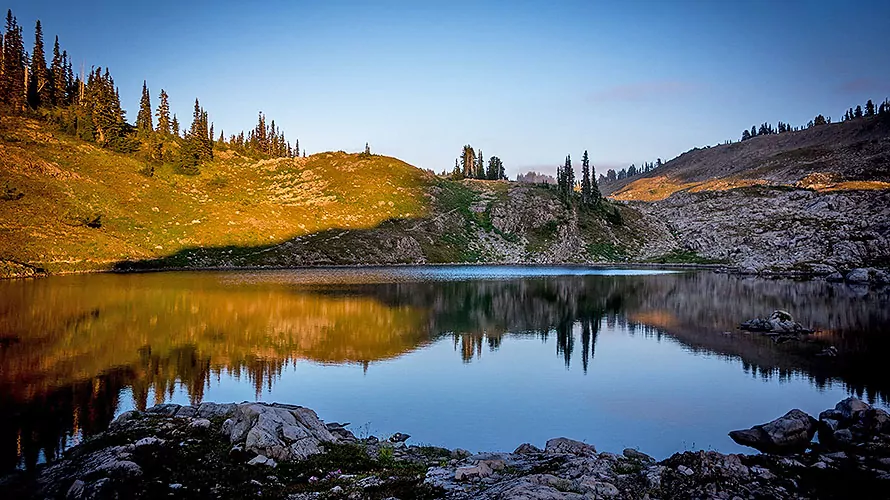
Seven Lakes Basin
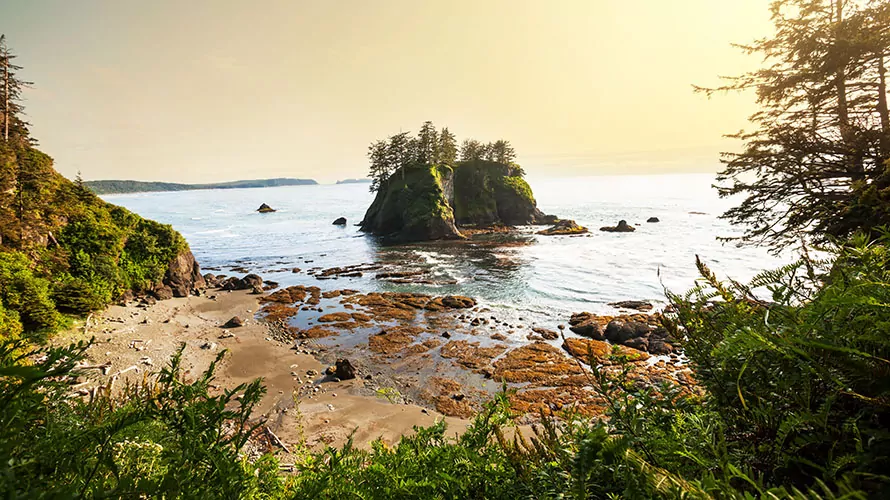
Point of Arches
Olympic Inn-based Tours
See Inn-based Tours
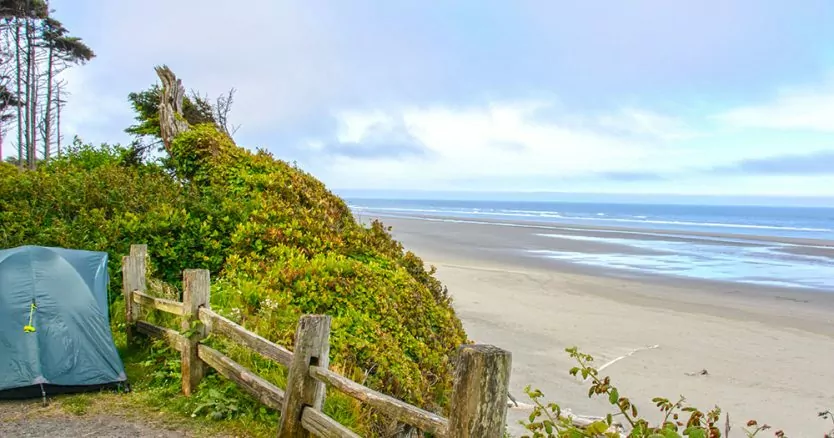
Olympic Basecamp Tours
See Basecamp Tours
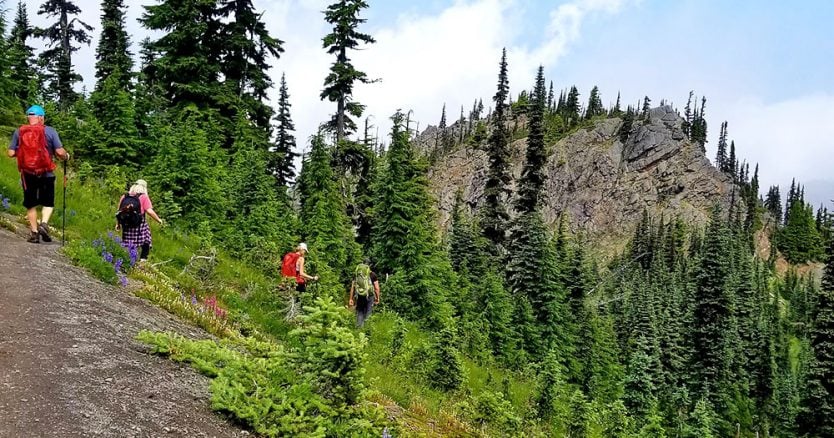
Olympic Day Hike Tours
See Day Hike Tours
OLYMPIC VISITOR INFORMATION
Tips for visiting olympic.
- VISITING OLYMPIC : Get info on what to do, when to visit, how to get there, best hikes, best tours and more.
- WHEN TO VISIT OLYMPIC : Find detailed information about when to visit the based on what you want to do and see.
- VISITING IN THE SPRING : Learn about visits to the Pacific Northwest in the months of March, April and May.
- VISITING IN THE SUMMER : Learn about visits to the Pacific Northwest in the months of June, July and August.
- VISITING IN THE AUTUMN : Learn about visits to the Pacific Northwest in the months of September, October and November.
- VISITING IN THE WINTER : Learn about visits to the Pacific Northwest in the months of December, January and February
- 10 BEST HIKES IN OLYMPIC : Find out what our top 5 recommended day hikes are with recommended pack lists and more.
- BEST OLYMPIC TOURS : Learn about the top tours and recommended companies for fishing, hiking, boating and more!
- WHAT TO DO IN OLYMPIC IN ONE DAY : Only have one day? Make the most of it by following our expert tips!
- OLYMPIC BACKPACKING PERMITS : Learn about the complicated Grand Canyon backcountry permit system and how to apply.
wildland Wires
Sign up to receive our exclusive Wildland Wire emails and stay up to date with Wildland Trekking's promotions, discounts, contests, outdoor tips and tricks, trip reports and more!
Backpacking Tours in Olympic National Park
Seattle, WA, is 4 hours away
Intermediate to advanced
Things to know
Quench your thirst for a real challenge in the mountains or along the coastline by joining a backpacking trip in Olympic National Park! Several dozen trails meander through the Olympic Mountains and along the coast, linking—depending on the itinerary you choose—rushing rivers, glassy lakes, and thundering waterfalls, or coastal forests, teeming tide pools, and rugged cliffs. So pick a trail and spend 4 or 5 days backpacking through the park and its 280-foot trees of the primeval forests that ooze a fairytale atmosphere. With the food, equipment and camping covered by your guides, the only thing you’ve got to do is set up your camp under the stars and keep an eye out for the thriving wildlife—such as deer, marmots, or black bears.
Head deep into the primeval forests or hike along some of the most northwestern points of the Lower 48
Discover 1,100 species of plants and millennium-old trees sprinkled throughout nearly a million acres
Spot the roosevelt elk named after Teddy Roosevelt, who established the Olympic NP in 1938

Available itineraries
Though there are countless streams and sources of water in Olympic NP, this trail connects some of the most spectacular ones! Over the course of 4 days, you’ll traverse 17 miles through pristine, old-growth forests and set up your camp every night. Marvel at the Sol Duc Falls, soak in the sweeping views of high alpine peaks, and explore the Seven Lakes Basin—all within a single trip. Apart from terrific guides with exceptional knowledge of the area, you also get delicious food, camping equipment and permits for the duration of the adventure.
Meet your guide and your group at 4 pm at the Sol Duc Campground. Get acquainted with everyone and go over what to pack and what to leave behind. Settle in for the night under the forest canopy and get a good night’s sleep listening to the creek. Backpacking starts tomorrow.
Meals : Dinner

Start your adventure by gaining a bit of elevation up to Deer Lake, passing by the famous Sol Duc Falls at the beginning of your hike.
Meals : Breakfast, lunch, and dinner Hiking : 3.5 miles / 5.6 km Elevation : +2,300 ft / +700 m

From Deer Lake, head to Heart Lake, and stop at Lunch Lake for lunch! This takes you along the High Divide Trail offering sweeping views of snow-capped mountains with carpets of wildflowers and an opportunity to spot the Olympic Marmot or even elk!
Meals : Breakfast, lunch, and dinner Hiking : 8 miles / 12.9 km Elevation : +3,700 ft / +1,130 m | -2,500 ft / -760 m

Wake up in a spectacular location on your last day, have a hearty breakfast before packing up and hiking the last miles downhill to the trailhead. If you’d like to stay longer, just ask your guides for some recommendations!
Meals : Breakfast and lunch Hiking : 7.75 miles / 12.5 km Elevation : +900 ft / +275 m | -3,600 ft / -1,100 m

Please note that all dates remain tentative until permits are received after April 15. Please refrain from making travel arrangements until the dates are confirmed . We will contact you if your guides successfully obtain the permits for the exact dates above.
Note: For a detailed map with elevation profile of the tentative itinerary, click here .
The Olympic Mountains guard one of the largest primeval rainforests in the U.S. and the wettest destination in the Lower 48. This 5-day backpacking adventure takes you through this famous Hoh Rainforest and to the monumental Blue Glacier of the Olympic National Park! Traverse a total of 35 miles during the hike and explore different ecosystems within the park, as well as a variety of plants and wildlife that inhabit them. The guide, the food, camping equipment, and permits—it’s all taken care of, so your main task is just focusing on how spectacular the trail is.
Meet your guide and your group at 4 pm at the Hoh Campground. Get acquainted with everyone and go over what to pack and what to leave behind. Settle in for the night under the forest canopy and get a good night’s sleep listening to the creek. Backpacking starts tomorrow.

On your first full day of adventure, hike 9 gradual miles to the Olympus Guard Station gaining 950 easy feet of elevation. You’ll have plenty of opportunities to take pictures of the Hoh’s ancient forest, which is one of the most pristine temperate rainforests in the United States.
Meals : Breakfast, lunch, and dinner Hiking : 9 miles / 14.5 km Elevation : +950 ft / +290 m

Today you hike from the Olympus Grand Station to Elk Lake Campground. From here, you have a decision to make: either hike to the glacier (another 6 miles roundtrip with 2,800 ft of elevation gain) in the afternoon, or hike the glacier on the morning of Day 4 before moving camp. Upon arrival at the Blue Glacier with Mount Olympus towering overhead, soak in the views and have a good meal.
Meals : Breakfast, lunch, and dinner Hiking : 11 miles / 17.7 km Elevation : +5,000 ft / +1,524 m | -2,800 ft / -853 m

Hike downhill back to the Olympus Guard Station, a beautiful campground where you’ll relax for the night.
Meals : Breakfast, lunch, and dinner Hiking : 5 miles / 8 km Elevation : -2,200 ft / -670 m

Enjoy the easy hike of the last flat portion to the trailhead and take the last few photos. If you’d like to stay longer, ask your guides for some recommendations and keep on exploring!
Meals : Breakfast, lunch, and dinner Hiking : 9 miles / 14.4 km

Please note that all dates remain tentative until permits are received after April 15. Please refrain from making travel arrangements until the dates are confirmed. We will contact you if your guides successfully obtain the permits for the exact dates above.
This tour grants you with the unique opportunity to explore coastal regions on some of the most northwestern points in the continental U.S.! You will traverse coastal forests to reach the beach, where teeming tide pools and rugged cliffs await your presence. By the time you finish the tour, you’ll have mastered the art of tide tables, tide timing, and headland conquests. The logistics are taken care of—you’ll have a fantastic guide, who will cook the meals, take care of the permits, and provide you with camping equipment should you need it. Ready for a coastal adventure in the pristine wilderness of Olympic NP?
Meet your guides at the Rialto Beach Backpackers Parking Lot, where you’ll also get acquainted with your group, pass and pack gear, and cover trip logistics. Shuttle over to Ozette Trailhead for approximately 2 hours. At the Ozette trailhead, stop for a quick lunch before embarking on a 3-mile hike to the Sand Point Campground.
Breeze through this hike with easy terrain across mostly boardwalk that weaves through minty coastal forests until you reach the beach and the camp. Sand Point offers campsite choices of either under the forest canopy or on the beach. This is also a great spot to explore tidepools and look for wildlife.
Hiking : 3 miles / 4.8 km Elevation : +150 ft / +45 m | -150 ft / -45 m Meals : Lunch and dinner

Rise with the sun and kick-start your day with a delicious breakfast prepared by your guide. Begin your hike with a stroll along the beach, heading toward your initial tide restriction. If the tide is at its lowest and time permits, take in some of the coast’s finest tide-pooling experiences at Yellow Banks.
After passing through the optional but incredibly fascinating cliff tunnel, continue walking along the beach until you arrive at a rugged section of cliffs and panoramic views of sea stacks. Your seasoned guide will assist you in navigating the rocky terrain and seaweed-covered rocks, so keep your eyes out for any enchanting anemones and vibrant sea stars. The day culminates with a warm welcome at Norwegian Memorial Camp, where you can savor a hearty dinner while enjoying the sunset at a white sandy beach.
Hiking : 7.2 miles / 11.6 km Meals : Breakfast, lunch, and dinner

Set out early to prepare for a full day filled with conquering tide restrictions and headlands! You’ll cover 6 miles of incredible cliffs, rocky tidepools, and untouched beaches while going through seaside boulder fields and coves.
Once you’ve made it over the legendary Cape Johnson, take a well-deserved break at Chilean Memorial Camp, know that you’ve just made it over the most challenging segment of the hike. Delight in a beachside campfire and soak in the breathtaking sunset views as the soothing sound of waves lulls you into a peaceful slumber.
Hiking : 6 miles / 9.7 km Meals : Breakfast, lunch, and dinner

Last day! Continue your journey, traversing captivating cliffs and headlands bustling with a vibrant sea life, until you reach the Hole in the Wall, an iconic coastal gem. Traverse the sea stack’s arch, where you can marvel at tide pool ecosystems and stunning vistas of distant sea stacks.
On the opposite side, discover the beauty of Rialto Beach. Savor the final miles, all while witnessing the graceful spectacle of pelicans skimming the crashing waves and colossal driftwood logs forming impressive stacks.
Hiking : 3.6 miles / 5.8 km Meals : Breakfast

Some days on this route may involve very early starts due to tide restrictions, so be prepared to wake up with or before the sun! The direction of the route may follow either the northbound or southbound route, depending on permit availability and tides. Regardless of the direction, necessary transport to/from Rialto Beach will be provided.
Keep in mind that this route includes tide-restricted sections, meaning certain areas can only be passed at a given maximum tide. This means that the route is only safe and available during certain tide windows—but your guides use NOAA tide predictions for the most accurate predictions.
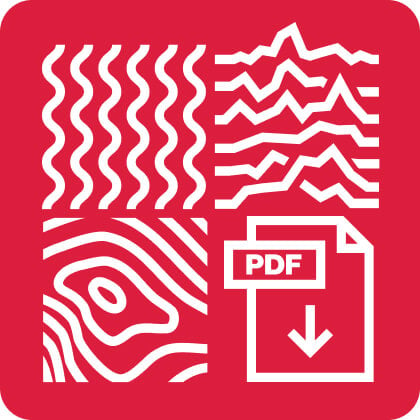
Meet your guide
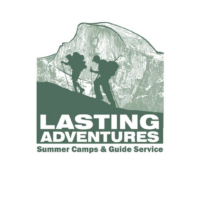
This is the second trip we took with Lasting Adventures and our second trip was just as great as the first. We had an amazing Guide, Caber. He was a true expert. Knew his way around even off trail and was an expert in the geology and fauna of the area. He let us go at the pace we needed while giving us inspiration to push the boundaries in a safe way. He was really good with my teenage son. We really couldn’t have asked for more and would definitely book another trip again.
I had one of the best backpacking experience with Lasting Adventures. Our guides, Nicole and Marina, were outstanding. They explained the overall plan the first day and helped us at every step. They were highly professional and an excellent guide.
Second year in a row doing a trip with Lasting Adventures. It was fantastic, even better then last year, and last year was pretty amazing. The guides were great, and we were lucky enough to have Dyson AGAIN, as our guide this year. Love how much I learned, how fun it was and overall, gave me some amazing time in nature.
Incredible adventure with the most amazing guide, Maddie! She was patient, informative, helpful and a blast to be with from start to finish. Maddie made our time together one we will never forget. I highly recommend considering Lasting Adventures for your next adventure. This is the first off the grid experience for me and I was truly blown away!
This was my fifth guided backpacking trip in the wilderness and by far the best. It’s all about the guides and Halle and Felicity were perfect: competent, easy to work with, smart and trustworthy. They set a perfect pace and didn’t “over teach” as some guides do. And the food! Pretty crazy that we could eat so well in the wilderness!
What you get on this adventure:
- An experienced, local hiking guide with extensive knowledge of the area
- 4 or 5-day backpacking adventure in Olympic National Park
- Backpacking permits
- All meals once you’re in the backcountry, as listed in the itinerary
- Single-person tents
- Sleeping bags & pads
- Trekking poles
- Eating utensils
- Group camping equipment
- Group cooking gear and water filtration
- First-aid kit
- Overnights at camping sites
- Insect repellant, toothpaste tablets, biodegradable soap, hand sanitizer, sunscreen, and toilet paper (if you require a unique type, bring only as much as you need for the trip)
What’s not included:
- Transportation to and from the meeting point
- Travel insurance — recommended
- Park entry fee
- Accommodation before and after the trip
- Guide gratuities — optional
The best thing about these Olympic guided backpacking trips is that they are open for beginner backpackers! However, even though no prior backpacking experience is necessary, you should actively engage in regular physical activities (such as hiking). Additionally, having a passion for the outdoors, exploration, and getting a little dirty are also good considerations. Depending on the adventure you choose, you’ll have 3 or 4 hiking days in a row, covering anywhere between 4 and 11 miles daily. Since there are no porters on these trips, you also have to be comfortable carrying a backpack weighing at least 20-25% of your body weight. Keep in mind that weather can vary greatly throughout the park and that it can be unpredictable. Still, summer is the best season for hiking with mostly pleasant, mild temperatures.
Sol Duc and the Seven Lakes Basin Tour and Hoh Rainforest and the Blue Glacier Tour are both considered strenuous. You can check out the more detailed map with elevation profile of the tentative itinerary for the Sol Duc and the Seven Lakes Basin Tour here , and for the Hoh Rainforest and the Blue Glacier here . The North Coast Backpacking Trip is considered a bit less challenging, and it’s rated as moderate to strenuous.
For more day-to-day details, mileages and elevation gains, check out the itineraries.
If you’d like to explore a larger area, check out this guided hiking tour of Mount Rainier and Olympic National Park .
Here’s a list of the equipment you need to bring:
- Water bottle or hydration bladder (2L capacity)
- Personal medication
- Headlamp or flashlight
- Camera — optional (but recommended)
- Cards, small games, book and other things for entertainment at the camp — optional
Here’s a list of clothing we recommend you bring:
- Lightweight hiking boots or shoes
- Camp sandals or shoes
- Underwear (synthetic preferred for hiking) and long underwearSpare clothes for layering
- Light waterproof rain jacket, fleece or wool jacket, and warm synthetic jacket for mornings and evenings
- Lightweight hiking pants and shorts
- Sunhat, beanie, bandanas/buffs, mosquito head net
- Swimwear, camp pillow and towel
Backpacks, sleeping bags, sleeping pads, trekking poles, camp pillows, bowls, mugs and sporks are all included in the price of the trip. If you have gear that you are comfortable using, it is recommended that you use your own gear.
Dress comfortably and for the weather in clothes you can move in. Plan on additional warm layers for trips in May and late September-October trips, as the weather can fluctuate and may be below freezing at night.
Everything is included in the price of the trip! Backpacks, sleeping bags, sleeping pads, trekking poles, camp pillows, bowls, mugs and sporks—it’s all taken care of, just let us know on time that you need it. Insect repellant, toothpaste tablets, biodegradable soap, hand sanitizer, sunscreen, and toilet paper are also included in the price of the trip.
If you have gear that you are comfortable using, it is recommended that you use your own gear. And if you require a unique type of toiletry items, bring only as much as you need for the trip.
Olympic National Park is home to a wide variety of wildlife. Raccoons, beaver, and mink live mostly in the lowlands, while deer, elk, cougars, and bears are to be found in valleys and mountain meadows. Despite their abundance, viewing wildlife is often a matter of luck and diligence.
Keep in mind that you’re a guest in the animals’ natural habitat, meaning that you must follow a set of rules—one of the Leave No Trace principles. You should observe wildlife from a distance, never feed them, never chase them, or disturb them for a better photo. As long as you respect them, no problems should arise. Carrying bear spray is not advised in Olympic NP—instead of it, make sure that you never leave food unattended and use a bear can if necessary.
Regardless of the local laws and policies, Lasting Adventures does not allow firearms on any of their trips. Participants who bring firearms will not be allowed to participate while in possession of their firearm.
You can expect excellent food throughout your backpacking trip in Olympic NP!
Typical breakfasts might include burritos, oatmeals, pancakes, dried fruit, bagels, etc. For dinner , your guides will prepare a variety of pastas, risottos, beans, couscous, meats, vegetables, etc. Lunch will consist of trail food with fruits, vegetables, pita, bagels, salami, cheeses, hummus, trail mix, energy bars, etc.
A variety of dietary choices (including, but not limited to vegan, vegetarian, peanut and/or tree nut allergy, lactose intolerant, celiac’s or gluten free, kosher) can be easily accommodated, just let your guides know in advance!
Group sizes and prices:
- For these backpacking trips in Olympic National Park, the usual client-to-guide ratio is 5:1. The average group size is between 5 and 10 people.
- The cost does not decrease as the group grows.
Backpacking in Olympic NP can be arranged for larger groups. Contact us to make arrangements.
Min. age requirements:
- If you are older than 18, you’re good to go.
- Minors younger than 18 may be permitted to join the hike on a case-by-case basis, but must be in the presence of a parent or legal guardian.
If your group has hikers under the age of 18, contact us prior to booking to make arrangements.
Depending on the tour you choose, the meeting point is either the Hoh Rainforest Visitor Center or Sol Duc Campground within Olympic National Park. To get there, the nearest airport is Seattle-Tacoma International Airport (SEA) . From there, renting a car is the easiest option to reach the meeting point and it will take you around 4 hours.
Regardless of which adventure you choose, you’ll meet your guide at the given point at 4 pm on Day 1.
57hours is committed to providing safe outdoor adventure experiences. We require all guides using our platform to have a COVID-19 safety plan and to make the details of that plan accessible to travelers. In most cases, group sizes will be reduced, guides will avoid overcrowded locations, and other safety measures will be met depending on the location and activity.
We also expect clients to respect local regulations and take measures to protect themselves, their guides, and the communities they’re traveling to. For more information on COVID-19 measures in Olympic NP, Washington, please refer to Washington’s COVID-19 travel status .
Please contact us if you have any questions or require further information. We are happy to provide you with the most up-to-date information
A 50% deposit to secure your place is due upon booking. The remaining amount is paid 1 month (30 days) prior to departure. If booking 45 or less days before departure, full amount is required upon booking. Once the trip is confirmed by the guide, the cancellation policy stated below applies.
- If Client cancels the Booking anytime prior to ninety (90) days in advance of the trip contemplated by the booking, Client is entitled to a full refund.
- For cancellations sixty-one (61) to ninety (90) calendar days in advance, Client is entitled to a full refund minus a $50 per-person processing fee.
- For cancellations forty-six (46) to sixty (60) calendar days in advance, Client is entitled to a refund lessened by twenty-five percent (25%) of total trip cost. Alternatively, Client may also take a non-refundable credit of the full value paid.
- For cancellations thirty-one (31) to forty-six (46) days in advance, Client is entitled to a refund lessened by 50 percent (50%) of total trip cost.
- After that deadline, Client is not entitled to any refund. Any reimbursable expenses arising out of the Booking incurred by Guide prior to the date of cancellation are non-refundable as soon as they are incurred by the Guide.
Other things to do in Washington
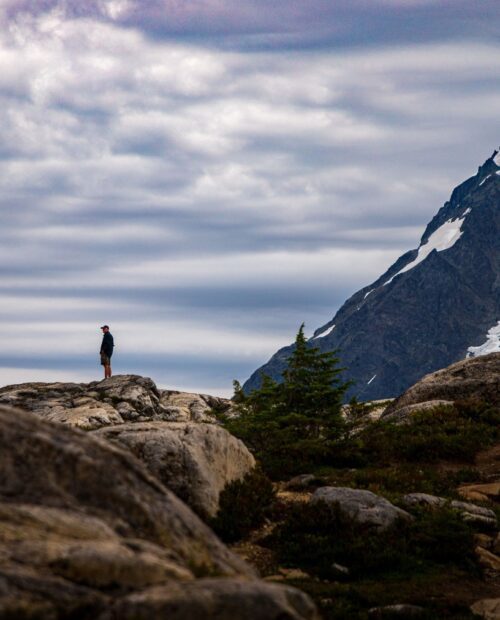
Light Backpacking in the North Cascades

Hiking in Mount Rainier and Olympic National Park
View all (19) adventures in Washington
Choose a currency
- USD - $ US Dollar
- EUR - € Euro
- AUD - AU$ Australian Dollar
- CAD - CA$ Canadian Dollar
- GBP - £ British Pound Sterling
- CHF - CHF Swiss Franc
- JPY - ¥ Japanese Yen
- SGD - S$ Singapore Dollar
- HKD - HK$ Hong Kong Dollar
- DKK - Dkr Danish Krone
- NOK - Nkr Norwegian Krone
- SEK - Skr Swedish Krona
This Scenic Olympic National Park Trail Takes Under An Hour To Hike
Marymere Falls Trail is an easy walk leading through ancient moss-covered rainforests to a stunning waterfall.
- The Marymere Falls Trail is a must-do for all ages, offering a 90-foot waterfall at the end of a scenic walk through lush forests.
- Washington State boasts numerous waterfalls and endless hiking opportunities, with this trail being a popular gem just a few hours from Seattle.
- Take the whole family for a leisurely 50-minute walk to the falls, or explore other trails nearby, such as the Mount Storm King and Spruce Railroad.
Marymere Fall Trail is the most popular day hike found at Olympic National Park's Lake Crescent and is counted among the easiest hikes in Washington's stunning parks and is one of the most beautiful hikes in Olympic National Park . It is a short hike running through stunningly beautiful old-growth forests to the 90-foot Marymere Falls.
The state of Washington is reputed to have the most waterfalls of any state , and it is bursting with fantastic hiking opportunities. The good news is if the Marymere Fall Trail whets the appetite for rainforest hiking, there are more excellent hiking trails branching off from it.
The Marymere Falls Trail Is The Most Popular Trail On Lake Crescent
The .9-mile one-way hike to the marymere falls is generally considered easy.
The Marymere Falls Trailhead is about 100 miles from downtown Seattle (a three-hour drive). As the crow flies, this part of the Olympic Peninsula is closer to Canada's Vancouver Island than Seattle. The trail is one of the most popular hikes in the region, thanks partly to its ease of access to US Highway 101 (and because of the beautiful waterfall at the end).
The Marymere Falls Trail is a 0.9-mile-long trail near Joyce, Washington. The trailhead is at the Storm King Range Station and can also be accessed at Lake Crescent Lodge. The Marymere Falls Trail is open year-round. This part of the PNW is very wet, so bring a raincoat. Dogs are not permitted on the trail.
It is generally considered an easy route and is a hike most families can easily manage. The trail is well-maintained and AllTrails states it takes around 49 minutes to complete the hike.
11 Things To Do In Olympic National Park: Complete Guide To Washington's Thrilling Hiking Region
Hiking the marymere falls trail to the waterfall, the marymere is an out-and-back trail through old-growth forest, but it does have a partially alternative return option.
Hike from the Storm King Range Station through the stunning old-growth forests for half a mile to the junction. From there, take the left path upstream beneath the canopy of conifers and maples. Don't rush to get to the falls, but take time to admire the sword ferns and carpets of moss of the forest floor and later ravine.
The trail continues towards Marymere Falls, crossing over Barnes Creek and Falls Creek before climbing 200 feet into the ravine. From there, the trail creates a loop with two viewpoints of the falls. The higher viewpoint looks down on the waterfall as it tumbles through a notch in the cliff. The lower platform offers a view from the bottom of the falls.
After viewing the waterfall, return the same way — although there is the option of taking the path along Barnes Creek at the first trail junction. This leads to Lake Crescent Lodge and passes through more of the forest's old growth. It links up with the 0.5-mile Moments in Time Trail (which also begins near the Storm King Ranger Station).
- Marymere Falls: 90 feet or 27 meters
The waterfall was named after Mary Alice Barnes, Charles Barns's sister (a member of the Press Expedition). The Press Expedition occurred in 1889 when Washington governor Elisha Ferry called for an expedition to cross the mysterious Olympic Mountains. The Seattle Press decided to answer the call and sponsored the Expedition.
10 Activities To Take Up In Olympic National Park In The Fall
Other great hiking trails at olypmic's lake crescent area, lake crescent has at least five great hiking trails to select from ranging from 0.6 miles to 3.5 miles.
Olympic National Park is a mecca for hiking in Washington and the National Park Service lists plenty of excellent day-hikes . The diverse national park offers a selection of coastal, rainforest, and mountain hikes. The trails range from a fraction of a mile to many miles and from easy to challenging.
Other notable hikes near Marymere Falls at Lake Crescent include:
- Moments in Time Nature Trail: A flat 0.6-mile loop trail at Lake Crescent Lodge
- Mount Storm King Trail: A 2.1-mile one-way trail leading off from the Marymere Fall Trail (it climbs 2,100 feet)
- Pyramid Peak Trail: A 3.5-mile one-way trail climbing 2,350 feet across a steep landslide area (starts near the North Shore Picnic Area)
- Spruce Railroad Trail: A 4-mile one-way hike along the lake great for dogs and bikes (there is also a 6.5-mile paved accessible extension leading west)
Olympic National Park needs a three-day itinerary to do it justice (there are many must-do attractions in the park). Visitors could spend a week or more just hiking the many breathtaking hikes in the national park and still want more.
- Share full article

Boots, Backpack and a Ubiquitous App
Fourteen years and one Apple App of the Year award in, AllTrails has become something rare: a tool that works for both experts and newbies.
Hikers with a group called Hike Clerb recently made their way through the Will Rogers State Historic Park in the Pacific Palisades area of Los Angeles. The club’s founder gave its inaugural class of hiking guides an AllTrails+ subscription to help with planning. Credit... Danny Duarte for The New York Times
Supported by

By Nikita Richardson
Nikita Richardson is an editor for New York Times Food and writes the “ Where to Eat: New York City ” newsletter.
- March 31, 2024
Close your eyes and imagine a stereotypical hiker. Do the words “rugged” and “built Ford tough” come to mind? Are they wearing khaki shorts? Is a tube attached to a CamelBak hanging from their mouth?
Whatever you imagined, that hiker is probably using the app AllTrails . In fact, just about everyone is. Even people who don’t know what a CamelBak is or who have no idea what the term “out-and-back” means. In the world of AllTrails, a hiker of any skill level is still a hiker.
Many of them find the app in the same way.
“Just through Googling, how to get into hiking, AllTrails would just come up a lot,” said Jessica Wood, who co-owns French Custard , an ice cream shop in Kansas City, Mo. “It’s a free app, so we were like, ‘We’ll download it and see what happens.’ We never deleted it.”

This is, of course, by design. What began in 2010 as an idea backed by a seed accelerator — Silicon Valley speak for an incubator program — quickly became a juggernaut that gobbled up many of its competitors. Three years later, AllTrails had raised nearly $4.5 million in funding. In 2018, previous funding rounds were eclipsed when the company raised $75 million.
Like so many pandemic-proof businesses, though, the app, which has details on hundreds of thousands of hiking trails all around the world, saw its star truly rise in the wake of Covid.
“Even prepandemic, we were still seeing really high rates of growth,” said Ron Schneidermann, who took over as chief executive of AllTrails in 2019. (The company’s founder, Russell Cook, departed in 2018.) “But during 2020, we suddenly saw triple-digit growth when there were lockdowns. There was nothing else to do.”
Ms. Wood, who described herself as “a brand-new hiker who had zero experience,” used AllTrails “almost every single day” in the summer of 2022 while she and her husband Alex waited out business permitting headaches.
“It really just made it feel like we had a professional hiker telling us how to hike,” she said, referring to the frequently updated trail reviews other users leave with details about a trail’s condition or whether it’s a safe place to bring animals or children.
“I would say my toxic trait is that I am a very avid reader of the reviews,” said Eva Jee, a food writer and restaurant professional in Denver. “If I’m planning a big hike, especially if it’s one where we’re going overnight in an area that I don’t know or a trail that I haven’t hiked before, I’ll scroll down, and I’ll read the last couple of weeks of trail reports.”
Ms. Jee, 41, says she will often use these reviews to determine what shoes to wear, whether a trail is well-shaded enough to forgo a hat, and what time of year is best to see the aspen trees change color or to take in the wildflower blooms.
“You can glean so much information,” she said.
Gabby Rumney, a 28-year-old project coordinator for the National Grocers Association Foundation in Philadelphia, said she turned to the app before and after hiking all 2,193.1 miles of the Appalachian Trail in 2021. (“That 0.1 really counts,” she added.)
“It was a good introduction to understanding trails and reading maps and understanding difference in terrain,” Ms. Rumney said.
And though she prefers the app FarOut for more challenging through-hikes like the Appalachian Trail or the Pacific Crest Trail, she said AllTrails is far more accessible to a wider range of hikers.
“I think with hiking there’s often this connotation that, ‘Oh, you have to be physically fit and have all this expensive gear,’” Ms. Rumney said. “Part of that is true because it makes things easier. But at the same time, you’re walking, and unless you have a disability that should be accessible to us all.”
At AllTrails corporate headquarters in San Francisco, the word “accessibility” comes up often. “A lot of people were coming to us or were interested in the outdoors, but they didn’t think of themselves as an outdoorsy person,” said Carly Smith, who joined the company in 2021 as its chief marketing officer.
Ms. Smith arrived in the wake of two major milestones at AllTrails: In January 2021, the company reached one million paid subscriptions to AllTrails+, which allows users to download maps for offline access, among other features. (Trail maps and basic aspects of the app’s search function remain completely free.) And in November of that year, AllTrails announced that it has secured $150 million in additional funding.
Under Ms. Smith’s supervision, AllTrails has become sleeker, more lifestyle-y. Where hikers were once offered the chance to “ find your next favorite trail ,” they’re now invited to “find your outdoors.” In the app, users can see their stats for the year and track the time it took them to complete a hike using an interface that’s not so different from fitness apps like Peloton or Strava.
Now redesigned to appeal as much to your Gen Z cousin as to your crunchiest, outdoorsy uncle, AllTrails was named Apple’s 2023 app of the year for nurturing “community through comprehensive trail guides and outdoor exploration for everyone.”
“In software development, there’s not a lot of awards ceremonies,” Mr. Schneidermann said. “This feels like our Pulitzer Prize.”
And like any 21st century company, AllTrails has doubled down on expanding its network of brand ambassadors and influencers. During Black History Month, for instance, the company unveiled a clothing and accessory collaboration with three Black artists in support of the nonprofit Vibe Tribes Adventures . In March, AllTrails highlighted products from six women-led brands.
Evelynn Escobar, the founder of the nonprofit Hike Clerb , said she had recently been in contact with AllTrails for a potential partnership. Though she doesn’t credit AllTrails with introducing her to the pleasures of hiking — that honor belongs to an aunt who took her hiking in and around L.A. as a child — the app is “at the core of my outdoor lifestyle,” she said. “I build my hikes off what I’m finding on there.”
Accordingly, Mrs. Escobar provided each member of Hike Clerb’s inaugural class of hiking guides with an AllTrails+ subscription, so they can better plan their hikes, which cater predominantly to “Black, brown and Indigenous women, and gender-expansive people.”
“The outdoors are still such a homogeneous space,” Mrs. Escobar said, citing her first trips to Zion National Park and the Grand Canyon. “I noticed that in these literal hubs of outdoor recreation, it’s still nothing but white people out here.”
But if AllTrails has its way, the national parks system could soon be filled with its younger and more diverse user base. In March, the company unveiled its Public Lands Program , a partnership with land managers at 270 parks across the U.S. that allows them to access real-time data about trail activity and also to send out real-time alerts about trail conditions to AllTrails users. Participation in the program is free of charge.
According to AllTrails, a 2023 pilot test with Olympic National Park in Washington resulted in a 66 percent decrease in search and rescue incidents on two of the park’s most popular trails and a 62 percent decrease in such operations across all the park’s trails compared with the previous year.
Directly connecting park rangers to users might also help avoid negative press, such as an incident last fall when SFGate reported that AllTrails was giving users directions to a treacherous tourist attraction on the Hawaiian island of Kauai that had been closed for more than a month. In response, the company encouraged users to “help us maintain accurate and up-to-date trail information by suggesting edits or leaving reviews.”
AllTrails relies on users not only for edits and warnings, but also for advice on adding trails. The company’s “data integrity” team researches and then approves or rejects the suggestion. “We’re going to run everything through a whole layer of machine learning, computer vision, validation first, and then it goes through a whole level of human curation before anything,” said Mr. Schneidermann, though he readily admitted that the outdoors are, by their nature, prone to change.
“Once a trail goes live on our site that doesn’t mean that it’s static, that it’s just going to be that way forever,” he added.
Just like the trails themselves, hiking habits can change over time. Some think that involves eventually moving away from AllTrails — and venturing out on your own.
“If I were in the shoes of someone whose beginner hiking experiences were through AllTrails, I would say that it’s absolutely worth trying to wean off,” said Ryan Tripp, a 21-year-old environmental engineering student at Dartmouth College who grew up hiking near his home in Oakland, Calif., and has led his own hiking trips.
“I wouldn’t necessarily say turn off your phone, turn off everything and just go into the woods,” he continued, “but I think a progressive shift away has the potential to be really rewarding and to expose people to what I think are the benefits of being outside,” like the feelings of self-sufficiency and independence.
“Technology will continue to creep into the outdoors,” Mr. Tripp said, citing the ongoing debates over whether cellphone service and infrastructure should be expanded in national parks.
But Mr. Schneidermann insists that AllTrails is strictly on the side of the outdoors, even if users are looking at their phones rather than weatherworn trail signage. He no longer sees other hiking apps as his competition and is focused instead on being an alternative to tech companies like Facebook and TikTok.
“There are these incredibly strong, well-fortified companies pulling in some of the best minds out there, you know, designed to keep people behind the screen, inside all day” he said. “And obviously, we’re the anti-Metaverse.”
Nikita Richardson is an editor in the Food section of The Times. More about Nikita Richardson
Exploring the Outdoors, One Step at a Time
Hiking is a great way to immerse yourself in nature and tune out the chaos of city life. the tips below will help you get ready before you hit the trail..
Hiking offers a host of mental and physical benefits. If you’re new to it, here’s how to get started .
Fourteen years and one Apple App of the Year award in, AllTrails has become something rare: a tool that works for both experts and newbies .
Make sure you have the right gear . Wirecutter has recommendations for anything you might need — from hydration packs to trekking poles . And remember to try on hiking boots at the right time of the day .
These clever apps and devices will help you to find your way, triage an injury and generally stay out of trouble on the trail.
Planning to venture out for a nighttime hike ? Opt for wide, easy-to-navigate paths.
Experts say failing to alert family or friends of your plans is one of the biggest mistakes hikers make. Here are some more safety tips .
Advertisement

The 11 best National Parks for backpacking
Posted: July 13, 2023 | Last updated: July 17, 2023
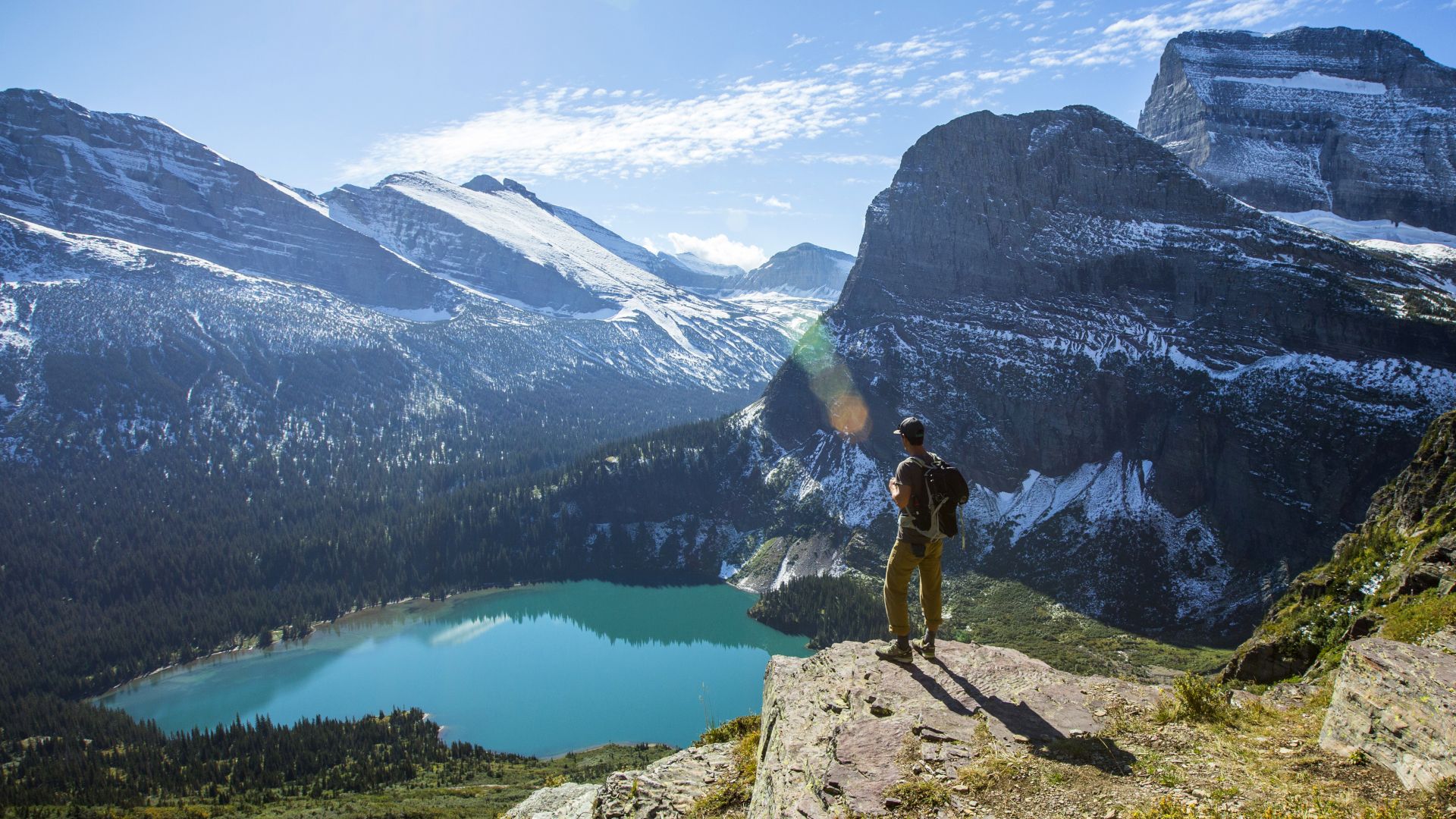
The 11 best National Parks for backpacking offer a multitude of wilderness escapes from crowded paths into remote interiors and across long, serpentine trails
America’s National Parks easily offer some of the most magnificent hiking terrain on the planet, and for that reason, they’re not always the quietest of places. For those of you with strong legs and a keen sense of adventure, we’ve compiled this list of the best National Parks for backpacking, where you can escape the most popular trails and enjoy some of the most wild and wonderful sights anywhere.
The best National Parks for backpacking take you from lush coastal rainforests and world-famous canyons to one of the highest peaks in the country. Some are easily accessible by road while others are extremely remote. Backpacking in National Parks always requires a wilderness or backcountry camping permit, and the process for this varies according to the park, so it’s best to check ahead and plan your trip well in advance to avoid disappointment.
Each park on our list has abundant backpacking opportunities, from linking up shorter day hikes as you travel between different campsites to epic treks along serpentine long trails, and while we’ve noted some of the most spectacular trails in each park, there are plenty more to choose from. Dust off your sturdiest hiking boots, load up your best backpack and lightest tent, and check out the best National Parks for backpacking.
By Julia Clarke
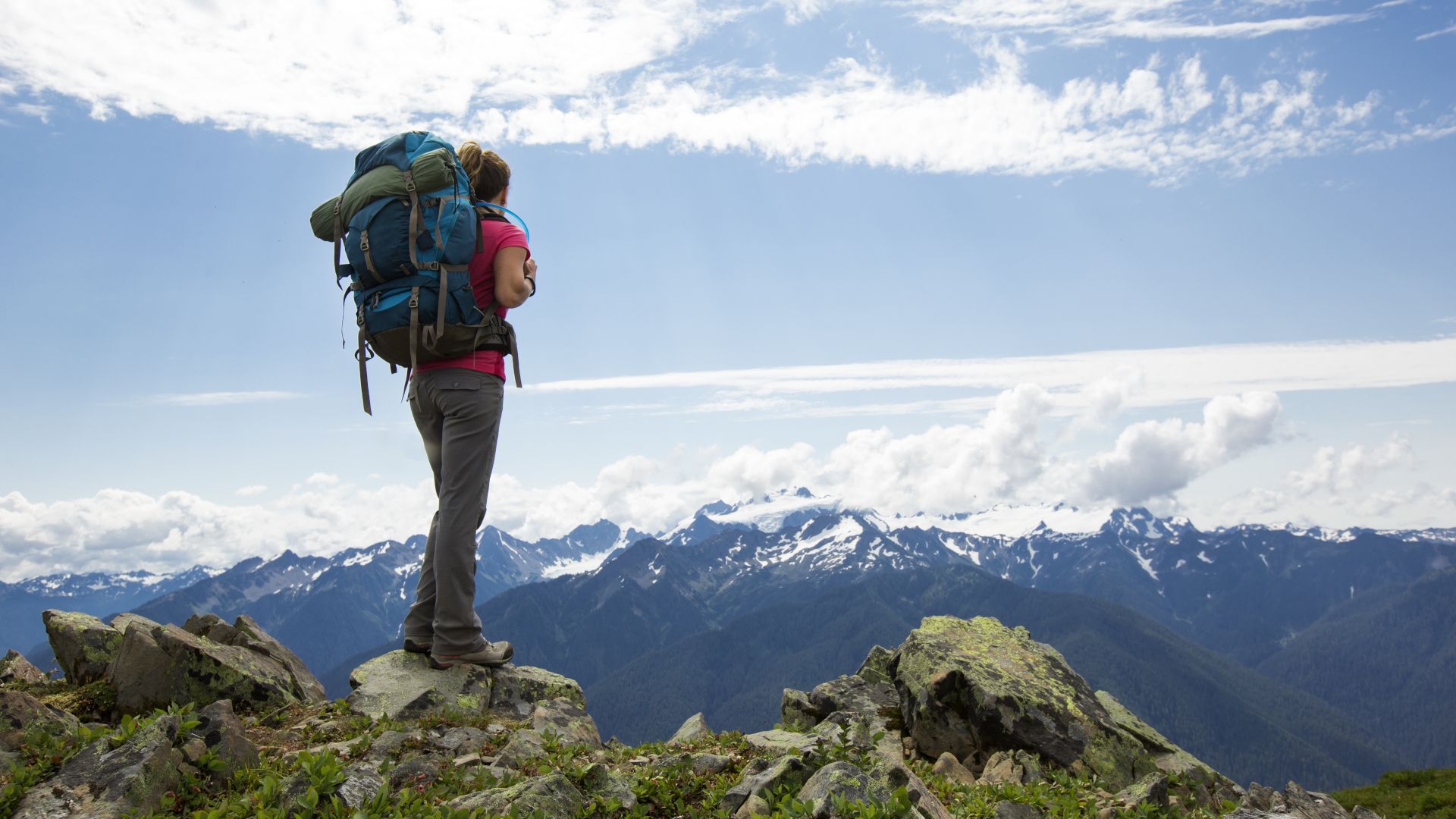
1. Olympic, Washington
Few if any of America’s National Parks offer as diverse a landscape as Washington's Olympic National Park, which protects a vast wilderness on the Olympic Peninsula and boasts three distinct ecosystems. Olympic National Park has four regions each with a distinct flavor. To the west are temperate old-growth rainforests, and to the drier eastern side are pine forests. The Pacific coastline region protects 70 miles of rocky shoreline and the alpine area has high snow-capped peaks offering views of the Olympic interior.
There are few roads in the park’s interior and the best way to discover it is on one of their heart-stopping wilderness trails. In the southwest portion of the park, the Hoh River trail is a 34-mile out-and-back canopied trail that winds along the river from the visitor center all the way to Glacier Meadows and you can experience abundant giant ferns and moss thanks to the 12 feet of rain this area receives on average each year.
For rugged beaches and rocky cliffs framed by coastal forest, head to the Olympic coast where you can hike for miles. It’s about 20 miles from Shi Shi Beach to Rialto Beach, one of the most iconic – and photographed – spots in the park, where you’ll find a rocky shoreline, glistening rock pools and rugged sea stacks. You’ll need to be prepared for beach camping and understand how to read a tide chart, but there are few experiences on the planet quite like hiking this trail.
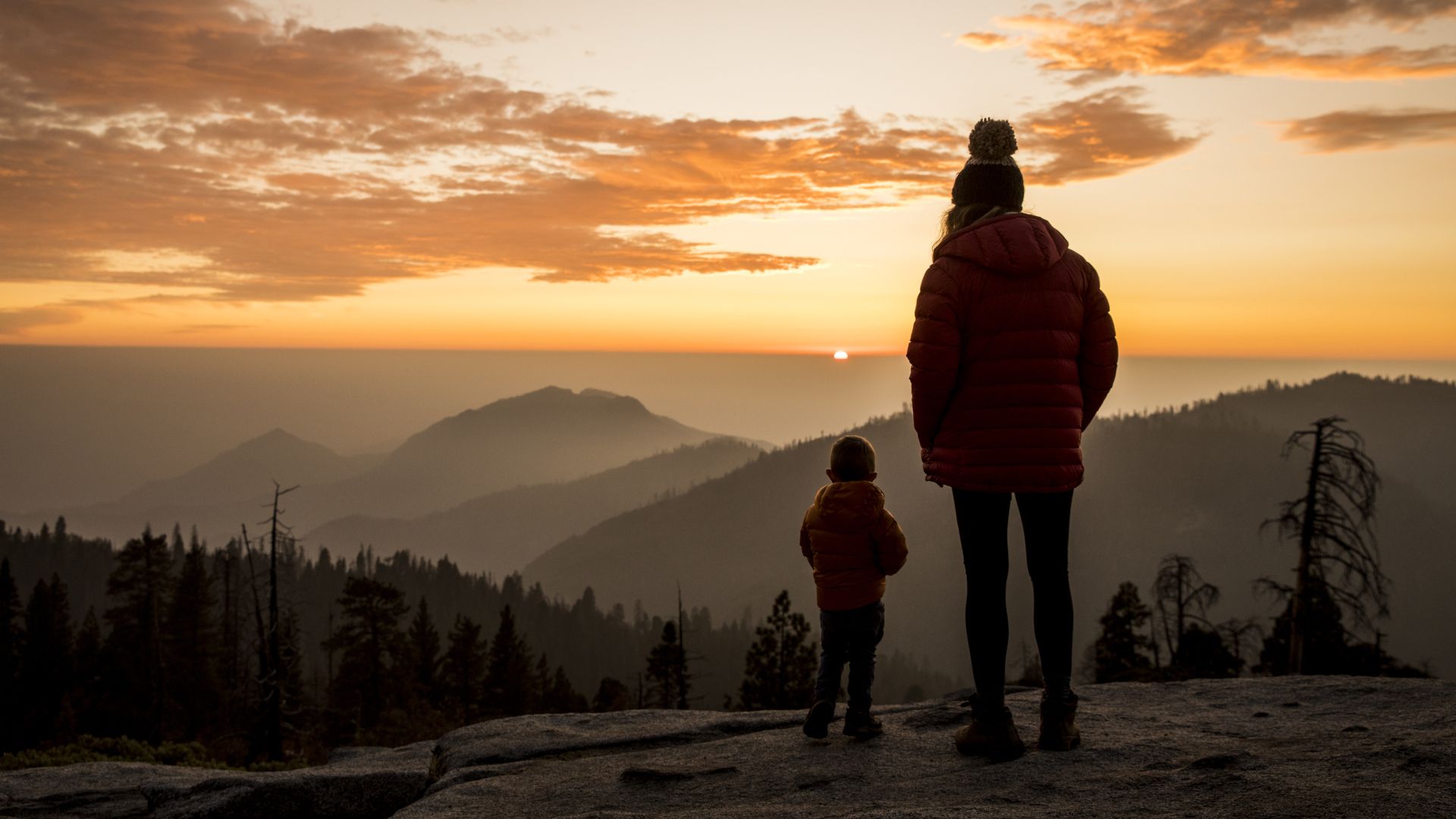
2. Sequoia and Kings Canyon, California
Sequoia and Kings Canyon National Park has a lot to boast about. Nestled in the Sierra Nevada mountain range, it is home to the tallest mountain in the contiguous United States, Mount Whitney, as well as the largest tree on earth. The vast majority of this park is wilderness and the only way to explore it is on foot. With over 800 miles of hiking trails, you won’t be disappointed whether you’re seeking high alpine wonders or lush treks through deep canyons.
The High Sierra Trail is a 72-mile trail covering the highest elevation in the park – and in fact, the Sierra Nevada – and takes you over the Great Western Divide to the Kern River drainage and to the summit of Mount Whitney. If that isn’t enough for you, it eventually connects to the John Muir Trail and the Pacific Crest Trail so you can keep going for months of the backpacking bug really bites you.
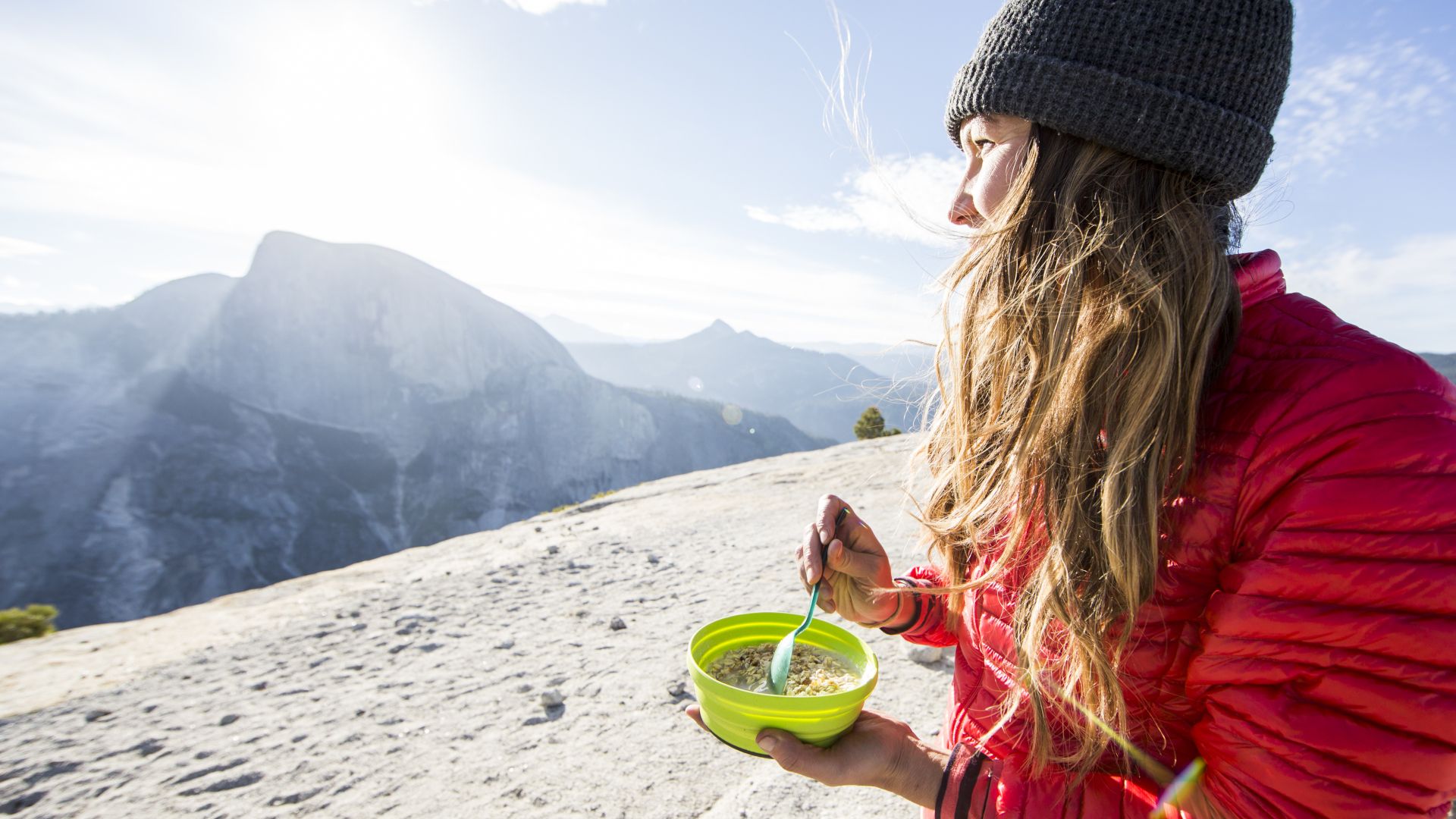
3. Yosemite, California
At the heart of Yosemite National Park, Yosemite Valley cuts 3,500ft deep into the earth and is walled by massive granite summits like El Capitan and Half Dome. Yosemite sits on the western slope of the Sierra Nevada mountain range in California, so it boasts plentiful high country, but most of the park’s main attractions lie deep in two valleys carved out by Tuolumne River, which leads to the gorgeous Tuolumne meadow at the foot of the El Capital, and the Merced River which forms Yosemite Valley. Its tributaries are responsible for plunging waterfalls like Yosemite and Bridalveil.
Incredibly, all of this is just a four-hour drive from San Francisco, which explains why it’s also one of the busiest National Parks in the country. However, the majority of the visitors are down in the valley and you can escape the crowds with a backpacking permit and head on a multitude of exhilarating adventures. Hike Half Dome or walk on part of the John Muir Trail or the Pacific Crest Trail, both of which run through the park. You can also head up to the high country from Tuolumne Meadows or, for the best views of the park’s main features without the crowds, hike south from Tioga Road.
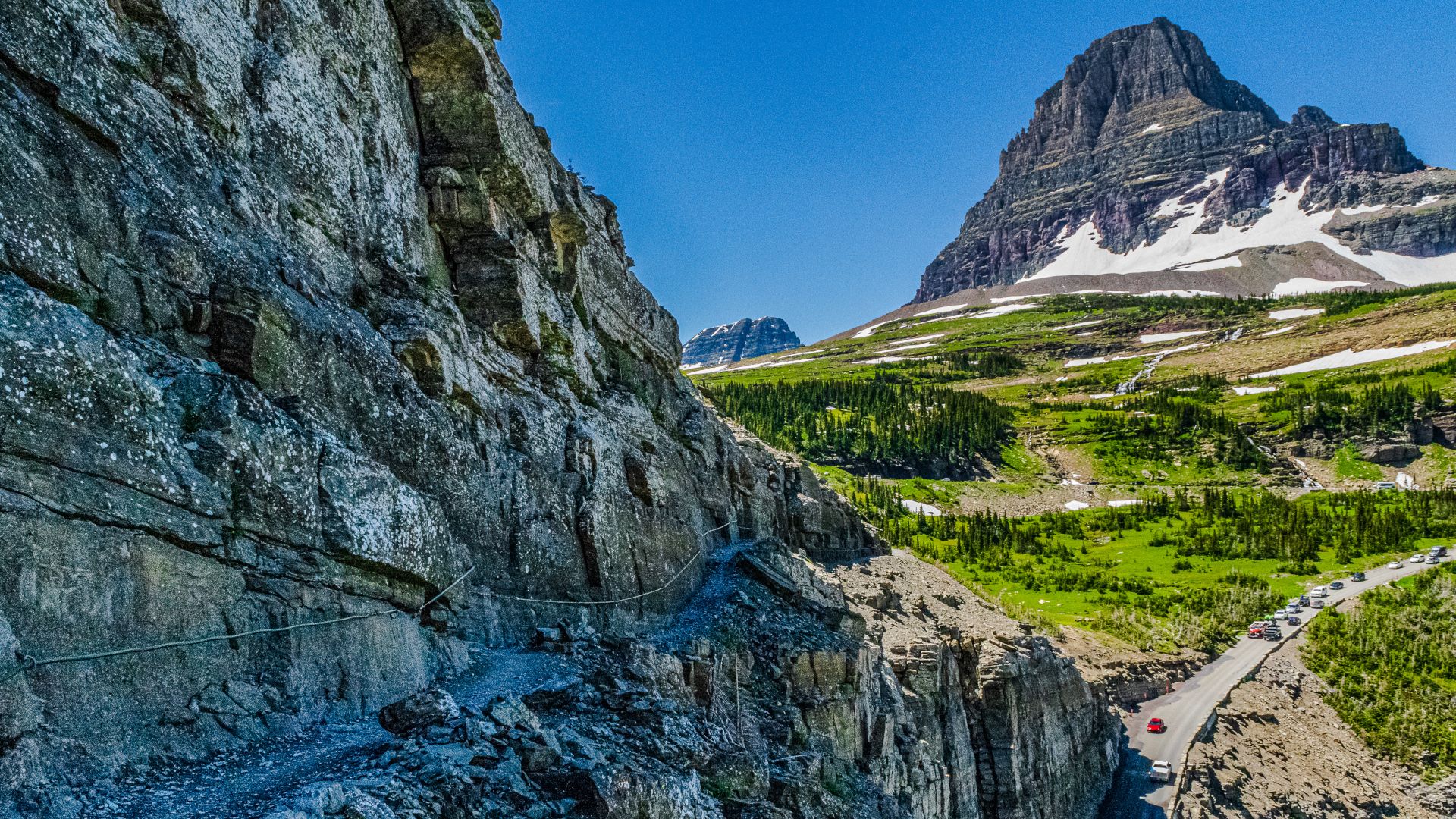
4. Glacier, Montana
With over 700 miles of hiking trails and 65 backcountry campgrounds, Glacier National Park offers stupendous backpacking, from vast, glacier carved valleys to rugged peaks. Glacier covers over 1500 square miles of largely untouched wilderness where native species of plants and animals thrive, including 700 lakes and hundreds of waterfalls. Set in Montana’s Rocky Mountains all the way up at the northern border, and surrounded on all sides by National Forests, Indian reservations and Canada’s Waterton National Park, Glacier is a true paradise for anyone seeking solitude in the wilderness, and awesome wildlife viewing from imposing grizzly bears to timid mountain goats.
If it’s wildlife sightings you’re after, head for the epic 65-mile North Circle Loop, which takes in some of the park’s best features including the Highline Trail, Stoney Indian Pass, the Ptarmigan Wall and Ptarmigan Tunnel, the Many Glacier area and Piegan Pass. For a shorter adventure, Gunsight Pass is only 20 miles but delivers glaciers, snowfields, crossing the suspension bridge of St Mary river and of course, views for days.
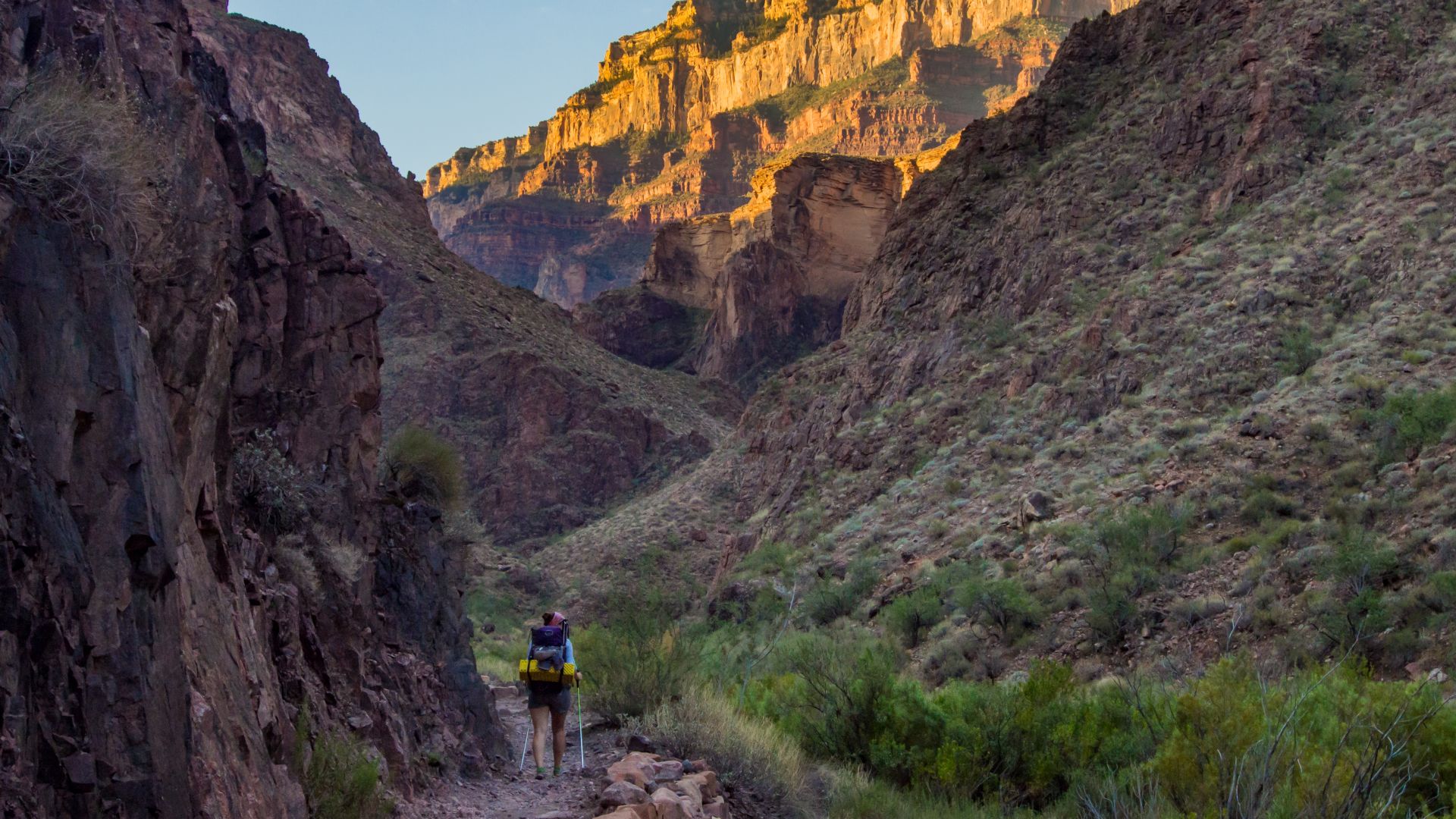
5. Grand Canyon, Arizona
Grand Canyon National Park is 277 miles long and up to 18 miles wide, making it one of the biggest canyons in the world. It is located in Arizona and is about a three-and-a-half hour drive from Phoenix, four-and-a-half from Las Vegas. This iconic spot is easily one of the most photographed places in the world, but there’s nothing quite like standing on the canyon rim and taking it all in with your own eyes. The canyon was carved by the Colorado River on its journey from the Rockies to the Gulf of California, though at over a mile deep you can rarely see it. You can, however, hike down to it, which is a serious – but unforgettable – endeavor.
The Bright Angel Trail begins just west of the Bright Angel Lodge and descends 4,380ft to the river over ten miles of desert hiking with an average grade of 10%, and when you get to the bottom, there isn’t an elevator ride back to the top. With a camping permit, you can turn this into an unforgettable overnight trip. Alternatively, the North Kaibab Trail is the only maintained trail into the canyon from the North Rim, beginning about two miles north of Grand Canyon Lodge with delightful views, waterfalls and plenty of physical challenge.
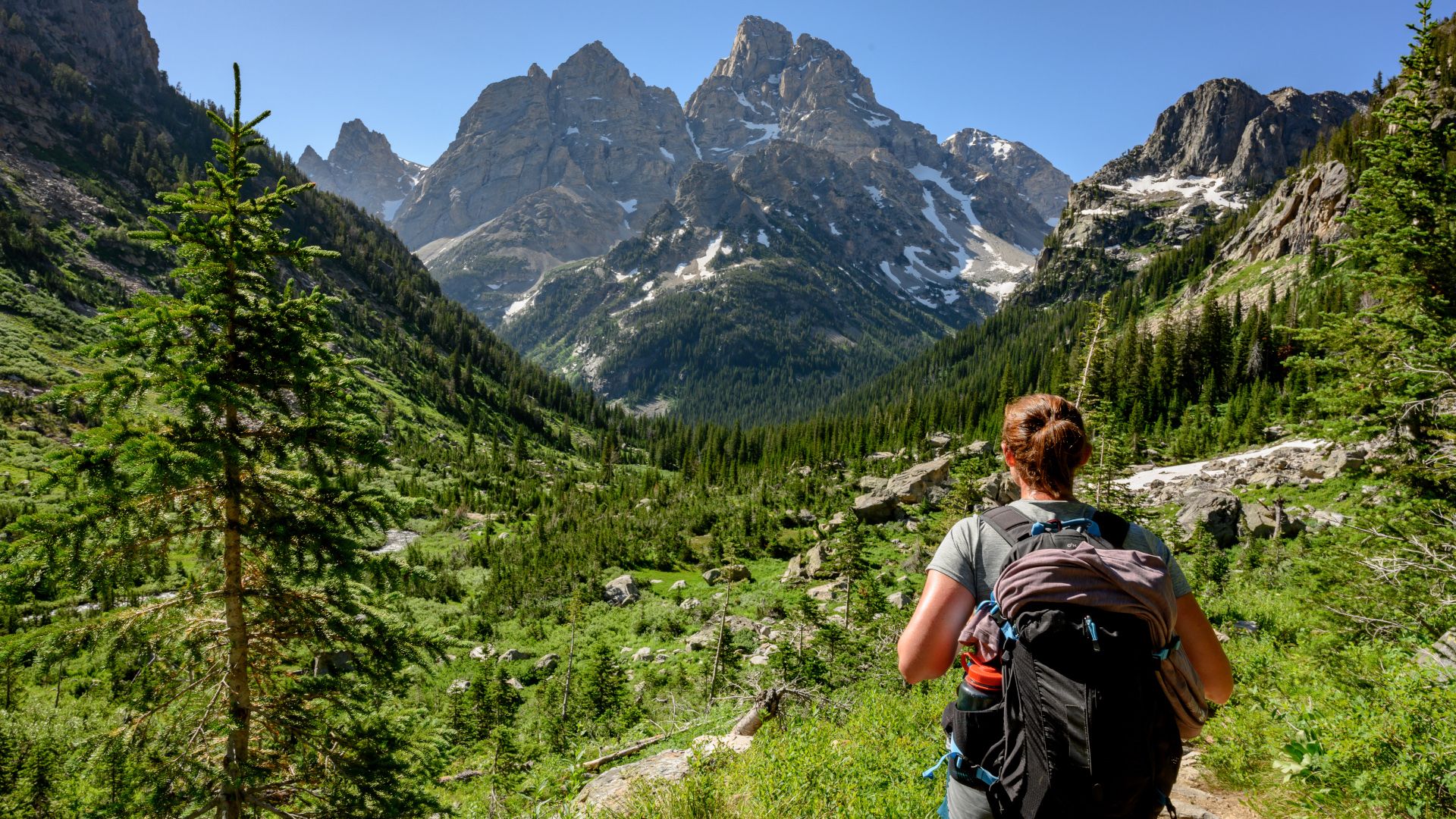
6. Grand Teton, Wyoming
Just thirty miles south of Yellowstone, Grand Teton National Park centers around the extraordinary 40-mile Teton mountain range which forms a distinctive jagged horizon that’s unlikely any other mountain range. The near-pristine ecosystem of the park is home to wildlife and flora that can be traced back to prehistoric times and dotted with crystal clear lakes and rivers.
Hundreds of miles of hiking trails provide access to backcountry camping areas, and the Teton Crest Trail is undeniably the best backpacking experience here. Stretching for up to 45 miles, depending on your route, this high alpine trail rarely drops below 8,000ft as it winds through the Jedediah Wilderness Area, Bridger-Teton and Caribou-Targhee National Forests as well as the park.
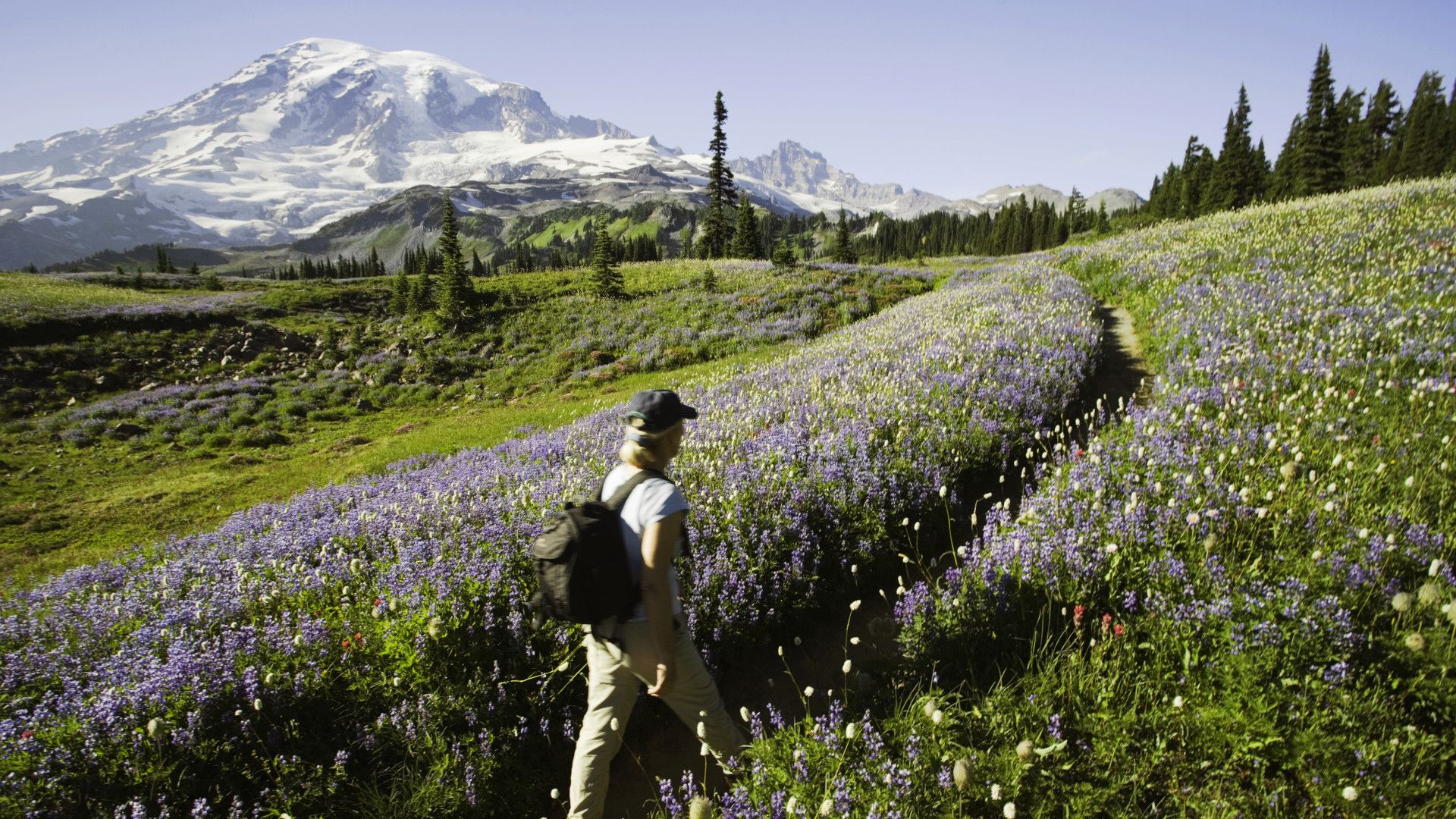
7. Mount Rainier, Washington
Just 45 minutes from Seattle, Mount Rainier dominates the surrounding landscape with its hulking 14,410ft of elevation. This active volcano is the most glaciated peak in the country and the source of five major rivers so it’s no doubt the crown jewel of the park, which has several distinct sections: Paradise, which is known for its wildflower meadows, Sunrise, which at high elevation offer spectacular views of Rainier, Ohanapecosh and Carbon River which boast old-growth rainforest and Mowich Lake.
Climbing Mount Rainier itself is a serious pursuit, with over 9,000ft of elevation required over nine miles. However, there are lots of other terrific trails to be had here, including the Wonderland Trail which encircles the mountain over 93 tough miles that wind from wildflower-blanketed lowland valleys to alpine terrain.
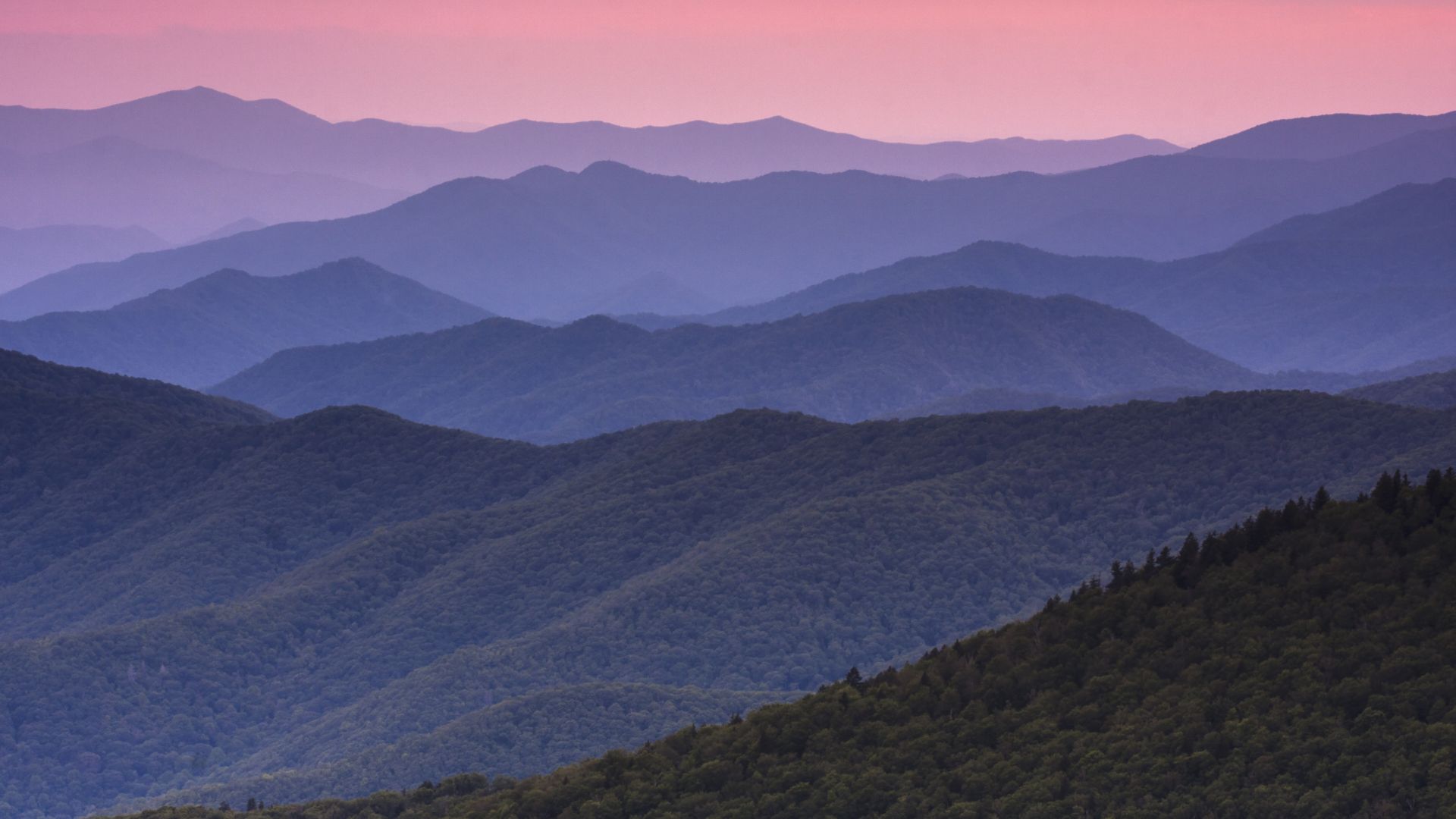
8. Great Smoky Mountain, North Carolina and Tennessee
Straddling the border between North Carolina and Tennessee, the sprawling Great Smoky Mountains National Park houses endless acres of lush old-growth forests, cascading waterfalls, rocky bluffs and ancient mountains. Great Smoky Mountains is the most visited National Park in America, giving you all the more reason to get a wilderness permit and head off piste to explore the backcountry.
With over 800 miles of hiking trails to choose from, you can take your pick, but a you’ll find a fine long walk in the 71-mile stretch of the world-famous Appalachian Trail which stretches through the park from Fontana Dam to Davenport Gap, taking you over Clingman’s Dome and passing Charlie’s Bunion and Rocky Top.
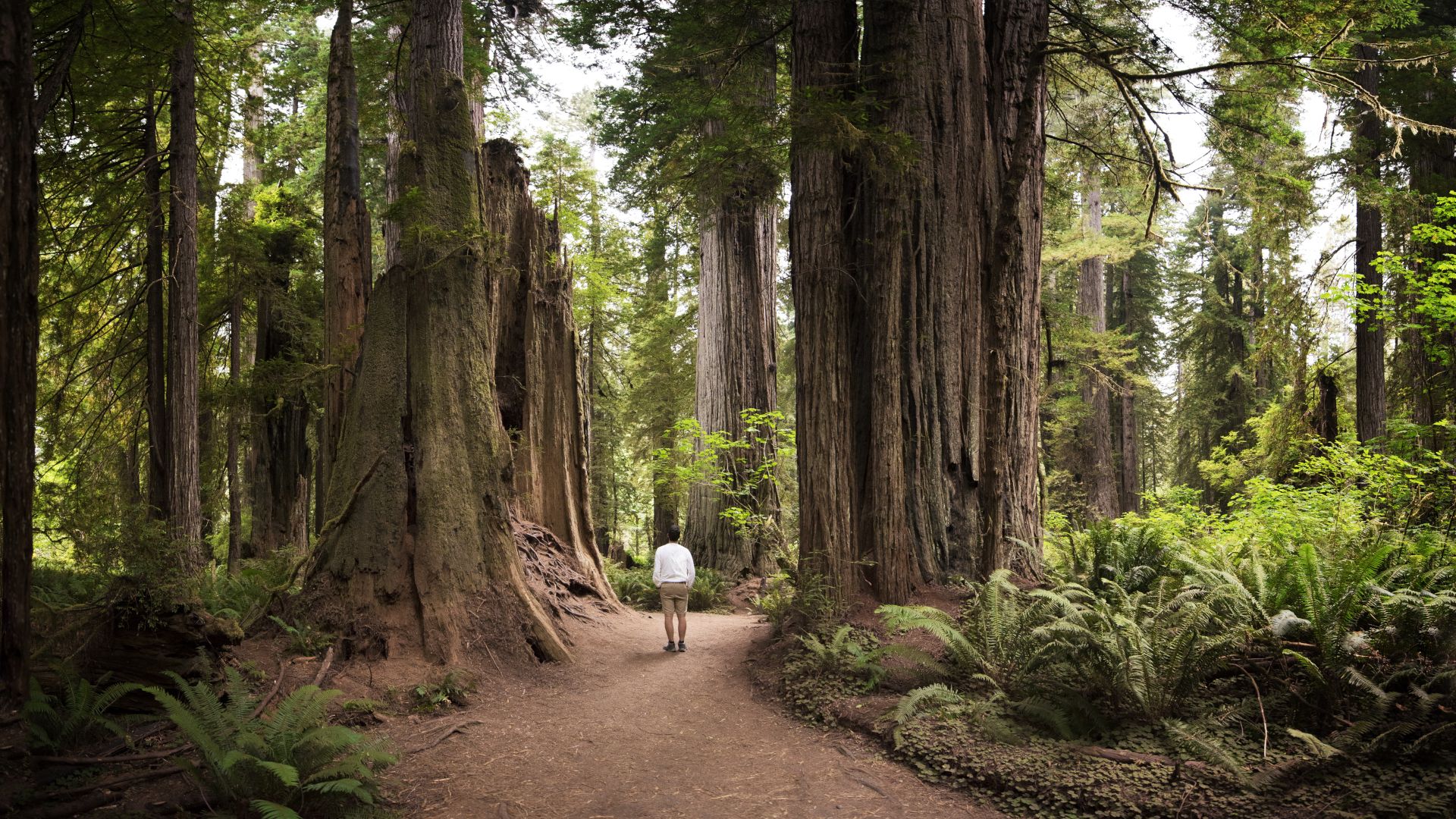
9. Redwood, California
Redwood National Park is located in northern California, close to the border with Oregon, and encompasses about 139,000 acres and protects almost half of all remaining old-growth coastal redwoods. Coastal redwoods are an evergreen tree that lives 1,200 to 2,200 years or longer and reach up to 379 ft in height and 29ft in diameter. These trees are also among the oldest living organisms on Earth. Discover rare solitude in almost any hike in Redwood National Park, which is far from any population center.
On the hiking trails here, you can wander among temperate rainforests, ancient fern-lined canyons, waterfalls and even along rugged coastline. A couple of trails such as the James Irvine Trail and Redwood Creek trail can be done in one long day, but they make for delightful overnights.
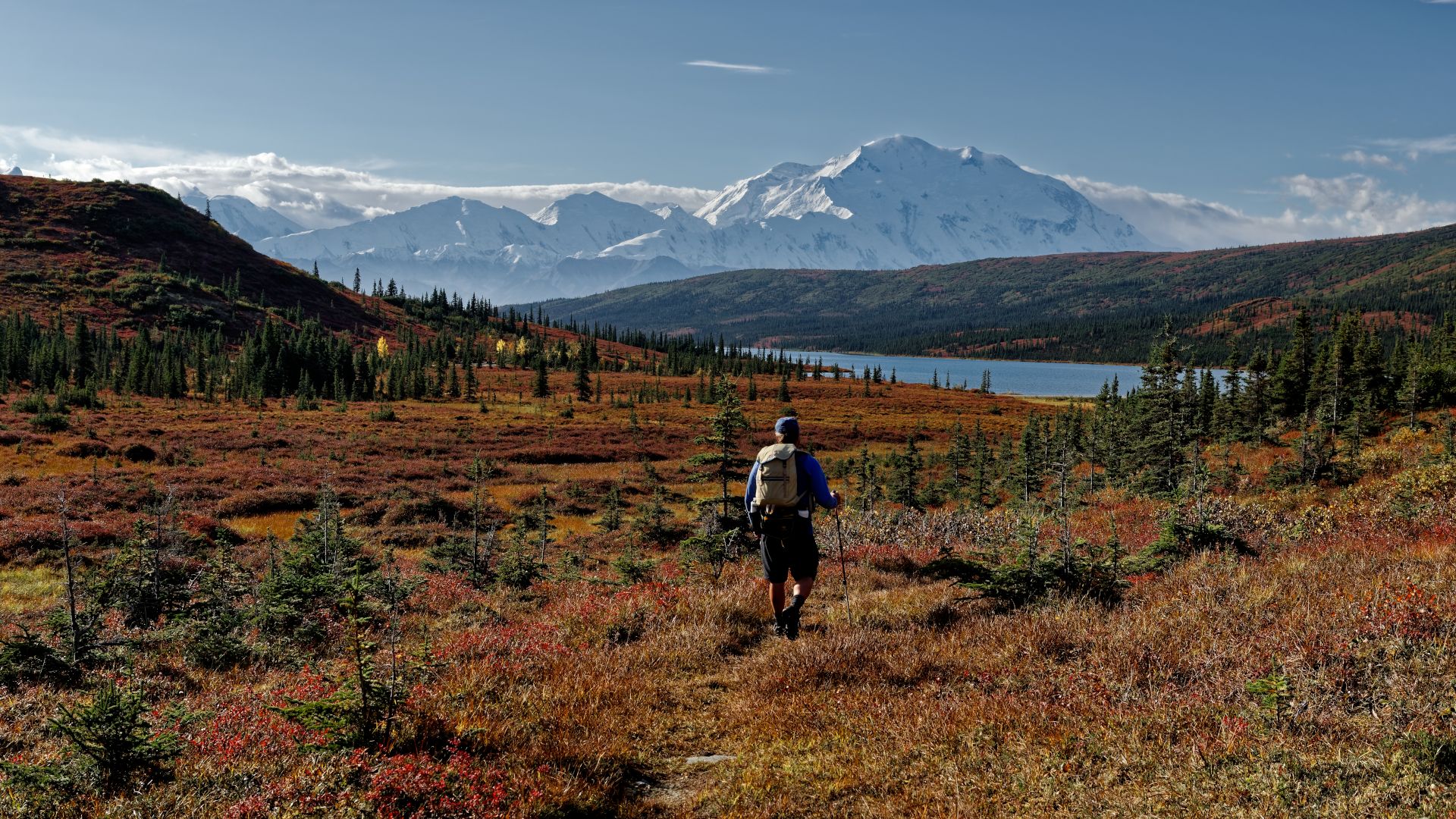
10. Denali, Alaska
Denali National Park preserves North America’s highest mountain in addition to an astonishing six million acres of surrounding wilderness in Alaska’s interior. The terrain encompasses tundra, glaciers and forests and abundant wildlife over an area about the size of the state of Vermont.
However it doesn’t have many established trails at all, despite being popular for hiking and mountaineering, and backcountry permits are only issued in-person, so the best approach is to check in with the park rangers about your plans when you arrive, know how to read a map and bring a compass and a keen sense of adventure.

11. Isle Royale, Michigan
Isle Royale is an island in the middle of the enormous Lake Superior that you can only reach by boat or small plane and is only open from April to October. The island is 45 miles long and 9 miles wide and surrounded by 400 smaller islands. A three-hour ferry ride gets you to this rugged island where you can explore some 170 miles of hiking trails, which visit pristine shoreline, swamps, boreal forests, glacial lakes and several small mountains.
Several long trails exist here, including the Greenstone Ridge Trail which takes you from one side of the island to the other over 40 miles, the 30-mile Feldtmann Loop Trail, or you can circumnavigate the entire island which takes about two weeks.
More for You
Family push for daughter's removal from hospital
Joe Biden Announces Major Student Debt Cancellation—Here's Who Qualifies
Opinion | Pope Francis Shuts Down the Cafeteria
13 McDonald's Menu Items From The 1990s You Probably Forgot About
The ripeness of a banana could affect your health
I moved from California to Tennessee for my husband's job. We can finally save money, but it's been a major culture shock.
Immortal TV Characters: The 25 Most Legendary Figures
Dam Starts to Leak After 60-Foot Crack Sparks Urgent Warning
Why Do People Add Plywood Under Their Countertops, And Do You Need To Do It?
The 26 Most Dangerous Cities in the U.S. Ranked
IRS used AI to access bank accounts of US citizens: Rep. Harriet Hageman
This type of supplement may increase heart disease risk, new study finds
I left Silicon Valley for a dream job in Chicago. I wasn't prepared for how crushing the loneliness could be.
Excellent used cars to buy today from just $1500
12 Concealed Kitchen Storage Hacks You’ll Want to Use Immediately
AT&T emails 70M customers, causes massive traffic spike at Experian. Here's what happened
Department store closes its doors after 201 years
What Happens to Your Body When You Eat Blueberries Every Day
A major Burger King franchisee in California says he can't roll out order kiosks fast enough due to the state's new $20 fast-food minimum wage
These are the 10 worst U.S. states to live in for your mental health, according to a new study
2-FOR-1 GA TICKETS WITH OUTSIDE+
Don’t miss Thundercat, Fleet Foxes, and more at the Outside Festival.
GET TICKETS
BEST WEEK EVER
Try out unlimited access with 7 days of Outside+ for free.
Start Your Free Trial
Powered by Outside
Best Hikes in Oregon’s National Park and National Monuments
Oregon guidebook author matt wastradowski explores the best hiking and backpacking in oregon’s national parks and national monuments..
Heading out the door? Read this article on the new Outside+ app available now on iOS devices for members! >","name":"in-content-cta","type":"link"}}'>Download the app .
Oregon is home to a rich variety of scenic ecosystems. This diversity is showcased in the state’s sole national park and a handful of national monuments. Crater Lake National Park, for instance, showcases the brilliant blue hues of the deepest lake in North America. The John Day Fossil Beds National Monument takes hikers through alien hillsides covered in colorful clays and into the heart of ancient rock formations.
Each of these outposts has hiking trails that offer up-close glimpses of the scenery and sweeping views of the surrounding landscapes. Here’s a guide to some of the best hikes in Oregon’s national parks and monuments, as well as ideas for camping nearby.
Best Hikes in Crater Lake National Park

Roughly 7,700 years ago, Mount Mazama erupted in modern-day southern Oregon, eventually collapsing in on itself and filling with rainwater and snowmelt. Today, that pristine lake is the heart of Crater Lake National Park —Oregon’s only national park.
Perhaps the park’s best-known hike is the descent to Cleetwood Cove. Visitors can take a boat tour to Wizard Island near the lake’s western shore, disembark, and hike to the craggy summit (known as the Witches Cauldron). Doing so gives hikers 360-degree views of Crater Lake and showcases the many peaks beyond its shore. The two-part hike totals about five miles (round-trip) and 1,200 feet of elevation gain.
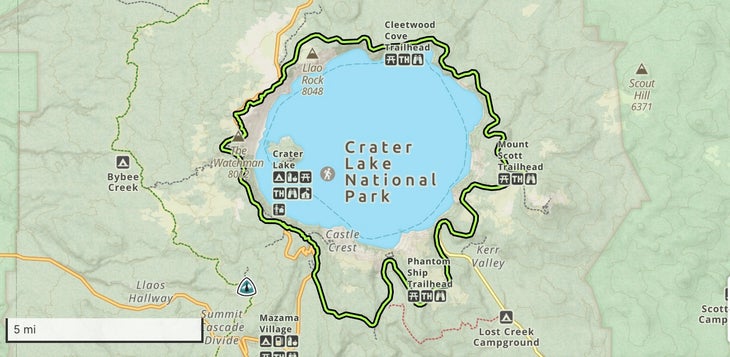
Backpackers, meanwhile, can choose among several outings (including some that follow a portion of the Pacific Crest Trail) and stay at one of a few backcountry campsites . One iconic excursion: The 33-mile, three-day circumnavigation of Crater Lake .
If you’re looking to pitch a tent, Mazama Campground hosts more than 200 tent and RV sites just inside the park’s southern boundary.
Best Hikes in the John Day Fossil Beds National Monument

Three disparate units comprise the John Day Fossil Beds National Monument in eastern Oregon.
The Painted Hills Unit is the monument’s most popular destination; there, hikers can choose among five footpaths that collectively total just less than three miles (round-trip). The 1.7-mile (round-trip) Carroll Rim Trail gains about 260 feet while offering top-down views of the surrounding hillsides—many of which are covered in vibrant red, yellow, black, and golden clays. Refrain from walking on the Painted Hills since your footprints may remain for several years before eroding.
For more hikes in the monument, check out the 3.25-mile (round-trip) Blue Basin Overlook Trail and the 1.3-mile (round-trip) Island in Time Trail in the Sheep Rock Unit ; both paths offer views of a rugged canyon whose rocks have a greenish blue hue.
Staying the night? The Ochoco Divide Campground , open mid-May to mid-October, sits 30 minutes from the Painted Hills Unit and one hour from the Sheep Rock Unit; its 25 sites are available on a first-come, first-served basis.
Best Hikes at the Oregon Caves National Monument & Preserve
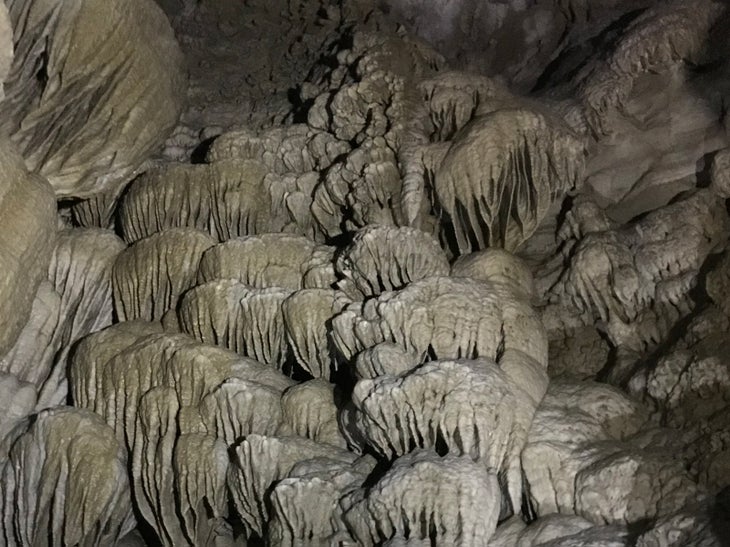
In southern Oregon’s Siskiyou Mountains sits the Oregon Caves National Monument & Preserve . The heart of the monument is its network of underground passages that offer impressive views of stalactites, stalagmites, and other formations.
Ranger-led cave tours are available between late spring and early fall, but not all the fun is underground. The Big Tree Loop Hike is a 3.7-mile (round-trip) trek that gains about 1,400 feet of elevation. The short outing affords views of the nearby Illinois River Valley, showcases one of Oregon’s largest Douglas-fir trees, and passes meadows that are covered with wildflowers in late spring and early summer.
Cave Creek Campground hosts 17 sites—each suitable for tents and small RVs—just four miles from the entrance to the Oregon Caves. The campground is open between Memorial Day Weekend and early fall, and each site is available on a first-come, first-served basis.
Best Hikes in Newberry National Volcanic Monument

Just south of Bend, three disparate units cover the expansive Newberry National Volcanic Monument . In all, nearly two dozen trails offer easy access to the monument’s scenic viewpoints and volcanic features. One of the most popular is the Big Obsidian Flow Loop Hike , a 0.8-mile (round-trip) trail that gains about 200 feet while heading into a massive lava flow covered in glassy obsidian and bubbly pumice rocks.
In all, six campgrounds reside within the Newberry Caldera. One of the most popular, Paulina Lake Campground , sits on the shore of its namesake reservoir, hosts 68 tent and RV sites, and is typically open between mid-June and late September.
Best Hikes in Cascade-Siskiyou National Monument

Oregon’s newest national monument, Cascade-Siskiyou National Monument, was designated in 2000 and sits where three mountain ranges come together. This unique location means the monument is home to a wide range of plant life, wildlife, and natural features.
Get a feel for it all along the 6.4-mile (round-trip) Soda Mountain Loop Hike . The trail gains up to 1,100 feet while heading through a high desert meadow and forests of fir and pine. The trail ends at the base of a fire lookout tower on the summit of Soda Mountain—where wide-open views of nearby peaks and the broader Klamath River basin await.
Less than 30 minutes away, the Hyatt Lake Recreation Area hosts 56 campsites across two campgrounds near the shore of Hyatt Lake.
Best Hikes in the Lewis and Clark National Historical Park

In 1805-1806, Meriwether Lewis and William Clark led the Corps of Discovery on a cross-continent trek to document the Louisiana Purchase and the Pacific Northwest. On that journey, they wintered at Fort Clatsop near the mouth of the Columbia River and the modern-day community of Astoria. Today, a replica fort is part of the broader Lewis and Clark National Historic Park .
Perhaps the park’s most beloved trail is the 13-mile (round-trip) Fort to Sea Trail . This enchanting path heads through mud bogs, quiet forests, and open meadows between Fort Clatsop and the Pacific Ocean.
If you’d like to camp nearby, Fort Stevens State Park hosts 482 tent and RV sites, 15 yurts, 11 cabins, and nine hike-in sites—along with flush toilets and hot showers—near where the Columbia River empties into the Pacific Ocean.
More of the Best Hikes in Oregon on Backpacker
For more hikes in Oregon beyond the national park and national monuments, read our Best Mountain to Sea Hikes in Oregon or explore the quiet, classic long trail, The Oregon Coast Trail .
Popular on Backpacker
Related content from the outside network, what’s it like to go on a 200-person hike better than you think., how to pack for backcountry skiing, the original yosemite firefall, hiker charges mountain lion.

IMAGES
VIDEO
COMMENTS
Recommended Days: 3-5 days. One of the more popular backpacking trip in Olympic National Park, those who get a permit to Seven Lakes Basin are rewarded with eye candy of mountains, lakes, animals and forests. Aptly names, the basin is full of lakes, mountain goats, wildflowers, and incredible views of glaciated peaks around the Olympic Mountain ...
This extension will give you more miles and excellent vistas, including the best views of Mount Olympus in the area. 3. Enchanted Valley / Anderson Pass / O'Neill Pass Loop. Enchanted Valley is one of the most popular beginner backpacking destinations in Olympic National Park. Length: 52 mi.
Explore the best of the Pacific Northwest backcountry with these five backpacking trips in Olympic National Park. From easy to intermediate, from scenic to challenging, these trails offer stunning views, diverse wildlife, and relaxing amenities.
The Enchanted Valley trailhead (also called the Graves Creek trailhead) is located in one of the most overlooked spots on most travelers' Olympic National park itinerary, the Quinault Rainforest. It's located along the southern portion of the Olympic Peninsula Loop and will take take about three and a half hours of driving time from Seattle ...
Best Alpine Views in Olympic National Park: Seven Lakes Loop. This 17.5-mile loop follows a ridgeline around a subalpine basin where the eponymous lakes are nestled, with matchless views of 7,965-foot Mt. Olympus from the ridge's 5,000-foot spine. On the way in you'll also pass Sol Duc Falls, where three 50-foot cascades drop into the same ...
Explore the best seven trails for backpacking in Olympic National Park, a diverse wonderland of mountain peaks, rainforests, and ocean vistas. Learn about the camping permits, gear, and tips for each trail, from the iconic High Divide Loop to the scenic Shi Shi Beach.
The Hike. This Olympic National Park trip certainly lives up to its name and is nothing less than enchanting. Enjoy hiking through the scenic Quinalt Rain Forest - the same temperate rainforest ecosystem as the Hoh - before emerging in the awe-inspiring enchanted valley.
Mileage: 9.4 Miles Roundtrip. Difficulty: Moderate to easy. Trail Guide: Link. The backpacking (moderate) option for Ozette Loop is far superior to the shorter day-hike (easy) option, if only for the opportunity to get deeper into the wilderness and find the rocky and sandy beaches that are truly stunning.
Backpack the Hoh River Trail to Blue Glacier. 5.0. 35.68 mi / 5948 ft gain. The well trodden and well marked trail begins in the rainforest, and is flat and follows the river for the first few miles. There are many marked camp sites along the way, as well as dispersed camping on the sand bars in the river bed.
Featuring verdant old growth forests, glacial-fed streams, some of the best views of the Olympic Mountains, and even a historic chalet, there are plenty of reasons why the hike to the Enchanted Valley in Olympic National Park is one of the most popular backpacking trips on the Olympic Peninsula.
Nestled in the northwestern corner of the United States, Olympic National Park is a backpacker's paradise. Encompassing nearly a million acres of diverse landscapes, such as lush rainforests and rugged coastlines, the park offers a plethora of backpacking opportunities. ... Best Backpacking Trip in Olympic for Awe-Inspiring Vistas.
Planning Your Wilderness Backpacking Trip. The Daniel J. Evans Wilderness remains one of the wildest regions in the contiguous United States. Nearly 50,000 campers enjoy Olympics' wilderness annually, with additional thousands exploring local day hikes. Listed below are various resources to help preserve this fragile ecosystem.
Olympic National Park encompasses nearly one million acres of Washington wilderness, making it a perfect choice for many backcountry adventures. The best Olympic National Park hikes showcase its four distinct environments: Pacific coastline, alpine tundra, temperate rainforest, and drier forest.All sit in the shadow if Mount Olympus, the snowcapped peak at the heart of it all.
On this backpacking trip, you'll be able to hike for miles through lushy, mossy forests laden with ferns. The last 7 miles of this out-and-back route takes you up and out of the rainforest, where you receive some of the most breathtaking views of Mount Olympus and the surrounding Olympic mountain range.
Wildland Trekking has been operating guided hiking and backpacking tours since 2005 in premier wilderness and national park destinations across the USA and the world. The owners alone have more than 50 years of combined experience in adventure travel. With 150+ guides, 10000+ annual guests, #1 spots on 5 different national park Trip Advisor ...
Here's an idea of what you can cover in 2 or 3 days in Olympic National Park. With 2 Days in Olympic National Park: Spend one day on the Hurricane Ridge / Lake Crescent area, and one day on the Pacific Coast and the Hoh Rainforest. With 3 Days in Olympic National Park: Add the northwest corner of the park (Shi-Shi and Cape Flattery) in ...
What distinguishes backpacking in Olympic National Park from any other park in the Lower 48? The ability to go from one of the planet's lushest temperate rainforests to alpine wildflower meadows beneath glaciated peaks. The stunning scenery has not gone unnoticed: Olympic's best-known hikes can offer all the solitude of a Seattle coffee shop.
The 73-mile Olympic Wilderness Coast provides some of the most unique backpacking routes within the National Park Service. With our shuttle service, you can choose from any of the three sections: 1) Oil City to Third Beach, 2) Rialto to Ozette, or 3) Ozette to Shi Shi. Each of the routes are about 20 miles and can be hiked in any direction ...
Distance: 6.1 miles. Time: ~4-5 hours. The final day of this Washington beach backpacking trip is mostly in the rainforest. A lush, green environment feels welcome after days of trekking on the sand. The inland trail can often get muddy and wet, so be aware of the conditions and come prepared.
Olympic Rainforest to Glacier Trek. Location: Washington Hiking Tours. Area: Olympic Hiking Tours. Trip type: Guided Backpacking Trip. Difficulty: Highlights: Stunning High Country, Views of Blue Glacier, Old Grows Rainforests …. 3 Days. from $1465.
For these backpacking trips in Olympic National Park, the usual client-to-guide ratio is 5:1. The average group size is between 5 and 10 people. The cost does not decrease as the group grows. Backpacking in Olympic NP can be arranged for larger groups. Contact us to make arrangements.
Other Great Hiking Trails At Olypmic's Lake Crescent Area Lake Crescent has at least five great hiking trails to select from ranging from 0.6 miles to 3.5 miles. Olympic National Park is a mecca for hiking in Washington and the National Park Service lists plenty of excellent day-hikes. The diverse national park offers a selection of coastal ...
Gabby Rumney, a 28-year-old project coordinator for the National Grocers Association Foundation in Philadelphia, said she turned to the app before and after hiking all 2,193.1 miles of the ...
14 miles of the Spokane River Centennial Trail will be closed this summer. Photo by trip reporter California Girl. Olympic National Park backcountry permits: Starting April 15, overnight permits for the peak season — May 15 through Oct 15 — can be reserved online at Recreation.gov or by calling the Wilderness Information Center. Day hikers ...
The 11 best National Parks for backpacking offer a multitude of wilderness escapes from crowded paths into remote interiors and across long, serpentine trails ©Jordan Siemens. America's ...
The Big Tree Loop Hike is a 3.7-mile (round-trip) trek that gains about 1,400 feet of elevation. The short outing affords views of the nearby Illinois River Valley, showcases one of Oregon's largest Douglas-fir trees, and passes meadows that are covered with wildflowers in late spring and early summer.